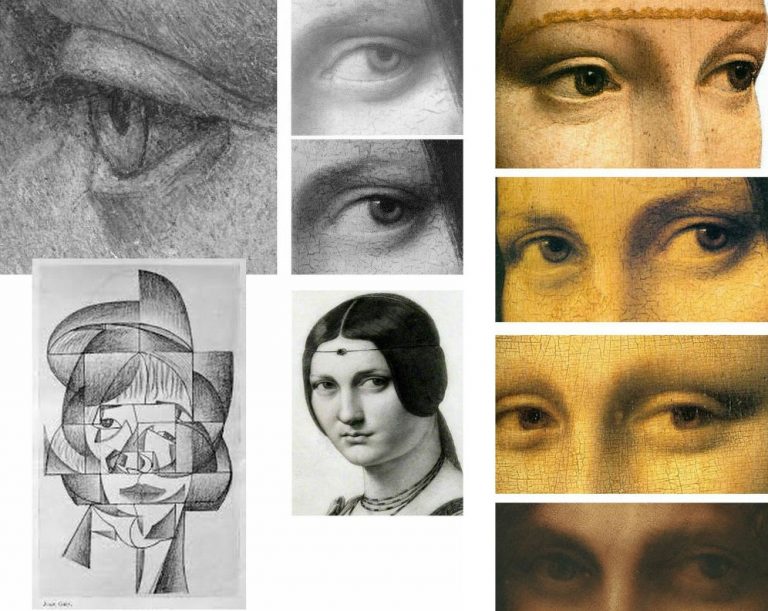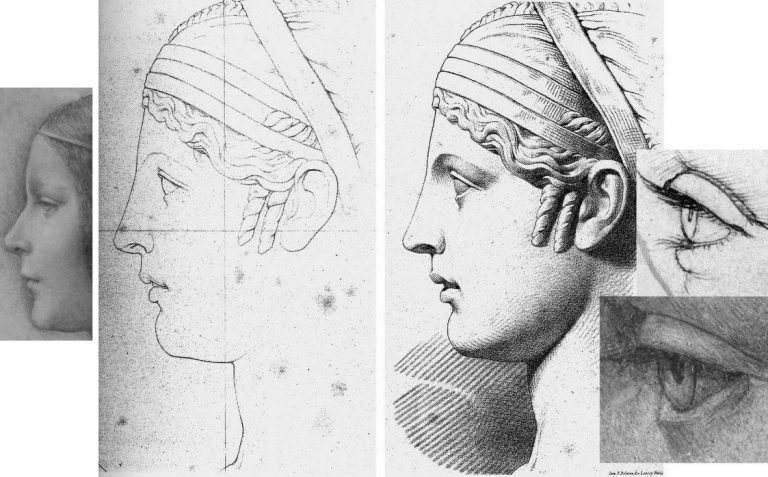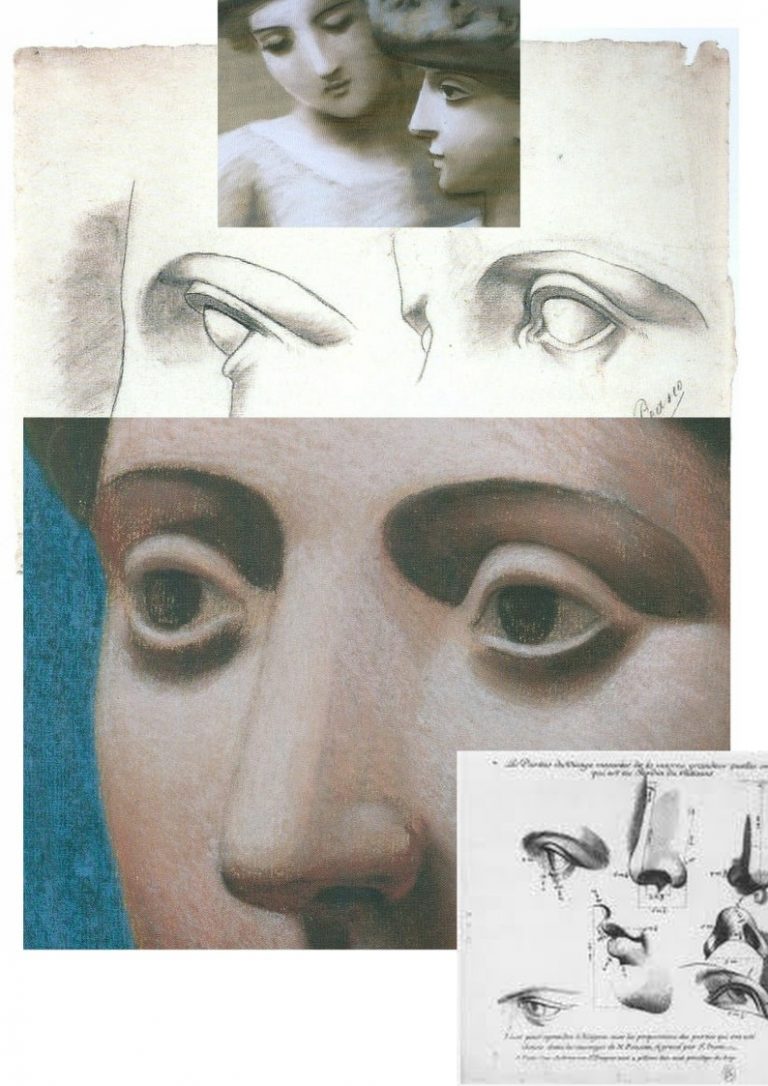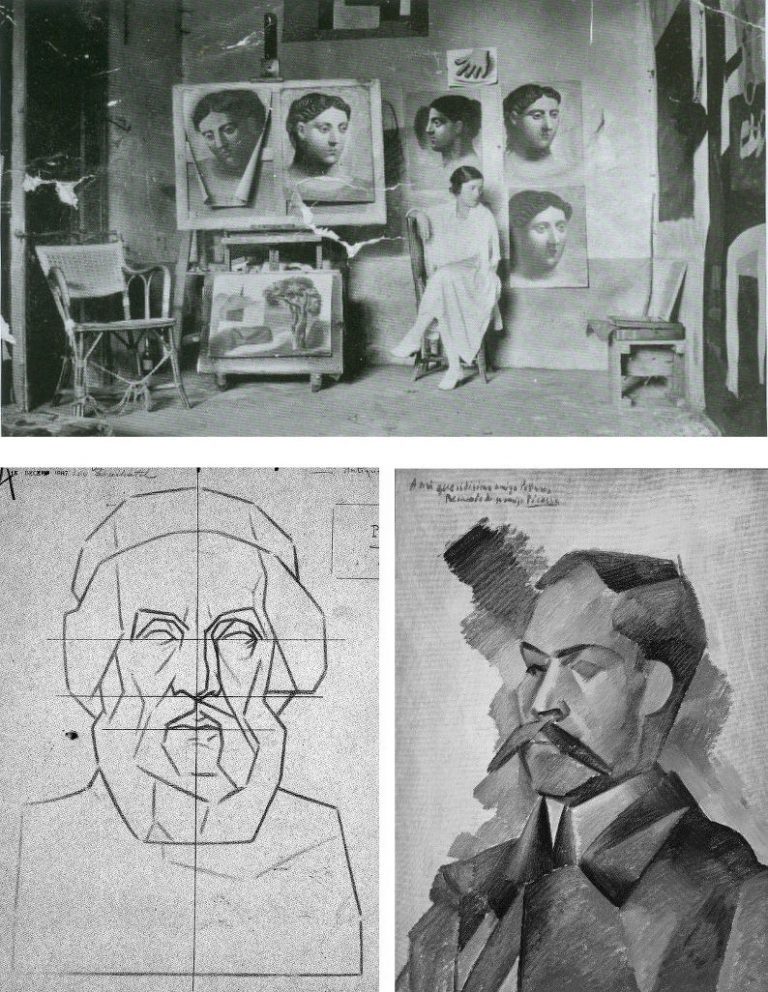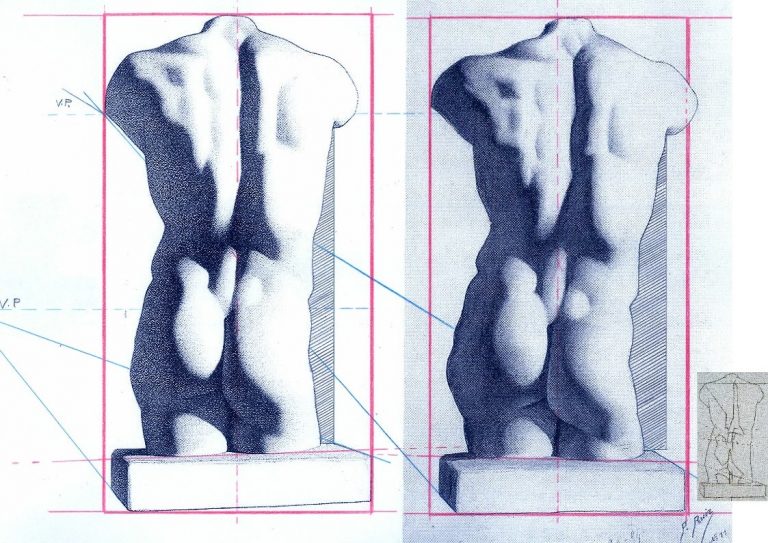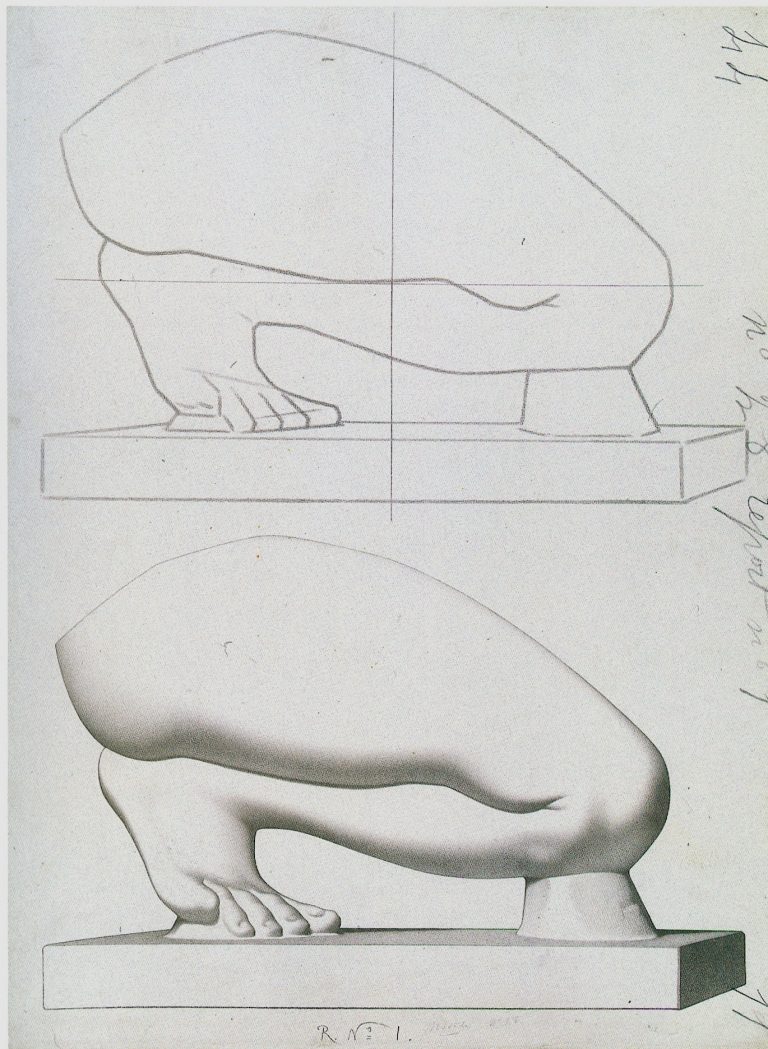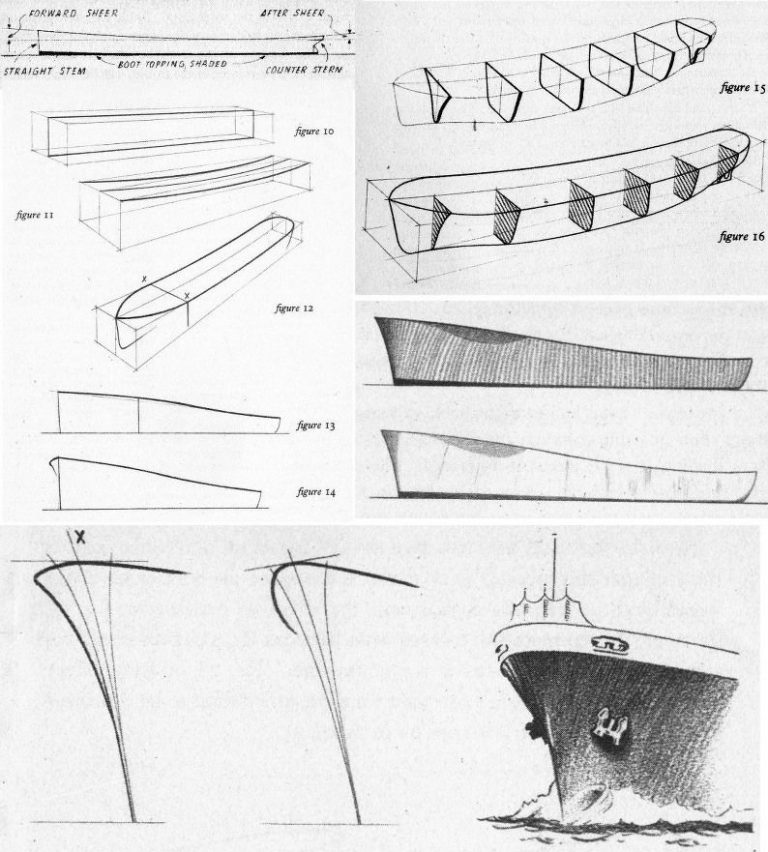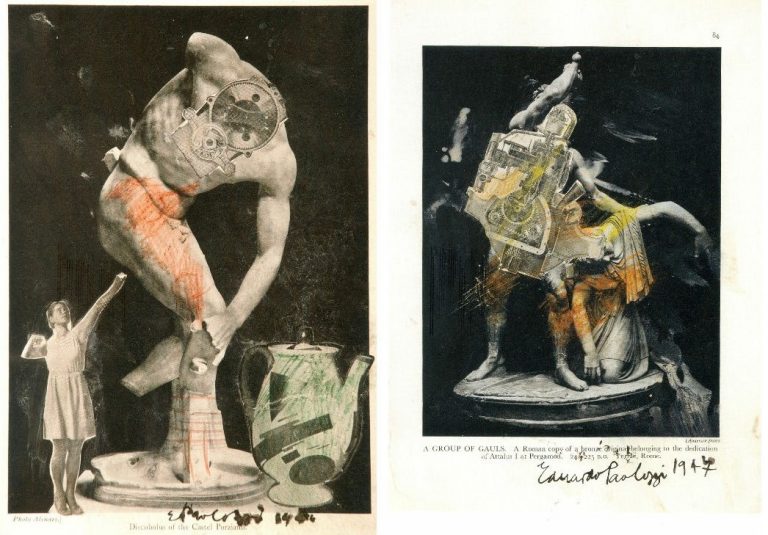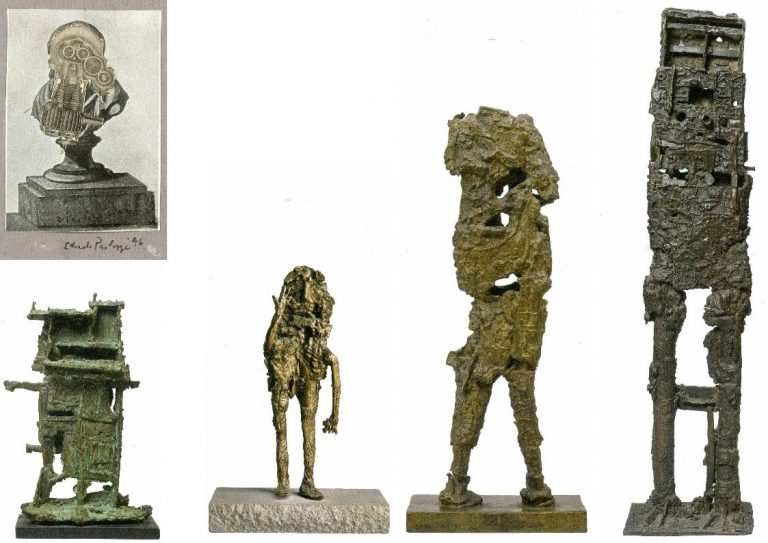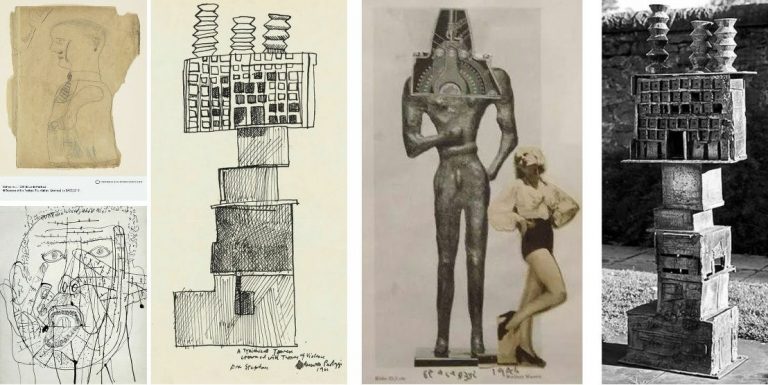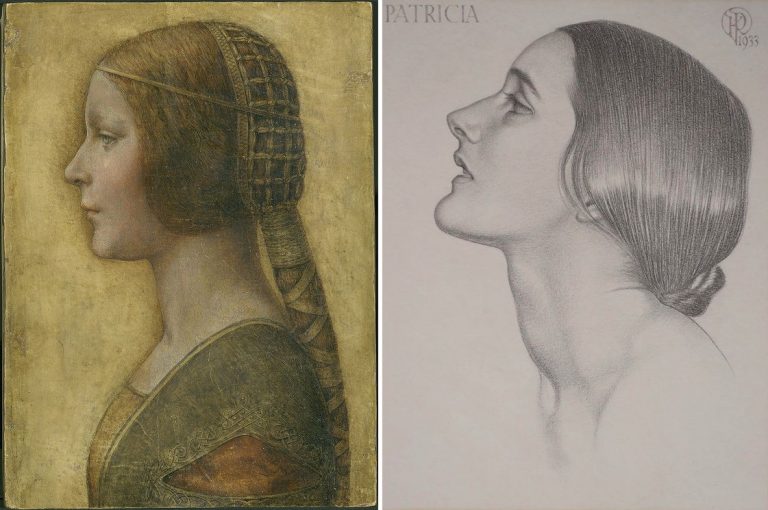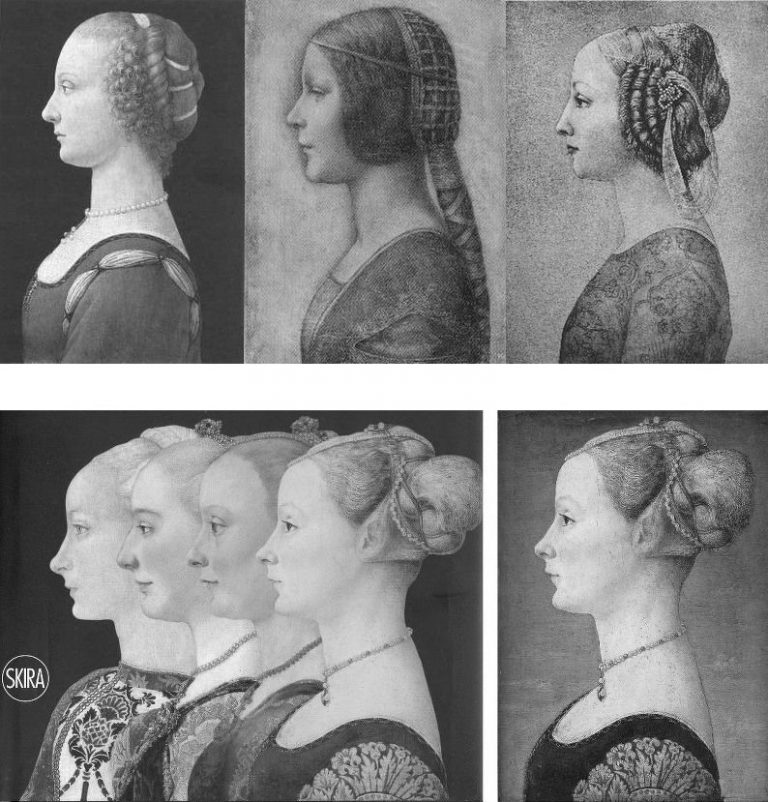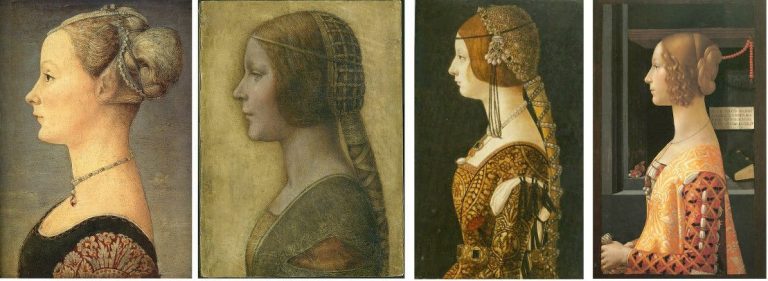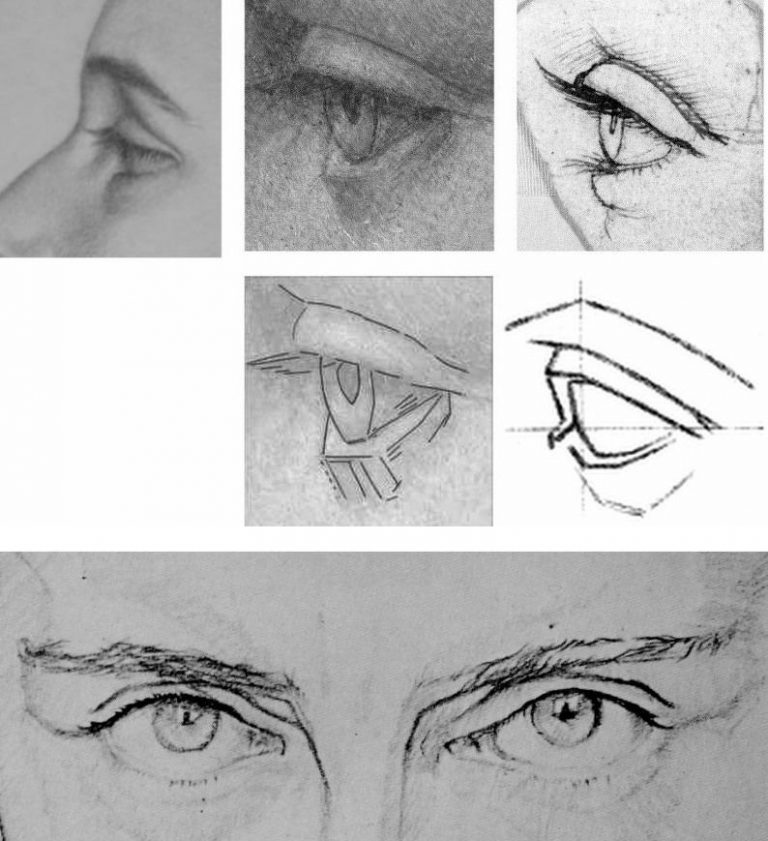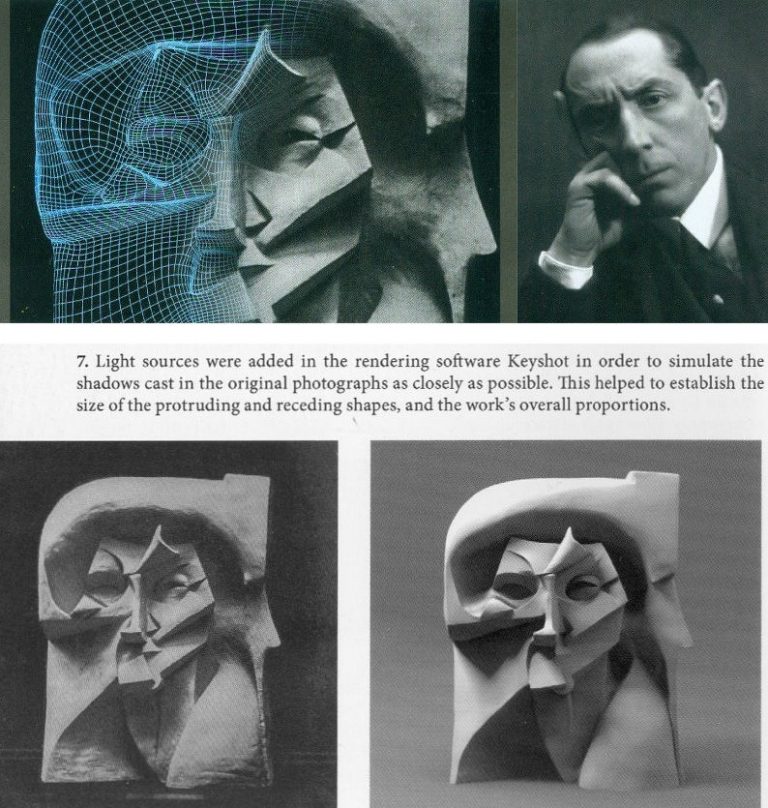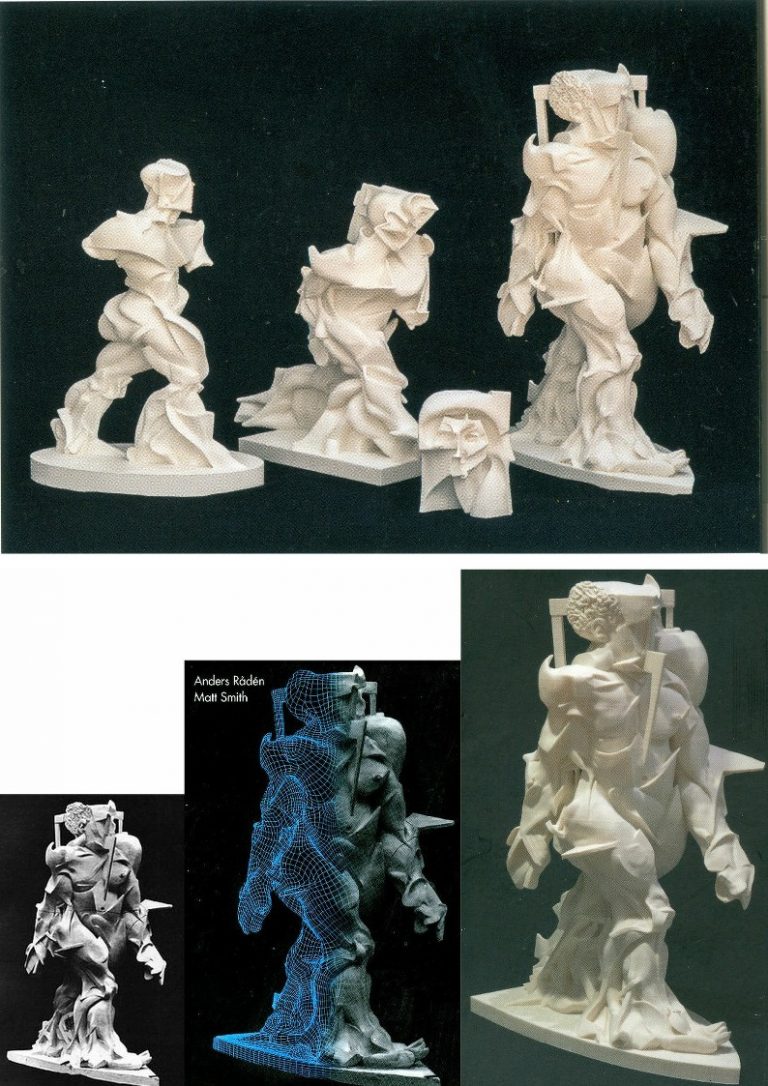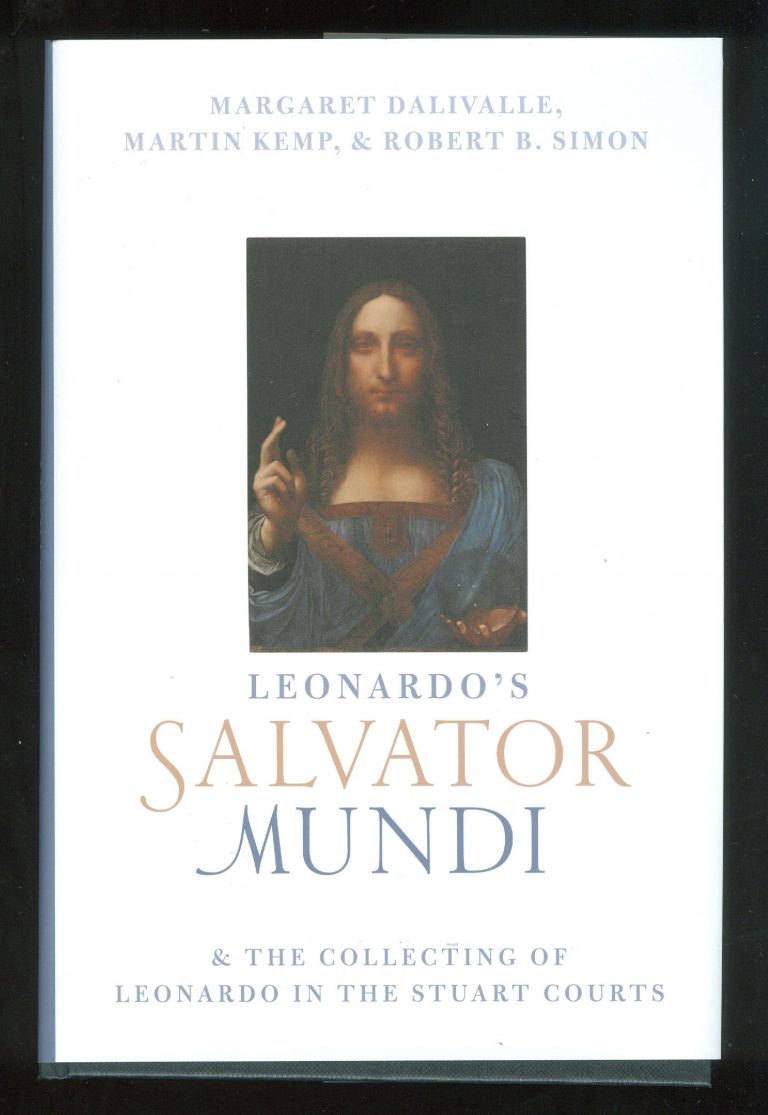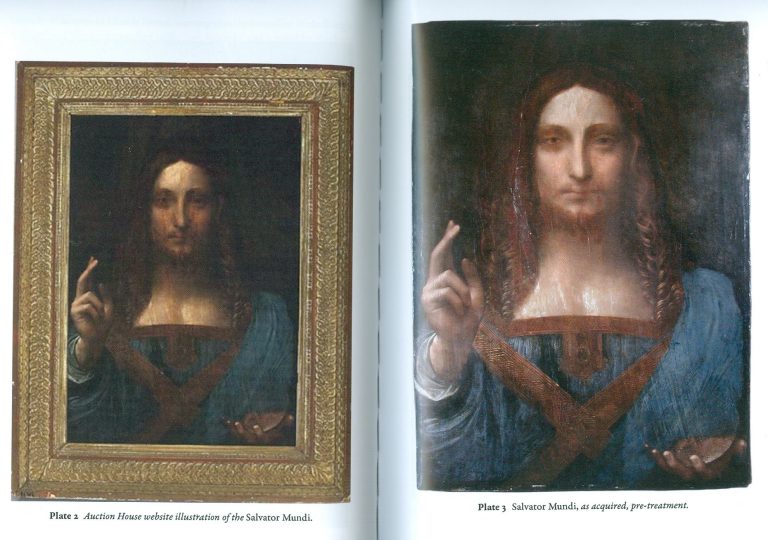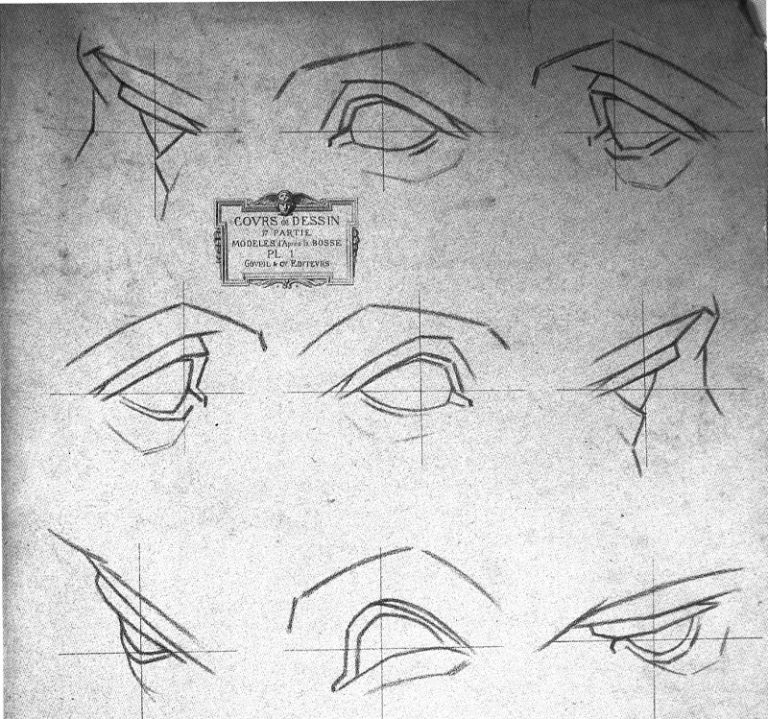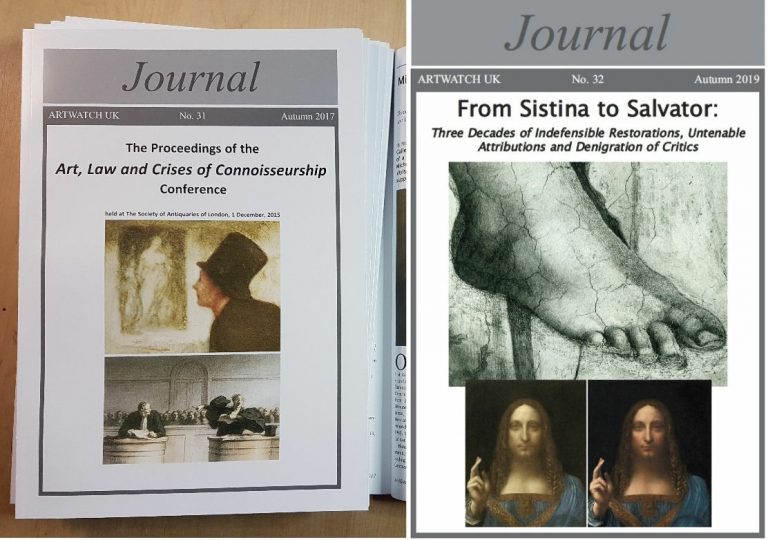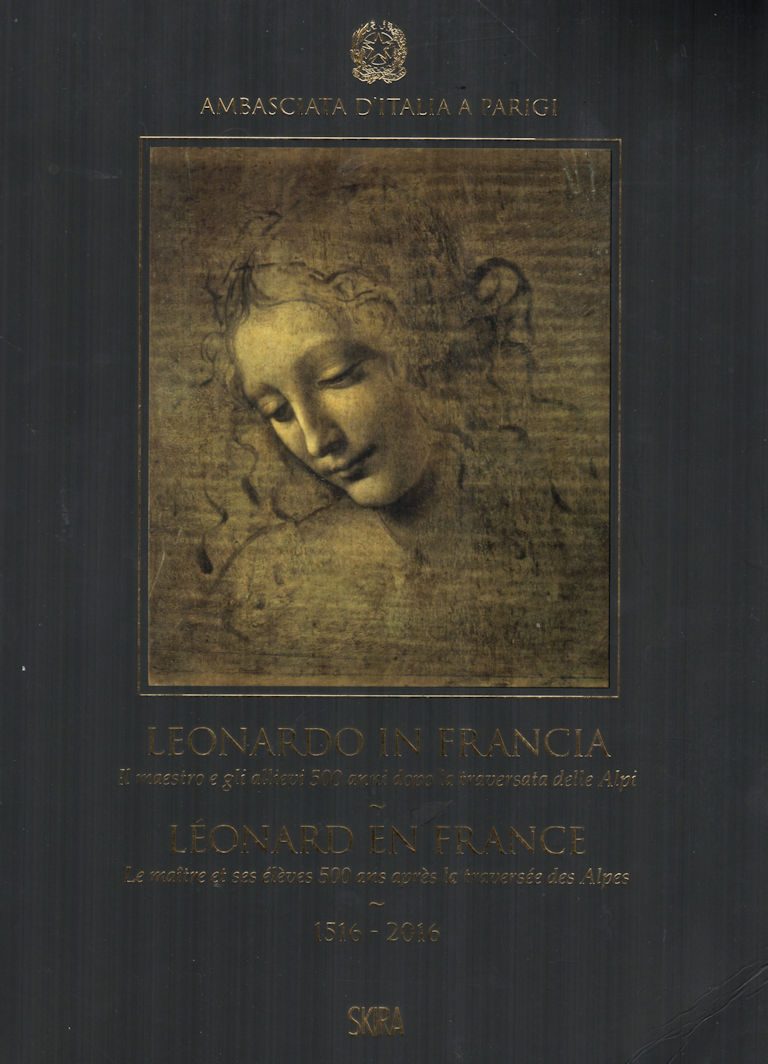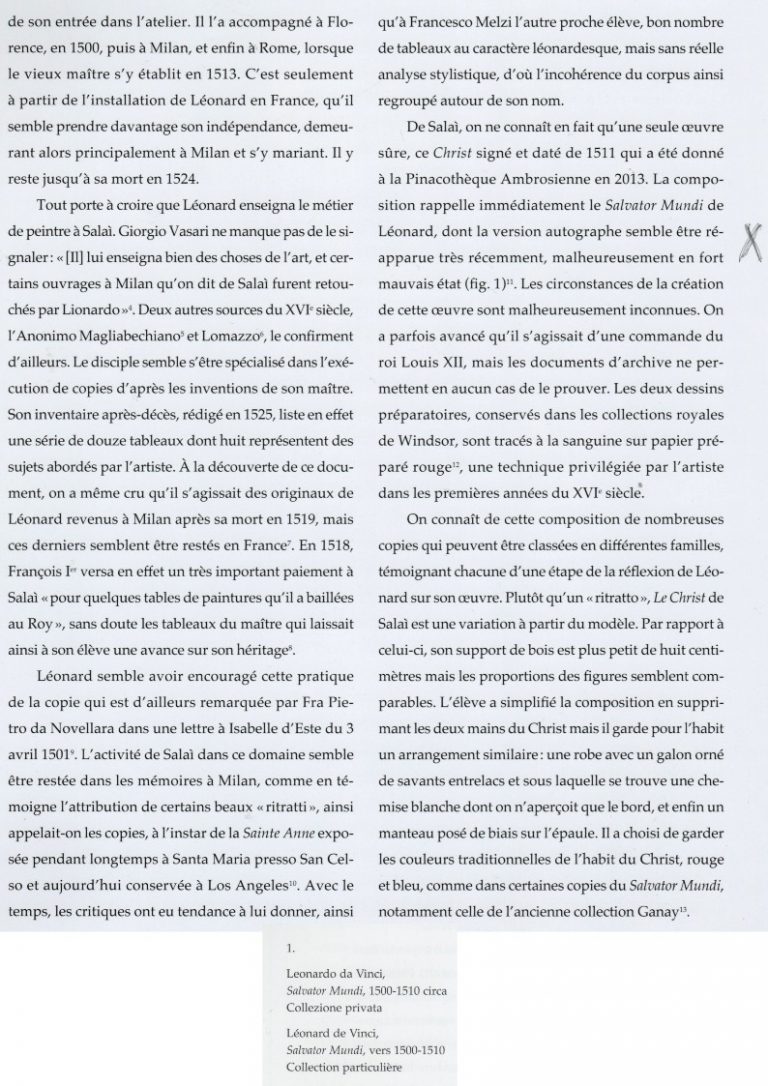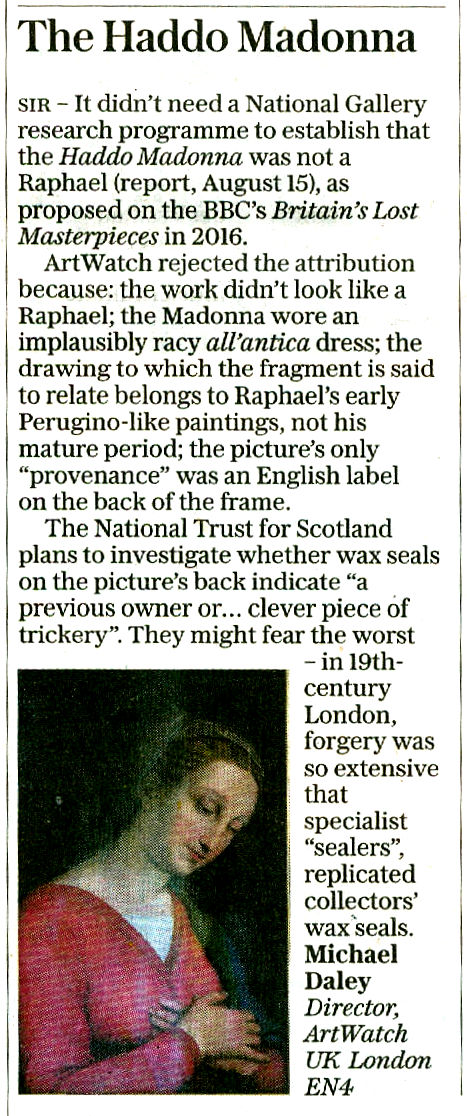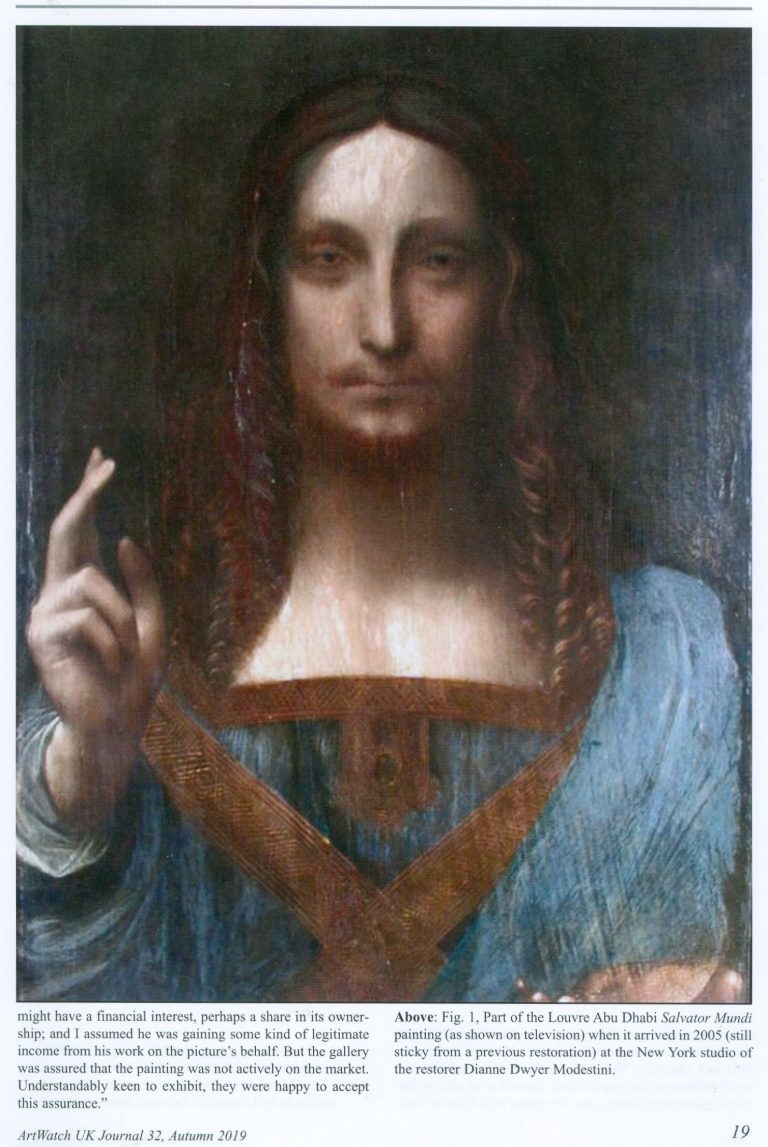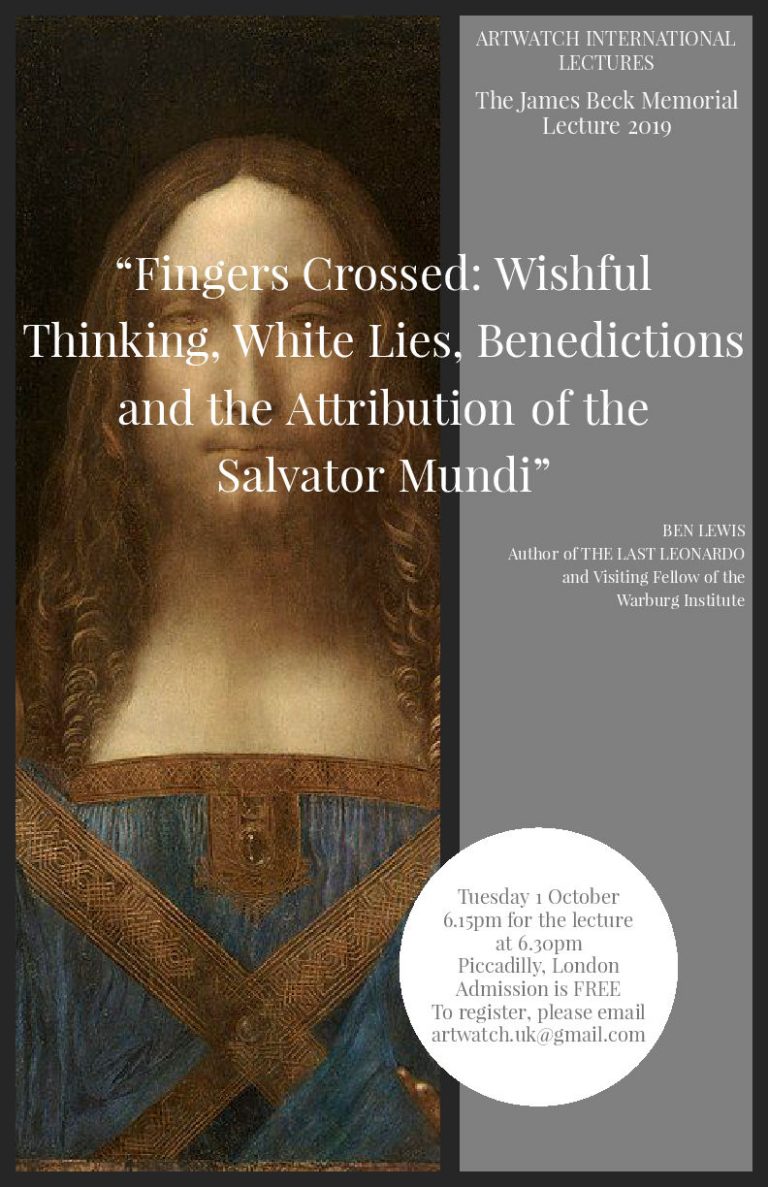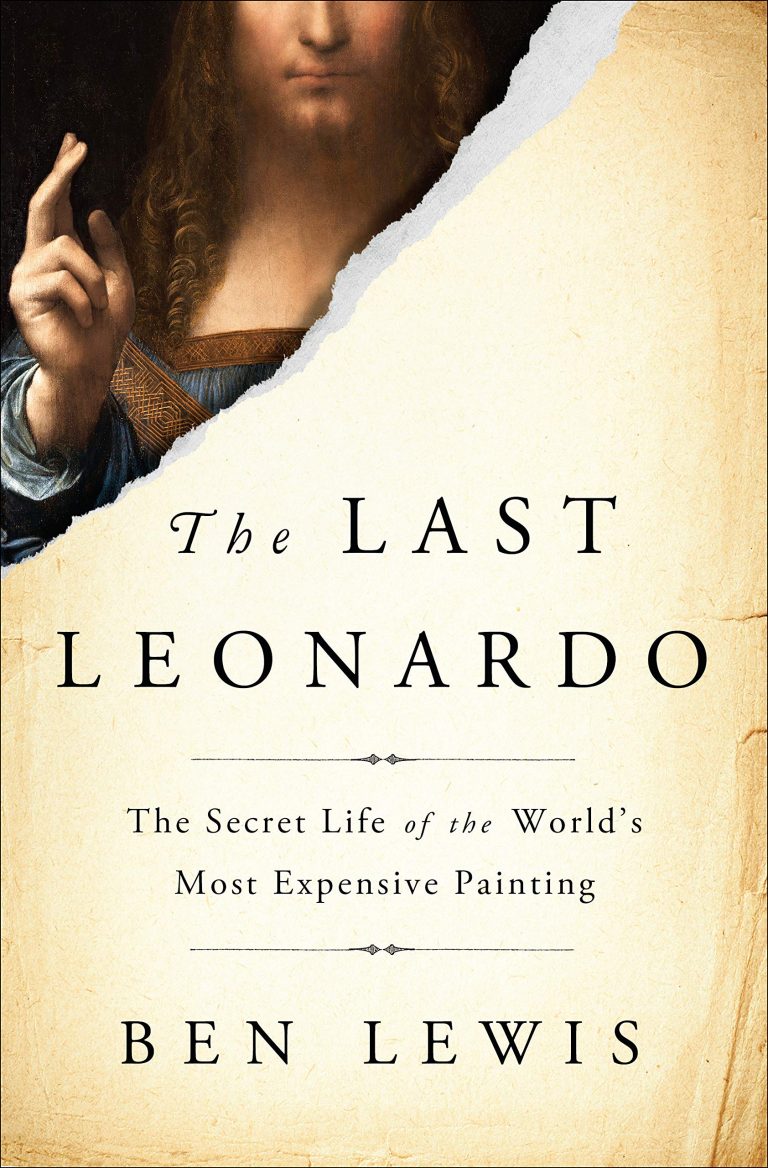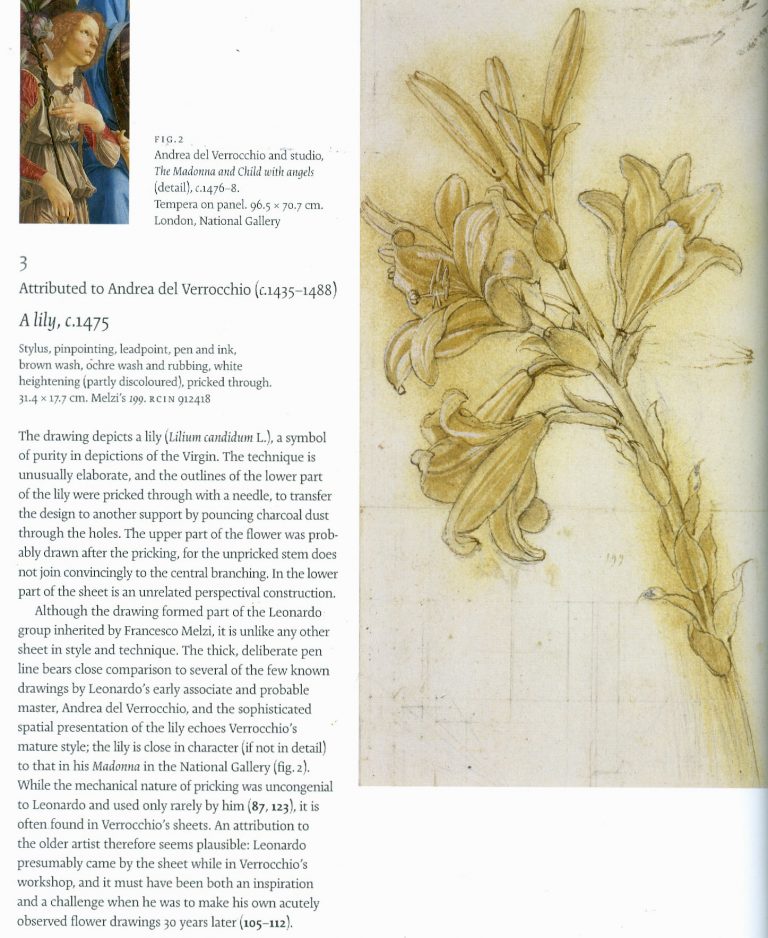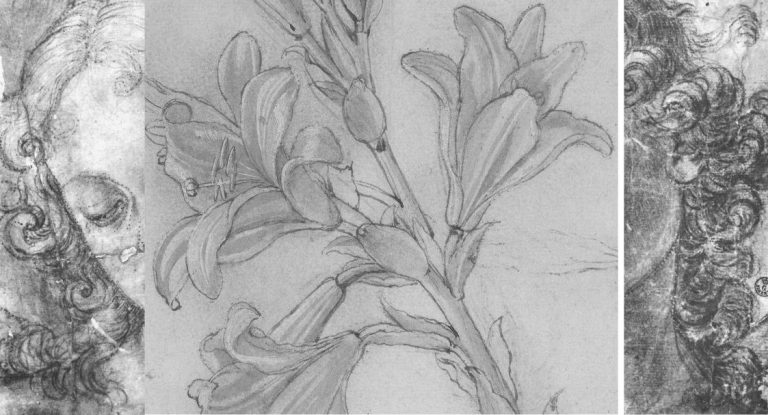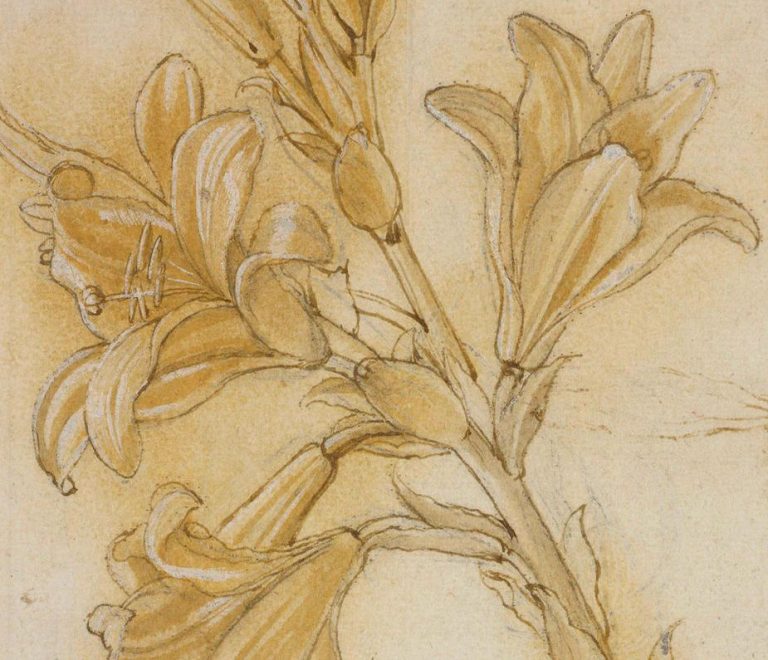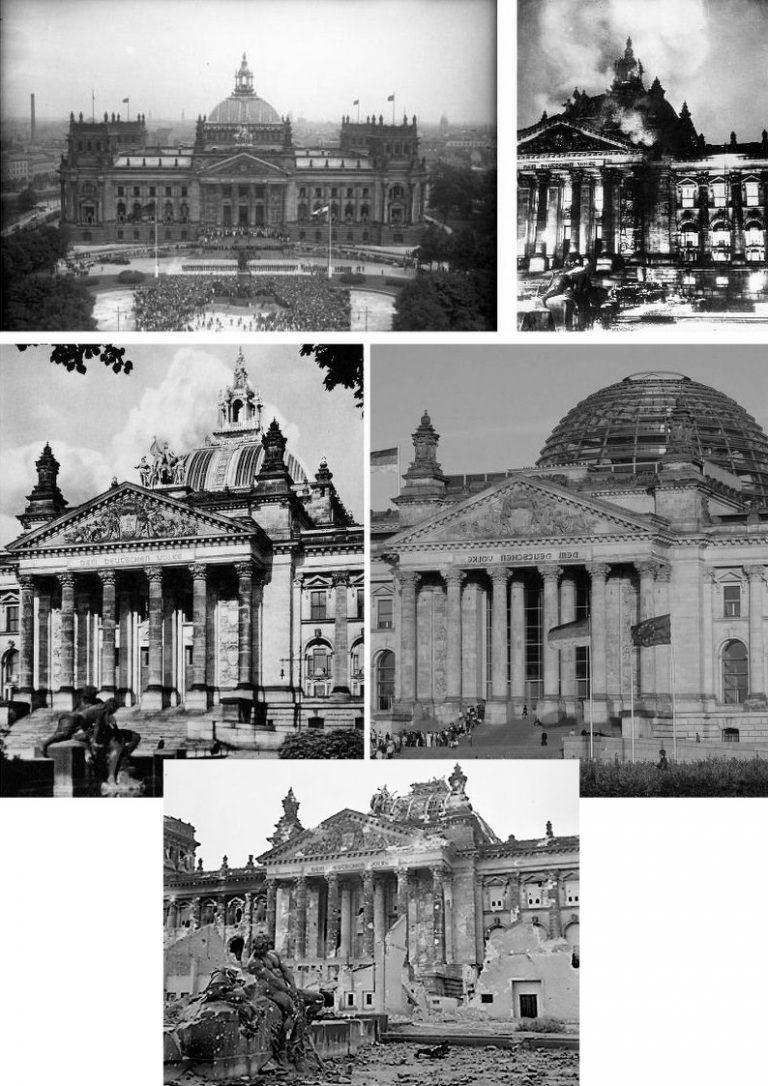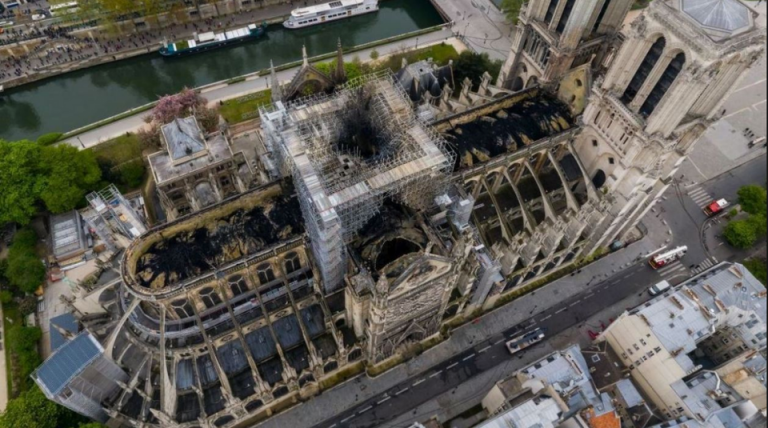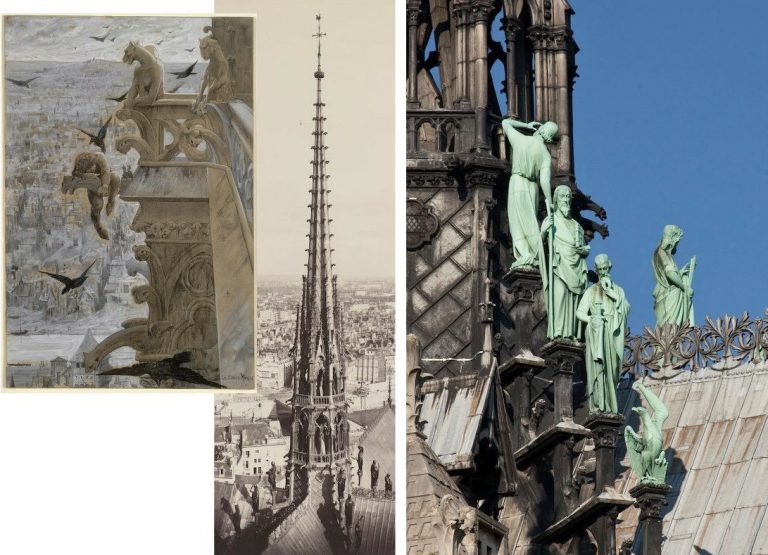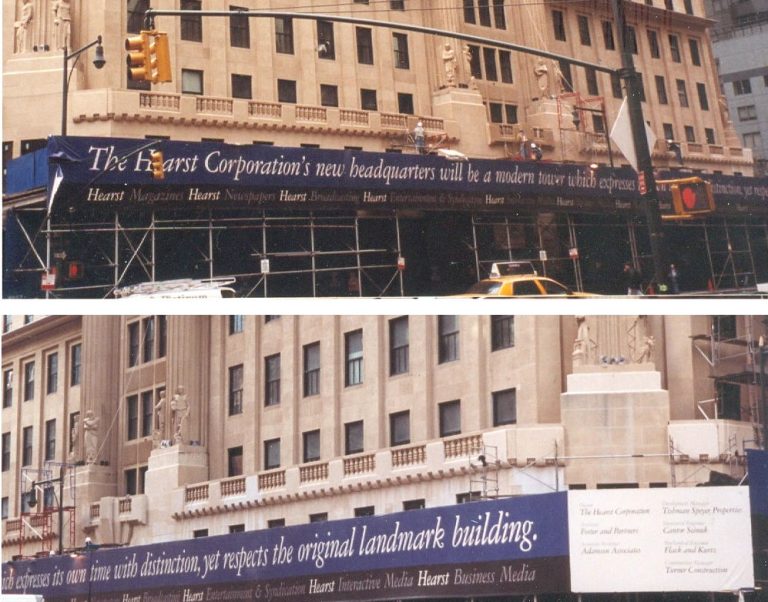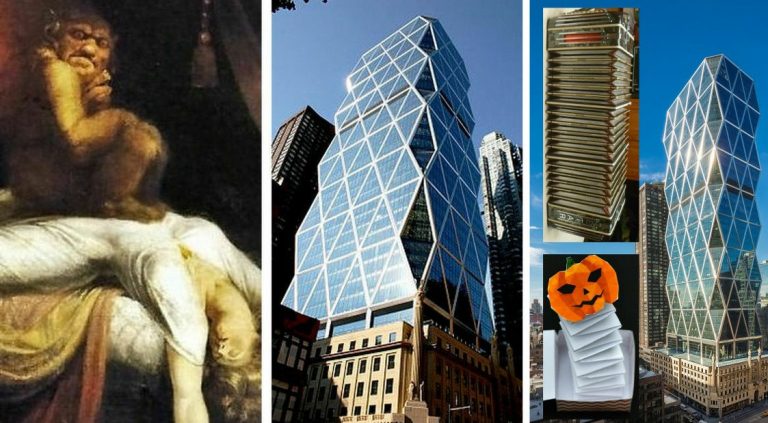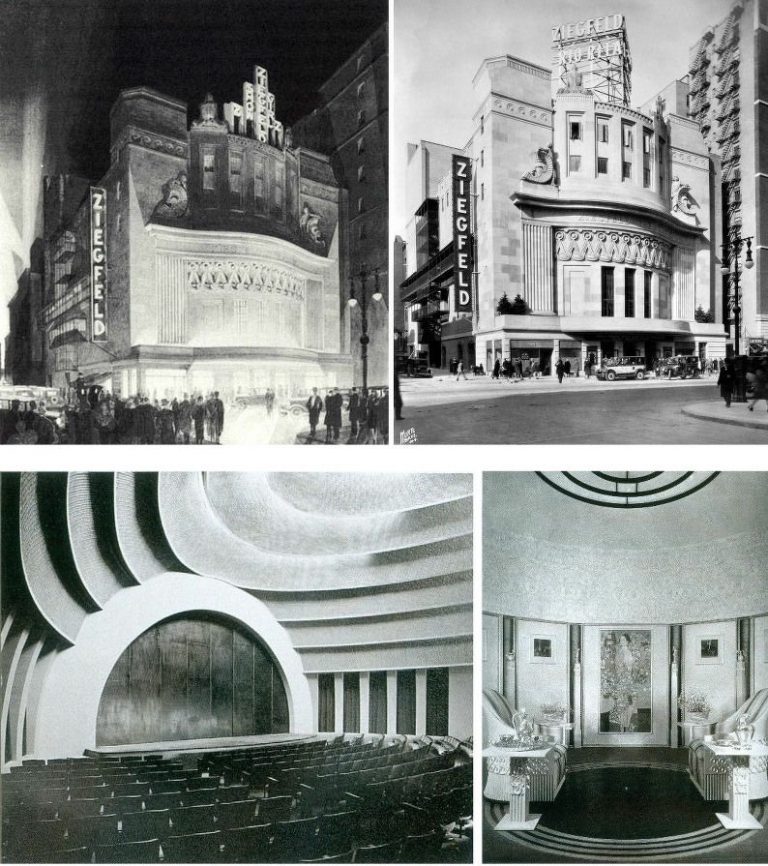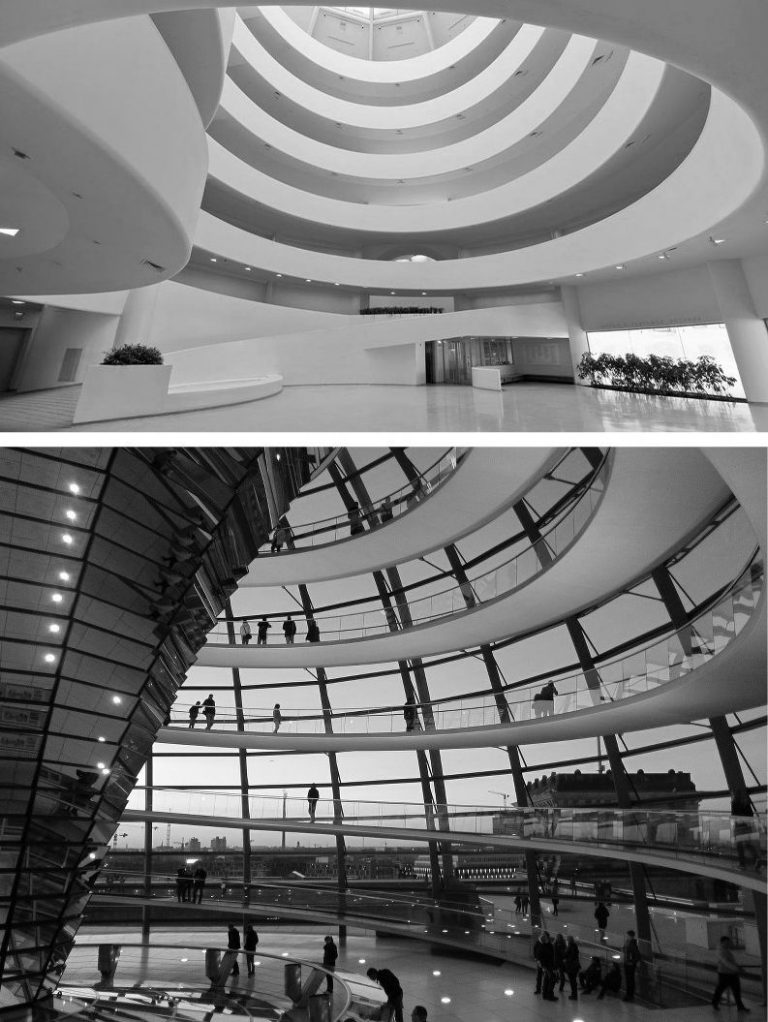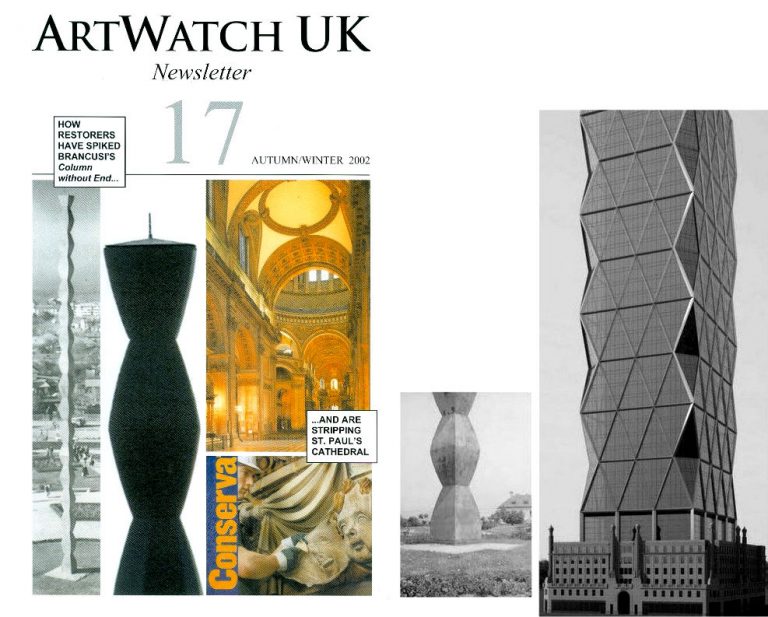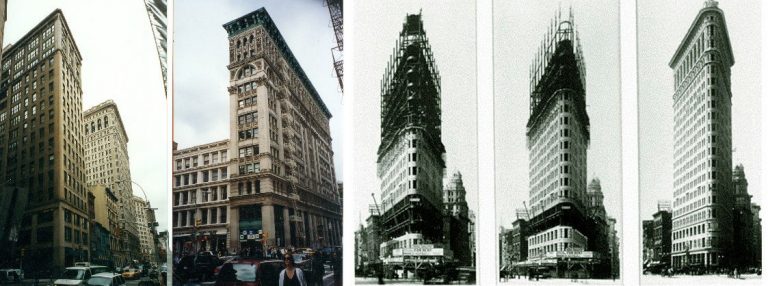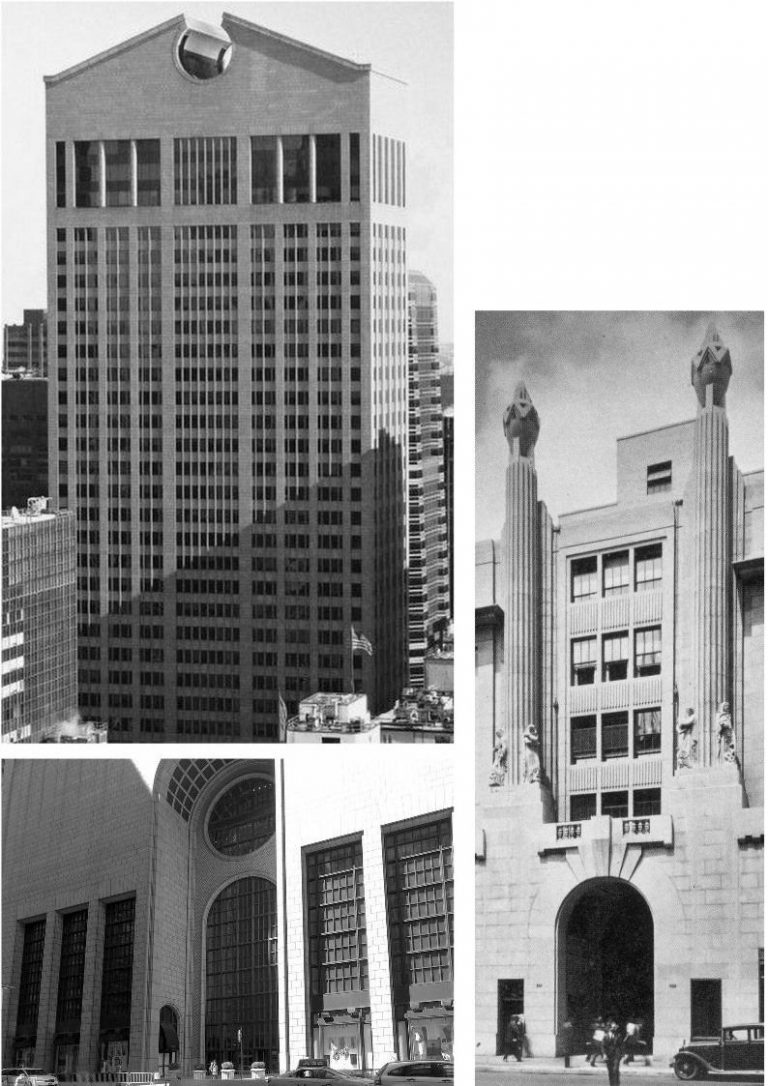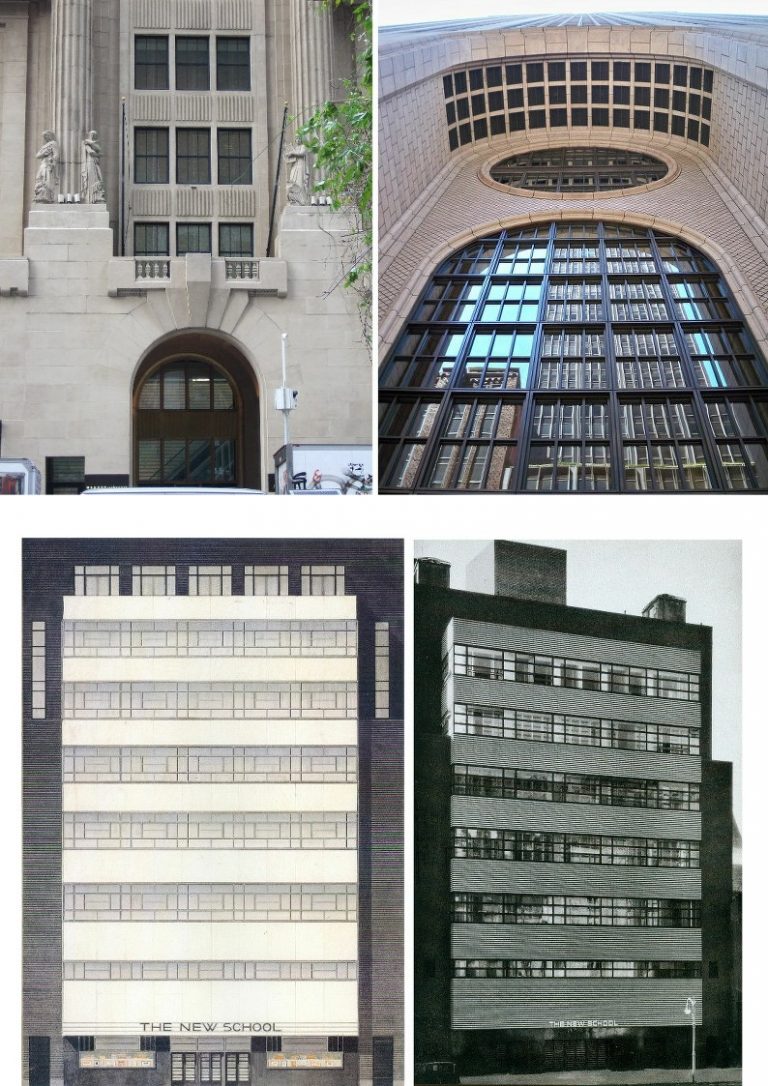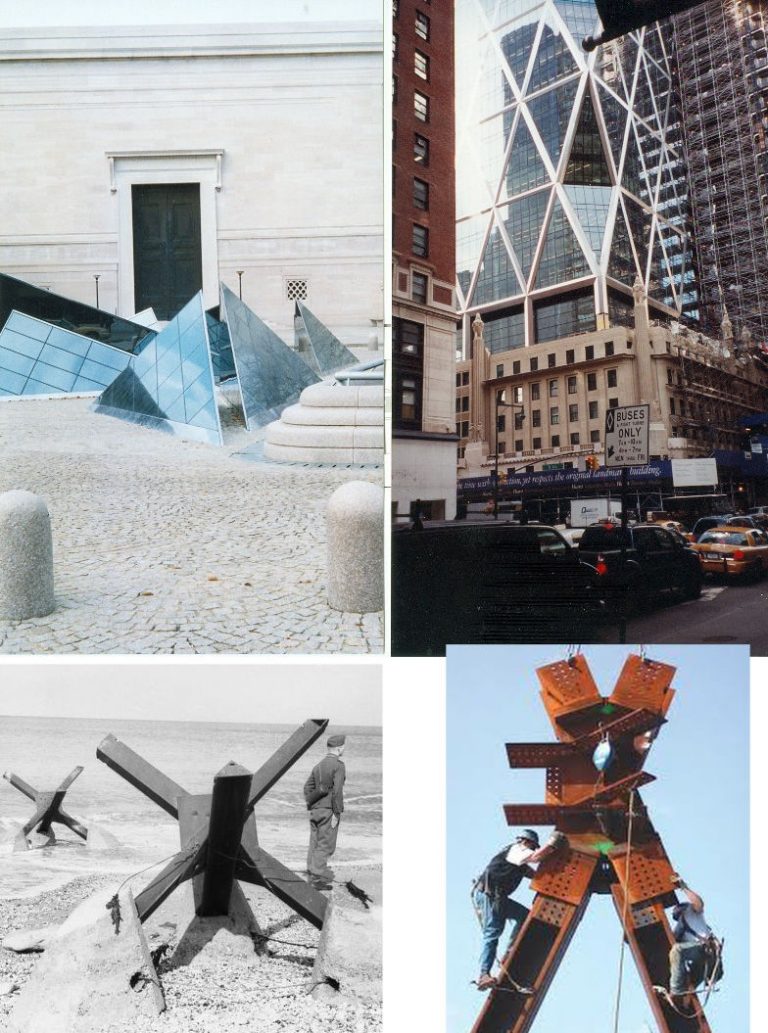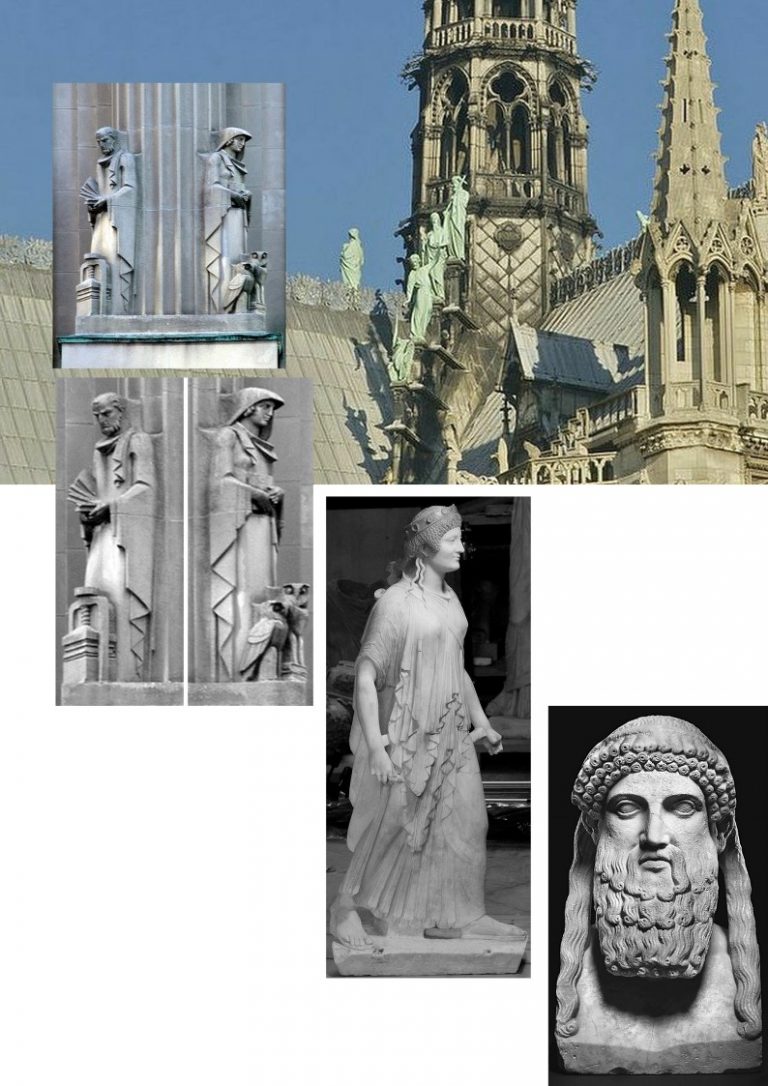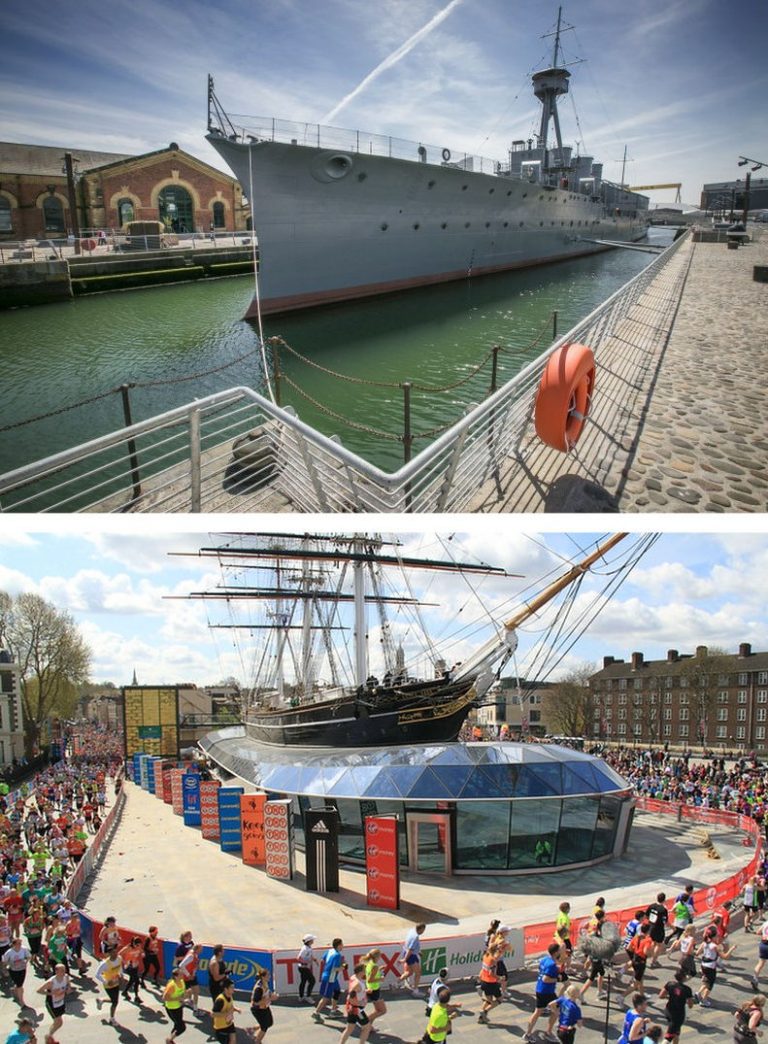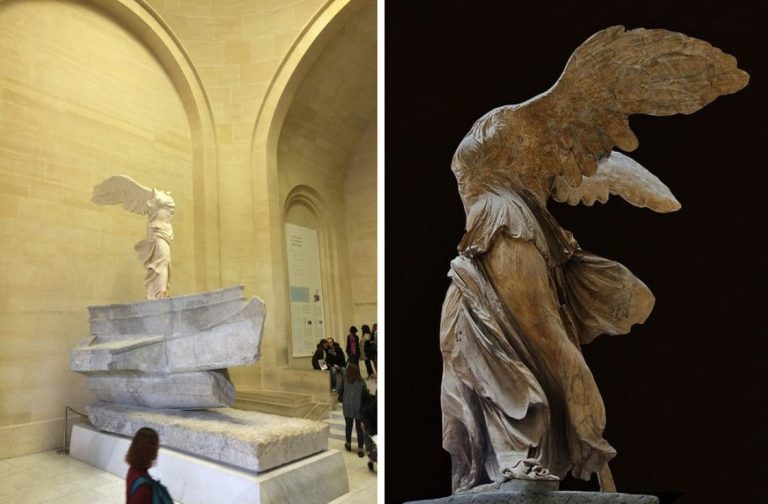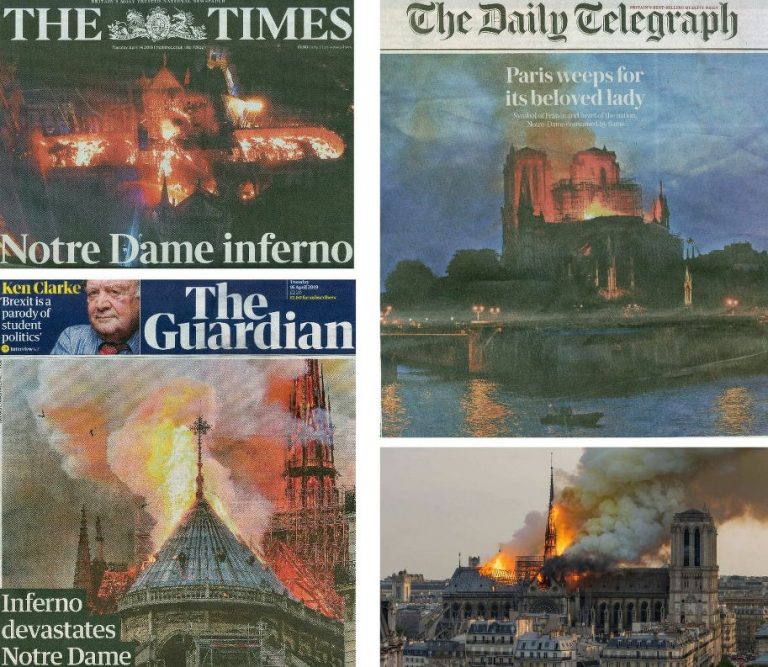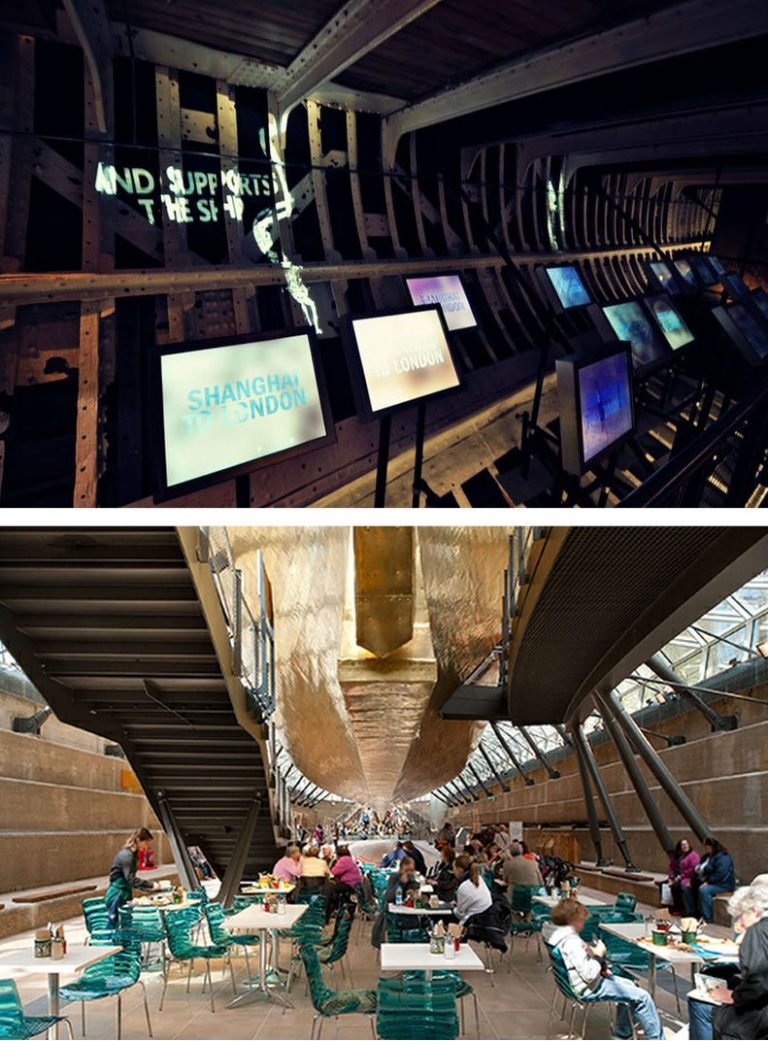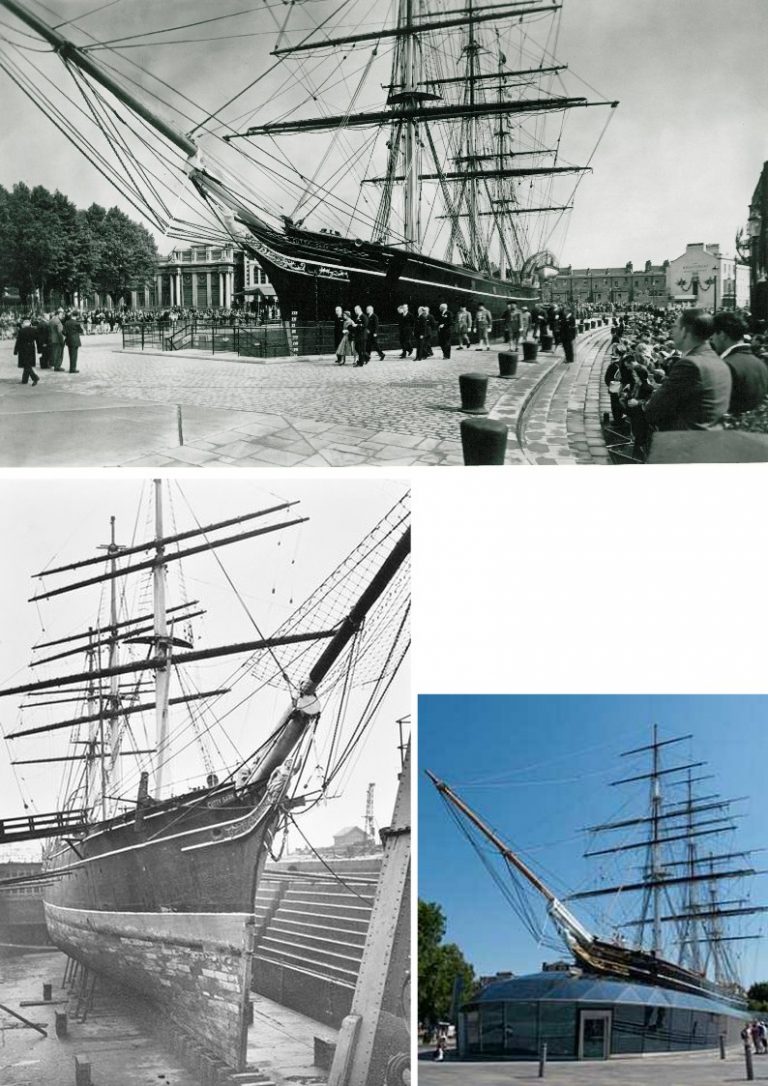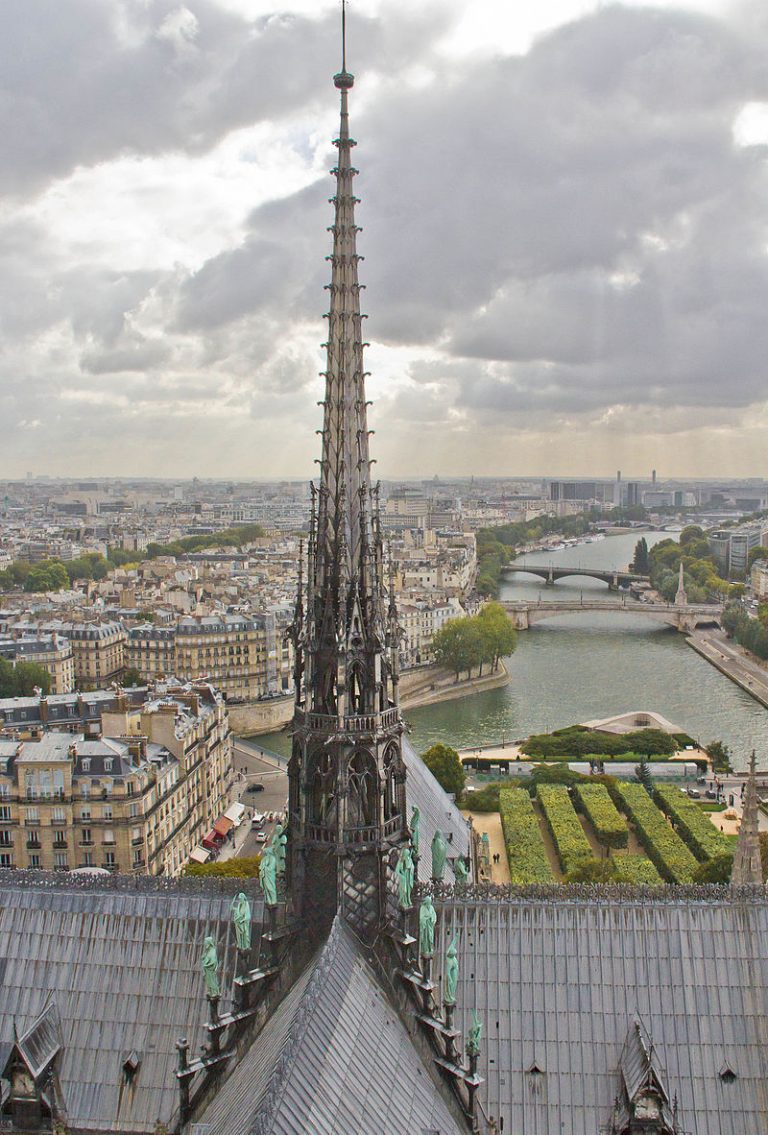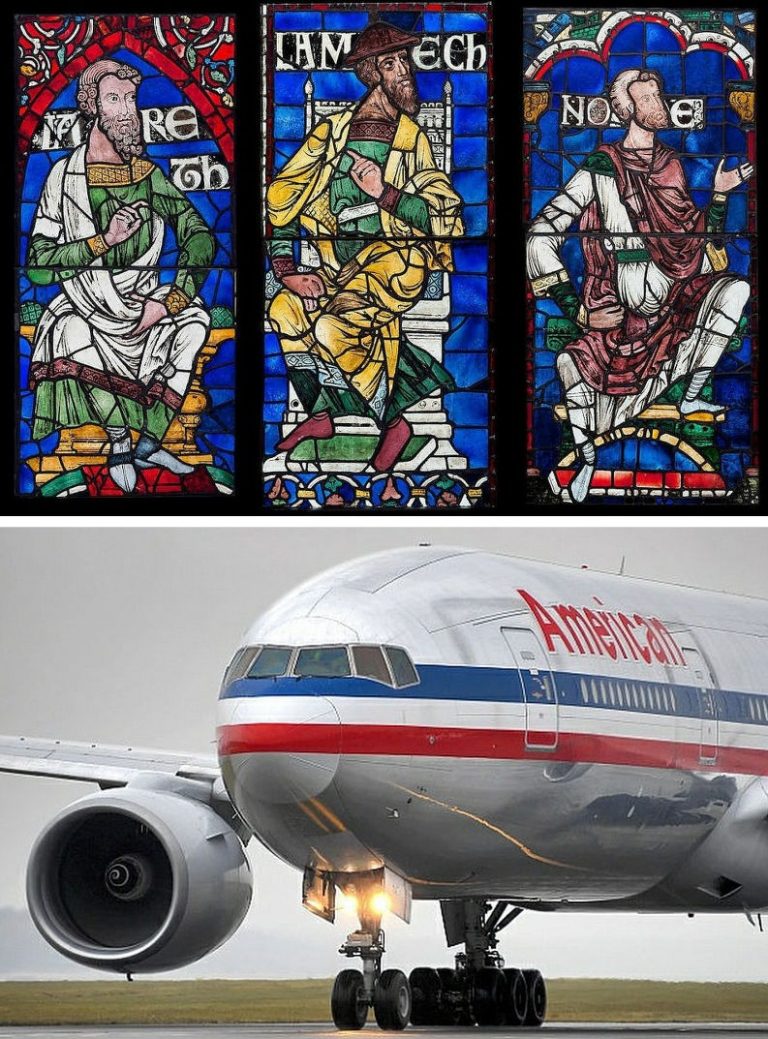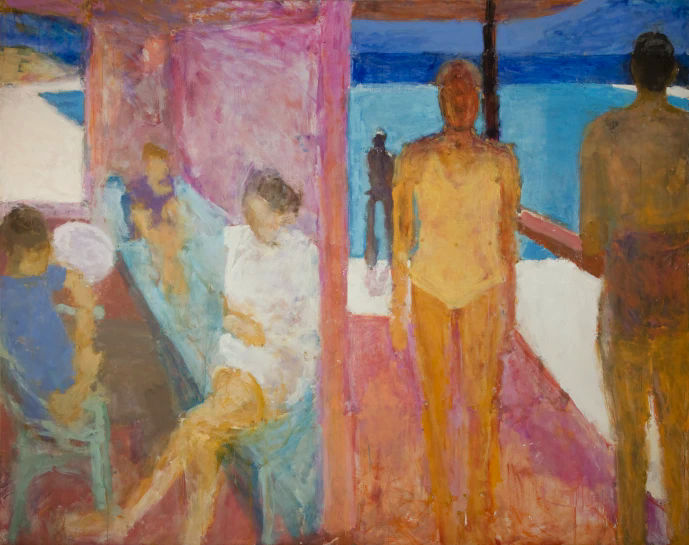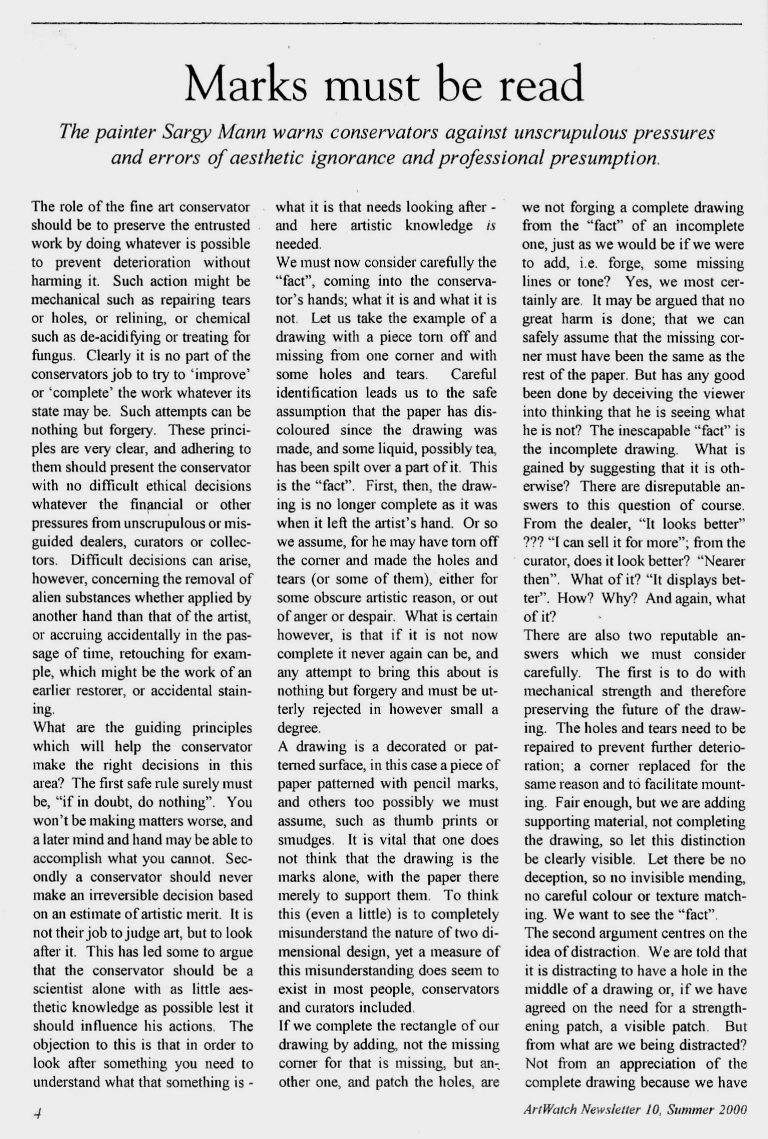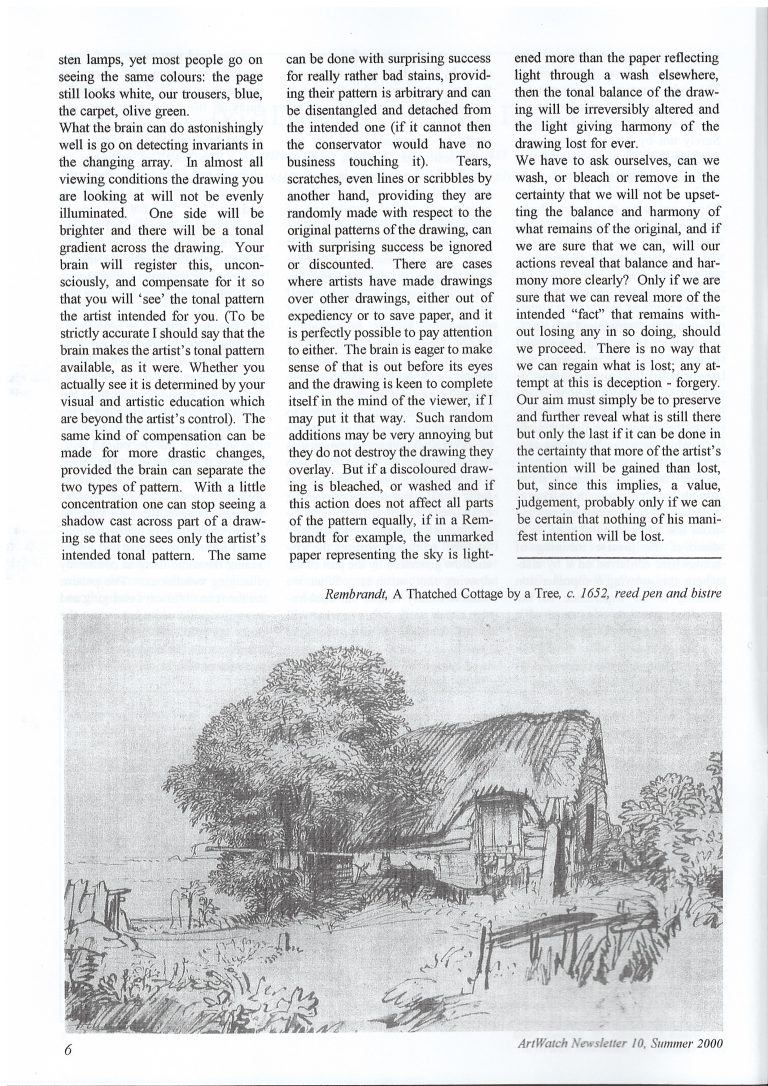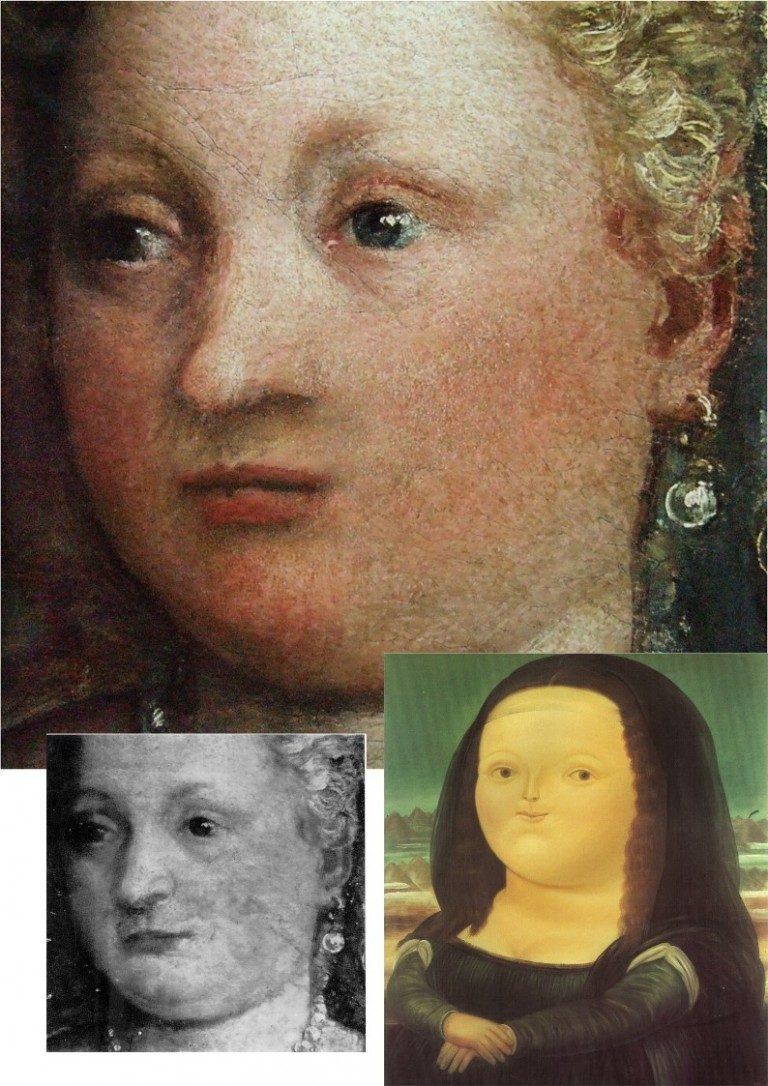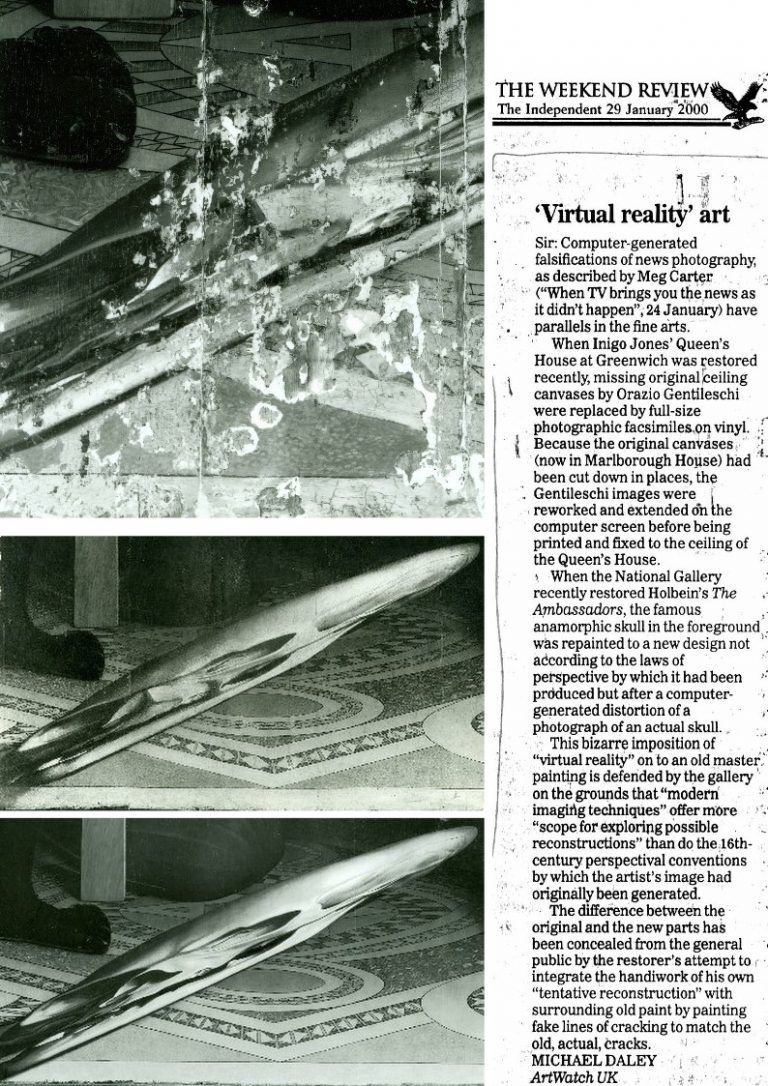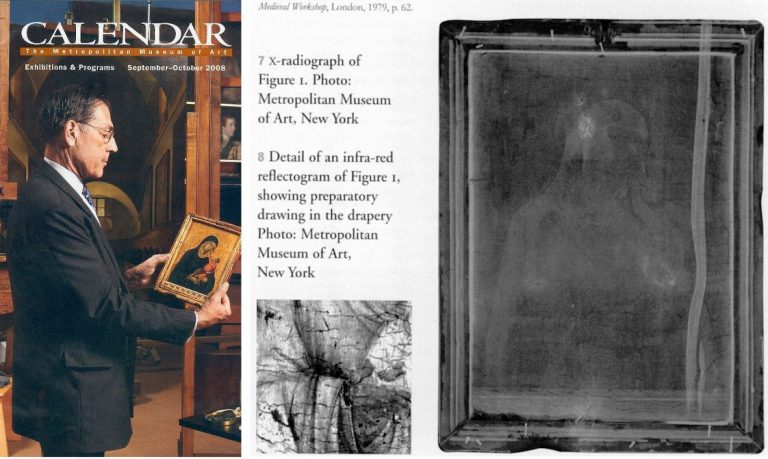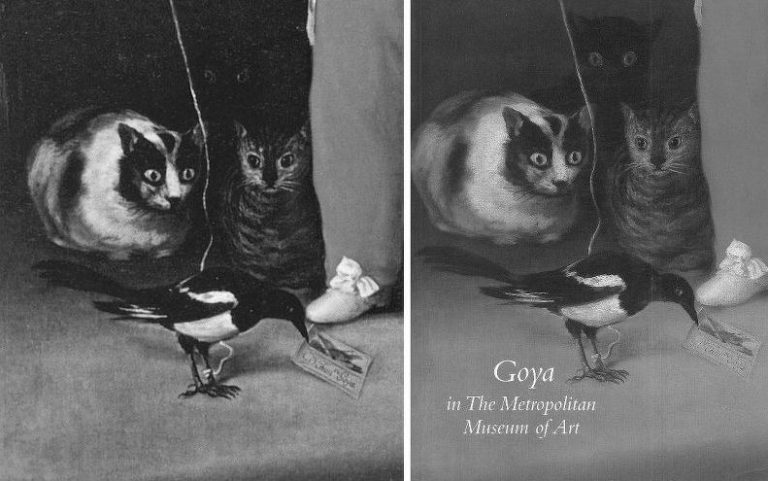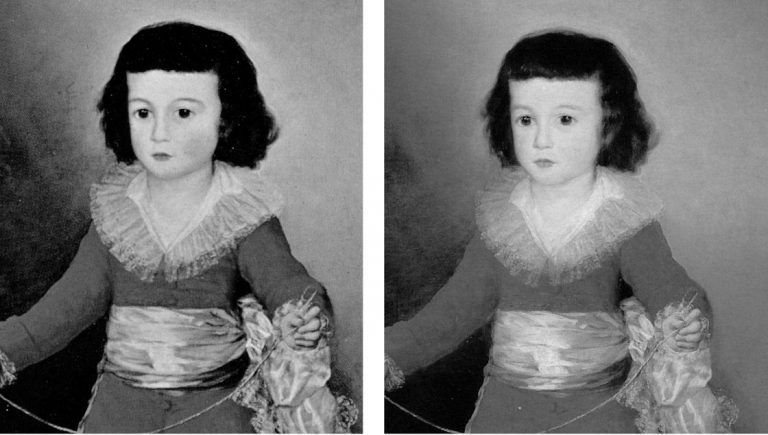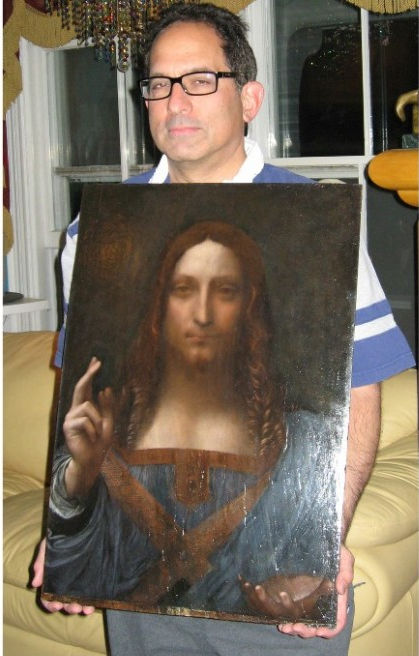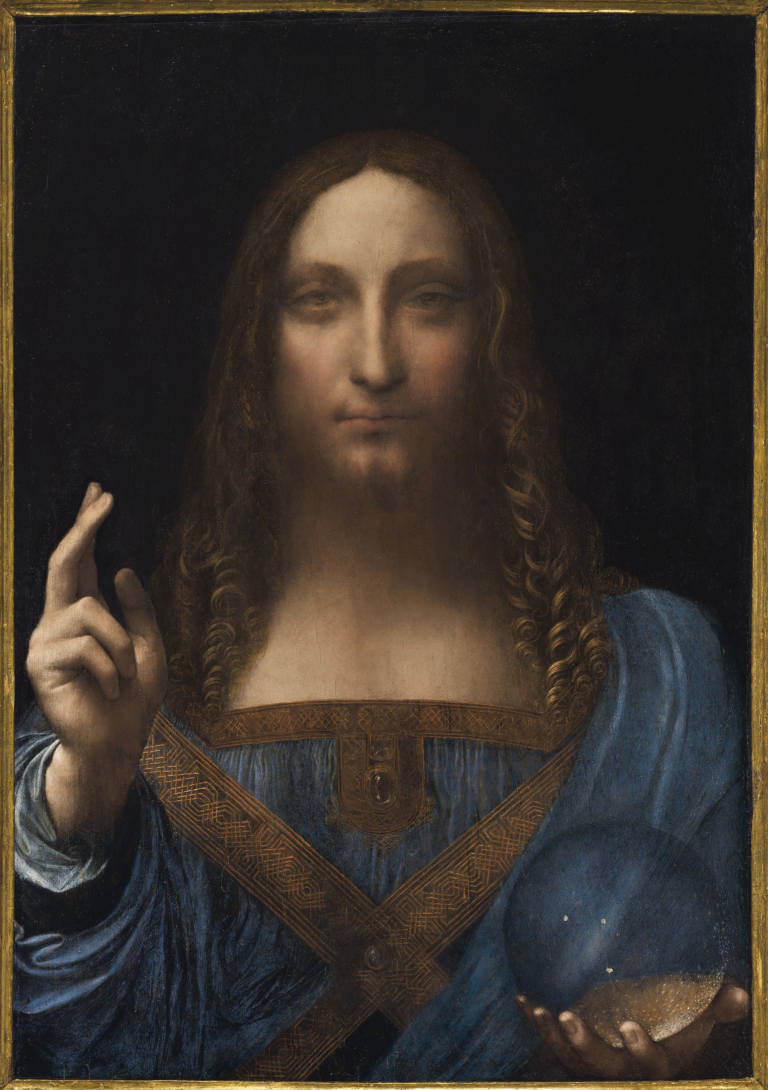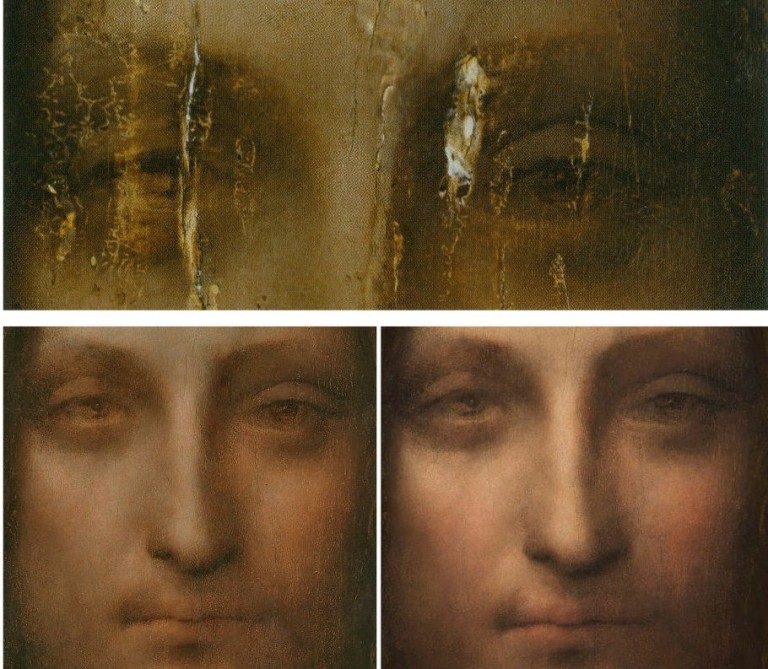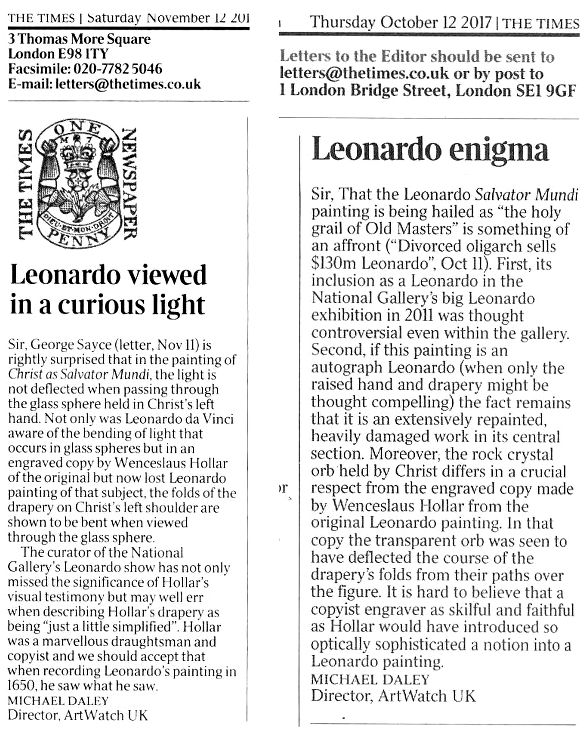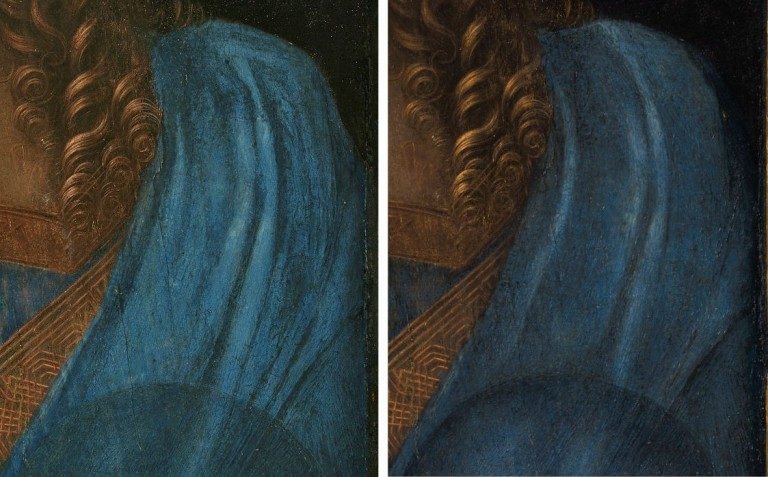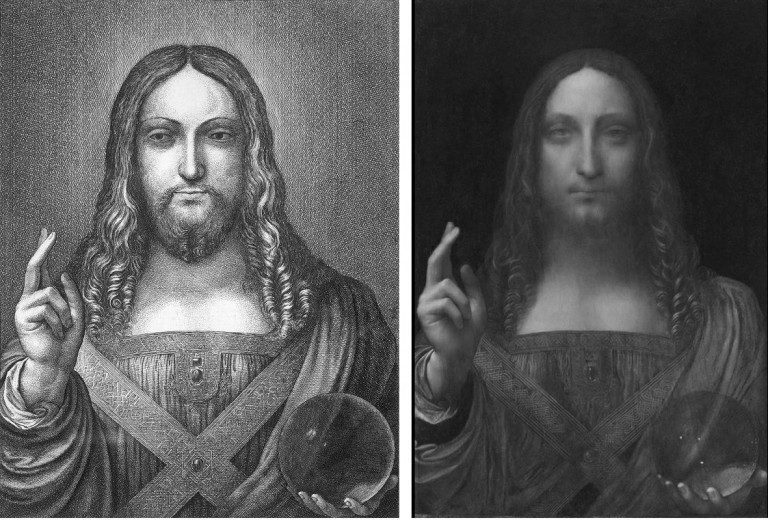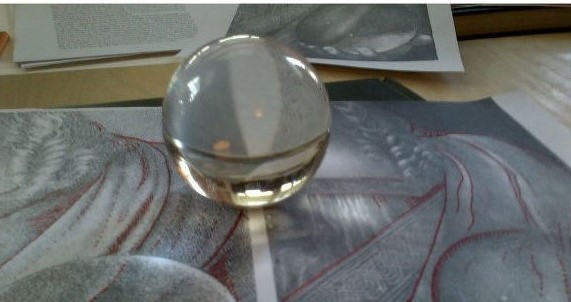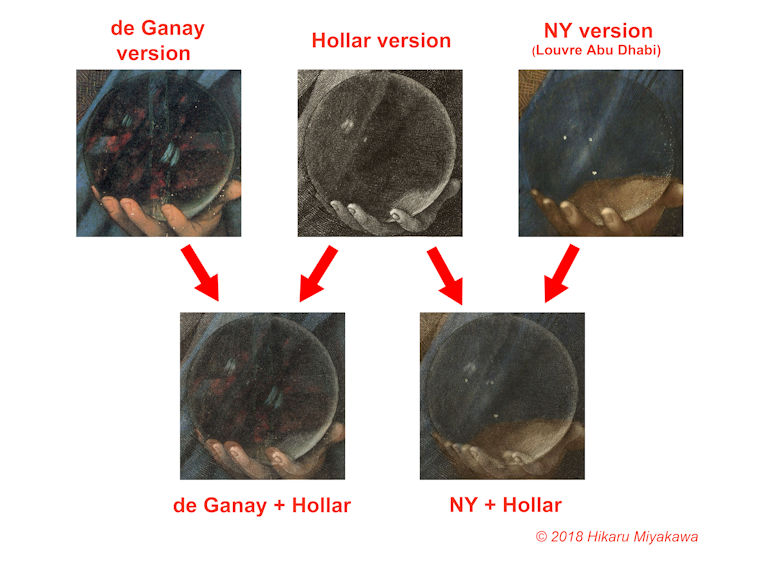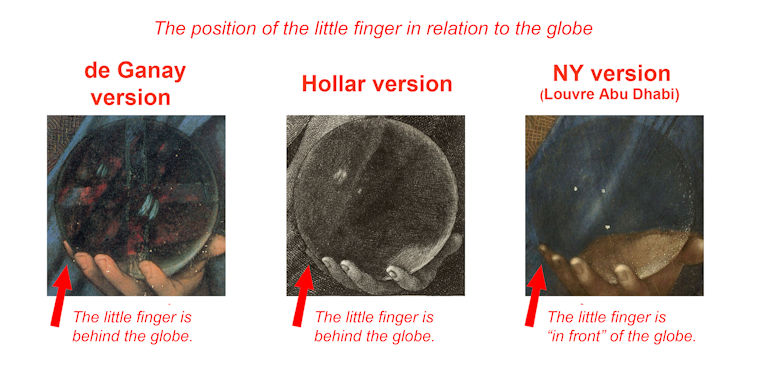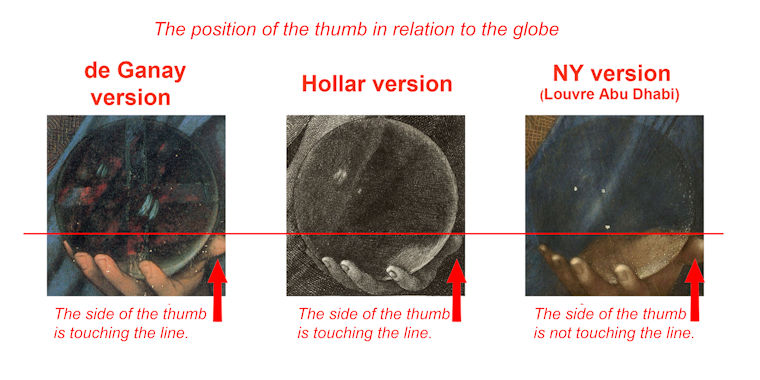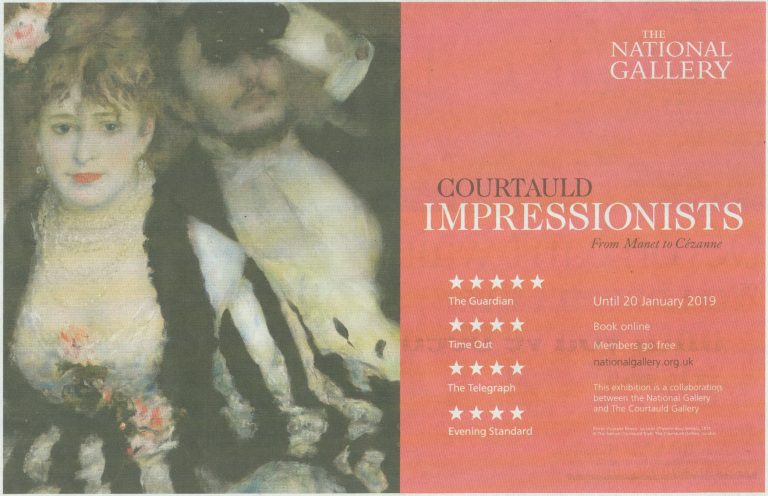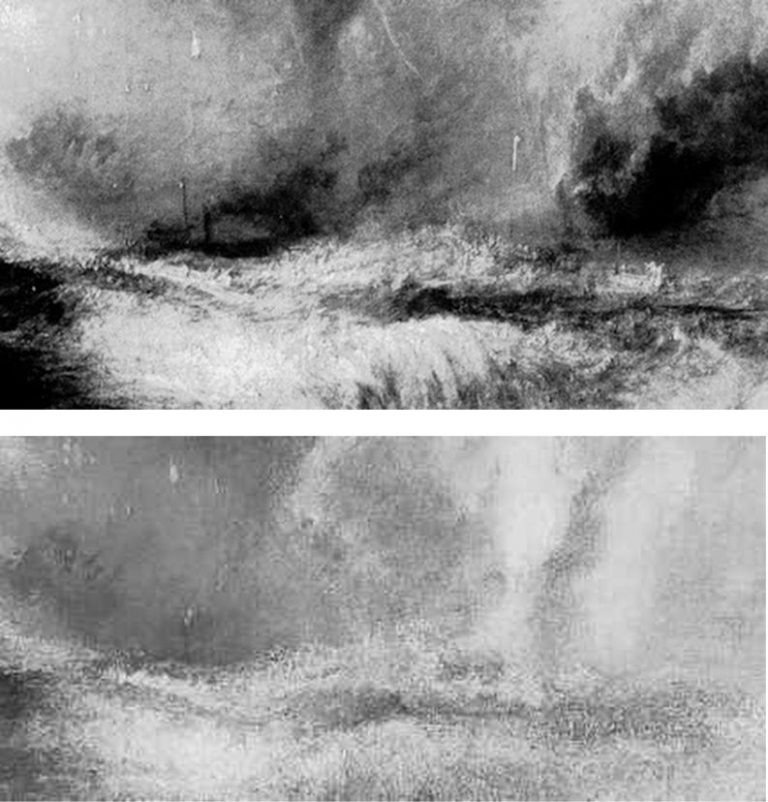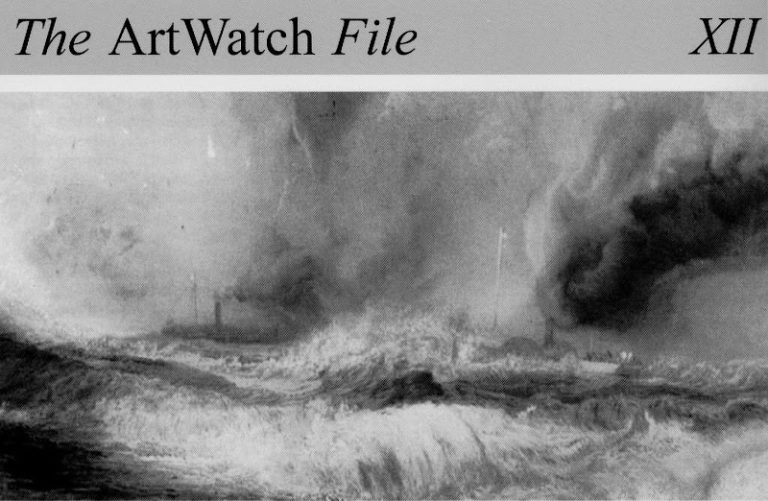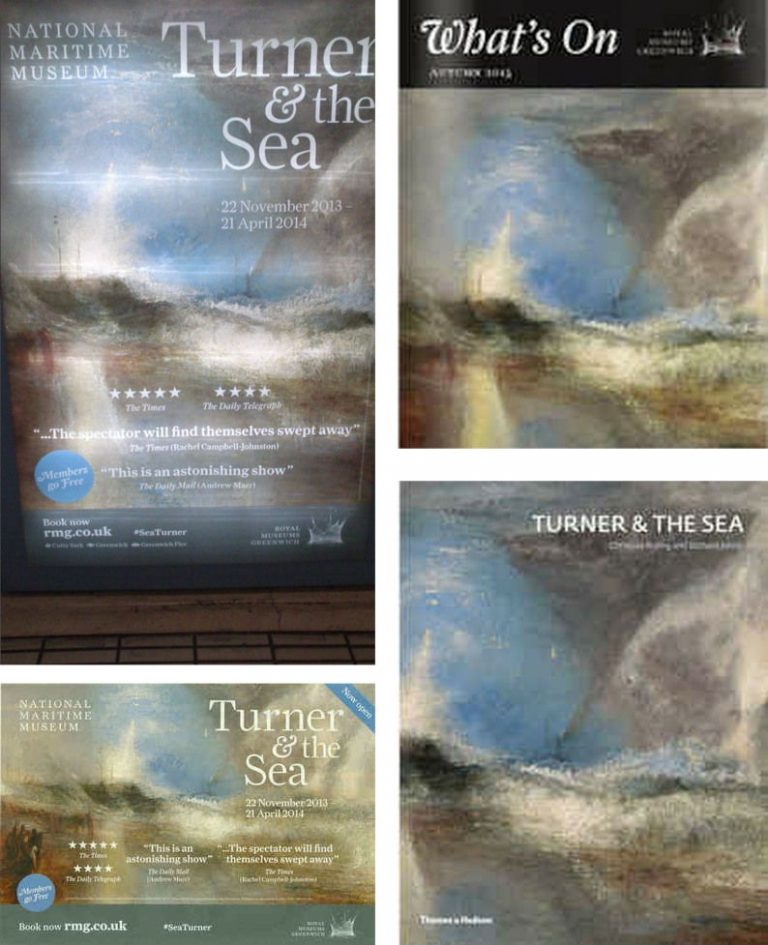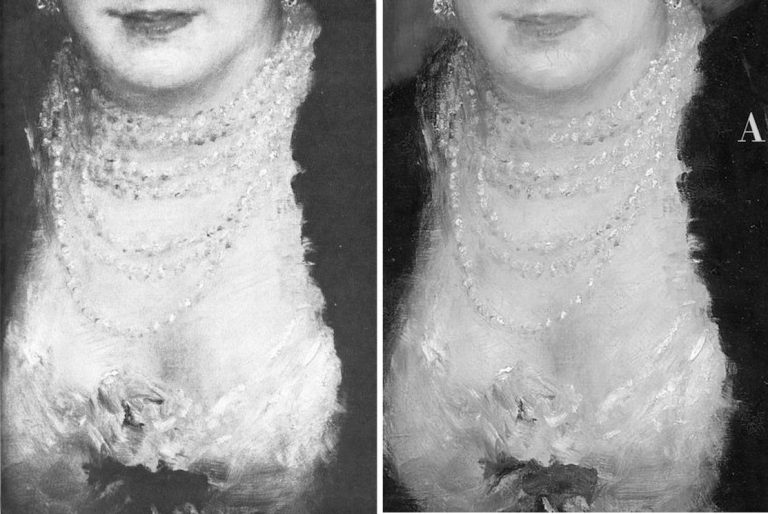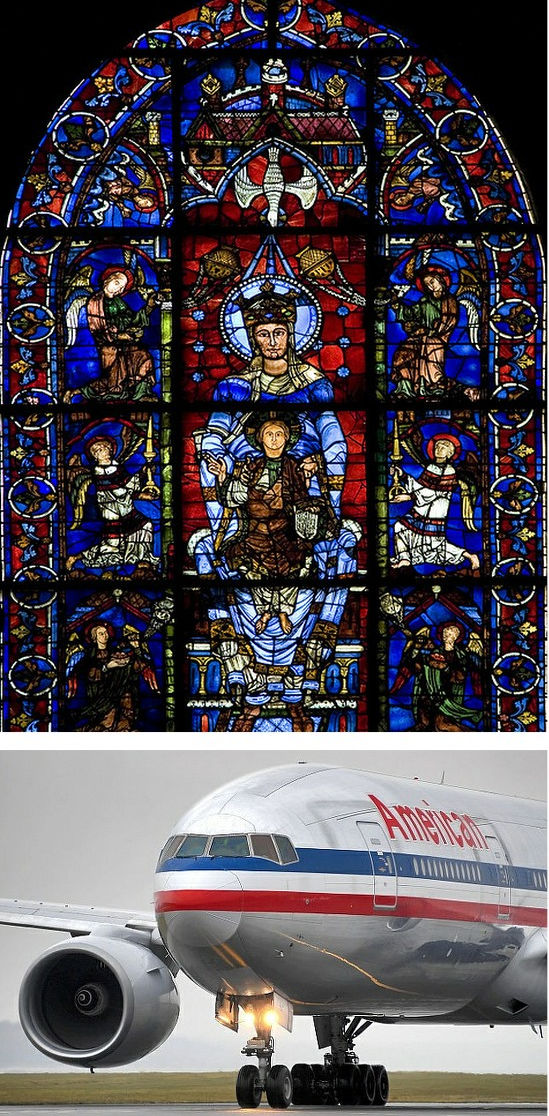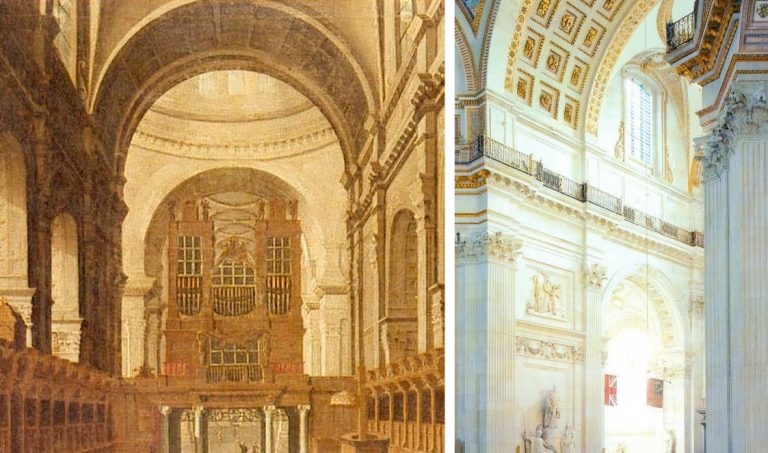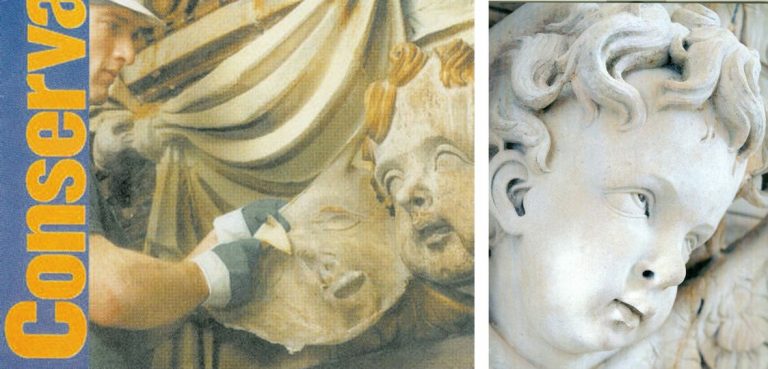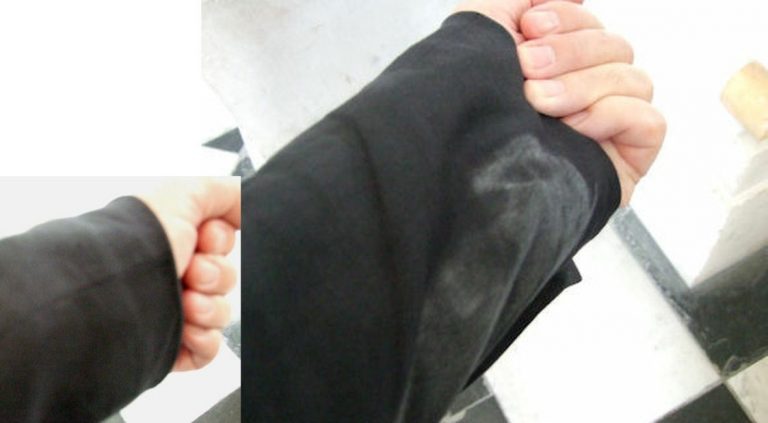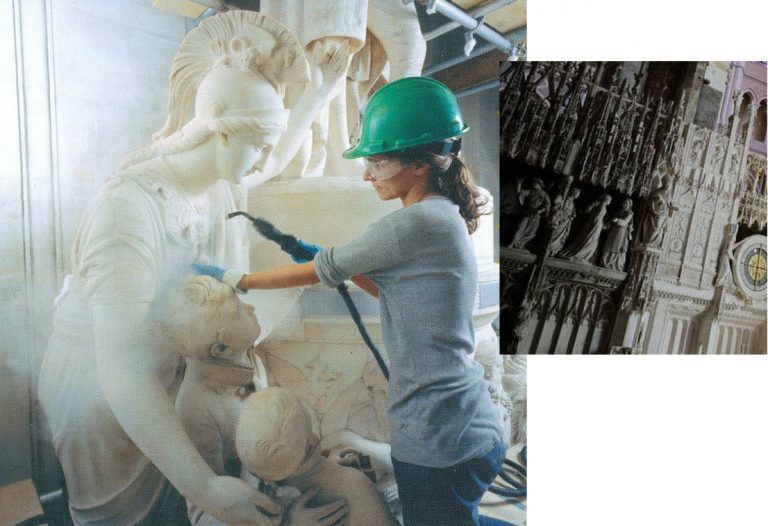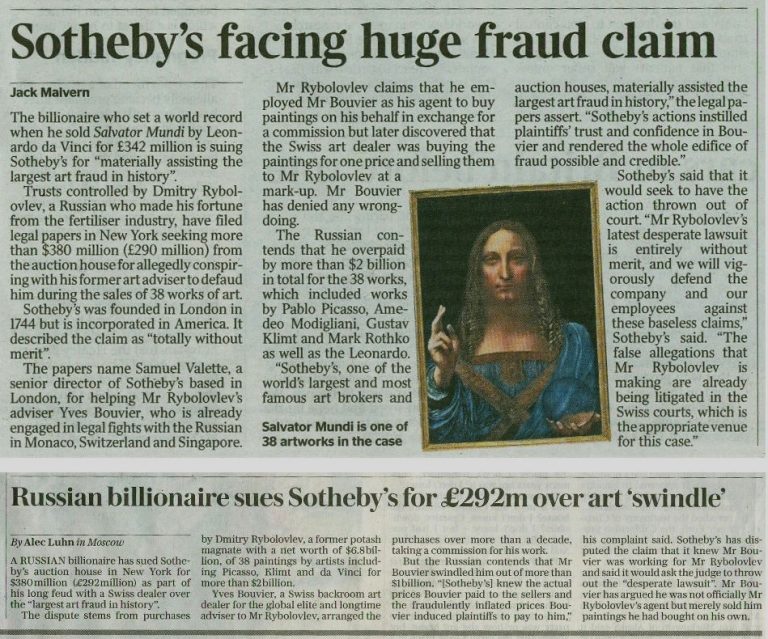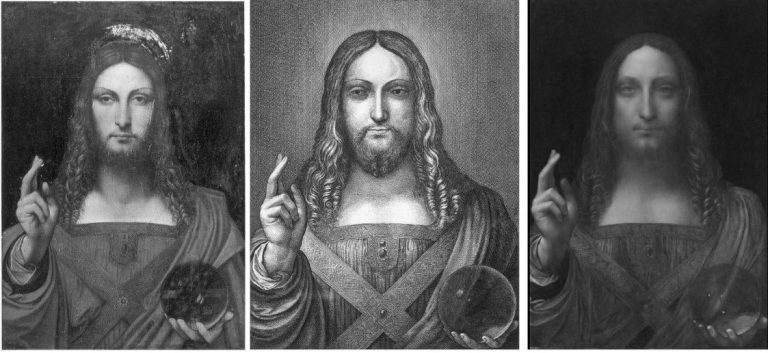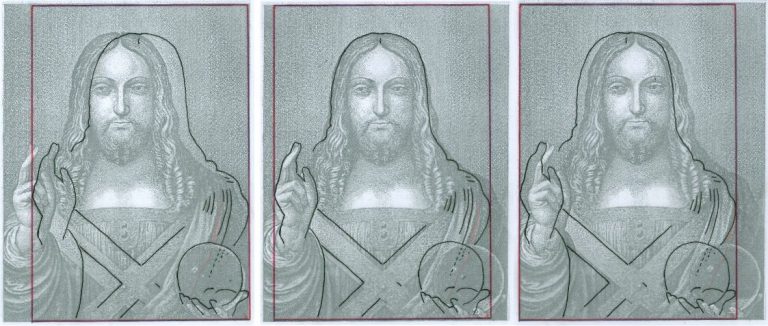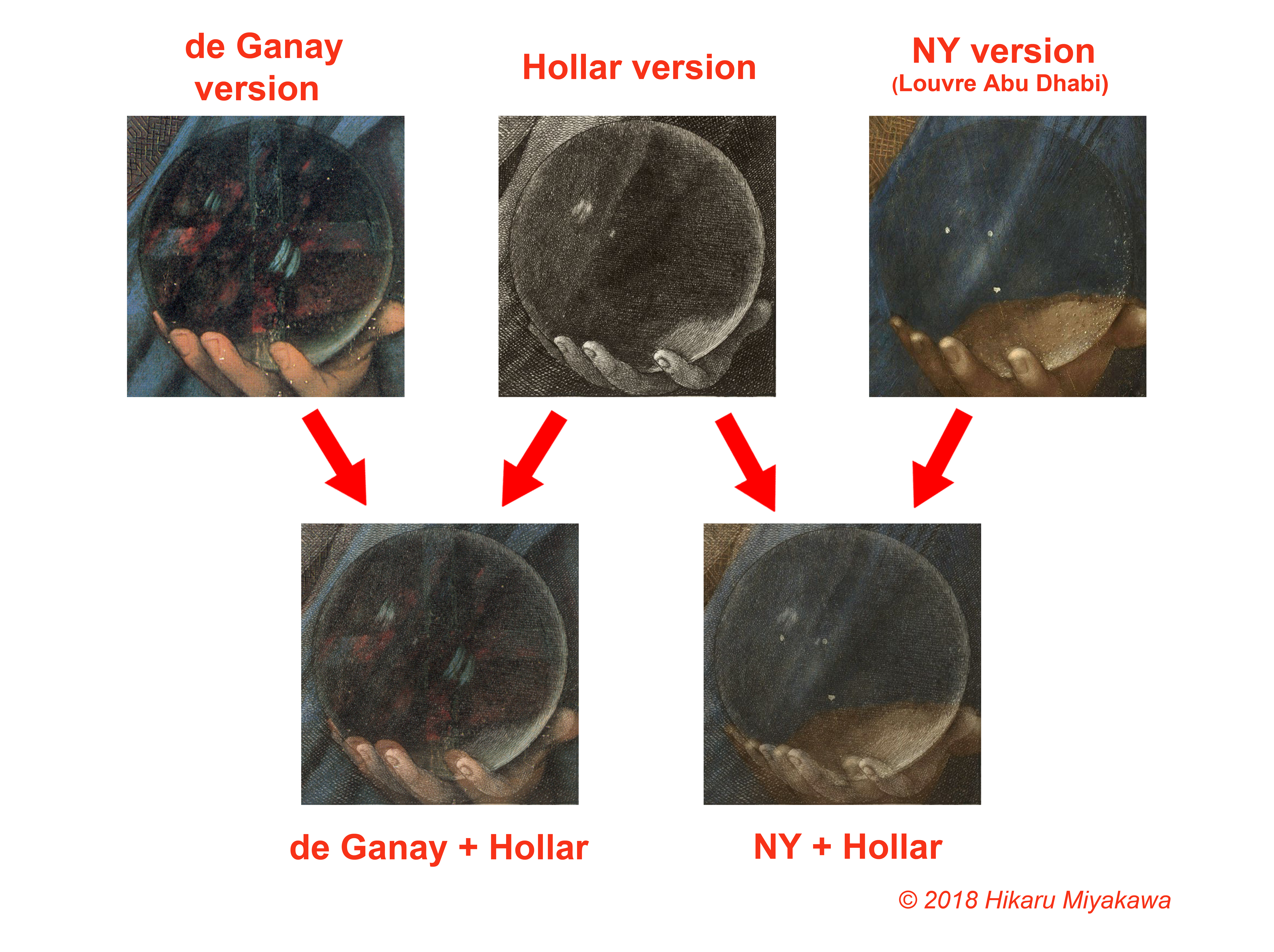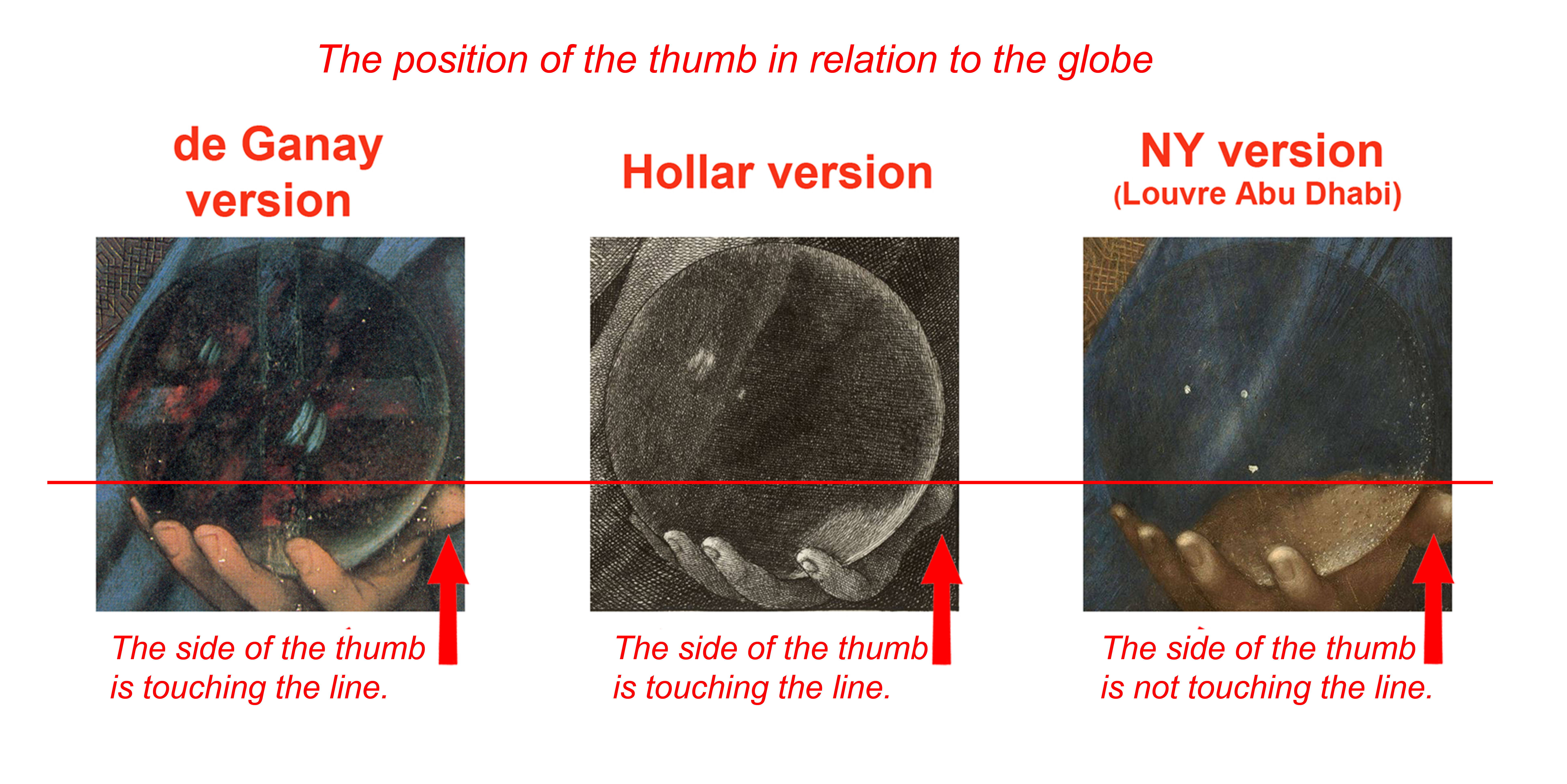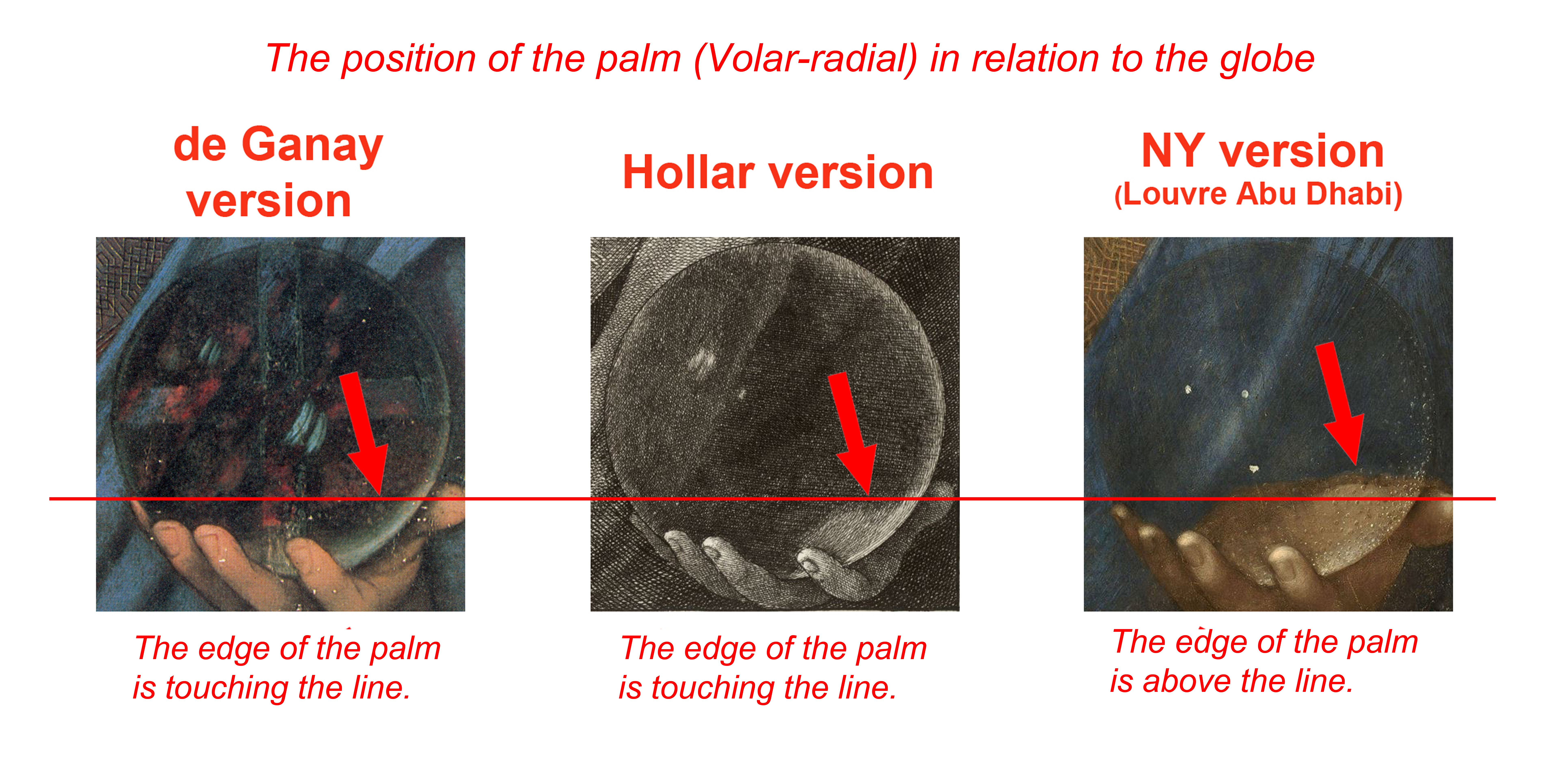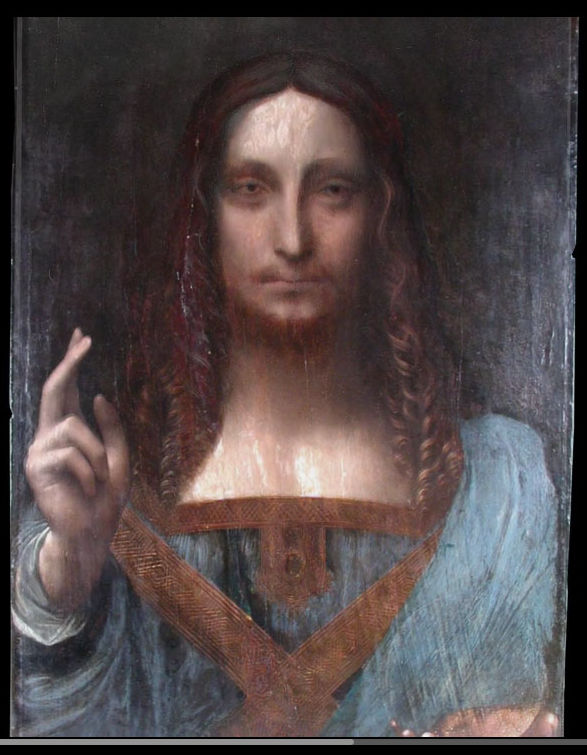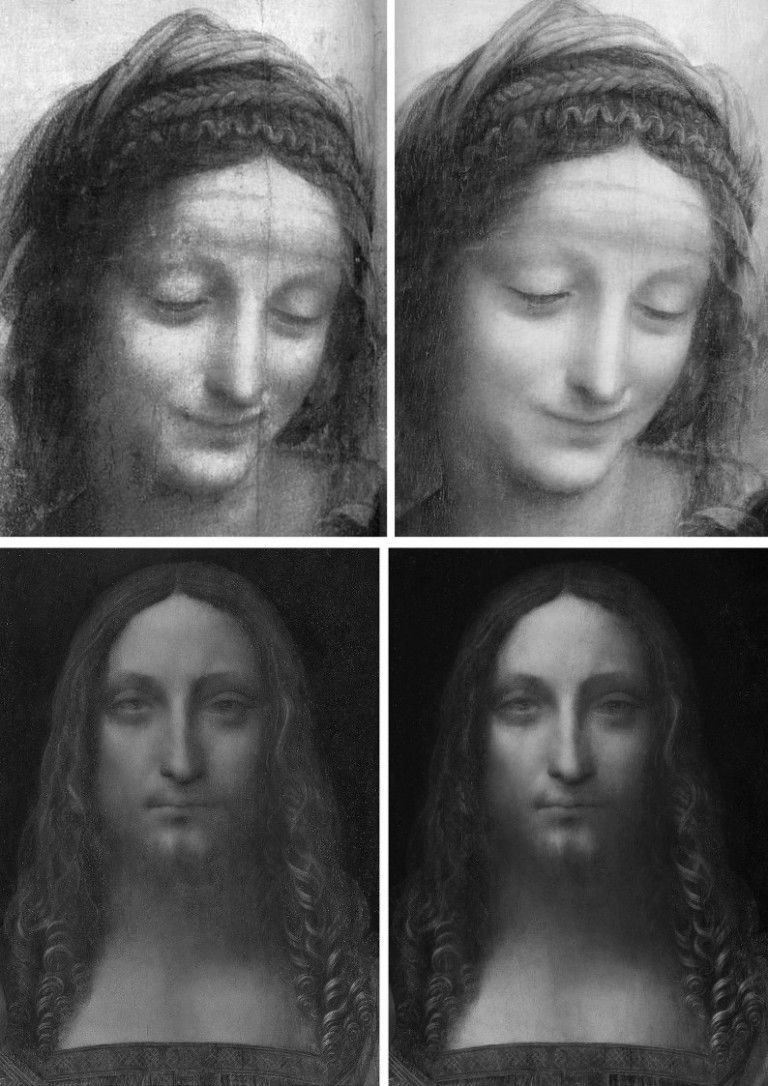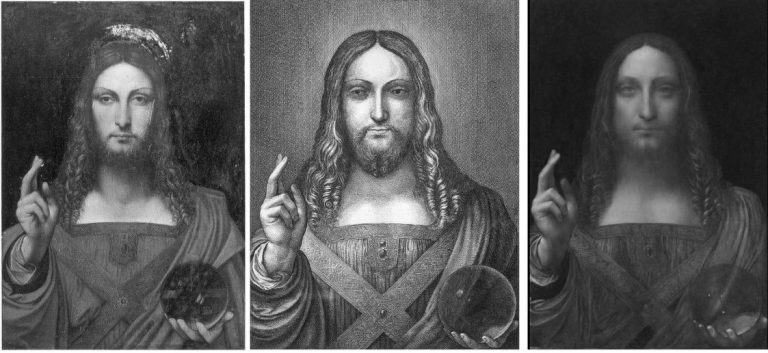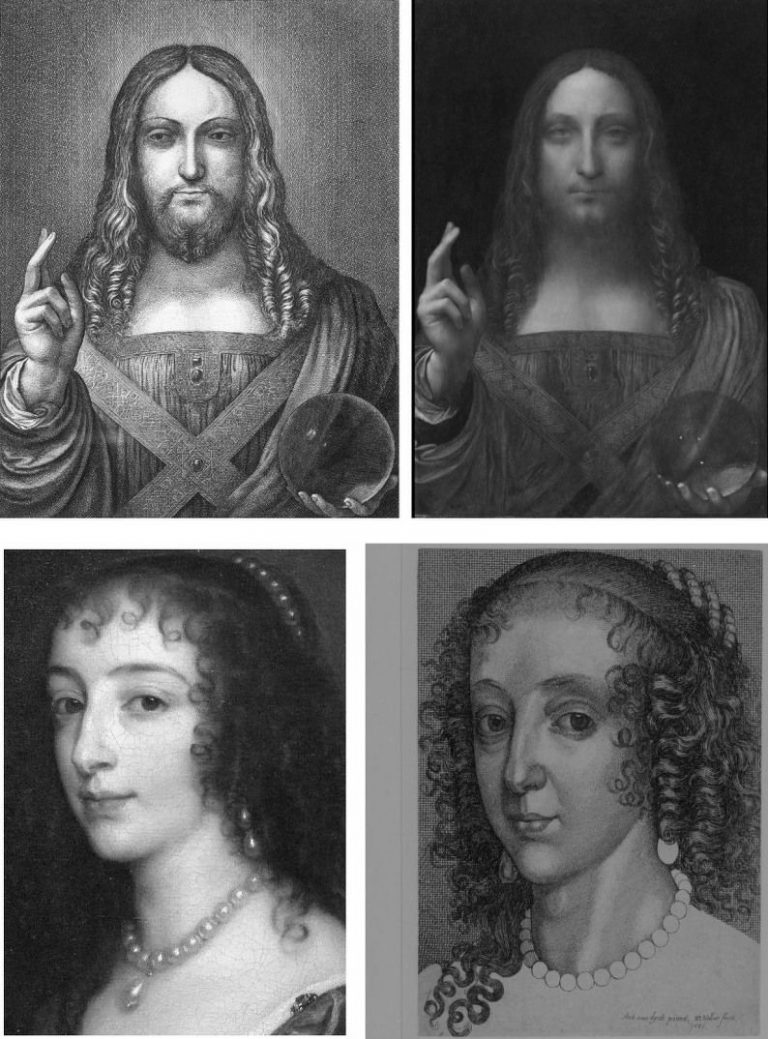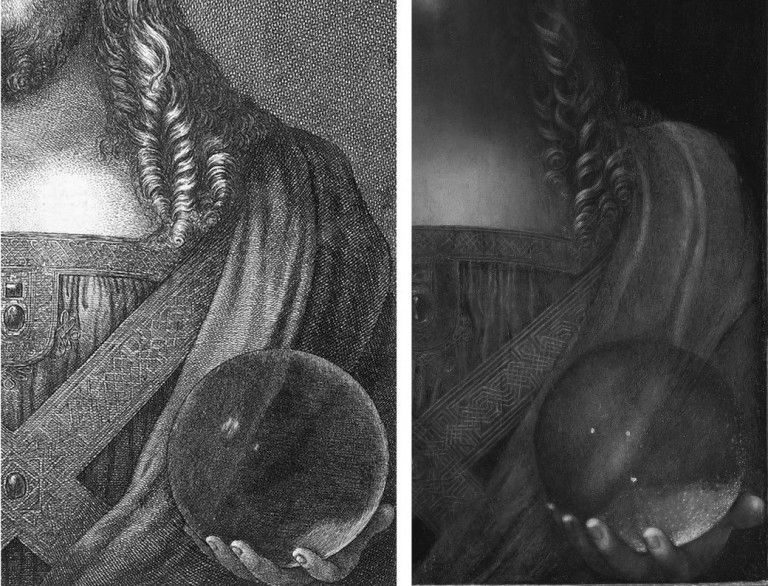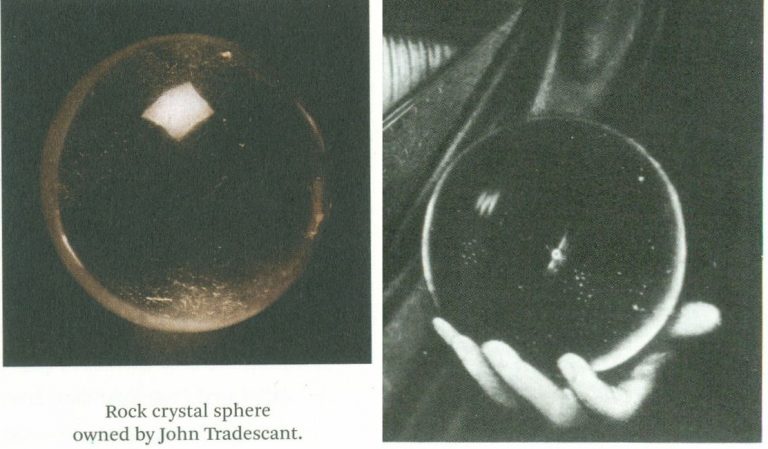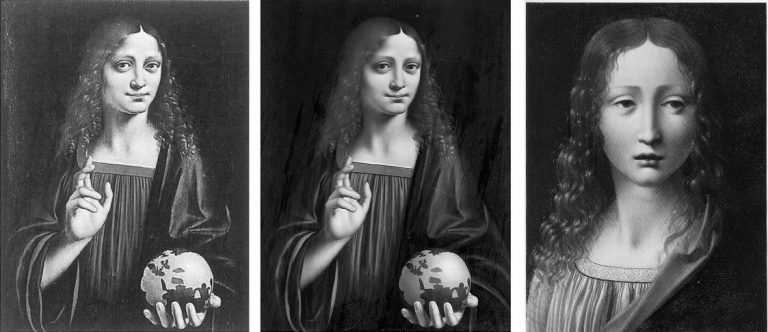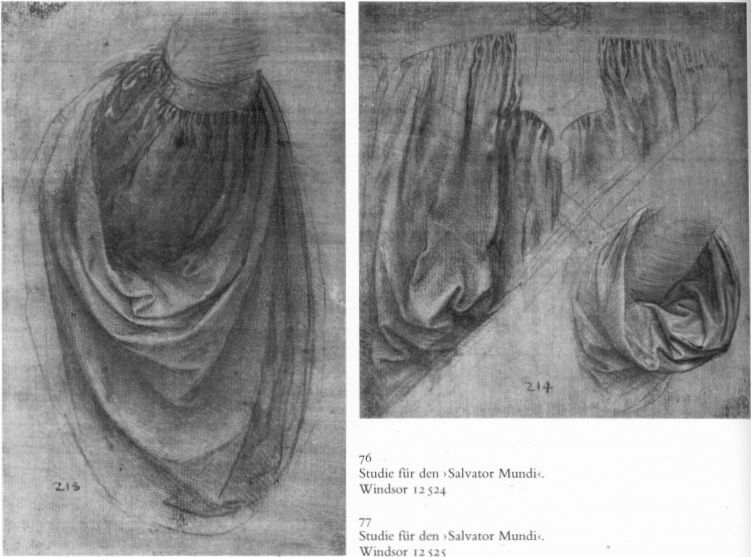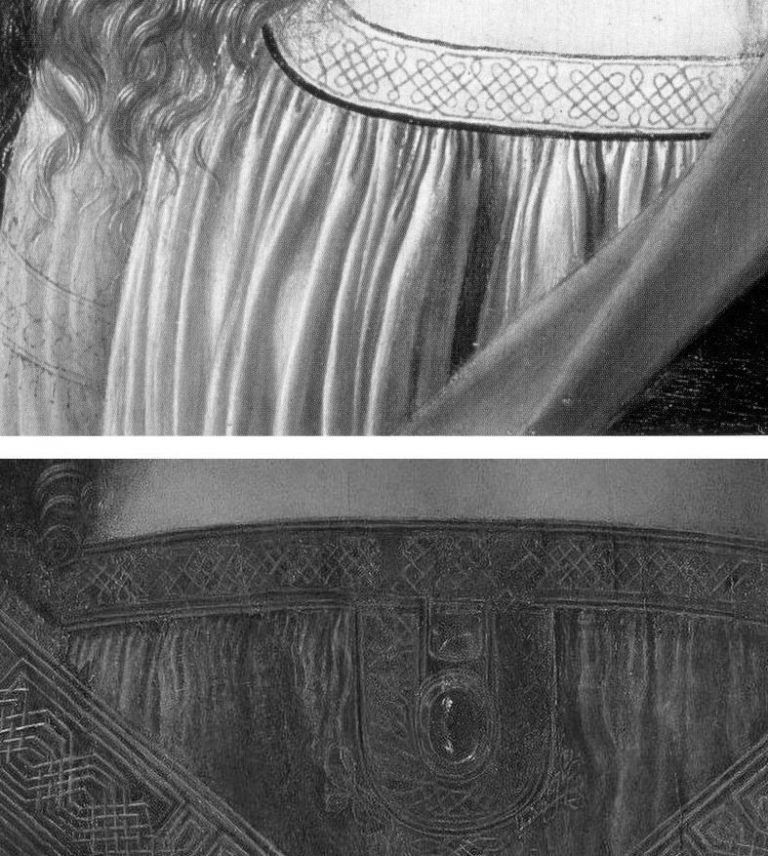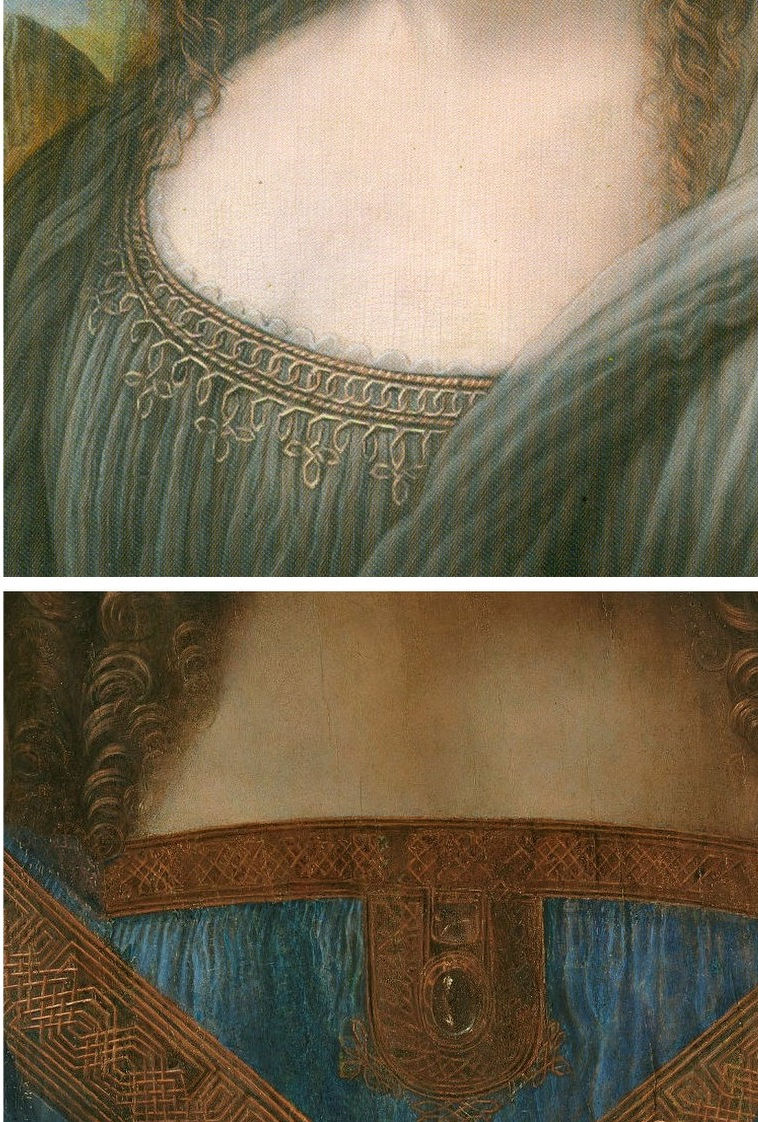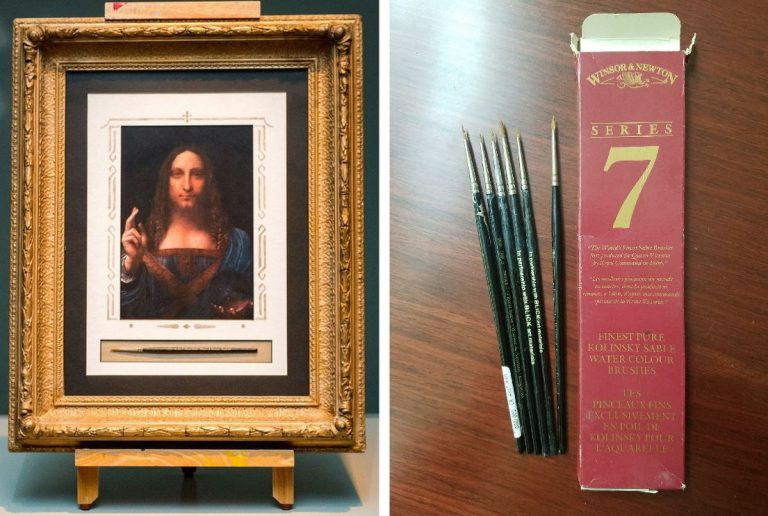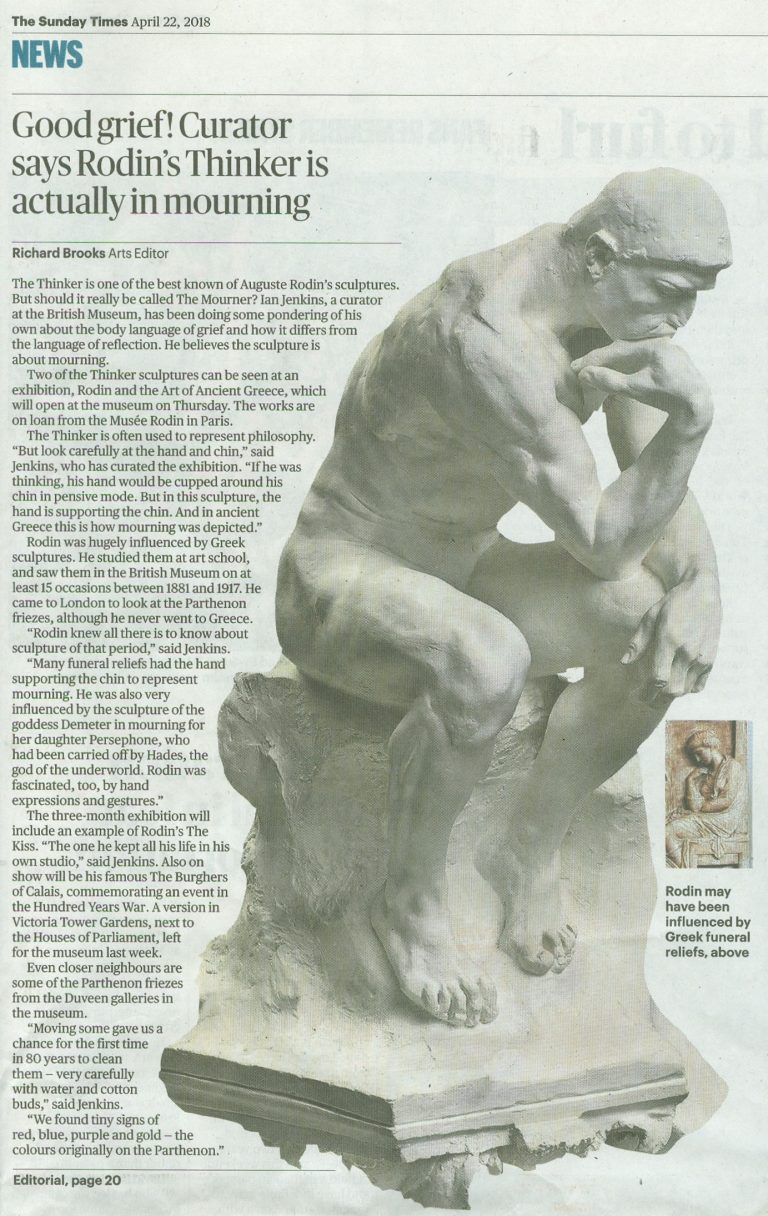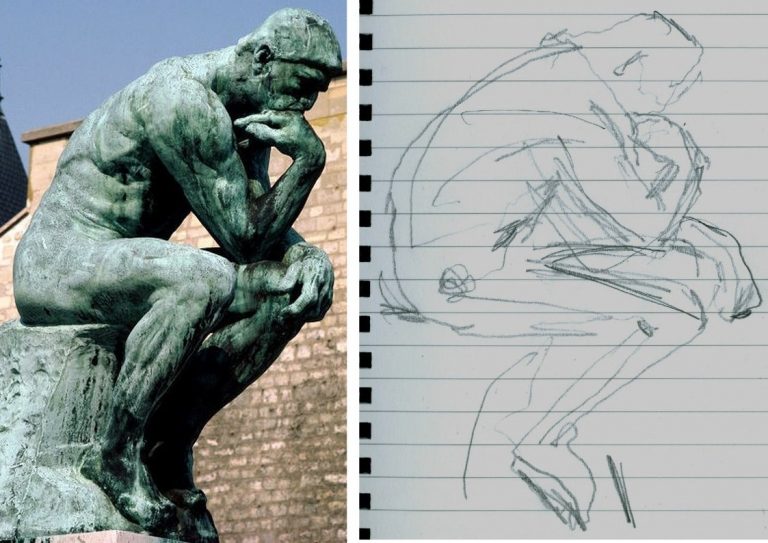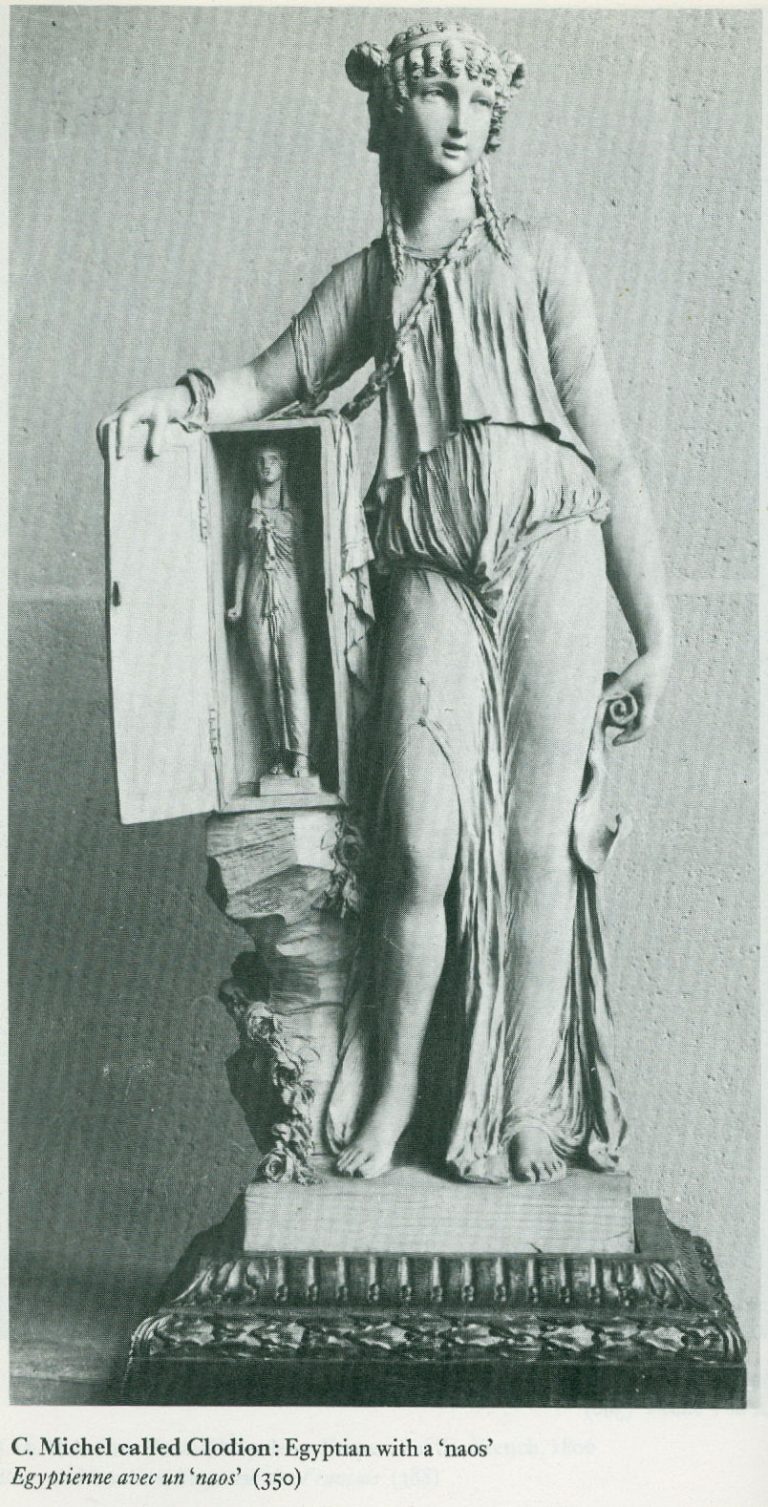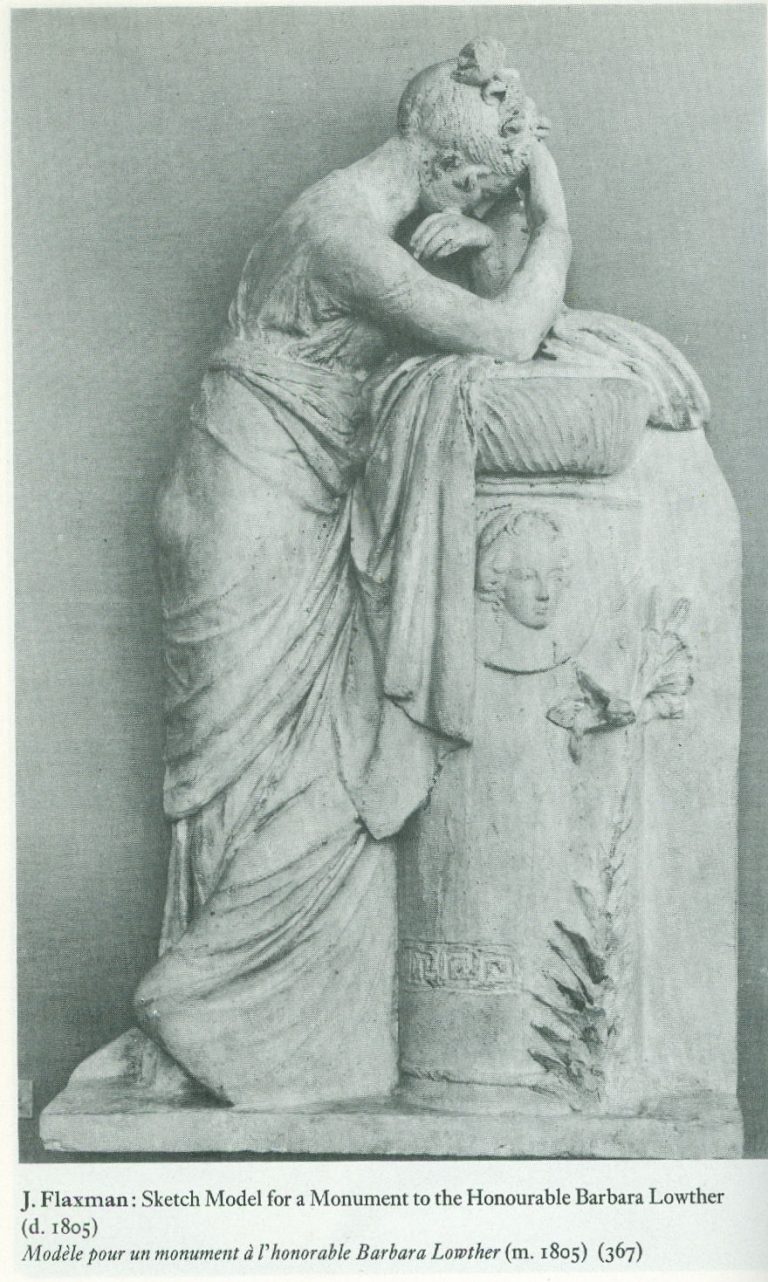Hollow Gods and Dangerous Beauty
With museum and gallery visits becoming ever-more crowded noisy expensive and denuded of works loaned, in needless restorations, or stored as directors play developers as well as impresarios, the appeal of small venues grows. Bury Street in St James’s is buzzing with two (free) exhibitions, one light on drawings, one rich.
A principal delight of the non-museum/gallery sector is un-trailed and unanticipated cross-fertilisation. Until 13 December, Hazlitt Holland-Hibbert is showing Eduardo Paolozzi (Hollow Gods – Sculpture and Collage from 1946-1960) and, hard after its “From Michelangelo to Matisse: Five Centuries of Drawing”, Colnaghi is running (until 24 January) a big and various show, “Dangerous Beauty” – dangerous because themed on “the seductive beauty of the female form” at a time when “women around the world are claiming back the right to be represented without male filters”.
Above, Fig. 1: Left, Paolozzi’s 1947 Fragment einer Grabstele aus Lokris, detail; right, Colnaghi’s Karl Parsons 1933 pencil drawn Patricia.
Where the Paolozzi show is, as its title indicates, light on drawings, the Beauty Show is especially rich and the Parsons drawing itself constitutes a dangerous revelation in one rumbling art political context discussed below.
It was something of a shock to realise just how historic – and overdue – this (nicely catalogued) Paolozzi survey is. For nearly two decades after the Second World War the sculptor was quintessentially modish and acclaimed as an intellectually and formally invigorating force. Rich in friendships with rising modernist critics and architects, Paolozzi was unusually cosmopolitan being of Italian parents in Scotland, spending time in Paris imbibing Picasso, Klee, Giacometti, Dubuffet and admiring Francis Bacon, Willem de Kooning, Leon Golub, Germaine Richier, Richard Stankeiwicz and Alberto Burri. In due course he, like many British sculptors, became an art fashion casualty of the all-conquering hard-line “concrete” formalist vocabularies forged by the St Martins School which grouping was held for a while to comprise Britain’s Greatest Sculptors since the Middle Ages. The self-impoverishment of that school’s stance – effectively, that material bears its own message – left space for Paolozzi, like Henry Moore before him, to become the leading producer of Grand Civic Sculpture and, even, to uphold the figurative banner. The Hazlitt Holland-Hibbert show demonstrates how much was lost when Paolozzi abandoned his fugitive evocatively battered but upstanding early figurative explorations for more decorative printed graphics (- sometimes veering on the psychedelic), design and large-scale architectural productions.
Strictly-speaking, Paolozzi was neither a traditional draughtsman nor a traditional sculptor. He did not carve, model or even fabricate. Rather, he scavenged, appropriated and re-assembled. From childhood he had been an avid, omnivorous reader and collector of illustrated books, comics, advertisements, sports, health and technical manuals. Amidst the world’s plethora of reproduced images and mechanical objects he showed a distinct nose and sympathy for the paradigmatic force of classical sculpture’s now-fragmentary figures, busts, bases, pedestals and so forth. It is possible that he was alerted to classical art – as well as to badges, uniforms and aeroplanes – when sent by his father to summer in fascist youth camps in Italy.
Above, Fig. 2: Left, A Group of Gauls, collage, pencil and wash, 1947; right, the Discobolus of the Castel Porziano, collage and ink wash, 1946.
Above, Fig. 3: Left, top, Untitled, collage, 1946; above left, Small Monument, 1956, unique bronze, H 13 inches (33 cm); second left, Figure with Raised Arm, 1955, bronze, H 18 inches (46.5 cm); third left, Robot, bronze, H 19 inches (48.5 cm); right, Figure, 1957, bronze, H 48 inches (123 cm).
CUTTING AND ASSEMBLING
Above, Fig. 4: Left, Untitled, 1948, collage, 37 x 24 cm; right, The Return, 1954, collage, pencil and gouache, 13 x 10 inches.
Paolozzi’s witty mini-essay on monuments at Fig. 3 caught the eye of Henry Moore, who bought it. The collaged Untitled image above left might easily be taken today as a trenchant visual synopsis for the “Mad Men” TV series but in the UK’s impoverished food-rationed and punitively-taxed post-war years American affluence had yet to become a source of self-loathing shame and Paolozzi’s collaged image might better be seen as an innocent celebratory act of awe and wonderment. His affection for the United States famously (and influentially) extended to its popular culture and especially to its movies which he saw not as sources of harvestable imagery but as “direct experience” to be lived. Boris Karloff, The Mummy’s Hand and Frankenstein were, however, acknowledged to have “supplied a thread in his beat-up human image.”
As late as 1957, Paolozzi saw the United States as offering more to an artist than the Mediterranean. However, with The Return, above right (and other such graphic collages) a darker colder side emerges. Slicing up images – particularly images of faces – and reconfiguring them to misaligned satirical intent is not cuddly. Much later, in the 1980s, Paolozzi would carry the cutting and reconfiguring into grander more conventionally realised sculptures whose forms were clearly delineated by an otherwise continuous surface skin. Those late dismembering exercises seemed free of sadistic intent and to be deployed more to impart a formal dynamism than any expressive or symbolic purpose. Nonetheless, slicing up and recomposing images or effigies of human faces and heads is inherently unsettling and question-raising. Does the enlarged, flattish circular head of Paolozzi’s St Sebastian at Fig. 7 below allude to a sun/halo or an archer’s target board?
Above, Fig. 5: Left, top, a Paolozzi self-portrait made as an eleven-year old schoolchild; left, above, Paolozzi’s 1953 ink drawing Self-portrait; second left, a 1961 drawing for the sculpture Tyrannical Tower Crowned with Thorns of Violence – and as realised at the National Galleries of Scotland, above, far right; third left a photo-collage of 1946.
AUTHENTICITY IN AN ERA OF UNIVERSALLY HARVESTABLE AND REPLICABLE IMAGES
Above, Fig. 6: Above, top, Paolozzi’s 1947 photo-collage Fragment einer Grabstele aus Lokris shows the artist at full throttle. The limited means – just three “lifted” images – is classically restrained: a cheesecake pin-up of the kind that had recently graced millions of soldiers war-time lockers and kit bags; an eloquent fragment of antique carving speaking of lost civilisations; and, as representative of the future and increasing well-being, an item of machinery that perfectly mimics Western modernist artists self-consciously cultish appreciation of African masks. Today, we make what we may be permitted of this nicely triangulated homage but sparks still fly and engage with other art – as with the above famous 1926 Paris Vogue Man Ray portrait of Kiki de Montparnasse.
The Man Ray photograph had found echoes before Paolozzi, as above in the 1942 promotional/glamour photograph of Lana Turner by Eric Carpenter (which is preceded by Ingres’ pencil copy of Leonardo’s painted portrait known as La belle ferronnière ). In the 2000 Hollywood Portraits book by Roger Hicks and Christopher Nisperos, the authors raise questions of authenticity in photography-as-art. While Carpenter’s “chiaroscuro is striking”, they seem to complain, “there is much retouching in this picture. Most of what we see between the actress and the statue looks like airbrushing, particularly the shadow next to her cheek, but the keyline on the chin is genuine and beautifully executed – a reflection from the background…the profile is masterful, and the canting of the camera – a popular device at the time – is all but essential: it places the main subject’s face at a more attractive angle and greatly reduces the apparent mass of the statue, which otherwise might dominate the composition. The principal tricks in re-creating this picture are, first, the very careful control of the chiaroscuro; second, the angled camera; and third, diligent and extensive retouching…” (For Hicks and Nispero’s further views on the role and means of retouching, see “Coming to Life: Frankenweenie – A Black and White Michelangelo for Our Times” .)
With the many technical and professional advances in photography and cinema – not least digitalisation – and the widely indulged licence to tamper -the boundaries between art (where images are made) and photography (where images are taken) are clearly weakening. Practical problems follow: can steps be taken to prevent or even identify the illicit manufacture of perfectly deceiving facsimiles of bona fide works? As Dalya Alberge discloses, Man Ray’s iconic Kiki de Montparnasse image exists in more versions than should be the case – “Fake Man Ray prints are hanging on museum and collectors’ walls, leading specialist warns”.
CLASSICAL TENACITY
Above, Fig. 7: In this fast moving and problematic technical world, the simultaneous appearance within a hundred yards of Paolozzi’s 1957 bronze St Sebastian IV and Karl Parsons’ 1933 pencil drawn Patricia came as a jolt. We all well know of Paolozzi’s art but how many knew of Parsons’ society portrait drawings? The two works above left and centre might seem worlds and eons apart but where Paolozzi was thirty-three years old when he made his St Sebastian at a time when traditional art school practices were crumbling, he was nine years old when the forty-nine year old Parsons drew Patricia (in what would be the last year of his life). Parsons had attended some classes at the Central School of Arts & Crafts in London but essentially learned his craft in the doing – that is, in the time-honoured role of apprentice to a successful working master, in his case, to the leading Arts and Crafts Movement stained glass maker, Christopher Whall. Parsons went on to carry out major commissions for the windows of Canterbury, Gloucester, Cape Town and Johannesburg cathedrals. Beyond that rigorous training and high-level artistic practice, Parsons all the while had at his back centuries of tradition – it is not fanciful to see a direct line from Michelangelo’s monumental painted profile from the Sistine Chapel ceiling’s Erythraean Sibyl (here mirrored, above right) to Parson’s modest (15 by nearly 12 inches) monogrammed profile portrait in pencil on paper.
Above, Fig. 8: Colnaghi’s larger, mixed show happens to contain a mini-exhibition of modern (traditional) female profile portraits drawn on paper. First, above left, is Augustus John’s 1907 portrayal in black chalk of his mistress/muse/mother figure, Dorelia McNeill, who at sixteen had edited a magazine called The Idler. Second left, is Gerard Leslie Brockhurst’s pencil on paper portrayal, Anais. The Parsons drawing’s sitter is considered most likely to be Patricia Frances, Lady Strauss. A vintage National Portrait Gallery photograph of her (by Bert Sachsel), from the late 1930s or early 1940s, as above right, displays striking facial similarities, as well as the same hairstyle. Patricia, an author and politician who stood unsuccessfully for the Labour Party in Kensington South at the 1945 General Election, married George Strauss, MP, in 1932, and became Lady Strauss in 1979. A significant patron of both the performing and the visual arts, she led a campaign to persuade the government to use half a percent of the cost of all new buildings for works of art and pioneered the first international sculpture exhibition in Battersea Park. (In the 1963 Battersea sculpture show Paolozzi exhibited along with Henry Moore, Kenneth Armitage, Reg Butler, Lynn Chadwick, Geoffrey Clarke, Bernard Meadows, William Turnbull and others.)
Above, Fig. 9: Top, two stained glass heads by Karl Parsons; above, left, Paolozzi’s 1953 self-portrait, and, above, right, one of his 1980s ink on tracing paper studies of the architect Richard, now Lord, Rogers. More than half a century and the Second World War stands between the above two pairs of images. The chasm of artistry and draughtsmanship between Parsons and Paolozzi in these works might seem painful to contemplate. Looking at these images today, who eclipsed whom artistically? The principal charge against Arts and Crafts depictions was of a perceived saccharine sweetness and sentimentality. Was the suppression of such traits best or necessarily made by evocations of psychic derangement and a drawn proposal for a combined scalping and splitting of an identifiable person’s effigy bust? Are we still forbidden to admire the remarkable artistry and sheer force of expression in Parsons public works?
Above, Fig. 10: Left, “La Bella Principessa”, a mixed media drawing attributed to Leonardo; right, Karl Parson’s Patricia.
In the pairing above, we see either Parsons pitted against a newly discovered (that is, a claimed) Leonardo drawing of a princess, or – as we believe – two possibly near-contemporaneous twentieth century works. The emergence of Parson’s pencil-drawn Patricia (above right) coincides with a near decade-long campaign of advocacy on behalf of the (unsold) supposed-Leonardo portrait of a short-lived Milanese princess, Bianca Sforza (above left), that Professor Martin Kemp dubbed “La Bella Principessa”. The drawing was so attributed in knowledge that this profile portrait type has been assailed by modern forgeries: “Complications for the historian lie both in the fact that the subjects of most female portraits are no longer identifiable and that, because of their exceptional decorative and historical appeal, such portraits were highly sought after by later nineteenth- and early twentieth-century collectors, encouraging a market for copies, fakes and over-ambitious attributions” – Alison Wright, The Pollaiuolo Brothers, Yale University Press, 2005.
Above, Fig. 11: Left, the (mirrored) obverse of a bronze medal of c. 1486 attributed to Niccolo Fiorentino; right, four 15th century paintings judged most likely by the Polliauolo brothers, Antonio (figures 1 and 4) and Piero (figures 2 and 3). We mentioned a link between Parsons and Michelangelo. In truth, Parsons’ Patricia may intentionally have referenced the earlier (15th century) archaising profile portrait tradition with paintings made in emulation of classical relief portraits found on antique coins.
Since its first appearance as a prospective Leonardo drawing, we have suspected “La Bella Principessa” to be a work of the 20th century. The fakes-generating popularity of the profile-lady type of which Alison Wright spoke is attested in Fig. 12 above, where we see that in the early years of the 20th century, Antonio del Pollaiuolo’s Profile of a Woman seems to have enjoyed position as an exemplar of the 15th century profile portrait type wherein, as Ingres noted, “Never is a woman’s neck too long”.
TRUE TO TYPE?
Above, Fig. 13: We take all three works in the top tier to be modern productions and all four works in the bottom row to be not only bona fide 15th century paintings but, in the case of Antonio Polliauolo’s Profile of a Woman in the Museo Poldi Pezzoli, Milan (as in the fourth and fifth images) the most popular version of a most popular type. For those wishing to make modern versions, Polliauolo’s Milan profile seems to have been taken almost as a template because of its great attractiveness and because its rather truncated composition greatly minimises the work needed properly to depict a richly and elaborately costumed torso (– as seen below at Fig. 14). The authors of all three versions in the top tier have taken short cuts and depicted implausible costumes.
The picture on the left was bought in 1936. The picture in the centre first appeared in 1998 – 502 years after its presently-claimed execution. The figure on the right was last seen in a book published in the 1940s. It then disappeared and its whereabouts are now unknown.
The first picture was bought by the Detroit Institute of Arts as by Andrea del Verrocchio or Leonardo da Vinci. It was recently exposed as an outright fake: it contains modern pigments and it was painted on top of a photograph – see “Art’s Toxic Assets and a Crisis of Connoisseurship ~ Part II: Paper (sometimes photographic) Fakes and the Demise of the Educated Eye”
The “La Bella Principessa” drawing emerged without provenance and anonymously as the property of a lady in 1998 at Christie’s, New York, where it was sold as a 19th century German work for $22, 850 to a dealer who sold it on in 2007 for $19,000 to its present owner. Its advocates have said of tests on the vellum: “This dating confirms that the portrait could well have been made in Leonardo’s lifetime, supporting Martin Kemp’s proposed date in the mid-1490s and virtually eliminating the possibility that it is a 19th century pastiche.” “Confirming” a “could well have been” is double-speak which itself rests on only a loose and wide overall estimation of probabilities. It was not acknowledged that within the overall figure, the probabilities had been greatly more precisely quantified. While the report states that there was a 68.2% probability that the sheet was made between 1470 and 1650, within that period there was only a 27.2% probability that the drawing was made between 1470 and 1530 – whereas there was an appreciably greater probability (41.0%) that the sheet was made some time between 1550 and 1650. Had the vellum been made at any point after 1496, when the work is claimed to have been executed by Leonardo, the attribution would sink. Moreover, even if the sheet had existed before 1496 that would not establish the date of the drawing’s execution: in The Art Forger’s Handbook Eric Hebborn explained that a prime source of old materials is obtained from blank end papers in books.
Above, Fig. 14: Left, Pollaiuolo’s Profile of a Woman; second left, “La Bella Principessa”; third left, Portrait of Bianca Maria Sforza, c. 1493, by Ambrogio de Predis, The National Gallery of Art, Washington; right, Domenico Ghirlandaio, Portrait of Giovanna Tornabuoni, (1488) Museo Thyssen-Bornemisza, Madrid.
It is striking in this comparison with three secure paintings how dull and underpowered the work is and how (relatively) impoverished is the appearance now-claimed subject, Bianca Sforza, the short-lived illegitimate daughter of Il Moro, the Duke of Milan. The subject third left is said to be Bianca Maria Sforza, Bianca Sforza’s cousin. In the catalogue to the (London) National Gallery’s 2011-12 Leonardo exhibition Arturo Galansino said of Bianca Maria’s portrait that the artist’s focus on the sumptuous clothes testified to the luxury of “the most opulent court in Italy”. How credible can it be that the strikingly impoverished, jewellery-free image of Bianca had been commissioned in celebration of the wedding of the Duke’s own daughter to a powerful ally? Martin Kemp has hedged against this implausibility with a suggestion that the portrait might, instead, have been a memorial record made after her death: “It may be that the restraint of her costume and the lack of jewellery indicate that the portrait was destined for a memorial rather than a matrimonial volume”.
Above, Fig. 15: Top, a detail of Leonardo’s portrait La belle ferronnière, the Louvre; above, a detail of “La Bella Principessa”.
DRAWN FROM LIFE OR MADE AFTER DEATH?
Above, Fig. 16: Left, Pollaiuolo’s Profile of a Woman; centre, “La Bella Principessa”; right, Leonardo’s Portrait of Isabella d’Este, of c. 1500 in the Louvre Museum (- here mirrored).
Forgers and pasticheurs alike are obliged to make their works resemble secure works of a given artist and period. On the hypothesis that “Bianca/La Bella Principessa” was likeliest a work of the late 19th, early 20th century, how might the present image have been generated? Making one that resembled Antonio del Pollaiuolo’s, Profile of a Woman in the Museo Poldi Pezzoli, Milan, as above left, would be sure to strike a reassuring stylistic and period chord. If the aim was to make a work of that archaising type that looked as if made by Leonardo, then a forger could also make use of one or other of the few female strict profile drawings that Leonardo made. If we place the face of “La Bella Principessa” between those of Pollaiuolo and Leonardo’s drawing of Isabella d’Este, as above, then a most striking hybrid emerges: feature by feature, “La Bella Principessa” hovers between the Pollaiuolo painting and the Leonardo drawing – as with, for example, a more upturned nose and pronounced “over-bite” projection at the upper lip than is seen in the Leonardo. A single feature only – the eye – does not conform to this two-way accommodation: “La Bella Principessa’s” eye is unlike either of those present in the other two works.
THE EYE IN THE OINTMENT
Above, Fig. 17: Left, a detail of “La Bella Principessa”; centre, a detail of the Karl Parsons Patricia; right, a drawing made by Michael Daley for the Independent newspaper (in illustration of the creation of a new rose).
In this comparison it can be seen clearly how “La Bella Principessa’s” eye breaks with the convention of classical profile portraits in which the eye is always shown looking straight ahead and never looking downwards or sideways. It should not be possible within the perspective conventions of the strictly profile face for the viewer to see the thickness of the lower eyelid. In the Daley rose drawing, the lower eyelid is also clearly visible but that is because a) the face is not seen in strict profile (both edges of the nasal channel are visible) and, b) the head is tipped downwards. As will be seen, the anomalous treatment of “La Bella Principessa’s” eye constitutes a disqualification.
Above, Fig. 18. When Karl Parsons’ eye of Patricia is placed as above top left, we see distinct similarities of curvature and the same forward looking gaze with the eye drawn by Leonardo shown in the top right. Once again, in the company of Parsons and Leonardo, “La Bella’s” eye (top centre) is a glaring odd-one-out with its straight-edged, planar manner of drawing. That very manner was commonly inculcated among art students at the end of the 19th and beginning of the 20th century – as in the instructive published diagram seen above, centre right. Such an angular manner of drawing is nowhere to be found in Leonardo or his contemporaries, whereas, one can see distinct traces of that manner in the drawing of the male eyes above where features that would be drawn with curves by Leonardo are broken-down into short straight linked lines.
THE MARCHIGS
Above, Fig. 19: Left, a self-portrait drawn by Giannino Marchig in c. 1920 that was published in a journalist’s recent book on the “La Bella Principessa” drawing ( – see “Books on No-Hope Art Attributions”); right, an etching (mirrored) by Giannino Marchig of a lady, possibly his wife, Jeanne Marchig. Again, we see in the etching a draughtsman’s habitual favouring of angular, straight-edged and planar features. Additionally, we again encounter a profile portrait eye that is shown not convincingly set into the forms of the face.
As mentioned, the “La Bella Principessa” was sold anonymously at Christie’s, New York, in 1998. Twelve years later, Jeanne Marchig, the then widow of Giannino Marchig (who had worked as a restorer for Bernard Berenson and had restored a Leonardo painting), identified herself as the vendor in order to claim damages from Christie’s after sensational (but unfounded) reports that fingerprint evidence had proved the drawing to be by Leonardo and therefore to have been worth $100/150 million when sold in 1998.
However, and as we have reported, aside from the widow’s hearsay claims concerning the ownership of the drawing by the painter/restorer, the drawing possesses not a shred of recorded history in its supposed five centuries – and this is so despite prolonged searches made over the last nine years by specialist scholars and journalists. Giannino Marchig, initially a successful artist had hit hard times, became a restorer and an assistant to Bernard Berenson, had grown rich and acquired a collection of valuable historic works, but would not disclose – even to his wife – from whom, where or when he had acquired the drawing. Strenuous attempts by supporters of the Leonardo attribution to show that the drawing had been commissioned by the Duke of Milan for inclusion in a de luxe vellum book in 1496 have failed to find a single record of such a commission.
An early scholarly supporter of the drawing, Cristina Geddo, revealed that research made by penetrating imaging had disclosed that the back of this drawing (which cannot be seen by eye because the vellum sheet is glued onto an oak panel) carries “superimposed numbers…a written inscription…[and a] little winged dragon – at least that is what it seems.” No one has published those features; no one has offered a more detailed account of them or explained why they might have been present on what the drawing’s supporters claim (on no evidence) would have been a blank page in a luxury late 15th century commemorative book.
Above, Fig. 20: Top left, “La Bella Principessa’s” eye; top right, an eye from Leonardo’s painting La belle ferronnière, as seen, top, in an infra-red image that discloses the preparatory drawing for the curving, thin lower eyelid, and below it, the finished eye as painted by Leonardo. To a draughtsman, these eyes are as unlike as chalk and cheese and that of “La Bella Principessa” has nothing in common with any eye seen in Leonardo. It has greater affinities of style and means with the treatment of the eyes in the Juan Gris’ Cubist drawing, bottom left. Ingres’ pencil copy of La belle ferronnière shows how vividly dramatic and alive Leonardo’s eyes can be.
Scholars need not be draughtsmen but none would be harmed by practising drawing – and all would benefit by making copies of the works they address. An eye properly alert to stylistic traits is one capable of performing what we hold to be “forensic looking” (– see “Art forgers face new challenge from hi-tech authenticators”). Colnaghi has performed a service by unearthing Parsons’ Patricia. Unfashionable Arts and Crafts or no, Parsons merits attention, as his arresting portrayal of St. George at Fig. 21 below surely testifies?
Michael Daley, Director, 9 December 2019
From Guido to Boccioni – The Liberation and Repudiation of Classicism

A fascinating and ground-breaking show – Umberto Boccioni: Recreating the Lost Sculptures – centres on four three-dimensional recreations of Boccioni’s lost plaster and mixed media sculptures. This exhibition – running at the Estorick Collection, London, until 22 December – prompts far-reaching technical, artistic and art historical questions.
Above, Fig. 1: Top left, a detail of a 1913 photograph of a lost sculpture Empty and Full Abstracts of a Head with a superimposed reconstructed 3D mesh; top right, Umberto Boccioni, c. 1914; below, a note on the technical means of the presently exhibited recent recovery/replications.
THE TECHNICAL/INTERPRETIVE PROBLEMS
The wizardry whereby old photographic records of lost sculptures were aggregated to produce digitally “virtual”, in-the-round, simulations of sculptures to be printed out or milled in 3D is well-described in an excellent catalogue. This “recovery” or “recreation” of sculptures that were destroyed in 1927 was made by two digital artists and designers, Anders Rådén and Matt Smith.
Above, Fig. 2: Detail of the catalogue cover. Rådén and Smith acknowledge that technical difficulties required a degree of interpretation and creativity in what are necessarily provisional reconstructions: “the discovery of new or better photographs will always necessitate a rethinking of certain shapes”. Inconsistencies of surface finish and sometimes forms emerge between the new simulations and old photographic records – as was also the case with the bronze casts of plaster sculptures made after Boccioni’s death. Such notwithstanding, the authors’ hopes that fresh insights into Boccioni’s sculptural practice will offer new interpretive opportunities for specialists and the general public are not vain: accepted as what they are, even a part-hypothesized proximate and provisional physical recovery of four lost sculptures that were made at a crucial stage of Boccioni’s late development can assist appraisals of the oeuvre of a seminal figure who, personally and professionally speaking, remains problematic.
WHITHER BOCCIONI’S FUTURIST EYE?
Among early 20th century noisy proselytising art movements, Italian Futurists were obnoxious for their ultra-nationalistic, proto-Fascist fervour; their international cultural competitiveness and their affected cults of death and destruction. Speed and industrialization were glorified. War was hymned as the world’s “only true hygiene”. Explosions were likened to flowers. Past artistic glories were excoriated – museums were cemeteries and mausoleums; traditions were contaminations to be excised. Boccioni’s proclaimed terror of being crushed by past cultural attainments triggered his demand that everything had to go: “In the monuments and exhibitions of every European city, sculpture offers a spectacle of such pitiable barbarism, clumsiness and monotonous imitation that my Futurist eye recoils from it with profound disgust!” All nations, he held (Technical Manifesto of Futurist Sculpture, 1912), were being crushed by blind, foolish and cowardly adherence to past cultural attainments that ranged from Greece and Michelangelo to Slavic countries with their “archaic Greek and Nordic and Oriental monstrosities, a shapeless mass of influences that range from the excess of abstruse details deriving from Asia, to the childish and grotesque ingenuity of the Lapps and Eskimos.” Boccioni further complained of “Greek-ized Gothicism sweetened with effeminate care by German pedantry” and saw the public as “scum whom we must lead into slavery”.
This belligerent naughty movement par excellence was doubly parasitical and brazenly hypocritical. A century on, Boccioni’s position is assured. He is in the art history books. His works are in great museums and prosper on the market: on 12 November 2019 a bronze cast of his now iconic Unique Forms of Continuity in Space sold for $16.1 million – appreciably more than the $4.8 million achieved the following day by a recently discovered Artemisia Gentileschi Lucretia – albeit while dramatically less than Jeff Koons’ silvered bunny which made $91 million this year.
A MONUMENTALLY PROVOCATIVE AND MYSTIFYING PROSPECTUS
Above, Fig. 3: Top, Boccioni with his mother, an assistant and, left, Giacomo Balla; below, right, Balla’s head caught in double exposure. Boccioni was nothing if not philosophically and programmatically ambitious: the “means of achieving the complete renewal of this mummified art”, he insisted, would only be possible if “the essence [of Art] itself” were renewed. Constructing with elements drawn from Egypt, Greece, or Michelangelo was like “wanting to draw water from a dry well with a bottomless bucket”. At the same time he (initially and perhaps, even essentially, a painter) betrayed a lack of sculptural self-confidence – even if and when purged of historical contaminations, sculpture would remain subservient to painting which had “taken on a new life, profundity, and breadth through a study of the landscape and the environment, which are made to react simultaneously in relation to human figures or objects, reaching the point of our Futurist INTERPENETRATION OF THE PLANES [Technical Manifesto of Futurist Painting, 11 April 1910].” On that deferential prospectus, it was hoped that: “In the same way sculpture will find a new source of emotion, hence of style, extending its plastic quality to what our barbarous crudity has made us think of until now as subdivided, impalpable, and thus plastically inexpressible.”
Above, Fig. 4: Top, the four digitally and plastically reconstituted sculptures, as printed in 1/4 scale, these being, from the left, top: Spiral Expansion of Muscles in Movement; Speeding Muscles; Empty and Full Abstracts of a Head, and Synthesis of Human Dynamism. Below them are: left, Boccioni’s sculpture Synthesis of Human Dynamism as photographed when first constructed in plaster; centre, as part-described in 3D mesh form and part as originally realised; and, right, as when wholly reconfigured by 3D printing.
Above, Fig. 5: Rådén and Smith’s (persuasive) proposed chronological sequence of Boccioni’s four striding figures based on stylistic similarities and evolving shapes – showing, as from 1 to 4, Synthesis of Human Dynamism, Speeding Muscles, Spiral Expansion of Muscles in Movement and Unique Forms of Continuity in Space. This sequence bears witness to a dramatically critical “late period” development (1912-13) in the artist’s short life (he died in 1916 on a military exercise).
What might be said of this evolution? On his own programme, Boccioni sought not to construct sculptural bodies but three-dimensional records of “a body’s action”. He initially worked with multiple materials in an “architecture of the pyramid” which he abandoned for one of “the spiral”. He disclaimed any quasi-cinematographic freezing of discrete figural moments and any notion of an immobile body being set in motion. He expressly postulated an inherently dynamic body – “a truly mobile object, which is an absolutely new and original living reality. In order to represent a body in motion, I do not render its trajectory – that is to say, its passage of one state of rest to another – but strive to capture the form that expresses its continuity in space.” If such an aspiration is thought to have been realised in his Unique Forms of Continuity in Space, it followed much synthesizing of manifestly concrete realisations of forms and trajectories. The authors of this recent exercise in replication have performed great service by fleshing out the photo-record of what was, by any standards, a remarkably swift genesis of an arresting and encapsulating motif. Now that the entire sequence of those figures-in-movement can be comprehended in our own lived spaces, the question arises: What carried Boccioni so very swiftly from Figure 1 to the acclaimed and ambitiously conceived Figure 4?
In 1958 Marianne Martin lauded Boccioni’s Unique Forms of Continuity in Space as a summation of his endeavours and an embodiment of the Futurist ideal of the modern man: “…he is impersonal and unsentimental, clean, clear cut, and disciplined, intelligent but unphilosophical, masculine yet without sexual passion. His strength and capabilities are magnified a hundredfold through science which is conceived by him. He strides majestically and weightlessly on winged feet, forcing ‘the muscles… into streamlined shapes as if under the distorting pressures of supersonic speed’ [Alfred H. Barr Jr.].” Notwithstanding such heroising accounts, the arc of Boccioni’s artistic development betrays indebtednesses at every turn to both his contemporaries and artistic glories of the past against which he railed.
A RAPID STYLISTIC TRANSFORMATION
Above, Fig. 6: From left to right, Aphrodite at the Watering Hole, as featured in the 1961 film The Rebel; Boccioni’s Synthesis of Human Dynamism; George-the-Bear as featured in the 1980s advertising campaign for Hofmeister lager. Boccioni’s assumed “start of sequence” (No. 1) figure, Synthesis of Human Dynamism, is a near-incoherent seeming depiction of a lumbering, part-armoured, part-flayed human figure; a disturbing, mongrel conflation of the deconstructed and reconstructed peppered with penetrating symbolic and literal motifs/devices like a modern day secular St. Sebastian. Rådén and Smith tactfully compare this (and the assumed second figure) unfavourably with the last two figures on account of being: “characterised by a sense of heaviness and complexity of form that renders their ‘movement’ far more staccato” than the latter two in which are eliminated “those extraneous details…such as the hair, nipple and navel…and the architectural elements”. The emphatic navel and nipples and sharply upturned foot are precisely encountered in the 1961 film The Rebel’s spoof-modernist Aphrodite sculpture. Similarly, No. 1’s gait, with its line-ahead feet, see-sawing shoulders and balance-assisting hands anticipated George-the-Bear in the 1980s British Hofmeister beer advertisements.
Body No. 2 effects a huge transition from lumbering horror-film apparition to a racing figure: the head comes down to reduce wind resistance; the feet fly and the leading leg leaves a succession of “before” positions in a bridged supporting triangular wall. The hands and arms are drawn into the now compacted upper body which leans into the motion as if pulling and willing the legs that transport it. The former painfully impacted planes of window frames and such at No. 1 are being digested and incorporated within the body’s armoured architecture.
Quantum leaps occur at No.3. The arms are now as much implicit as sculpturally realised; the legs separate, articulating a wedge of space and with each leg becoming an individual powerhouse of accumulated replications of “musculature” and hard, bony or armoured forms (shin turning into snow plough); the combined forms of the lower legs suggest the pulling power of a dray horse; the figure proceeds in stately purposive fashion as if advising its predecessor “Less Haste, More Speed”. Paradoxically, the legs’ aggregated trajectories congeal into stolid pyramids that root the figure to its base thereby rendering it immobile, arrested and frozen in time. The double breakthrough of interpenetrating space, and a dramatically contracting torso came within a year of the exhibiting of Rodin’s The Walking Man and Archipenko’s six-feet high prepossessing and lucid carved Family Life – Fig. 7, below.
Boccioni’s final figure begins to take flight and vault chasms: the forms thin-down, like those of a carcase left shriven in the sun, and yet stretch, curve and bite on the air like propeller blades. The torso is further de-humanised: the arms are gone; the “head” becomes vestigial, hollowed and mask-like in one aspect. Where, in No. 3, the lower legs are rooted to the base, in No 4 the ‘feet’ are both greatly reduced and perched on blocks, with the resulting elevation implying an imminently airborne state. This figure’s posited/realised rush through the air has seemingly generated stringier, more fluid, less mechanised or armoured forms. Like a gazelle, speed has become its protector and its means of existence.
Above, Fig. 7: Left, Rodin’s The Walking Man; centre, Archipenko’s 1912 Family Life; right, Duchamp-Villon’s 2010 Torso of a Young Man. Although anatomically rooted, Rodin’s figure had been rendered partial and fragmentary, so as concentrate attention on the muscular dynamics of the act of walking – or, more accurately, striding. Where Henry Moore saw a self-conscious attempt to create a classicism-without-associations or historical baggage, Boccioni repudiated classicism outright and denied having taken assistance from other artists, living or dead or from time-sequence multiple images photographs (chronophotography). The supposedly coincidental near-simultaneous occurrence in both Rodin and then Boccioni of a decisively articulated wedge of space between the legs and a ruthless paring of the upper figure simply strains credulity. The Estorick exhibition’s authors and others have noted Boccioni’s eager exposure to the sculptures of Duchamp-Villon, Brancusi and Archipenko – whose superb essay in the unification of diversely scaled and finished rounded/facetted forms on an integral base (as above), could scarcely be thought to have left Boccioni indifferent or untouched. John Golding noted that Boccioni might well have seen his own work as an updating of Duchamp Villon’s 2010 Torso of a Young Man with its truncated limbs and forward-thrusting torso (above, right) but, even more, he had sensed in Boccioni a late-stage repentance and acceptance of an “indigenous Italian and ultimately classicising tradition”.
Certainly, the initial conceptual and plastic clumsiness of Boccioni’s attempted renderings of a purported scientifically-conceived distinctively modern notion of movement compared badly with the verve and lucidity of his more sculpturally competent and focussed contemporaries. If given classical movements can tire and lose their appeal, the extent to which classicism itself has repeatedly proved to be both intrinsically dynamic and irrepressibly enduring should not be overlooked. As will be seen in Part II, consideration of past Italian manifestations of that most long-lived and endlessly various cultural construct would not only likely have proved beneficial to Boccioni’s own formal ambitions, a careful reading of the now once again in-real-space plastic evolution of Boccioni’s “Flying Man” figures, suggests that his now iconic Unique Forms of Continuity in Space might itself better be seen as product and vindication of Classicism, not its avowedly intended Nemesis.
Michael Daley, 26 November 2019
Books on No-Hope Art Attributions
The latest addition to the fast-growing but least-estimable art book publishing genre – The Book of Art Attribution Advocacy – has finally arrived. It comes eight years late and on the second anniversary of Christie’s, New York, 15 November 2017 sale of the formerly attributed-Leonardo, Salvator Mundi picture – which disappeared the following day.
Fig. 1: The above book,Leonardo’s Salvator Mundi & the Collecting of Leonardo in the Stuart Courts, constitutes the first official published account in support of the Salvator Mundi painting that was exhibited as an autograph Leonardo painting at the National Gallery in the 2011-12 exhibition, “Leonardo da Vinci: Painter at the Court of Milan” (see Fig. 10) and that was sold at Christie’s two years ago for $450 million. The authors are: Margaret Dalivalle, a provenance specialist; Martin Kemp, Professor Emeritus and Leonardo specialist; and, Robert Simon, a New York art dealer and one of the two original buyers of the Salvator Mundi in 2005. The book contains no contributions by those who examined the painting technically and worked on its successive restorations. In their introduction and in defence of these startling omissions, the authors liken their book to a three-act opera: “However it is not intended to be an exhaustive treatment of the subject. As with an opera having a grand and intricate plot, this book will consider three facets of the story, each in depth, while necessarily bypassing many ancillary issues.”
There is no mention of the catcalls it has elicited. A glance at the illustrations shows the book to carry a new mystery: there would now seem to have been an undisclosed restoration.
Above, Fig. 2: In this photo-spread, the first image shows the painting as illustrated by the auctioneers in 2005. The second image is said to show the picture as acquired by Robert Simon (and one other) at the auction. The restorer chosen by the new owners was Dianne Dwyer Modestini who worked on the painting in a number of restorations between 2005 and 2017. She has recalled (see Fig. 4) that when the painting was taken to her home in 2005 its surface was still sticky. The painting would thus seem to have been restored at some point after the sale catalogue was prepared and before it was taken to Modestini.
Above, Fig. 3: Simon Hewitt’s long-promised and compendious 2019 book (pp.352), Leonardo da Vinci and the Book of Doom, is written in support of the attributing to Leonardo of a mixed media drawing that was dubbed “La Bella Principessa” by Martin Kemp – and which remains unsold in a Swiss freeport. Now said by Hewitt to have been drawn by Leonardo in 1496 from Bianca Sforza, the illegitimate daughter of “Il Moro”, the 7th Duke of Milan, this book demonstrates – but does not expressly acknowledge – that no record of such a drawing exists before its sale at Christie’s, New York, in 1998 when it was sold as early 19th century German for $22,850 to a New York dealer who sold it on to Peter Silverman in 2007 for $19,000. In 2008 Silverman introduced himself to Hewitt by jumping into his cab saying: “May have a story for you one day! I’ll let you know.” In 2009 Silverman summoned Hewitt to Paris and a facsimile of “La Bella Principessa”. Having taken it at first sight to be early 19th century German, Hewitt produced an article for the Antiques Trade Gazette headed “Is this the greatest art market discovery of the century”.
Above, Fig. 4: Although Dianne Dwyer Modestini’s 2018 memoir, Masterpieces, is not strictly-speaking a book of art attribution advocacy, it contains as an epilogue, a chapter on the Salvator Mundi. In it, Modestini reproduces the photograph of the Salvator Mundi as shown in Fig. 2 above, right, and she describes it as being “as I first saw it in 2005”. We report in the ArtWatch UK Journal No. 32 (p. 47) how Modestini further commented on the picture in Masterpieces:
“When the Salvator Mundi returned to New York in July 2017 ahead of Christie’s November 2017 sale…having been instructed ‘not to inform anyone’ when the painting was ‘delivered to the Conservation Center [of the Institute of Fine Arts, New York University, where Modestini works as Senior Research Fellow and Conservator of the Kress program in Paintings Conservation] under guard and in great secrecy.’ Modestini writes approvingly of the fact that a deal brokered by Christie’s ahead of the sale whereby the vendor would receive at least $100million ‘was successfully kept under wraps’.”
For that late-stage re-restoration work in 2017, see Dalya Alberge, Mailonline, 22 December 2017, (“Auctioneers Christie’s admit Leonardo da Vinci painting which became the world’s most expensive artwork when it sold for £340m has been retouched in the last five years.”)
Above, Fig. 5: Although Martin Kemp’s 2018 Living with Leonardo is a professional lifetime memoir, he too includes chapters in support of the two Leonardo attributions he has championed – those of the Salvator Mundi and the mixed media drawing he dubbed “La Bella Principessa” that is owned by Peter Silverman – as seen above right. Kemp, like Hewitt, devotes much of his advocacy to attacking critics of the two attributions – including ArtWatch UK’s officers and associates.
Above, Fig.6: Kemp’s publishers, Thames and Hudson, asked to reproduce a four-part graphic (top) which we had published on 3 May 2016 (“Problems with “La Bella Principessa” – Part II: Authentication Crisis”) precisely to demonstrate why, on stylistic grounds, the eye of “La Bella Principessa” could not possibly have been drawn by Leonardo. A crucial part of our cross-linked visual comparisons was an eye from a 19th century sheet of demonstrations to art students on how best to sketch eyes with short, straight lines. When Kemp’s book was published it carried a three-part diagram as shown above and as if it were the four-part one we had published. In Kemp’s reduced graphic, the embarrassing testimony of the guide to students had been omitted.
Above, Figs. 7 and 8: In the top image we show the sheet that had carried the eye which Kemp dropped. In the second image above we show (top) instructions in one of the “How to draw…” books, a guide to students on the relative merits of drawing ducks with curving lines or straight lines. Below it we show an eye drawn by Leonardo, with curving lines, and the eye of “La Bella Principessa”, drawn with straight lines. (As it happens, the eye that Kemp declined to publish is used as the logo for a drawing school – Sight-Size.)
Above, Fig. 9: This book of 2012 is something of a rarity within the genre of advocacy books in that it is written not by a professional art historian or art critic but by the work’s owner. It makes a fascinating and instructive read. We learn from the horse’s mouth, exactly who approached whom and when in the attempted formation of a sufficiency of experts to constitute an art-market “consensus of support”. We learn how Silverman planned his own media campaign to introduce both the work and its assembled supporters to the world. Such inside disclosures and resulting cross-linked accounts of the campaigning, can become sources of friction. In his 2018 memoir Kemp takes Silverman to task in a number of respects. Firstly (p.152), in terms of how the championing of the attribution should best have been managed:
“I had already written an extended report for Peter Silverman – longer than a standard academic article, shorter than a book. What I had seen and what I was gleaning from my continuing research persuaded me to write a book with Pascal [Cotte of Lumière Technology – see Fig. 11]…We also decided to include a short chapter by fingerprint specialist Paul Biro, who compared the inky fingertip with likely Leonardo prints. Ideally, nothing more should have appeared before our book [Kemp and Cotte’s, at Fig. 11] was launched. I was very concerned that the piecemeal, erratic and sensationalized release of incomplete stories was proving prejudicial. Early in 2009 I circulated a strategy to Peter and his supporters proposing that the drawing should be ‘exposed to a wholly non-commercial venue at the same time as all the research data had been released in full.’ I emphasized that all the material in the planned book should be embargoed before its publication. This placed considerable demands on Peter’s uneven reserves of discretion and patience…”
With so much cross-linking of players mishaps can arise. Members of tightly-knit groups of advocates can come collectively to see all opposition not as differing viewpoints but as quasi-pathological manifestations of “hostility” from rival “gangs”. For example, Hewitt reports:
“On July 1 Peter Paul Biro alerted Kemp and Cotte that the next edition of the New Yorker would be running a ‘potentially prejudiced and cherry-picked article about me, my work and the drawing.’ The New Yorker, he pointed out, was ‘owned by Condé Nast, which in turn is owned by Si Newhouse – a major client of Christie’s.’ ‘Christie’s and their friends are getting as much as they can in the public domain rubbishing the portrait and those who have worked on it’ replied Kemp – who had assured the New Yorker that Biro’s work on the [“La Bella”] portrait was exemplary.’ David Grann’s 16,000 word article on July 12th implied Biro was sleazy and incompetent. When Biro [unsuccessfully] sued the New Yorker for libel, a Federal judge paid implicit tribute to Grann’s verbal craftiness – declaring that his article did not make express accusations against Biro, or suggest concrete conclusions about whether or not he is a fraud.” Kemp, too, discusses Biro in his memoir:
“The strategy I had outlined fell apart when the fingerprint became the explosive subject of international attention before our book was published. Paul Biro, working from his studio in Montreal, compared Pascal’s amplified image of the fingerprint with prints in Leonardo’s unfinished St Jerome in the Vatican. Paul identified a print in the St Jerome which he saw as showing eight points of resemblance with that on the vellum. The most characteristic part of a fingerprint is the complex whorl at the centre of each fleshy pad. This was not apparent [– was not present?] in the print on the portrait which was made by the very tip of a finger. Paul’s ‘eight characteristics’ would not have been enough to secure a criminal conviction, but they were suggestive [of what?] and supportive. I could more or less see what he was seeing, if I tried hard, and I was happy to accept that he possessed a more expert eye for such things. [And besides:] The fingerprint evidence was a small part of the total fabric of evidence I was building up. But a ‘Leonardo fingerprint’ is news; it has a ‘cops and robbers’ dimension. The story was broken in the Antiques Trade Gazette by Simon Hewitt, a journalist with whom Peter had developed a trusting relationship. On 12 October 2009 the Gazette announced:
“‘ATG correspondent SIMON HEWITT gains exclusive access to the evidence used to unveil what the world’s leading scholars say is the first major Leonardo da Vinci find for 100 years…ATG have had exclusive access to that scientific evidence and can reveal that it literally reveals the hand – and fingerprint –of the artist in the work. The fingerprint is ‘highly comparable’ with one in the Vatican’.”
Kemp went on to say: “David Grann threw a lot of unpleasant mud at Paul Biro.” He then threw some of his own: “The source of much of the mud was Theresa Franks, founder of the Fine Art Registry, who had developed a reputation as an effective and litigious polemicist about the vagaries of the art world…The New Yorker piece was hugely damaging for Paul – and for the portrait, because our limited use of his evidence was used to taint the whole of the case we were making.”
Kemp’s remarks on Hewitt’s journalistic prowess might have disappointed the journalist/author whose book begins:
“INTRODUCTION
‘Is this the greatest art discovery of the century?’
“That was the front-page headline [he reproduces the front-page] in Antiques Trade Gazette on 17 October 2009, placed above my story about the portrait…It was one of the biggest stories of my career and, in terms of internet hits, the biggest story ever covered by the respected, if slightly fusty, art market weekly I had served on as Paris correspondent since 1985…”
Another attribution, another “gang” of opponents… Hewitt adds: “What Kemp dubbed ‘the New York gang’ were ‘almost bound to be hostile in an act of closing ranks, since they all missed it.’” Yet another is the “Polish gang”. Under a heading “POLES APART” Hewitt writes:
“Soon after Leonardo’s portrait of Bianca Sforza had gone on show in Monza, Katarzyna Pisarek [books editor of the AWUK Journal] published a 17,000-word article in Artibus & Historiae – a twice yearly journal edited by her Polish compatriot Józef Grabski, whose advisory committee included the Metropolitan Museum’s Everett Fahy (cited by Richard Dorment as a ‘vehement opponent of the Leonardo attribution’)…Pisarek was aping her Communist-era compatriot Bogdan Horodski, a former director of the Polish National Library…Pisarek harped on about Peter Paul Biro’s ‘dubious’ fingerprint evidence, omitting to mention that this had been removed as inconclusive from the second edition of the Kemp Cotte book…”
Hewitt seemed not to grasp the full import of the fact that an entire chapter of the Kemp/Cotte book had been excised. He pursued his Polish Conspiracy slur: “ ‘Why was Pisarek ‘suddenly so concerned to address this portrait when she had no record as a Leonardo scholar?’ wondered Martin Kemp. He presumed it ‘resulted from a kind of Polish solidarity’…On November 29 Waldemar Januszczak [Sunday Times art critic and TV broadcaster] – born in England to Polish parents…” and so on. Kemp/Cotte had had very good professional reasons to disassociate themselves from Biro. Kemp puts it with some delicacy in his memoir but the urgency is clear: “It transpired that Paul had previously achieved some notoriety in the detection of a purported Jackson Pollock discovered by a truck driver in a thrift shop. This discovery had been chronicled in a 2006 TV documentary, Who the #$&% is Jackson Pollock? Grann went on to tell a complex tale of Biro’s engagements with other Pollock authentications, in which the artist’s fingerprints appeared on paintings that were subsequently rejected by important Pollock scholars. It was alleged that Biro forged the Pollock fingerprints.”
In the first edition of the Kemp/Cotte book, the authors described the partial fingerprint as a full fingerprint in their introduction: “Following Lumière Technology’s discovery of a fingerprint and a handprint on the portrait, the authors turned to Peter Paul Biro, Director of Forensic Studies, Art and Access & Research, Montreal, to analyse this evidence in the context of what was known of Leonardo’s work…” And Kemp wrote (in his concluding chapter headed: “What constitutes proof?”): “…We have been able to detect extensive left-handed execution, not least in the layers below those we can see with our naked eye. Finger- and hand-prints have come to light in the way we have come to recognize as characteristic of Leonardo’s working methods. Indeed the isolated fingerprint near the left margin has strong if not conclusive evidential value that Leonardo himself touched the vellum.”
Above, Fig. 10: The catalogue to the National Gallery’s 2011-12 exhibition “Leonardo da Vinci: Painter at the Court of Milan”. Normally such a scholarly publication would not become ensnared in attribution controversies because public galleries do not, on principle, include privately owned, unpublished and un-attributed works without provenances that are on the market, but it did so with the Salvator Mundi – even though the identity of the picture’s by-then three owners (one of whom had bought-in with a $10 million stake) was undisclosed. Also undisclosed was: the venue at which the picture had been bought; the price at which it had been purchased; the identities of the leading scholars who were supposed to have endorsed the Leonardo attribution. Crucially, the supporters included the National Gallery’s director, one of its trustees and the curator and organiser of the Leonardo exhibition. The catalogue entry described the work as an autograph Leonardo painted prototype for the many similar Leonardo school Salvators that exist. Its author, Luke Syson, wrote: “This discussion anticipates the more detailed publication of this picture by Robert Simon and others. I am grateful to Robert Simon for making available his research and that of Dianne Dwyer Modestini, Nica Gutman Rieppi and (for the picture’s provenance) Margaret Dalivalle, all to be presented in a forthcoming book.”
As mentioned above, that book has finally been published over eight years after the opening of the National Gallery exhibition and we now see that there are only three authors of Leonardo’s Salvator Mundi & the Collecting of Leonardo in the Stuart Courts: Margaret Dalivalle, Martin Kemp and Robert Simon. Modestini and Gutman-Rieppi have been dropped. In Living with Leonardo, Martin Kemp discusses the failure of Peter Silverman to get “La Bella Principessa” included in the National Gallery exhibition – on the organisation of which he (Kemp) had, at one point, been under consideration as co-curator:
“Looking back over the different fortunes of the attribution of the Salvator Mundi and the portrait of Bianca Sforza, there are some clear lessons to be drawn. The first concerns how a work of art enters the scholarly and public domains. Robert quietly introduced the Salvator Mundi to a judicious selection of experts, who – remarkably, given the usual leakiness of the art world kept their counsel for three years. By the time the painting emerged in public, there was a critical mass of influential voices who would speak in the painting’s favour. By contrast a series of incontinent leaks to the press, as happened with the Bianca prejudices a work in the eyes of specialist commentators. I regret that I did not have more influence on when and how La Bella Principessa emerged…
“Ownership also plays its role. The owners of the Salvator played their hand cleverly, fostering the idea that they wanted to do right by Leonardo’s masterpiece and were interested in it entering a public collection. Peter Silverman, on the other hand, has become a conspicuous presence in the art world…he has what is conventionally called ‘a good eye’. I believe that his intuition about the portrait of Bianca Sforza will be vindicated in the longer term, but unfortunately his variable declarations about its ownership, even if well-intentioned, did not induce trust and made him vulnerable to media criticism.”
This was in pointed contrast to Kemp’s view of Robert Simon:
“…Robert Simon, the custodian of the picture (whom I later learnt learned was its co-owner), outlined something of its history and restoration. He seemed sincere, straightforward and judiciously restrained, as proved to be the case in all our subsequent contacts…All of the witnesses in the [National] gallery’s conservation studio were sworn to confidentiality, and the painting travelled back to New York with Robert. It was becoming ‘a Leonardo’.”
Above, Fig. 11: The 2010 edition of Leonardo da Vinci, “La Bella Principessa” The Profile Portrait of a Milanese Woman. Since 2014 we have reviewed this work in the following posts:
“Problems with ‘La Bella Principessa’ – Part I: The Look”
“Problems with ‘La Bella Principessa’ – Part II: Authentication Crisis”
“Problems with ‘La Bella Principessa’ – Part III: Dr. Pisarek responds to Prof. Kemp”
“Fake or Fortune: Hypotheses, Claims and Immutable Facts”
The day before the subsequently disappeared Salvator Mundi painting was sold at Christie’s, New York, we published a post explaining why the attribution was unsound and the provenance implausible:
“Problems with the New York Leonardo Salvator Mundi Part I: Provenance and Presentation”
Weeks before the sale and before criticisms of the Salvator Mundi erupted in New York, we had spoken against the attribution in a Guardian interview – “Mystery over Christ’s orb in $100m Leonardo da Vinci painting”
Michael Daley, Director, 15 November 2019
The non-appearing, disappeared, $450million, now officially not-Leonardo, Salvator Mundi

Where history is generally held to be the handiwork of victors, in the art world, losers are often quickest off the block to re-write official narratives. No sooner had the catastrophic restoration losses on the Sistine Chapel ceiling become apparent than Vatican Museum officials declared that art history would have to be re-written in light of their chemically-excavated discoveries. The art historical establishment that had underwritten the restoration’s untested technical radicalism obligingly rewrote Michelangelo (as a long-unsuspected brilliant colourist) in a score of learned articles. In Italy today that exercise might seem to have succeeded: every Italian school child now learns of the “Glorious Restoration”.
Rachel Spence, the Financial Times’ reviewer of the newly opened Louvre “not-a-blockbuster” blockbuster “Léonard de Vinci” exhibition, advised (26/27 October 2019): “Forget all the brouhaha around the ‘Salvator Mundi’ (it’s not here and shows no sign of arriving)…” How sweet that invitation not-to-address must have sounded to the Louvre authorities who had asked the day after the November 2017 sale at Christie’s, New York, to borrow the by then greatly-transformed work for their long-planned 2019 Leonardo anniversary extravaganza. That request was accompanied by one from the Royal Academy craving to include the work in their great Charles I Collection blockbuster exhibition. The 2017 sale’s outcome was taken by many of the Salvator Mundi’s advocates as an absolute validation of its post-2011 upgraded ascription.
Christie’s “unusually broad consensus” of scholarly support included Vincent Delieuvin, the co-author of the present Louvre “Léonard de Vinci” exhibition. In the 2016 catalogue to the exhibition “Leonardo in Francia – Léonard en France, 1516-2016” (Figs. 2 and 3 above), held at the Italian Embassy in Paris in September/November 2016, Delieuvin wrote, p. 286: “The composition [of Salai’s Christ in the Ambrosiana, Milan] is strikingly close to Salvator Mundi, whose autograph version seems retrieved now, unfortunately in very bad condition”. Thus, in their fig. 1 reference to the restored Cook version (shown at our Fig. 1, above right, in both its 2011-12 state at the National Gallery and its 2017 Christie’s sale state) the Louvre presented the picture as the supposedly “long-lost” autograph prototype painting for the many other Salvator Mundi versions – just as it had been claimed to be by the National Gallery, in the catalogue entry for its 2011-12 Leonardo blockbuster “Leonardo da Vinci – Painter at the Court of Milan”.
In the catalogue of the present Louvre Museum Leonardo exhibition, the (absent) Salvator Mundi is no longer attributed to Leonardo da Vinci. Instead, it is simply listed as: “Fig. 103 bis, Salvator Mundi, the Cook version, c. 1505-1515”. It is reproduced in colour (p, 305) but with no catalogue entry. A chapter (pp. 302-313) by Delieuvin is devoted to a Salvator Mundi composition that has traditionally been attributed to Leonardo, though unsupported by any contemporary archival document. In other words, the New York/Abu Dhabi Salvator Mundi has reverted to being one anonymous Leonardesque painting among many “with no decisive arguments which could have let a consensus emerge [regarding the attribution to Leonardo] from the concerned specialists”. Christie’s once-vaunted “unusually broad consensus” is now no consensus at all!
Some today hold that the “brouhaha” was triggered not by the substantial and various opposition to the picture’s upgrading but by the startling auction price it achieved in 2017 ($450million). At the time of the sale, many held that the attributed picture’s astronomical sale price had crushed the work’s critics and few more so than the sometime old masters art dealer and auctioneer, Bendor Grosvenor, who gushed support for Christie’s decision to pull the Salvator Mundi away from the old masters’ sale so as to thwart the depressing effect of informed art trade “nay-sayers”:
“It’s 1 a m here in the UK and I’ve just witnessed the most extraordinary moment of auction drama at Christie’s New York (via Facebook live). Leonardo’s Salvator Mundi has sold for £400m hammer, or $450m with fees.
“The lot was first announced as ‘selling’ at $80m, which I presume represents the level of the guarantee. Bidding was then brisk to the high $100ms, before, to audible gasps in the room, the picture broke through the $200m mark. Thereafter it was a battle between two phone bidders. The winning bidder kept making unilateral bids way above the usual bidding increments. Their final gambit was to announce, with the bidding at $370m, that their next bid was $400m. This finally knocked the competition out, and – after 19 minutes – the hammer came down. Whoever it was evidently has some serious cash to burn.
“And so an Old Master painting has become the most expensive artwork ever sold. It will have completely overshadowed everything else in the sale. The next lot, a Basquiat (usually a high point for contemporary sales) bought in as the room buzzed with Leonardo chatter. Will the sale prompt people to now look anew at Old Masters? Maybe. It will surely end for good now the tired cliché that the Old Master market is dead.
“Some immediate thoughts. First, the guarantor has made a few quid, and deserves it – guaranteeing that picture at this stage in its history (post rediscovery, and in the midst of an ugly legal battle between the vendor and his agent) was quite a risk. Second, the vendor – Russian billionaire Dmitry Rybolovlev – has made about $180m. He’s in the midst of a legal battle with the person he bought the picture from, an art agent called Yves Bouvier, alleging that he was over-charged (it has been reported that Bouvier bought it from Sotheby’s for about $80m, and sold it to Rybolovlev for about $125m – allegedly). I’m not sure how that over-charging allegation plays out now.
“Third, Christie’s just did something that re-writes the history of auctioneering. They took a big gamble with their brand, their strategy to sell the picture, and not to mention the reputations of their leadership team, and they pulled it off. They marketed the picture brilliantly – the best piece of art marketing I’ve ever seen. Above all, they had absolute faith in the picture. AHN [Grosvenor’s Art History News website] congratulates them all.
“Finally, despite the fact that this picture enjoyed near universal endorsement from Leonardo scholars, and had a weight of other technical and historical evidence behind it, there was a tendency in many quarters to be sniffy about it. I found this puzzling – not just because (for what it’s worth) I believed in the picture myself – since the determination amongst some to criticise the picture was in inverse proportion to their art historical expertise. It sometimes seems that the more famous the artist, the more people assume they are an expert in them. And with Leonardo being the most famous of them all, the armchair connoisseurs have been having a field day these last few weeks.
“Anyway, I’m going to bed. What a ride. I was sure the picture would sell, but never imagined it would make this much. We must all now wonder where the picture is going to end up next.”
Two years later, when we, the Louvre, and everyone else, were still wondering where the picture might be, Grosvenor, in or out of his arm chair, suffered a reverse when his earlier television-launched Great Raphael Discovery bit the dust after professional examination at the National Gallery – as we observed in the 19 August 2019 Daily Telegraph:
In 2018 Professor Martin Kemp, a key member of the Scholarly Consensus was cooler on Christie’s choice of sale in his memoir Living with Leonardo:
“It was, however, a great surprise to find that the Salvator was to be sold Christie’s in New York on 15 November 2017 in a mega-auction of celebrity works of art from the modern era. [Some saw that as being apt in view of the picture’s extensive repainting.] The auctioneers sent the painting on a glamorous marketing tour of Hong Kong, San Francisco and London. I was approached by the auctioneers to confirm my research and agreed to record a video interview to combat the misinformation appearing in the press – providing I was not drawn into the actual sale process.
“The price inched upwards from less than $100 million to $450 million, shattering the world record for a work of art. The result was cheered to the rafters. I was besieged by media requests for comment. Three weeks later reports that it had been purchased by one of two Saudi princes began to circulate, prompting Christie’s to announce that it had been acquired by Abu Dhabi’s Department of Culture and Tourism for the Louvre Abu Dhabi, the remarkable new ‘world museum’, where it will join Leonardo’s La belle Ferronnière. A public home at last, I hope.”
The brouhaha should not be brushed aside. Too many urgent issues have arisen concerning, for example, the singular debate and scrutiny-avoiding means by which the supposedly solid consensus was assembled (- and, on this, see Ben Lewis’s The Last Leonardo), and the top-secret restoration work that was carried out at the Conservation Center of New York University’s prestigious Institute of Fine Arts, during which covert operation the drapery at the (true) left shoulder of Christ was transformed and simplified (Figs. 1 above and 7 below) immediately ahead of the pre-sale world marketing tour – as revealed in “Auctioneers Christie’s admit Leonardo da Vinci painting which became the world’s most expensive artwork when it sold for $340m has been retouched in the last five years”. While in truth we still don’t know the whole story or even the post-sale whereabouts of the picture, much of the recent ground is covered in the ArtWatch UK members’ Journal No 32, as sampled in Figs. 5-8 below. [AWUK Journals are distributed free to members. New members receive the previous two issues – presently as shown at Fig. 1 above. For membership application details please write to Membership at: artwatch.uk@gmail.com ]
Michael Daley, Director, 28 October 2019
Forthcoming events: The Ben Lewis Salvator Mundi Lecture and the new ArtWatch UK Journal
ArtWatch UK Notices: On October 1st, AWUK holds the tenth Annual James Beck Lecture (Speaker: Ben Lewis, author of The Last Leonardo) in London and publishes its thirty-second members’ Journal “From Sistina to Salvator”
For details of the Beck Memorial Lecture and for AWUK membership details, please contact artwatch.uk@gmail.com
New members will receive the new Journal 32 and Journal 31, The Proceedings of the 2015 LSE Law/ArtWatch UK/ Centre for Art Law conference “Art, Law and Crises of Connoisseurship”.
Michael Daley 20 September 2019
SALVATOR GRUMPI – UPDATED
The July/August issue of the Art Newspaper carries three fascinating items on the standing of the disappeared Salvator Mundi painting which may or may not be included in the forthcoming Leonardo exhibition at the Louvre.
It was sharp of the Art Newspaper to spot the inconsistency (above, left) at the Queen’s Gallery exhibition “Leonardo da Vinci: A Life in Drawing”. Two months ago, the Guardian reported that Martin Clayton, head of prints and drawings at the Royal Collection Trust, had said that while some experts still doubt its authenticity: “For what it’s worth, I believe it is [a Leonardo].” He then made this extraordinary claim:
“My opinion is not a controversial one among Leonardo scholars … the more somebody knows about Leonardo the more likely they are to accept the painting and the people who have been saying ‘no, Leonardo would never paint anything like that’ tend to be people who, to be frank, aren’t great Leonardo scholars.”
This seemed both ill-informed and rash. Does Clayton take himself to be a better judge of Leonardo matters than say – just to name two prominent Salvator Mundi dissenters – Carmen Bambach, curator of Drawings and Prints at the Metropolitan Museum of Art and author of the recently published four-volume study Leonardo da Vinci Rediscovered, or, Frank Zöllner, author of the Leonardo catalogue raisonné? Contrary to claims made by the National Gallery and Christie’s, the author Ben Lewis has disclosed in his book The Last Leonardo that when the Salvator Mundi was examined at the National Gallery in 2008 – in one of its earlier restoration incarnations – only two out of five leading Leonardo scholars endorsed the then proposed Leonardo attribution.
Tonight Martin Clayton chairs a discussion at the Queen’s Gallery with the experts, Adam Rutherford, Maya Corry and Matthew Landrus, on the ways Leonardo understood observation and drawing while combining art and science in every aspect of his work. The event is a sell-out and, unfortunately, the Gallery declined to admit ArtWatch to cover the event for our forth-coming Journal on the theme “From Sistina to Salvator”.
Michael Daley, 4 July 2019
Update, 10 July 2019 – ATTRIBUTING UP AND ATTRIBUTING DOWN
Two ArtWatchers’ present at the (£15) Leonardo observation/drawing/science discussion, report that in the “Leonardo da Vinci – a Life in Drawing” exhibition catalogue, Martin Clayton takes the c. 1475 drawing, A Lily, from Leonardo and attributes it to the artist’s master, Andrea del Verrocchio, on the grounds that the drawing bears “close comparison to several of the few known drawings” attributed to Verrocchio (Fig. 1 below). The claim goes unsupported visually. Clayton has reportedly acknowledged that:
“The Royal Collection has one less Leonardo drawing, but we have one more Verrocchio, which is even more exciting. This is our only Verrocchio. We don’t have any other drawings by [him]” and “Whereas his sculpture and architecture is very well known, very few of his drawings survive. We have something like 1,000 artistic drawings by Leonardo, whereas we have about 10 – if that – by Verrocchio [worldwide]. So, in a sense the subtraction of one drawing from Leonardo’s oeuvre matters hardly at all, whereas the addition of one drawing of Verrocchio’s is a big deal. That’s why I find it exciting… It is one of the most beautiful of his few drawings.”
For those who care about works of art as art – and not as quasi-philatelic holdings – it matters a very great deal. Consider the logic: if we re-attribute a (fabulous) Leonardo plant study and place it among Verrocchio’s very few drawings it becomes…one of the latter’s most beautiful drawings. That is an alarm bell – it should look at home in the oeuvre. In answer to the question how comfortably or plausibly the Lily sits among Verrocchio’s few drawings, Clayton’s case is twofold. First, “Leonardo’s earliest drawings do not feature the bold, confident line seen here”; then, an acknowledgement/assertion that although there is “no direct parallel in the few known drawings by Verrocchio, this penwork is close to that in his Head of an Angel and the double-sided Study of Putti”. And, for that reason: “An attribution to Verrocchio of this accomplished drawing thus seems preferable.”
“Preferable” is an odd word in this context and is not the same thing as “more secure”. Moreover, if we juxtapose the details of the Leonardo Lily and the Verrocchio angel (as above at Fig. 2) we do not find a common bold line or a common anything. The drawing of the hair has none of the fluency of design or eloquent plasticity of the Lily. I first encountered the Lily at sixteen in a regional art school library Phaidon book, (probably Goldscheider’s Leonardo da Vinci). Then, I found it and Leonardo’s drapery studies breath-taking in their acuity and realisation of form-on-a-flat-surface. I still do. In Verrocchio’s oeuvre, the Lily is both atypical and most beautiful. This should not surprise: above grace and elegance, in this particular drawn stalk of flowers Leonardo had summoned a force of nature in an image that pulsates with life as it unfurls before us (Fig. 3).
Clayton’s principal justification for making his dramatic demotion is that the Lily constitutes a unicum within Leonardo’s surviving drawings oeuvre. It does but, then, it constitutes a more pronounced one in Verrochio’s tiny oeuvre. In making this switch Clayton discounts earlier scholarship on the drawing’s special status. Ann Pizzorusso kindly points out that while acknowledging the drawing’s distinctive nature, the late Carlo Pedretti had seen no disqualification. In Leonardo da Vinci Nature Studies from the Royal Library at Windsor Castle Pedretti noted that in nearly every one of his early paintings, Leonardo addressed landscape and “in particular” vegetation – where “Plants and flowers are consistently represented with scientific accuracy…” Moreover, “Evidence of Leonardo’s extensive study of plants and flowers in his youth is provided by Leonardo himself as he records ‘molto fiori ritratti di naturale’ in the list of works that in about 1482 he was taking to Milan or leaving in Florence…”
Whatever administrative benefits this effective de-attribution may bring, it neither rests on visual demonstration nor makes artistic sense. In our view, Clayton has thus committed a double Leonardo attribution error: he takes the now disappeared, much-restored and re-restored $450 million Salvator Mundi as a fully autograph Leonardo prototype painting and, he gives away one of Leonardo’s most brilliant studies. In both exercises methodological shortcomings are evident: neither the re-attribution nor the attribution upgrade followed a due presentation of evidence and invitation to debate. With the Salvator Mundi it is claimed that the (surviving) hair constitutes proof of Leonardo’s hand. It does nothing of the sort. Martin Kemp, the painting’s most vocal advocate, places the Salvator Mundi between the Mona Lisa and the St. John – in other words, at the very peak of Leonardo’s painterly accomplishment. In the comparison below (Fig. 4) we show details of the hair of the St. John, left, and the Salvator Mundi, right. By comparison with the secure St. John, the hair of the Salvator Mundi can be seen to be less sumptuously formed, more linear, sharper and metallic – like lathe turnings. The differences of painterly sophistication in these two works greatly outweigh any similarities of design.
Where the Lily seems to have been downgraded by a single scholar’s proclamation, with the Salvator Mundi, as Ben Lewis* has chronicled in his book, The Last Leonardo – The secret Lives of the World’s Most Expensive Painting, the attribution was made through a cumulative series of covert manoeuvres between 2005 and 2011, at which late date the painting was sprung on the world with the full authority of a National Gallery director, curator and trustee, as an entirely autograph Leonardo painted prototype in the Gallery’s major Leonardo Painter at the Court of Milan blockbuster exhibition. To Lewis, Luke Syson, the exhibition curator, admits erring in his catalogue entry on the painting (which was indebted to the then – and still – unpublished papers of one of the owners). Specifically, Syson confesses: “I catalogued it more firmly in the exhibition as a Leonardo because my feeling was that I was making a proposal and I could make it cautiously or with some degree of scholarly oomph”. Nothing indicated to the reader or the exhibition visitor that a proposal was being made. As Syson put it in his entry: “The re-emergence of this picture, cleaned and restored to reveal an autograph work by Leonardo, therefore comes as an extraordinary surprise.” No “ifs”, no “buts”, this was a long-lost Leonardo. On which claimed certainty, see our review of Lewis’s book in “Selling a Leonardo with ‘oomph’” in the July/August 2019 issue of the Jackdaw.
A CURATE’S EGG OF AN ATTRIBUTION
In March 2008 five Leonardo scholars were invited to examine the Salvator Mundi in its then state of restoration. Martin Kemp has reproduced the emailed invitation he received from the Gallery’s then director, Nicholas Penny:
“I would like to invite you to examine a damaged old painting of Christ as Salvator Mundi which is in private hands in New York. Now it has been cleaned, Luke Syson and I, together with our colleagues in both paintings and drawings at the Met, are convinced that it is Leonardo’s original version, although some of us consider that there may be [parts?] which are by the workshop. We hope to have the painting in the National Gallery sometime in March or in April so that it can be examined next to our version of the Virgin of the Rocks. The best-preserved passages in the Salvator Mundi panel are very similar to parts of the latter painting. Would you be free to come to London at any time in this period? We are only inviting two or three scholars.”
In the event, five scholars were invited, and, Ben Lewis has established, of those, two accepted the attribution, one rejected it and two declined to offer a judgement. Kemp did accept it and he has further disclosed that: “All of the witnesses in the conservation studio were sworn to confidentiality, and the painting travelled back to New York with Robert [Simon, one of the consortium of owners who had bought the painting for $1,175 in 2005]. It was becoming ‘a Leonardo’.” And so it was. Having done so and having twice been sold as such for a total of over half a billion dollars, it disappeared. Its whereabouts remain unknown.
*Ben Lewis will deliver the tenth ArtWatch International James Beck Memorial Lecture (“Fingers Crossed: Wishful Thinking, White Lies, Benedictions and the Attribution of the Salvator Mundi”) in London, on Tuesday October 1st. Details to be announced shortly.
Notre-Dame: A Tale of Two Pathologies

MICHAEL DALEY WRITES:
Already the victim of one cultural pathology, Notre-Dame Cathedral may be about to fall to a second. Two months after the April 15th inferno a preliminary report claims that an accident (- a cigarette or perhaps an electrical fault), not arson, was the likeliest cause. Whatever the cause, the ease with which the fire was able to spread was the product of neglect by the French State which for centuries has shown antipathy towards all things Gothic, “superstitious” and non-rational. At the beginning of the 19th century an obliging architect offered a scheme whereby a Gothic church might be razed by fire in an afternoon without risk to the revolutionary arsonists. In April, even before Notre-Dame had cooled or dried, a further State-initiated assault was launched with political, ideological and architectural ghouls crying as one: “we must rebuild anew”. Why anew? Why not first establish the nature and extent of the damage and then simply repair it? President Macron, France’s thwarted moderniser-in-chief, self-identifying Jupiter (Fig. 4) and would-be creator of a European Army, instantly announced an international competition to redesign Notre-Dame in a manner “adapted to the techniques and challenges of our time” so as to make a “contemporary art gesture” and leave the building “more beautiful” than before. Again, why this instantaneous rush to compound grave injury with extreme and perverse stylistic adulteration?
In sanctioning a modernistic retread of Paris’s near fire-destroyed cathedral Macron was effectively commissioning a Gallic equivalent of Berlin’s Norman Foster New Reichstag revamp which had left that historic parliament building shorn of its emphatic central vertical axis (Fig. 1 above) and turned into a skateboard-friendly tourist magnet with a larky dome that acts as a reverse lighthouse (Fig. 2 above).
Perhaps Macron, who created his own political party to gain office, sees a potential monument to himself in a made-over Notre-Dame – as the Guardian cartoonist, Steve Bell, swiftly and brilliantly suggested (Fig. 3, above). We had flagged Macron’s Jupiter-complex in the November 2017 The Conservative, as below at Fig. 4.
ARBITRARY DEADLINES AND A DANGEROUS LEGAL PRECEDENT
Macron insists all work will be finished for the 2024 Paris Olympics – much as the UK Prime Minister, Gordon Brown, (vainly) promised the negligent restoration burnt-out tea clipper, the Cutty Sark, would be “brought back to its former glory” for the 2012 Olympics. A law drafted for the cathedral’s reconstruction would provide exceptionally and controversially high tax exemptions (up to 75%) for pledged donations from French billionaires like François Pinault (€100 million) and Bernard Arnault (€200 million). It would also give to the competition winner blanket exemption from all French building and environmental regulations. This hasty and cavalier double blank cheque triggered national and international condemnation. After two months not a penny of the billionaires promised money has arrived and it is now said to be conditional upon their approval of measures to be taken.
DEMOLISHING HERITAGE SAFEGUARDS
Alexandre Gady, president of the Association for the Defence of Heritage Sites and Monuments, said: “We are against the very principle of an exceptional law… There is no justification for this law, which takes the restoration of Notre Dame out of the normal framework. The use of orders and derogations sets a dangerous precedent, when we already know how to move quickly within the framework of existing law.”
As shown below, the dismantling of heritage safeguards was an essential prerequisite of Modernism’s phenomenal late twentieth century boom in Britain.
THE POST-INFERNO STRUCTURAL REALITIES
On 28 April, over a thousand experts petitioned Macron not to bypass expertise on an ill-advised arbitrary deadline: “Let us not erase the complexity of thought that must surround this building work with a display of efficiency.” For the inferno’s devastating effects on stone and glass, see “Notre Dame: former Met director Philippe de Montebello among 1,000 experts urging Macron not to rush restoration” and “Notre Dame: experts explain why Macron’s five-year restoration deadline is impossible”.
It is now known that structural reinforcements are needed (above, Fig. 5) to prevent the burnt-out building’s collapse in gale-force winds when previously the cathedral could withstand storm winds of 220km per hour.
A POLITICAL AND POPULAR SETBACK
The French President may already be rattled: his culture minister, Franck Riester, vows transparency and claims the people “will be able to express themselves” upon which “we will decide after a great debate and great consultation.” The people, however, had already decided without permission – more than twice as many (54%) called for a straight replacement over a modernist make-over (21%). On 27 May a Senate requirement that the restoration must include a traditional spire was added to the bill.
The Senate has effectively placed an immoveable object in front of a hitherto irresistible modernising tendency that is now said to be spearheaded by the Belgian artist Wim Delvoye and the UK firm Foster + Partners. The artist is unfazed: “I am confident that they will change their mind 100 times, and possibly bend towards my solution.” The Architect’s Newspaper reports that Senate members insist the cathedral must be repaired precisely to its “last known visual state” and use original materials (“French Senate declares Notre Dame must be rebuilt as it was before, quashing competition”). It remains to be seen how or whether the two houses in the French Parliament will square the circle. We might expect some resourcefully enhanced assertions of Modernity-as-the-New Tradition. Already modernist big guns are wheeling – the Gagosian Gallery’s Paris branch is running “An Exhibition for Notre-Dame” (June 11 through July 27) with proceeds to go to the initiative Friends of Notre-Dame de Paris and its affiliated French entity La Fondation Notre Dame.
THE MODERNISERS’ BEDROCK IDEOLOGICAL STANCE
Two days after the fire, the Daily Telegraph invited the design critic Stephen Bayley and Simon Thurley, the former head of English Heritage, to address the question: “Should Notre-Dame be rebuilt in the mould of the original or reimagined for the modern age?” Bayley contended not to modernise would travesty the cathedral, lose an opportunity and constitute: “a terrible failure of nerve”. Thurley predicted: “there will inevitably be some who will call for a new contemporary roof and condemn the idea of replicating the old one. Perhaps an enterprising and creative architect will suggest a glass roof with a viewing platform for the millions of tourists who come each year to see the cathedral. Another might design a gleaming aluminium spire to replace the burnt wooden one erected in the nineteenth century.”
Whereupon, Norman Foster (aka Foster + Partners) proposed a new glass and steel-framed roof and a viewing platform and a new super-sleek, super-extended crystal glass and steel pyramid (above Fig. 6, top) in lieu of Viollet-le-Duc’s 1884 180-foot replacement spire for the unstable medieval spire removed in 1786 (see Fig. 8 below). Foster promises to use the “technology of the age” to “contemporary and very spiritual” ends when his proposed increase of daylight in the cathedral would diminish the force of the stained glass windows and assumes that light will bypass the cathedral’s stone-vaulted ceiling. (At the Reichstag, Foster funnelled light from his glass dome into the debating chamber below through a mirrored cone – Fig. 2, top). Other proposals (Fig. 6 above, and Fig.7 below) range from a swimming pool, a market garden, a gilded cast metal inferno, to legions of upward-thrusting night-time light effects.
THAT “TRADITION OF THE NEW”
In pressing his bid, Foster (Baron Foster of Thames Bank, OM, RA) patronised the French President: “The decision to hold a competition for the rebuilding of Notre Dame is to be applauded because it is an acknowledgment of that tradition of new interventions”. He had claimed all previous fire-destroyed cathedral roofs were rebuilt by modernisers using the most advanced technology of the age, when York Minster’s (part) fire-destroyed roof was rebuilt precisely as was. Reducing the weight of the roof might not be the smartest move: the roof’s weight had assisted the buttresses in stabilising the walls. Much as winds now threaten Notre-Dame for the first time, at the Basilica of San Francesco in Assisi, an ill-considered concrete replacement of a wood roof had the unintended consequence of increasing the building’s stiffness by an estimated factor of 200 and, thereby, resulted in unprecedented earthquake damage in 1997.
THE ANTI-HISTORY CASE FOR MODERNIST BOLT-ON ADULTERATIONS
Whether the current vogue for appending modernist elements to historic buildings constitutes a tradition or an indulged adulterating fad, by ignoring questions of style, Foster presents architecture as a succession of pioneering technical problems solved – and, inariably, with small green bonuses (insofar as entirely glassed-over big steel boxes or blobs can be nudged towards energy efficiency). At Notre-Dame, Foster would convert the entire roof into a vast greenhouse and instal trademark structures to whizz tourists to and from his viewing platform. Such aesthetically and historically disruptive built radicalism is being proposed when there is no need to “re-imagine” the roof because abundant photo-records and construction drawings exist (Fig. 8 above) and, as mentioned, most people and the French Senate wish it to be replaced as was. The modernisers are contriving a cause célèbre without a cause.
The spire’s weathervane cockerel and a gilded head of an angel was found in the rubble and the late American academic, Andrew Tallon, (above, Fig. 9), who founded the Friends of Notre-Dame de Paris when the French Ministry of Culture stopped financing repairs to the cathedral, had created a digital virtual replica of the cathedral through more than a billion points of measurement. See CNN’s “Four years ago, an art historian used lasers to digitally map Notre Dame Cathedral. His work could help save it.”
SHEDDING UNDAMAGED SCULPTURES AND FORGING A NEW VOCABULARY OF RESPECT
Macron’s iconoclastic bid to license a modernist makeover on an unstable historic building is as clear an abnegation of heritage responsibilities as could be imagined and where Foster promises “a respectful combination of the dominant old with the best of the new”, his own record with heritage buildings has repeatedly suggested otherwise – see below. The modernisers’ aspirations predicate the exclusion of the spire sculptures (Fig. 10, below) including that of the figure shown top right at Fig. 8 of St. Thomas, the patron saint of architects, which incorporated a likeness of Viollet-le-Duc (top, far right). Those sculptures were said to have “miraculously” escaped when removed from the roof in the days preceding the inferno. The French official overseeing their removal, Marie-Hélène Didier, described it as a “magical moment,” to see the statues close up for the first time since placed on the cathedral 135 years ago.
RESPECTING THE PAST, TELLING THE STORY OF A BUILDING
Pace Foster + Partners, what counts as respecting the past? Do we really better respect the past by updating it stylistically? Whatever differences archaeological purists might have with Viollet-le-Duc’s restoration philosophy, he held the restorer’s goal should be “to save in each part of the monument its own character, and yet to make it so that the united parts don’t conflict with each other…” Which is to say, he worked within the building’s own developed gothic style so as to maintain (and in his view, better realise) its coherence of language, this being a Gothic cathedral, not a Classical or Baroque – let alone Neo-Futurist – one. Of course, Viollet-le-Duc’s replacement spire and gingerly descending Apostles (above, Figs. 8 & 10) were not historically original but they were in the spirit in a way that no avowedly modernist production can be. They have long been part of the cathedral’s fabric and they have kept company with Quasimodo.
Cynthia Gamble, former Chairman of The Ruskin Society, and a writer on Proust and Ruskin cites the latter’s appreciation of a previously damaged Notre-Dame in a 19 January 1871 letter:
“As examples of Gothic, ranging from the twelfth to the fourteenth century, the cathedrals of Chartres, Rouen, Amiens, Rheims, and Bourges, form a kind of cinque-foil round Notre Dame of Paris, of which it is impossible to say which is the more precious petal; but any of those leaves would be worth a complete rose of any other country’s work except Italy’s. Nothing else in art, on the surface of the round earth, could represent any one of them, if destroyed, or be named as of any equivalent value.
Central among these, as in position, so in its school of sculpture; unequalled in that specialty but by the porch of the north transept of Rouen, and, in a somewhat later school, by the western porches of Bourges; absolutely unreplacable as a pure and lovely source of art instruction by any future energy or ingenuity, stands – perhaps, this morning, I ought rather to write, stood – Notre Dame of Paris.”
Ruskin, Gamble further notes: “did not remain in an ivory tower, but took practical action by establishing a fund-raising committee to assist the French. This great Victorian writer, campaigner and passionate advocate of Gothic, France and its cathedrals, was inspirational in Marcel Proust’s life and work. For Proust, who translated into French Ruskin’s The Bible of Amiens and Sesame and Lilies, he was his guiding star and ‘maître à penser’”.
VICTOR HUGO
Two years before the conflagration Richard Buday, an architect and broadcaster, held it is hard to separate Victor Hugo’s Notre-Dame de Paris from the cathedral itself:
“Novel and cathedral are so intertwined, so reinforcing of each other, they’ve become inseparable. It’s a magical relationship that architects would do well to study. Hugo wrapped a stealth of behavioural intervention inside a love story embedded in architecture. Like nested Russian dolls, Notre-Dame de Paris is a story within a story within a story. Outwardly, it’s save the girl. Inwardly, the hidden payload is save the building. Hugo wedded narrative to architecture and fermented intrinsically motivated behaviour change on a societal scale, turning local apathy into public action. Imagine what might have become of New York City’s Penn Station had Harper Lee or J.D. Salinger written a 1960 best-seller persuasively set in the great terminal.” See “How a Novel Saved Notre-Dame and Changed Perceptions of Gothic Architecture”. Re the reference to Penn Station, one of the most powerful laments on a barbarically destroyed building (one that today’s modernists might well dismiss as “pastiche”) was broadcast by Alistair Cooke, in his BBC Radio 4 “Letter from America” on 31 October, 2003. We carry the transcript below.
In the preservation of religious buildings even more than history and its stories are at issue. The Rev. Canon Michael Smith at York Minster (whom PBS broadcasters describe as “a traditionalist”) reminds us: “we have to acknowledge that places like here and places like Notre Dame are actually repositories of prayer. They hold the memory, they hold the joys and sorrows, the tears and the laughter, the questions, the doubts, the affirmations of faith of generations of people.”
One such now-embedded memory at Westminster Abbey is Earl Spencer’s throne-shaking funeral eulogy for his sister Princess Diana:
“…I would like to end by thanking God for the small mercies he has shown us at this dreadful time. For taking Diana at her most beautiful and radiant and when she had joy in her private life. Above all we give thanks for the life of a woman I am so proud to be able to call my sister, the unique, the complex, the extraordinary and irreplaceable Diana whose beauty, both internal and external, will never be extinguished from our minds.”
SAUCE FOR THE GOOSE
Where buildings capture, shape and nourish imaginations, Bayley holds that to rebuild “as was” is an affronting absurdity because “a great cathedral is a palimpsest established over time and it is quite impossible to establish exactly what ‘original’ means”. Replacing a recent discrete and well-recorded component part requires no philosophical/conceptual identification of an over-arching “originality” – there is nothing to be rethought or re-imagined because what is about to be replaced was there, just ten minutes ago and we know exactly how it was. Whereas, however, if such a philosophical obligation really did pertain, how might Foster clear that very hurdle so as to deliver his intended “respectful combination of the dominant old with the best of the new”?
PROLONGING LIFE IN OLD BUILDINGS
In the two buildings above at Fig. 11 we see, left, the gate portion of a shrine in Kyoto, Japan (as beautifully captured by the late William Corey). The building is 2,000 years old and has been maintained “as originally-was” throughout that period – which is to say, it has remained mint-fresh while becoming ancient. Is it now, therefore, a modern sham or pastiche? The building on the right, the Church of the Theophany (1693), Kuhayiv, Lviv Oblast in the Ukraine, is part of a tradition of wood-built churches that goes back to the 10th—11th centuries. It shows signs of age. Over 3,000 such churches survive in the Ukraine and eight were included in 2013 on UNESCO’s World Heritage List. Many are said to be in need of conservation. The Ukraine Weekly Digest reports a workshop being held in consideration of possible treatments (June 24 to July 6 2019).
If either building above were to be part-destroyed by fire, would anyone insist that damaged portions be rethought and remade in a modernist manner with modern materials and techniques? As for Bayley’s “lost-opportunities”, an opportunity lost to a would-be insinuator of modernist motifs cannot be taken as the whole story. Was there a net loss when, in 1994-2004, Dresden rebuilt “as was” the magnificent 18th century Frauenkirche and surrounding square (Fig. 12 below) which had been destroyed in the Second World War?
How many modernists visiting Florence protest: “fake”; “lazy replica”; “pastiche” or “lost opportunity”? Who contends that the city’s war damaged buildings and bridges would better have been replaced by early post-war (and now passé) modernists than by being remade from surviving drawn records, as Bernard Berenson successfully urged?
THE ART OF BUILDING BRIDGES
Florence’s Ponte Santa Trìnita bridge of 1567-1569 (above, Fig. 13), the oldest elliptical arched bridge in the world, was blown up in 1944 by retreating German troops. British troops built a temporary bridge and the original bridge was reconstructed in 1958 with surviving stones from the river Arno and new stone from the original quarry. (When Foster revamped the British Museum he used the wrong stone – French, not English.) In 1993, the old stone bridge at Mostar in Bosnia and Herzegovina was destroyed by Croat shelling having stood for 427 years (Fig. 14 below). Under UNESCO it was rebuilt, as was, using recovered stones and freshly quarried local stone, by 2004. The exercise discovered that under Islam knowledge of sophisticated geometrical methods of calculating, cutting and joining stones had survived that had been used on the Parthenon in Athens. Would Bayley have preferred the insertion of a technically ground-breaking shiny metal bridge into the ancient stone buildings that served as bulwarks to the stone bridge once considered a technological miracle of its day?
FOSTER + PARTNERS’ WOBBLY METAL BRIDGE AND THE WRONG KIND OF PEDESTRIANS
On 10 June 2000, The Millennium Bridge, above, right, Fig. 14, an £18.2m metal footbridge over the River Thames opened, two months late and £2.2M over budget. It closed two days later. It had been officially opened by the Queen in May, when behind schedule and only two thirds complete. It had been co-designed by Lord Foster, the sculptor Sir Anthony Caro, OM, and the engineers Ove Arup. It was closed because it wobbled when used by people. The co-designers fell into disarray. Foster reportedly caused great resentment when appearing to shrug off responsibility by describing the problem as “engineering led”. Caro blamed planners who had “cut down and trampled on the innovative designs” The project’s chief engineer blamed “unintentional synchronisation of walking [by people walking over the… footbridge]”.
“THE REAL WORLD” BITES BACK
The problems arose in attempt to create a novel bridge as a “blade of light”. Royal Fine Art Commission experts predicted problems with vibration and further fears were expressed when the new Pont de Solferino in Paris was closed because of vibrations. Tony Fitzpatrick, the engineer at Arup responsible for the bridge later admitted: “The real world produced a greater response than we had predicted. No one has effectively studied the effect of people on a horizontally moving surface.”
FOSTER’S “NOSTALGIA” SMEAR
Suspension bridges’ vulnerability to waves of vibration has long been known. The Albert Bridge in central London carries a sign stating that soldiers must break step when crossing the bridge – I recall being told in a school maths lesson that soldiers could not march in step on bridges. Fitzpatrick’s phrase “horizontally moving” is the key: the problem with the Millennium Bridge arose because it was not so much suspended (with its weight and downwards pull opposing lateral movement) as held near-horizontally on wide “Y” shaped supports in order to permit uninterrupted views. The “blade of light” more resembles a trampoline than a conventional suspension bridge. It was a technical invitation to wobble. Fixing its bounce and sway with “dampers” resulted in closure until January 2002 and a further £5million costs. Foster subsequently presented the debacle as midwife to a great technical advance and he averred: “Can you ever be over-ambitious? I would rather be accused of being over-ambitious than of being lily-livered and retreating into a nostalgic past that never existed.”
THE GODZILLA TENDENCY WITH ARCHITECTURAL HERITAGE
New buildings are inserted into historical contexts, that is, into “presents-with-pasts”. Foster’s latest addition to the City of London, a 1000-ft (305-metre) viewing tower (above, second left and centre, Fig. 15), has been politely dubbed the Tulip and derided as an architectural Freudian slip. It gained planning approval despite intense opposition, public mockery and Foster’s failure to attend the planning committee. It has been objected that it would fit better into Dubai than London; that there was no need for “this phallic-shaped attraction, with little aesthetic merit”; and, that the proposal “reeks of desperation in its straining after ostentatious effect”. It serves no purpose other than to harvest tourist revenues. With this building, Foster does to his own notorious “Gherkin” at 30 St Mary Axe (above, left) precisely what it had done to its neighbours – dwarfing and out-shouting them (above, second left).
In the above, top centre, computer representation the viewing tower stands directly in front of the Gherkin for which building the Baltic Exchange – a Grade II* listed building (its interior as above, right) the IRA attempted to destroy in 1992 – was demolished. Approval was given at a secret English Heritage planning meeting at which officers objected that the Gherkin would be “unduly dominant and assertive…damaging to [a long list of items including the] general skyline of the City of London…The setting of the Tower of London…part of a World Heritage site…” See “Clamps Off”, Mira Bar-Hillel, ArtWatch UK Journal 12, Winter 2001-2.
FALLING GLASS AND REMOVED PLANNING CLAMPS
On 26 April 2005 the Guardian reported that a large window had fallen out of an unoccupied floor of the Gherkin and smashed into the landscaped plaza that surrounds the building. It is possible that it had been pushed out by one of the ghosts of the Baltic Exchange after its listed 1922 memorial to members killed in the First World War was dismantled to make way for the Gherkin. Responsibility for English Heritage’s failure to protect that fine listed building and its contents was self-attributed to its departing Chairman, Sir Jocelyn Stevens (1992-2000) who had recently written that in the 1980s “I asked Richard Rogers and Norman Foster why they were not working in England. They replied that it was largely because of the planning procedures of English Heritage. Now Lords Foster and Rogers have approximately twenty schemes in London. English Heritage deserves some of the credit for this; it has helped that we have taken the clamps off.”
THE HEARST HEADQUARTERS TOWER, NEW YORK
With regard to a possible outcome of a Foster intervention on Notre-Dame, over a number of years on New York visits I regularly passed (on Eighth Avenue, between Fifty-sixth and Fifty-seventh Streets) a stone building with richly dramatic sculptural decorations that provided unfailing delight. Then hoardings sprang (above, Fig. 16) announcing: “The Hearst Corporation’s new headquarters will be a modern tower which expresses its own time with distinction, yet respects the original landmark building”. Foster + Partners were to be the instrument of this respectful development and I would have an intermittent ringside seat.
The building’s façades afford an animating interplay of horizontals, verticals, projections and recessions. The elevations link smoothly at the building’s base in broad two-storey corner chamfers above which tall triangular voids give space and home to dramatic fluted columns bearing archaistic Greek allegorical figures at their bases and geometrically decorated urns that break the skyline like minarets or pinnacles (above, Fig. 17). The central main entrance (as below, left, at Fig. 18) is a simple arch set flush with the smooth flat base apart from a progressive fanning projection of keystones supporting a balcony balustrade. Above, and stepped behind the balustrade, twin columns frame a central block of windows comprising a feast of advancing and receding shadow-casting surfaces. Notwithstanding the minimalist (Art Deco) vocabulary the whole recalled the sophisticated plastic/conceptual game-playing at the vestibule of Michelangelo’s Laurentian Library in Florence, as below, right.
The 1927-8 building comprised the base of a planned skyscraper for William Randolph Hearst that was scuttled by the Great Depression. We now know – thanks to a fine and richly illustrated 2009 monograph by John Loring (design director for Tiffany & Co. from 1979-2010) that the architect was Joseph Urban, a brilliant and prolific designer of buildings, stores, ballrooms, theatre, film and opera sets who had studied architecture at the Academy of Fine Arts Vienna under Karl von Hasenauer. Urban moved to America in 1911 as an accomplished international architect, illustrator, theatre and cinema set designer (with over 50 productions from his home Vienna Royal Opera, the Champs Elysée Opera, and Covent Garden) and then to New York in 1914, becoming a stage designer for the Metropolitan Opera in 1917. He died at fifty-one in 1933 but his sets remained in the repertoire into the 1950s. In architecture he was an originator of the Art Deco style and, in his 1930 “New School” building at 66 West Twelfth Street (- a stone’s throw away from the great Strand Bookstore) at Fig. 33 below, he introduced the first international Modernist building in New York. The Hearst and the New School are Urban’s only surviving New York buildings.
What a richly stimulating challenge and responsibility had been granted to an architect who today would combine the “dominant” old with the best of the new at Notre-Dame Cathedral.
During subsequent trips I watched with dismay and disbelief as the sprouting New dominated the fixed Old to a shocking degree (above, Fig. 19). Lord Foster’s contribution burst from within the brutally hollowed Urban building and it progressively assumed (depending on viewpoint) the character of either an incubus or a jack-in-the-box, as below at Fig. 20. (Fuseli’s Nightmare, is shown as before a recent debilitating restoration.)
JOSEPH URBAN’S NEW YORK LEGACY
It is possible that had Loring’s book preceded the development of the Hearst Tower there might have been a more appropriately respectful and fitting treatment for the major surviving building of a prodigiously gifted culturally-enriching New York immigrant who was described by Fritz Kreisler as “the last Viennese”. Urban excelled equally in the plastic, graphic and pictorial arts. In Fig. 21 below, top, we see his 1926-27 Ziegfeld Theater in a wash presentation drawing, left, and in the flesh, right, at the northwest corner of Sixth Avenue and Fifty-fourth Street. Thus, in both anticipation and realisation, Urban delights in counterpointing a dead flat façade with richly sculptural decorations that collectively ripple in synchronised waves.
In Fig. 21 below, bottom left, we see the astonishingly audacious – and still surviving – auditorium of Urban’s New School of 1930 – in competition for which building he beat Frank Lloyd Wright (whom he had helped financially). Below, bottom right, we see Urban’s 1922 Wiener Werkstätte of America showroom. Visiting Vienna in 1919 Urban found many famous artist friends who were almost starving. He bought their works and displayed them in this exquisite setting – has any Klimt painting ever been displayed to greater and more sympathetic effect? Is it fanciful to see, in Fig. 22 below, echoes of Urban’s 1930 auditorium, respectively, in Frank Lloyd Wright’s 1959 Guggenheim Museum (top) and Norman Foster’s 1999 Berlin Reichstag dome?
FOSTER’S WAY WITH HISTORY
At the Hearst building, Urban’s façades survived only as a shell to a Giant’s Entrance Lobby. Immediately above Urban’s building, his inventively articulated decorations were swamped by the gargantuan leaps of scale on the tower’s glassed-over big steel box (above Fig. 20). Small was dwarfed; warmth was frosted out; variety, interplay and dramatic sculptural groupings were all eclipsed by gigantic shiny repetitively monotonous units (Fig. 35 below). Against old stone relief surfaces that absorbed light and cast ever-changing shadows, the grossly assertive inner New-Build Tower’s darkened glass and stainless steel trim facades bounce light straight back at the viewer. Before considering some of the less disrespectful forms a modern tower might have taken, we consider the Hearst Headquarter’s somewhat anomalous position within Foster’s oeuvre.
FOSTER’S OEUVRE AND BORROWED NOTIONS
Foster’s buildings moved from a “bare-all” structure-determined crystalline geometry (first, second, third, fourth and seventh, above Fig. 23) to a curvilinear organic vocabulary (fifth, sixth and eighth above) that famously runs through the testicular towards the phallic. With the Hearst Tower (seventh in Fig. 23 above) the arc is disrupted by a regression to flat-faced geometries in what is one of Foster’s most manifestly indebted motifs. Even though the building was widely acclaimed as a novel and invigorating treatment of tower buildings in New York, its indebtednesses drew notice. In the 11 December 2005 New Yorker, Paul Goldberger (“Triangulation: Norman Foster’s thrilling addition to midtown Manhattan”) noted:
“In some ways, the Hearst tower calls to mind a famous unbuilt design from a heyday of modernism: a six-hundred-foot skyscraper in Philadelphia, proposed by Louis Kahn and Anne Tyng in 1957, which would have had a zigzag shape based on a framework of triangular supports. [Fig. 24 centre, below.] Kahn and Tyng weren’t the only designers to have understood that the triangle is an inherently strong and efficient structural form; Buckminster Fuller and the engineer Robert Le Ricolais made the same claim. Foster’s use of triangles is, in this sense, a borrowed notion.”
In the 7 October 2004 New York Times (“Hearst Tower Echoes Trade Center Plan”) David W. Dunlap suggested that the design had originated in Foster’s 2002 study for the new World Trade Center: “With its bold introduction of a quiltwork diagonal grid, or diagrid, into the relentlessly right-angled cityscape, the future headquarters of the Hearst Corporation gives some sense of what New York might have experienced in Lord Foster’s proposal for the trade center site.” Dunlap was disconcerted by the Tower’s most distinctive and novel innovation – its treatment of the vertical corners: “More disorienting than any other feature of the Hearst Tower are its crimped corners. They will slope inward at 75 degrees for four stories, then outward at 105 degrees for four stories, then inward, then outward, inward, outward, inward, outward, inward.”
The consequence of those gigantic repeating angled incursions (which were likened by Foster to birds’ mouths) is that when the tower is viewed from three-quarters (so that the flat front face and one of the flat side faces are seen together) it bears strong resemblance to Brancusi’s Endless Column sculptures. There had been earlier discussion of a Brancusian indebtedness with Foster’s originally proposed 2002 Twin Tower replacement. A collector, Alec Biele, was struck by the Foster designs’ similarity with piece of sculpture he owned – an Ode to Brancusi by John Bartolomeo, a retired architect turned full-time artist. As Dalya Alberge reported in the 12 February 2003 Times (“The other twin towers spark talk of plagiarism” – Fig. 25 below), a letter of complaint by Biele to the Lower Manhattan Development Corporation went unanswered but Foster’s twin towers proposal (which had been considered the favourite) was eliminated.
Watching the Hearst Tower development it soon became apparent that the promised integration of the old and the new was an exercise more of defiance than compliance. Moreover, the pronounced “disconnect” between the Urban base and the Foster tower is strikingly similar to that encountered in the monumental version of Brancusi’s Column without End at Târgu-Jiu in Romania (Fig. 26 above and Fig. 27 below left). In the giant sculpture the trapezoidal modules (plastically-speaking, each consisting of two conjoined and mirroring truncated square pyramids) were made individually in cast-iron and successively threaded onto a vertical steel central core which was integrated with a steel pyramid set below ground in a fifteen feet cubic concrete block. In the sculpture, when the bottom of the first module reaches its widest section, instead of narrowing it drops down vertically and seemingly sinks into the ground. That very treatment of termination is replicated in Foster’s tower – with the difference that his disappears from view on the outside but drops right through the roof of Urban’s now-gutted building and reappears within. Below the original base building’s roof level, the descending vertical columns receive diagonal buttressing (as in the cut-away drawing above and Fig. 36 below).
In the model of the Hearst Headquarters shown above right at Fig. 27, we can see most clearly the utterly dwarfing impact of the tower on Urban’s base: his building becomes Jack to the tower’s Beanstalk. This is not a marriage of old and new but the explosive emergence of a tower in transparent disregard of an immovable landmarked stylistic encumbrance at its feet.
MIGRATING MOTIFS – A CREATION, A HOMAGE, A BORROWING/COINCIDENCE, AND A RECAPITULATION
In Fig. 28 above, we see successively and chronologically: one of Constantin Brancusi’s endless column carvings; Bartolomeo’s steel sculpture, Ode to Brancusi, that had been published on its maker’s website; Foster’s submission to the competition to rebuild New York’s Twin Towers; a model showing the development of the Hearst Tower from within the surviving Landmarked Urban base for the Hearst building.
MODERNISM IN DENIAL
That Urban’s building had been planned as a base might have been taken as a helpful cue in designing the new tower. The word “base” nods towards the classical sub-divisions within a column: base; shaft; capital. As seen below (Fig. 29) even in almost nominal allusion such adopted and adapted schema variously lent charm and coherence to a thousand tall buildings in New York:
There is no more satisfying a high-rise structure in New York than the 1902 Flatiron Building, above right. The Flatiron’s construction began with a base from which a shaft sprang and, then, harmony and lucidity were achieved by completion of its “capital”. Given that Foster had been gifted a base – what force impelled him not to build on that implicit logic and in sympathy with New York’s own rich architectural precedents? If Foster can nod backwards to sculptural motifs, why not do so with comparably helpful/stimulating architectural paradigms? As it happens, there exists in New York a building of much more recent origin (1984) than the Flatiron that might almost have been taken as a template on which to achieve a happy and fruitful synthesis between the creations of Urban’s late 1920s and Foster’ early 2000s – see below.
ALTERNATIVE SOLUTIONS TO THE HEARST TOWER PROBLEM
Arguably, the most pertinent and attractive post-war New York skyscraper was the revolutionary Philip Johnson and John Burgee 1984 AT&T Building – now the Sony Tower (Fig. 30 above). David Langdon in ArchDaily has fairly said of the building’s crowning open pediment: “It may be the single most important architectural detail of the last fifty years…[It] singlehandedly turned the architectural world on its head. This playful deployment of historical quotation explicitly contradicted modernist imperatives and heralded the mainstream arrival of an approach to design defined instead by a search for architectural meaning. The AT&T Building wasn’t the first of its type, but it was certainly the most high-profile, proudly announcing that architecture was experiencing the maturation of a new evolutionary phase: Postmodernism had officially arrived to the world scene.”
Unfortunately, while Postmodernism certainly identified modernism’s Achilles Heel (its self-impoverishing conviction that style is a by-product of correct applications of permanently advancing technical procedures), in practice it has served widely to license whimsy, incoherence, exhibitionism. The profound radicalism of the AT&T Building was its re-affirmation of the universal and perpetually invigorating force of classical architectural notions. This can be seen in the many affinities between the Johnson building and Urban’s Hearst building, even though the one was returning to classicism as the other was departing from it. As if oblivious, Foster, while happy to feast on an earlier sculptural modernism, missed the connection between Urban and Johnson and an opportunity to effect a bridge and synthesis across seven decades of architectural development.
AN EASY VISUAL ALIGNMENT
As can be seen above, at Fig. 31, it would be no insuperable task to marry the vocabularies of Urban and Johnson, so as to produce a harmonious/dynamic play of vertical and horizontal forces but Foster would seem blind, indifferent or hostile to any such stylistic resolutions. While properly enforced heritage laws meant Urban’s landmarked building had to remain in place, Foster retained only its shell to serve as an anomalous period raincoat to a pretentious over-sized futurist private “civic” square within. From within the Urban shell, Foster struck his own variation on a Brancusian theme, as below, second left at Fig. 32.
AN ARCHITECTURAL COMMUNION AND AN OPPORTUNITY MISSED
Urban and Johnson shook hands firmly in their doorways (above, top, Fig. 33). Urban’s progressively leaner, sparer – but always elegant – minimal modernism distilled his command of the riches of classical architecture as seen below at Fig. 35 in his designs for department stores, stage sets and, right, his 1919 plan for a World War I memorial that was never built.
SCALE ABUSES AND THE TYRANNY OF THE TRIANGE
In the detail above at Fig. 35 we see how there was no attempted mediation between the old and the new. To the contrary we see how (aside from dropping down a vertical face in echo of Brancusi’s Column without End at Târgu-Jiu) there was no attempted integration. Instead, there are massively abrupt shifts of scale, of vocabulary and of materials. Perhaps even more contemptuous than the inflicted giantism, is the imposition of an alien triangulated vocabulary on Urban’s interplay of horizontals and verticals. Two things might be noted: first, the visual deployment of the diagonals is essentially a wilful aesthetic contrivance not a product of some structural necessity. Although the massive diagonal structural elements sported on the glass facades permitted a lighter steel construction within, watching the erection of the building (Figs. 19 & 20) it was clear that this skscraper was, its nibbled corners aside, yet one more big steel box of office space to be clad entirely in energy wasteful glass. The diagonal structural elements did not in themselves dictate the contrived illusion of a giant concertina-ing of forms. Second, in mitigation, Foster was not so much imposing a private language as positioning himself in the van of an international vogue for the triangular and the pyramidal – a pronounced cultural infatuation that might be taken to betray a pathological desire to subvert and repudiate architecture’s classical architectural norms of stability and coherence through disorientation and derangement. This impulse is a pan-continental cultural manifestation – or zeitgeist – not a personal proclivity (see below).
AN INTERIOR GUTTED
Who, looking at Urban’s outwardly still-standing building today could have inkling of what lies within? As seen above (Fig. 36), the whole has been gutted to create an antiseptic Foster quasi-public space. Triangulation is supreme. On the lower, entrance level, the escalators run diagonally so as to bisect the rising metal slope (that doubles as a waterfall) into triangular sub-divisions in concert with the shiny triangular buttresses of the tower that rises within. If not unique to Foster, from where might this triangulating impulse have originated? (A clue: it was not from a love of ancient Egyptian pyramids.)
MODERISM’S BRUTAL ANTECEDENTS
In our 2008 Journal No. 24 (on the fight to save the classical architecture of St Petersburg) we drew attention to certain stylistic similarities between the reinforced concrete U-Boat pens and gun emplacements of the German sea-board defences in the Second World War and the architecture of Denys Lasdun, as left and right above at Fig. 37 (“Modernism’s Secret Passion?” – Michael Daley.) How might such similarities of formal language have arisen? In the late 1960s Lasdun spoke of his source influences in a lecture at the Royal Academy Schools. They were wide-ranging: from African mud hut villages, through Palladio and Hawksmoor, but there had been no mention of German concrete defence installations. Lasdun’s attachment to concrete as a building material is generally said to have arisen in the 1930s at a time when international modernism was seen as a “counter-thesis to fascism” (which rising political movement was notoriously prone to appropriate classical vocabularies) but in 2003 Lasdun’s son, James, mentioned in a frank and illuminating memoir (The Master Builder) that his father had “crossed over on D-Day, built airstrips with the royal engineers and captured a German horse that was wondering around a gun emplacement filled with dead German officers.”
A 1994 monograph on Lasdun effectively drew a veil over his war-time experiences: “Lasdun’s formation… [was]…interrupted by the war…Lasdun remembers the technical headaches which they all encountered, but also his private fascination with using bulldozers to sculpt the landscape into platforms and mounds…all [his later] use of decks and bridges might seem to suggest some nautical preoccupation…but he is really more interested in things like ancient mounds, overgrown ruins or the breaks and cracks of rocks.” Really? Had such generated the structure’s of Lasdun’s National Theatre? Given his infatuation with Le Corbusier’s concrete (- and: “You know James, there’s something aphrodisiacal about the smell of wet concrete”), is it conceivable that first-hand encounters with German concrete defences left no impression; no memories; or, that throughout the six-year long war, the shapes, forms, edges and aspects of no warships or embattlements caught the architect’s eye or aroused his plastic/sculptural creative passions?
THE UBIQUITOUS TYRANNY OF TRIANGULATION PLUS GLASS
Whatever the antecedents, we have seen more recently that with computer-aided design, triangulation has provided a means of building almost anything to any design, as with the part-entombed Cutty Sark by Grimshaw Architects and the errupting Hearst Tower by Foster + Partners at Fig. 38 above. But suspicion persists of an underlying darker side to triangulation’s imperative appeal for so many architects. Consider the work of the esteemed late architect I. M. Pei.
It was said in a recent obituary of Pei in the New Yorker (“The Impeccably Understated Modernism of I. M. Pei”) that he was: “… a consummate professional, one of the people who made modernism feel conservative and traditional. The East Building of the National Gallery, in Washington, D.C., married a sharp, trapezoidal construction with a monumental marble veneer. Here was a modern project that accommodated itself to the neoclassical ethos of the self-embalming American capital.” That is one way of looking at it. As in New York, we saw no accommodating marriage. We saw, in the forms, if not in the veneer, an assault on classicism inside and out through a disorientating arbitrary grouping of intersecting wedges that constitute one of the most uncongenial, art-contemplation unhelpful galleries to be found, the contrived manner and means of which is evident in the photographs and designs above left, Fig. 39. In the Marc Riboud/Magnum photograph of I. M. Pei ascending a stair in the East Building of the Washington National Gallery, above, right, the architect is perfectly pinpointed as the tip of one of his own contrived arrow head motifs.
In Pei’s most famous pyramids, at the Louvre, as above, top, Fig. 40, the great formalism of the courtyard is echoed by the axis of the large central and two small symmetrically flanking pyramids. Nonetheless, the large pyramid sits smack in front of the face of the host building’s façade. No such respect is shown at the National Gallery, Washington, (above, centre), where Pei’s Pyramids are intrusively alien and arbitrarily grouped – almost as if a stealth bomber had crashed and part buried itself into the ground. Whether architects like Pei, Grimshaw and Foster appreciate or intend it, or not, their combined triangulations constitute a disruptive assault on, or deviation from, the built world’s near universal deployment of horizontal and vertical forms, sometimes mediated by circular, elliptical or pointed arches. Littering that universe’s rational and coherent public and civic spaces with appliqued artefacts as visually disruptive as tank traps (Fig. 41 below, bottom left) or crashed stealth bombers – as by Foster’s former associate, Ken Shuttleworth, third down, above – may guarantee attention and public notice but stealth-bomber chic should not be permitted to present itself as some classicism-of-our-times. Nor should it even be taken as a modernist expression of a building’s “frankly laid-bare” structural integrity. These contrived devices are best seen as a species of window dressing that confers easy spurious dynamism on maximised rentable spaces. Just how appliqued today’s façades can be is seen bottom right, above, where Foster’s “diagrid” structural logic does not constitute a structurally realised building top but, rather, a deceiving screen that conceals the roof’s bric-a-brac.
UNANTICIPATED EXTRA-TRIANGULATION
When Foster presented the designs for the Hearst Tower, the first question asked was “how will the windows on the corners be cleaned?” It was a good question. In 2002 Foster subcontracted the world’s largest builder of window-cleaning platforms, Tractel Swingstage, to provide the answer. The technical ingenuity of the solution is staggering (it took three years and cost $3 million) but technical ingenuity, in itself, is never the whole story. In this case it required a very long, centrally hinged, cleaning platform (to contain window cleaners) that could fold around corners – the story was well told and illustrated in The New Yorker (“Life at the top”, 27 January 2013). But just months later, in June 2013, two maintenance workers were left stranded for nearly two hours 500 feet above ground when the folding platform snapped in the hinged centre (see Fig.42 below).
They were rescued when fire-fighters took out a window. The New York Times reported that in 2008, Tractel was issued a notice of violation by the New York State Labor Department for failing properly to maintain a scaffold at the Solow Tower at 265 East 66th Street. The violation related to an accident in December 2007, in which two window cleaners fell 47 stories when cables on their mechanical platform, serviced by Tractel, failed. One worker was killed, and the other was gravely injured.
By virtue of New York’s heritage landmarking programme the above, nominally “Art Deco” – but, in truth, vigorous archaistic classical figures – at Fig. 43 survived on Joseph Urban’s building. They are thus able to maintain their conversations with earlier backward-looking and “constrained” archaistic sculptures made within Greek and Roman classicisms at the height of their developed sophistication. It is presently within our power to return Viollet-le-Duc’s “backward-looking” Apostles to their roof/spire setting at Notre-Dame and not confine them in some store room. The question is: will we be allowed to do so? Or will the negligent State that half-destroyed the cathedral now also instigate a programme of modernist stylistic subversion?
Michael Daley, 30 June 2019
CODA: Towering Glass and Steel – Alistair Cooke, BBC Radio 4 “Letter from America” 31 October, 2003:
Forty years ago last Monday morning, a gentle south-east wind carried up through Manhattan what many New Yorkers at first thought was a series of explosions of some kind.
Pretty soon there came on television what to most New Yorkers was an incomprehensible sight and sound.
The pictures showed jackhammers clawing away at the walls of a famous building and then at slow, rhythmic intervals a huge, airborne shining ball swung and crashed against the long stately Doric colonnade of – were they mad? – the Baths of Caracalla.
Well, yes – not of course the original but a superb recreation of a Roman architectural masterpiece.
Why were they doing this? And who were they?
What we saw was America’s most famous railway station – the Pennsylvania Station [Fig. 44, below.]
It had been designed at the turn of the 19th-20th Centuries, during the finest hour of the new multimillionaires – especially the robber barons who had made their fortunes in coke, iron ore, railroads – a time when little old Andrew Carnegie was proclaiming the new age of steel.
Once such a man was a millionaire he became eager to advertise the grandeur of his social position by ordering up a new house, a mansion, as like as possible to the mansions not of the new rich of Europe but to the ancient houses of the old aristocracy, especially the nobles of France and Italy.
At that time Goethe had given an encouraging line to the poor or oppressed of Europe who emigrated to America: “Du hast es besser” – You have things better in America.
An American journalist, watching the robber barons fight each other to procure the old master paintings and the models of the old aristocrats’ houses, wrote: “Their motto was – they DO things better in Europe”.
Such was the temper of the time when the most fashionable architectural firm of the day had an idea beyond the dreams of the culture vulture robber barons.
McKim, Mead and White proposed to the owners of the Pennsylvania railroad that they would like to build, not a mansion for the chairman of the board, but a railroad station for the city.
And to do so they proposed to recreate a jewel of a building of ancient Rome.
Why not, they suggested to the railroad company, have the city’s new railroad station a recreation, if not an improvement, on the Baths of Caracalla, the masterpiece of Roman architecture as the Parthenon was the masterpiece of Greece?
Only Charles McKim or his dashing junior partner, Stanford White, would have the audacity and the skill to attempt such a thing.
It was done and in 1910 it was opened to the public who came in awestruck droves to gaze at the block long line of stately Doric columns, which led to the vast waiting room, which was indeed with its splendid vaulted ceiling a huge image of the Baths of Caracalla.
And from there you passed into the great concourse, where without catching breath, McKim had produced a creation of glass arches, domes and fan vaulting with the new steel – a breathtaking development of the glass and iron architecture of London’s Crystal Palace.
Americans who were not taking any train came to gaze and marvel at it. And so for a time did the European tourists.
But fashion in architecture, as in everything else, changes and can sometimes change drastically.
By the mid 20th Century the European intelligentsia came and looked at Pennsylvania Station and remained to chuckle and to sneer.
By that time America and American businessmen had been ordered to admire the revolutionary works of a German – Walter Gropius, a rebel against all classical romantic, all Victorian styles of architecture.
He invented what he called an international style.
By his time, certainly, a general reaction had set in against the gaudiness of the Victorian age, the fussiness, the writhing decoration, the lumpishness of furniture, the stuffiness which overtook everything from women’s clothes to lampshades.
When the Victorian style first came in the leading Regency architects of the day had called it ugly and barbaric.
And just a hundred years later, by the 1930s, it seems even the ordinary middle classes agreed with them.
And then came the fuehrer of the revolution – this new god of modern architecture, Walter Gropius.
He simply, earnestly, dogmatically reacted to everything that had gone before – from the Greeks on.
He invented the monolith – the large upright plank of concrete – or what an independent American pioneer, one Frank Lloyd Wright, called the new log cabin that misuses steel – “faceless, characterless, god-awful rectangles of concrete and steel”, leading, said Mr Wright, to its peak in the United Nations buildings which he called “an anthill for a thousand ants”.
Certainly the towering plank of glass and steel took over America’s cities.
And when the Second World War was over and building of everything from cottages to skyscrapers could begin again, Gropius, Mies van der Rohe – the so-called Bauhaus School – became almost compulsory for any city contemplating a new airport, a city hall, a big business about to bloom. The god himself ruled from his pulpit at Harvard.
Now, these tycoons didn’t have to like the style, it simply became essential to their social standing.
And so by the 1960s Tom Wolfe wrote: “There had never been a place on earth where so many people of wealth and power paid for, put up and moved into glass box office buildings they detested.”
By then every child went to school in a building that looks like a duplicating machine wholesale distribution warehouse.
In such an atmosphere there was only one thing more ridiculous than designing a Victorian or Georgian house and that was retaining the huge absurdity of a recreated Roman classical building.
Such is the hypocrisy of fashion that since the end of the Second War I don’t recall a visiting friend of tourist ever saying: “I must go down to 34th Street and look at Pennsylvania Station” as their successors would always obediently pad off to the Museum of Modern Art, the Guggenheim, the Whitney.
By that time nobody had heard of the Baths of Caracalla and nobody cared – except the board of directors of the Pennsylvania railroad, who decided in 1960 or thereabouts that their Roman station was an expensive burden and also something of an embarrassment.
They decided to destroy it. And so at 9am on 28 October 1963 the jackhammers clawed and the wrecking ball crashed down on the Doric pillars and soon would demolish what was the last reminder in New York of the grandeur that was Rome.
There had been no pre-emptive campaign of protest that I can remember.
It was only when the noisy fact of demolition assailed our eyes and ears that a collector or two, a startled author, and then the intelligentsia magazines woke up.
To its credit it was the New York Times that first sounded the protesting trumpet. On its editorial page it had a leader calling the demolition “a monumental act of vandalism”.
The little spurt of public shame and horror came of course too late. It took three years to destroy the station and on its ashes arose what the excellent blue guide to New York calls “the utterly graceless and unappealing Madison Square Garden” – a 20,000-seat arena in a pre-cast concrete drum, a movie theatre, a bowling alley and an office building.
However, out of this calamity, out of that ill October wind, there came one great and good thing.
In the last year of the demolition, when the long block at 34th Street began to look like a pre-vision of Ground Zero, a small clique of outraged artists, authors, art lovers, citizens, petitioned the mayor and then the city council and formed a body called The Landmarks Preservation Commission.
And since 1965 their agents have snooped around the city with the zeal of the FBI, ticketing period relics of every style of building to be preserved.
There was a big move in the 1970s on the part of the owners of the brilliant and majestic Grand Central Station to have it demolished and replaced by a 54-storied glass and steel Gropism.
The squabble was fierce and prolonged. Thanks however to the tenacity of two members of the Landmark Commission – one was man named Brandon Gill, a witty Irish American staff writer on the New Yorker magazine in its heyday, the other, the presidential widow Jacqueline Kennedy – the fight was taken all the way to the Supreme Court which upheld the protest and in 1978 decreed that Grand Central Station was to be immortal and never to be subject to the jackhammer and the wrecking ball.
HMS Caroline: The Ship’s the thing
After the Cutty Sark debacle, some good cheer. Another ship in another place has been turned into museum without being burnt to a frazzle, hoist out of water and travestied by being unceremoniously dropped into a modish glass and steel architectural hooped skirt (see below).
Moreover, it has just been announced that the ship in question, HMS Caroline, Belfast, is one of five final candidates for the Art Fund Museum of the Year Award. Plans to scrap this sole surviving British light cruiser and last surviving ship of the great Battle of Jutland in the First World War were thwarted by a £20 million restoration that was completed in 2018 after an intervention by the National Museum of the Royal Navy in 2011. That is the unalloyed good news: warships invariably are phenomenally eloquent historically and aesthetically purposive vessels.
The less good news is that the price of survival has been induction into the museum sector’s notoriously “woke” and “inclusive” protocols. The Artfund description is itself ominous: “HMS Caroline offers an extraordinary insight into naval history, maritime warfare and the story of the Irish sailor [and] now offers an inclusive and accessible space for everyone to enjoy.” Why must every museum be required to appeal to everyone? Surely, anyone can think of any number of museums that, while worthy, would hold little or no personal interest – just as no one could reasonably be expected to be equally interested in the contents of every library?
The Artfund continues, “An innovative learning programme and an immersive introductory exhibition in the newly renovated pump house surrounding the ship brings HMS Caroline’s long history and 90-year presence in Belfast alive.” If ArtWatch had a cultural pistol the term “immersive” might have us reaching for it. The value of art and museums lies in the thoughts and reflections they prompt and nourish in individuals. The experience is – or should be – the antithesis of a communal sheep dip. There are stories and there are stories. Not all are to everyone’s taste. All individuals should not be expected to think alike, to feel alike and to draw the same single and irresistible conclusion. One story that might or might not be being told today could be how, by fighting in the Battle of Jutland – in which the British fleet suffered heavier losses yet obliged the German fleet to retreat – the Irish sailors (many of whom were volunteers) helped frustrate Germany’s present European economic pre-eminence by more than half a century. But, regardless of surrounding narratives, by courtesy of the largest Heritage Lottery Fund grant ever – £11.5m in 2014 – the ship has survived for all to see. And what a splendid-looking vessel she is:
Above: Jamie Wilson, General Manager of HMS Caroline at the announcement in Belfast. Photos by Kelvin Boyes/Press Eye.
And how crushing a reproach to the Cutty Sark project the outcome of the HMS Caroline restoration is:
It took a disastrous fire and Lord knows how many millions of pounds to produce the Greenwich Oxymoron above – a ship that has become, on the inside, a half-in, half-out museum exhibit wrested aloft and away from any supporting body of water like a stuffed whale in a natural history museum, and, from the outside, berthed like a sausage in a roll.
Except, that is, this particular landlocked, airborne ex-vessel, now doubles as themed stage-prop décor for a tatty café by day and a flexible serve-any-function “Venue-hire facility” by night. What a demeaning end for a ship that served so well, for so long with such grace and courage.
A PERSONAL NOTE AND ANOTHER STORY ALTOGETHER
HMS Caroline, even when tethered in repose, still cuts a finely honed seaworthy figure – naval architects, for sure, are all metaphysical aestheticians.
In any event, it so happens that this draughtsman, captivated by ships since childhood, has designed many a maritime homage, as above right.
A second, later passion was for the sculpture and architecture of the nautically accomplished peoples of ancient Greece. The Greeks permanently transformed world culture by, among countless achievements, making stone smile and flutter in the wind. The Louvre, blessed with the incomparable “Victory of Samothrace” has done everything in the power of its curators and “conservators” to strip that sculpture of any hint of a pre-existent state so as to produce the present sorry raw bruised stone surface that so shocked and dismayed Euphrosyne Doxiadis – see Barbarism at the Louvre
Michael Daley, 26 April 2019
Notre-Dame Cathedral: Another restoration, another fire – and more unanswered questions

The Notre-Dame Cathedral inferno was not an act of God. It arose within a particular restoration programme under a singular (ambivalent) French heritage ethos that has spawned many fires – these include, as our colleague Michel Favre-Felix of ARIPA (Association Internationale pour le Respect de l’Intégrité du Patrimoine Artistique) points out: interventions on the roof of Saint Pierre cathedral in Nantes which had led to a similar blaze disaster in 1972, and, in the very same conditions again, on Nantes’ basilica Saint Donatien in 2015; a fire caused by repairs that had threatened Amiens’ cathedral in 1987; and, a severe roof fire that destroyed unique paintings in the Hôtel Lambert, an architectural jewel of the XVIIth century in Paris, during its controversial restoration in 2013.
In the wake of the shocking cataclysm in Paris, joining up restoration’s conflagration dots seems more urgent than ever. The pattern of occurrences and reoccurrences is not confined to France. Collectively it might all be taken to reflect gross international laxity in today’s heritage stewardship regardless of administrative systems. Consider the circumstances of the following seven fires.
CASE 1: NOTRE-DAME CATHEDRAL, PARIS
See various comments below.
CASE 2: NOTRE-DAME CATHEDRAL, LUXEMBOURG
On 5 April 1985, welding work caused a fire in the belfry of Luxembourg’s Notre-Dame Cathedral’s west tower which then collapsed, destroying the bells and part of the roof. It was repaired within the year.
CASE 3: WINDSOR CASTLE
The United Kingdom, under less centralised heritage management than France, is scarcely less fire-afflicted. In 1992 the Great Fire at Windsor Castle (above) occurred when picture restorations were taking place in the Queen’s Private Chapel. A number of accounts of the cause were given but all contained a lamp, a curtain and picture restoration paraphernalia. The outcome was a fire-gutted chapel that cost £36.5 million to repair and reconstruct as closely as possible to “as was”.
Grievously damaged ancient buildings often unleash anti-history, would-be “modernising” impulses. Today, at the Notre-Dame Cathedral, President Macron, already a self-styled political Jupiter (who was possibly still in school shorts when the Louvre sprouted its pyramid), instantly assumed the role of Style King and licensed the modernisers by plucking an arbitrary five-year target date to rebuild Notre-Dame with the inducement “an element of modern architecture could be imagined” and the accompanying assurance that such a recreation will be even better than before (“more beautiful”). In consequence, war has broken out already between those who would make good the injuries and return the cathedral to its pre-conflagration state and those who would insinuate today’s professionally-dominant tastes and anti-style predilections. (The unfolding of that important debate merits separate examination.)
CASE 4: CUTTY SARK
On 21 May 2007, the famous tea clipper, the Cutty Sark, was gutted by fire during restoration (above) at Greenwich. The ship’s sprinklers had been removed for the duration of the renovation. No fire alarm went off. The fire burned through all three decks, destroying all the building work structures and tools onboard. A planned £25 million renovation then became a transforming “more than £50m” rebuild that took two extra years. The ship – a globe-traversing maritime Concorde of its day – was left too weakened to support itself in water. Against highly expert advice from within and without the project, it was then raised off the ground and entombed on stilts within a modernist architectural techno-swank steel and glass structure covering a dry dock that had become a themed visitors’ centre (£13.50 entrance). This new ship/building hybrid (below) presents to the world as a sagging turquoise conservatory with a part-visible boat on top and is set in a sanitised, municipalised space with not a drop of water or a single bollard in sight:
Within this modernist makeover visitors are denied the opportunity to see real artefacts like the ship’s historic log books and instead are offered electronic “interactivity” (shaped, as always, by unseen programmers and their unexamined agendas) and off-ship catering facilities:
PHILISTINE POLITICAL GRANDSTANDING
In February 2010 the super-sleuth journalist, Andrew Gilligan, reported in the Telegraph that the then Prime Minister, Gordon Brown, had promised that the Cutty Sark, already in restoration since 2006, would be “brought back to its former glory” in time for the Olympics. “It will be yet another jewel for visitors in 2012 to enjoy,” Mr Brown predicted, notwithstanding the fact that the project’s chief engineer, Peter Mason, had resigned on grounds that the restoration should be “stopped and reviewed” because it will “damage the fabric of the ship” and could cause it to fall apart. The project had run massively late and over-budget and its main backer, the Heritage Lottery Fund, had cut off payments for most of a year amid “serious concerns” over the “governance and financial controls” of the restoration project. Prime Minister Brown, however, very much inclined to equate high-spending with “investment-in-the-future”. The Olympic Games opened in July 2012. The Cutty Sark was finally reopened four months later in November 2012 by Her Majesty the Queen, for whom the occasion might have seemed like deja vu all over again.
No one will ever again see the sleek majesty of the hull and its great projecting bowsprit rising above a body of water, as above, top, when first arriving in Greenwich in 1954 and, left, when opened by the Queen in 1957, and below, top, when opened by the Queen, and left, when resting on its keel in dry dock.
BORN FREE, FREE AS THE WIND BLOWS…
While the spirit of the ship may live on in the imagination, and in depictions, as above, the vessel itself will never again move in response to a breeze or see water. She is frozen permanently and propped (perilously, perhaps) in modernist aspic, sans water, sans buoyancy, sans motion, sans mobility. She now has no natural flexibility in the face of high winds which will inescapably subject her greatly weakened hull to unequal and un-natural stresses and tensions. She has literally been left high and dry. Ships are built from the bottom upwards on their keels. They can support themselves on their keels in dry docks with surprisingly few steadying props but Cutty Sark has been hoisted in the air and held entirely aloft on props around her hull. The fire-weakened vessel’s full weight now rests entirely on those props. The consequences of a possible second fire amidst the catering facilities do not bear thinking about.
CASE 5: GLASGOW SCHOOL OF ART
Above, as reported by the Mirror, the June 2018 conflagration – the second burning down of Charles Rennie Macintosh’s Glasgow School of Art – occurred towards the end of the restoration that followed the May 2014 fire. That restoration had cost £36million. It was said to have been caused by an unattended continuous slide projection unit forming part of a student’s final year exam presentation. As with the Cutty Sark, the art school’s sprinkler system had been removed during the second restoration. The second fire was found to have been started by oily rags. Such materials are a known fire hazard: when stored in restricted spaces where heat cannot dissipate they self-combust. A spokesman for the British Automatic Fire Sprinkler Association has said that while automatic fire sprinklers had not been fitted while the building was undergoing restoration, “it should be realised that sprinklers can be fitted in buildings throughout construction on a temporary basis, as there is a considerable risk from fire during this period”. Not only had a new or a temporary sprinkler system not been installed, the removal of the old sprinklers, as the BBC reported on 17 January 2019 (“Fire expert ‘puzzled’ over art school mist system”) had itself been found mystifying:
“Holyrood’s culture committee has been taking evidence on the circumstances surrounding the second blaze. On Thursday it heard from independent fire, security and resilience adviser Stephen Mackenzie. Speaking about the equipment, which relies on cooling mist to extinguish flames, committee member Tavish Scott asked Mr Mackenzie: ‘The committee wasn’t told it was removed after the first fire and we are all puzzled as to why it would have been removed. Why would it have been removed?’ Mr Mackenzie said: ‘I’m also puzzled as an expert.’” The second rebuild is expected to cost £100million.
COMMON CAUSES
The Cutty Sark fire was found to have been caused by a blocked industrial vacuum cleaner that was left switched on and unattended over a weekend. Investigation found that unattended electrical equipment was often left plugged in; that there were loose electrical connections on the site; and, that building work debris was not removed immediately. In short, the fire had broken out and run out of control because of grossly bad practices and truly rotten management. Security guards first failed to carry out patrols and spot the start of the fire and then falsified their log book – see “Vacuum cleaner caused £10 million pound Cutty Sark fire as guards slept.
CASE 6: CLANDON PARK
Faulty electrics were said by a fire officer to have caused the devastating spontaneous (albeit not restoration-linked) fire, above, that gutted Clandon Park and its contents in 2015: “The cause of the fire was a faulty connection in the fuse board…We believe a lack of fire protection to the ceiling of the electrical fuse cupboard allowed the fire to spread quickly to the room above, and it then spread throughout the house owing to its historic design.”
CASE 7: THE TURIN SHROUD
On 11 April 1997, the Turin Shroud had its third known encounter with fire. The dome of the Guarini Chapel, which was undergoing renovation for forthcoming public exhibitions, caught fire. It spread quickly and engulfed the chapel interior. Fortunately, the Shroud’s custodians had moved it from the chapel’s altar to a safer place inside the Cathedral itself while the restoration was underway. The Shroud’s silver casket had been placed behind bullet-proof plate glass which firemen smashed before taking the casket to the apartment of Cardinal Giovanni Saldarini, Archbishop of Turin and Custodian of the Shroud, for safekeeping. The incident is vividly told here with more photographs captured by RAI Italian Television. Whatever the status of the Shroud is taken to be that incident shows that the safety of an artefact can sometimes be treated as a matter of paramount importance.
WHAT STARTED THE NOTRE-DAME CONFLAGRATION?
With the extensive, entire-cathedral threatening fire at Notre-Dame (above), the Mailonline reported that a young construction boss had boasted about the ability of his small firm (“Cathedral Restorers”) to protect historic sites when it won a £5million contract to repair the Notre-Dame spire. Investigators reportedly believe the blaze started in the roof cavity below the spire – see below. It has since been denied that work had begun on the spire itself or that tools were present. The last of a group of large free-standing copper sculptures that surrounded the base of the spire (as also seen below) had been removed just days before the fire.
The blaze is now said to have been discovered at “around 6.50 pm” after workers reportedly downed tools between 5pm and 5.30pm. It has not been said what those workers had been doing or with what tools they had been working. According to investigators, an alarm had gone off at 6.20pm but no fire was found. The alarm sounded again at 6.43pm, by which time the flames were already burning out of control and visible across Paris. The contagion’s unaddressed half hour before the second alarm might have had even more disastrous consequences: the Notre-Dame fire-fighters had been within half an hour of losing control of the blaze and, hence, of being able to save the cathedral’s stone fabric. It would seem that this end was only achieved by an astute structural appraisal and the decision by the fire-fighters to sacrifice part of the interior in order to protect the massive timbers of the bell tower which buttresses the accumulated lateral thrust of the nave vaulting and thereby prevents the collapse of the building. (See the Architect’s Newspaper – “Here’s what saved the Notre Dame Cathedral from total destruction” )
GENERAL LESSONS
As the fire raged late into the evening of Monday 15 April, many despaired throughout France. Our colleague, the Leonardo specialist Jacques Franck, wrote:
“…We are all in tears. Just think of the same happening to Westminster Abbey and you’ll know how we feel tonight. All I can say is that we are all shattered and desperately sad: the unthinkable has destroyed 50% of France’s most beautiful cathedral! Whatever the cause of the fire, disasters of this kind should never happen. In my country the law forces ordinary people, that’s to say those not owning historical monuments with precious contents, to put warning signals in any flat or house so that the slightest sign of fire can be detected at any moment. Was it not the case in this emblematic building which had resisted the worst, wars and revolutions, through nearly a millennium? Notre-Dame will be reconstructed but the precious and unique works of art it contained are gone for ever. It is a shame that the French cultural authorities did not make such a terrible event impossible, given that all the security techniques to prevent it exist nowadays.”
In the event, although the catastrophe was less than total (the extent of the damage to the building’s stone fabric after its ordeal by fire and massive volumes of water and resulting steam, remains to be established) it seems clear that it is only through the great courage and good judgement of the fire-fighters that much of the building still stands. Had the ancient stone vaulting not largely withstood the crashing and burning spire and giant roof timbers the entire length of the cathedral including the bell Tower would likely have been engulfed. Franck’s charge of manifest official negligence still stands, a week later and as disturbing reports of prior negligence by the authorities have emerged through Italy, a French newspaper and a French arts blog.
In the 22 April 2019 La Tribune del l’Art, blog (“Audrey Azoulay est-elle légitime pour s’occuper de Notre-Dame?”) Didier Rykner points out that an alarming report on the security of the Notre-Dame in Paris had been in the French administration’s hands since 2016. The existence of this report was disclosed by the French newspaper, Marianne, on April 18 (“Notre-Dame de Paris : “Nous avions alerté le CNRS sur les risques d’incendie””). The newspaper published an interview with Paolo Vannucci, professor of mechanical engineering at the University of Versailles, which revealed that a study funded by the CNRS (- the National Centre for Scientific Research, and therefore the State) was carried out in 2016 on the safety of Notre-Dame de Paris, especially in the event of a terrorist attack. The study had concluded, it was said, that: “the risk of a burning of the roof existed”, and “it was absolutely necessary to protect and install a system of extinction”. It was further disclosed that: “In truth, there was virtually no fire protection system, especially in the attic where there was no electrical system to avoid the risk of short circuit and spark.” Worse: even lightning could trigger a fire (- much as had happened at York Minster in July 2009) and it was therefore necessary “to install a whole system of prevention”. Rykner reports that Prof. Vannucci, had confirmed that there were no smoke or heat detectors and believed that “the government was well aware” of this absence. Vannucci had attended a concluding meeting at the Ministry of Education with seven or eight people from different institutions. While he did not remember whether a representative of the Ministry of Culture was present he found it hard to imagine that the ministry, which is in charge of the Notre-Dame monument, would not have been made aware of such an alarming report, not least because although the CNRS is under the supervision of the Ministry of Higher Education, Research and Innovation, it has very close links with the Ministry of Culture.
What would seem on the fire-fighters’ forensic analysis to be beyond question, is that the fire began underneath the base of the spire from around which the group of copper sculptures had just been removed (see above). What might also be considered, perhaps, beyond dispute is that today’s custodians of western heritage have become astonishingly un-averse to risk-taking in their stewardship of artefacts – even when those artefacts comprise integral parts of ancient cathedrals.
In 2014 we complained that the authorities at Canterbury Cathedral had permitted six whole windows, each with a single monumental seated figure that, in its grandeur and gravity, had anticipated Michelangelo’s giant Sistine Chapel ceiling prophets, to be packed and sent off across the Atlantic (see above) to tour American Museums – even though these were now the only surviving parts of an original cycle of eighty-six ancestors of Christ that had once formed one of the most comprehensive stained-glass cycles known in art history. The pattern and the gravity of heritage stewardship failures seems clear and beyond dispute but from where might the will to correct it spring?
Michael Daley, 23 April 2019
Exhibition: Sargy Mann, Late Paintings
A most remarkable exhibition is running until March 10th at the Royal Drawing School (19–22 Charlotte Road, London EC2A 3SG).
Can a blind man paint? We would not ask if a blind man could think or feel. Sargy Mann saw, felt and thought when sighted. In a sighted painter, thinking and feeling are intensified by habit, by professional engagement and by sheer practice. By the concentrated act of painting, thoughts and feelings are imprinted, stored and collated in the mind and thereby provide templates and springboards for further artistic skirmishes. Mann showed through failing and eventual complete loss of sight that art is driven by minds; that powers honed through a lifetime’s practice are primarily imaginative, conceptual and, by no means, exclusively sight-dependent; that even a catastrophic loss of visual powers cannot thwart artistic will; that an artist’s mind is supreme.
Sargy Mann (1937-2015) continued painting for the last ten years of his life after becoming completely blind. We know that an artist can draw with his eyes shut; can draw unseen objects from memory; can draw non-existent imagined objects. Rodin made drawings without taking his eyes off moving figures so as to fix their transient, momentary essentials by a felt but, at the moment of execution, unobserved drawing. A newspaper illustrator once had to make drawings of actors in character during opening-night performances. Because being seen drawing would have constituted an offensive distraction, he carried a short pencil and a small sketchbook in a jacket pocket and drew, hand-in-pocket, as he looked, recording and fixing features in his mind’s eye. Afterwards, he was able to produce finished caricatures for publication from his un-seen but physically recorded observations and notations. We know, of course, that composers can write music when deaf. We have long known that artists have adapted variously to declining levels of sightedness. As Degas lost sight he turned from the depiction of figures to plastic realisations of them – but, then, he had also once claimed that he would have preferred to make his fabulous dancer drawings in monochrome and had only added pastel colours to encourage their sales.
This exhibition of a blind man’s late paintings testifies to a remarkable artist and artistic intelligence no less than to a tenacious and courageous spirit. Mann’s works, writings and lectures can be seen in an excellent dedicated archive but, if at all possible, this handsome sensitively arranged exhibition should not be missed. In it, the viewer can stand before the often large canvases and in, as it were, the very space which Mann had occupied when painting his spatially and pictorially arranged figures as if seen from nature when in fact deduced from tactile/spatial awareness and recollected experiences. It must have been the case that Mann was proceeding in many respects as before when sighted – certainly, there had always been a strong “mapping” organising and orchestrating imperative in Mann’s painting as well as his highly attuned receptivity to light-generated colours and surfaces, as can be seen in figs. 2 and 3 below.
One might have imagined that with the complete loss of sight, engagement with the transient, perpetually shifting consequences and effects of light would, of necessity, have atrophied. Not so. With Mann, in a most unprecedented and unexpected development, as the figures became more classically affirmative, self-contained and monumental, so too, the colour chords intensified to a remarkable vibrancy and forcefulness as seen below at Figs. 4 and 5. This is not an exhibition to miss but it does close on the tenth of this month.
CODA
Sargy Mann (above) was an early and long-supportive member of ArtWatch. His exceptionally acute art critical intelligence and conceptual adroitness was well in evidence when, in 2000 with already failing sight, he produced the cautionary essay below on the shoals and perils of restoring drawings:
Michael Daley, Director, 7 March 2019
The Louvre Museum’s bizarre charge of “fake information” on the $450 million Salvator Mundi
The Louvre Museum in Paris has attacked one of its own named Leonardo restoration consultants – Jacques Franck – with professional disparagement and an allegation of having conveyed “fake information”.
Above, Fig. 1: Left, the Louvre Abu Dhabi Salvator Mundi as when taken in 2005 (still sticky from a recent treatment) to the New York studio of the restorer Dianne Dwyer Modestini; right, as when taken in 2008 by one of the consortium of owners, Robert Simon, to the National Gallery in London for a covert viewing by a small group of Leonardo specialists.
Above, Fig 2: Left, the Louvre Abu Dhabi Salvator Mundi as exhibited in the National Gallery’s 2011-12 exhibition Leonardo da Vinci – Painter at the Court of Milan; right, as seen at the end of Modestini’s restoration programmes in 2017 at Christie’s, New York.
Whenever vicious personal attacks are made by institutions on experts, two things should always be considered: what, precisely, is being said; and, what has been left unsaid. The Louvre’s Trumpian “Fake information” slur on Franck was made by its press officers in response to a report by Dalya Alberge in the Sunday Telegraph (“Paris Louvre ‘will not show’ world’s most expensive painting amid doubts over authenticity”) that the Leonardo painting technique specialist, Jacques Franck, has been told by high level politicians that the Louvre Abu Dhabi Salvator Mundi will not be included in the Paris Louvre’s forthcoming Leonardo exhibition and that Louvre staff “know that the Salvator Mundi is not a Leonardo”.
Jacques Franck’s role as advisor to the Louvre’s Leonardo restorations
In attempts to defuse and refute Franck’s (honest) testimony, the museum’s press officers have also scattered red herrings and sown misinformation. To the Mailonline (“Is the world’s most expensive painting a FAKE?”) they claimed that:
“M. Franck was part of the scholars who have been consulted 7 or 8 years ago for the restoration of the Saint Ann.
“He is not currently working on the Leonardo da Vinci exhibition and has never been curator for the Louvre.
“His opinion is his personal opinion, not the one of the Louvre.”
It should go without saying that when called by the Louvre to give technical advice, Franck’s expert views are his own and not those of the museum – why else would he be being called in? No one had claimed that Franck is a Louvre curator. No one had claimed he is working on the Louvre’s forthcoming Leonardo exhibition. So, contrary to appearances, nothing was being refuted. However, on the extent and frequency of his contributions, it would seem that the Louvre’s officials have misinformed the museum’s spokeswomen who have in consequence scattered seriously misleading accounts around the press.
Contrary to their claims to the press, Franck’s association with the Louvre had not ended in 2011-12 after the controversial restoration of Leonardo’s the “Virgin and Child with St Anne” – see Endnote 2 and Figs. 8, 9 and 10. In 2014 his advice was sought by the Louvre when it planned to restore Leonardo’s portrait of the Belle Ferronnière (see Figs. 3 and 4 below). Vincent Pomarède was the Head of Paintings at the time, he had launched the project but before the restoration began he was appointed principal Assistant to the Louvre Museum’s Chairman. He was replaced by Sébastien Allard as Head of Paintings, who became ipso facto, as is the usual custom in the Louvre, the Chair of the scientific advisory committee, while Pomarède retained a prominent role in that committee, partly on account of having promoted the project when Head of Paintings, and also on account of being close to the Louvre’s own Chairman. At this stage he decided that Franck’s contribution was officially that of his special “private adviser” during “all the time that restoration would last”.
Two years later, in 2016, when the cleaning of Leonardo’s Saint John-the-Baptist started, Franck was asked jointly with Ségolène Bergeon Langle, the former head of Conservation in the Louvre (and a legendary figure of the French museums’ restoration), to supply “all remarks and advice” to the then new head of Paintings, Sébastien Allard, on joint visits to see the painting with him in the conservation studio.
The Paris Louvre’s inscrutable position on the Abu Dhabi Salvator Mundi
The case against Franck, as offered by the Louvre press office on 18 February to the Art Newspaper (“’We want Salvator Mundi’ for Leonardo blockbuster, Louvre says”) rested on two claimed statements of fact: that “the Musée du Louvre has asked for the loan of the Salvator Mundi for its October exhibition and truly wishes to exhibit the artwork”; and, that “the owner has not given his answer yet.”
Those claims are utterly perplexing. As the Art Newspaper noted, the Louvre’s statement suggests that the painting is not, after all, owned by the Louvre Abu Dhabi museum, but by a single individual, widely believed to be Mohammed bin Salman, the Crown Prince of Saudi Arabia. Can that really be the case? If so, when did the Paris Louvre make a direct request to him to borrow his painting for its big celebratory 2019 Leonardo exhibition? The terse but vague Louvre phrase “has asked” gives no indication of the timing of the request but the Louvre was understood, like the Royal Academy, to have requested such a loan in the immediate aftermath of the Salvator Mundi’s triumphant $450 million sale in November 2017. Was that earlier request renewed, or is it the sole and original request to which the Paris Louvre press office now refers? Either way, the question arises: What grounds has the Crown Prince given to the Paris Louvre museum for withholding his permission to borrow the Salvator Mundi?
Curatorial Dogs that have not barked
Could it be that the Paris Louvre does still wish to include the Abu Dhabi Salvator Mundi (it would be immensely politically embarrassing for it to exclude the Abu Dhabi Louvre Museum painting from this year’s long-planned Leonardo extravaganza) but is no longer prepared to describe the painting in its own catalogue and literature as it was described first in the National Gallery exhibition of 2011-12 and later by Christie’s at its 2017 sale – namely, as a Salvator Mundi that “was painted by Leonardo da Vinci [and that] is the single original painting from which the many copies and student versions depend”? If, however, as today’s press officers imply but do not expressly state, the curators and the director of the Louvre really do presently consider the Abu Dhabi painting to be precisely as described in Christie’s’ sale literature, why was no one with curatorial authority at the museum prepared to make that claim publicly and within the official response to Franck’s cited contrary testimony? For that matter, has any Paris Louvre curator ever supported the Salvator Mundi’s Leonardo ascription in written scholarly form?
At the same time, is it not also possible that the Salvator Mundi’s individual owner or the Louvre Abu Dhabi museum – whichever presently pertains – will not accede to a loan request on anything less than an assurance from the Paris Louvre that, if included in the major Leonardo anniversary exhibition, it will be categorised as an entirely and unquestionably secure autograph Leonardo prototype painting? If such possibilities are not the case, what exactly has been the cause of the fifteen month-long stand-off between Paris and Abu Dhabi and the cause of the latter’s failure to exhibit the painting – or, even, to disclose its whereabouts? As for the present ownership, after the work was auctioned in November 2017, Abu Dhabi’s Department of Culture and Tourism released a statement saying it had acquired the work for the new Louvre Abu Dhabi museum.
The Louvre Abu Dhabi Salvator Mundi’s undisclosed whereabouts
The Abu Dhabi museum was scheduled to launch the Salvator Mundi last September but it cancelled its own event with no explanation. It had been widely expected that the Louvre Abu Dhabi would announce plans to exhibit its Salvator Mundi on the 10 February 2018 official visit of the French Prime Minister, Edouard Philippe, who toured the Louvre Abu Dhabi Museum on Saadiy island in the Emirati capital, specifically to launch the French-Emirati “Year of Cultural Dialogue” in the company of Shiekh Hamed bin Zayed Al Nahyan, CEO of Abu Dhabi Investment Authority. But once again, the world’s most expensive painting made a no-show on a no-explanation: the Minister and the CEO both declined to answer any questions about the unexplained decision not to exhibit the painting in Abu Dhabi. (See “A day in the life of the new Louvre Abu Dhabi Annexe’s pricey new Leonardo Salvator Mundi ” and Fig. 5 below.)
Above, Fig. 5: The French Prime Minister, Edouard Philippe (centre) poses with Shiekh Hamed bin Zayed Al Nahyan (right), CEO of Abu Dhabi Investment Authority, during inauguration of BNP paribas Abu Dhabi Global market Branch on February 10, 2018, as photographed by Karim Sahib for AFP and featured in Art Daily’s “The Best Photos of the Day” on February 11, 2018.
Whatever the problem was on those two earlier occasions, it is clear on the Paris Louvre’s press office’s latest statements that that blockage remains in place – just as the whereabouts of the painting itself remain undisclosed fifteen months after the painting was sold for a world record price. The essential question therefore remains outstanding: Why will the Abu Dhabi Louvre museum neither exhibit its own Salvator Mundi painting nor agree to lend it to the Paris Mother-Museum? In truth, the issue here is not one of fake information by critics of the attribution, but of a bizarre combined refusal by two museums and/or a prince to explain their own repeatedly aborted-actions and prolonged failures to reach an agreement or disclose information.
If Franck’s sources are correct in claiming that the Paris Louvre Museum has lost confidence in the Salvator Mundi as an autograph Leonardo, then an explanation for the present perplexing state of affairs offers itself: there exists today a perfect state of mutual paralysis as the Louvre wishes to avoid an international, inter-governmental embarrassment by including the Abu Dhabi Salvator Mundi painting but not as an accredited autograph work; while the owner(s) will gladly lend it but not as an attributed work of Leonardo’s studio.
The present manifest disinclination of the Louvre’s own officers and curators to make any personal declaration of confidence in this Salvator Mundi’s Leonardo attribution is encountered also among almost all of the painting’s original dozen or so Christie’s-cited supporters. If, as the Paris Louvre’s press officers claim, the Abu Dhabi painting really does retain the confidence of both the museum’s own curatorial staff and the dozen or so scholars identified as supporters by Christie’s ahead of the sale, as an autograph work of Leonardo, they would all seem to share a funny way of not-showing it. As things stand, and as we were reported as saying in the 17 February Sunday Telegraph, “What we now have is effectively an un-dead painting – no one believes in it; no one will say where it is; no one can lay it to rest.”
Endnote 1:
Experience shows that on matters of art restoration Louvre press office claims are sometimes best taken with a pinch of salt. In 2010 we carried a report of a covert second repainting at the Louvre of a face in a Veronese painting – see “A spectacular restoration own-goal: undoing, re-doing and (on the quiet) re-re-doing a Veronese masterpiece at the Louvre Museum.”
Above, Figs. 6 and 7: However good their intentions, however avowedly “ethical” their professional codes, restorers, like forgers (who are often themselves restorers or ex-restorers), cannot avoid leaving personal imprints and those of their cultural milieus in their repainting. The more ambitious the aspirant, the more deficiencies of artistic reading and anatomical understanding can be imposed on mute works of art. The Louvre Veronese restorer above seemed in thrall to the pneumatic forms and miniaturised features of Botero. That such eccentric aesthetic predilections should ever have been institutionally authorised would augur badly for the Mona Lisa herself in a Louvre Museum today where the curators are bingeing on radical restorations as they play catch-up with the technological adventurism long-encountered in British and American museums.
In June 2010 when the arts journalist Dalya Alberge asked for explanations of this second covert and unrecorded repainting of the Veronese face, the Louvre press officer stated that the restoration had consisted of the painting being merely “scrubbed up” (“bichonnée” – a term normally used for very light interventions such as dusting or retouching a minor scratch unnoticed in the museum etc). That the museum’s official description bore little connection with the pictorial truth of the situation can be seen at glance above at Figs. 6 and 7 and here:
“Louvre masterpiece by Veronese ‘mutilated’ by botched nose jobs”.
Endnote 2:
On the Paris Louvre’s controversial restoration of Leonardo’s the “Virgin and Child with St Anne”, see:
“The Louvre Leonardo Restoration Committee Resignations”;
“What Price a Smile? The Louvre Leonardo Mouths that are Now at Risk”;
“Another Restored Leonardo, Another Sponsored Celebration – Ferragamo at the Louvre…”;
“Rocking the Louvre: the Bergeon Langle Disclosures on a Leonardo da Vinci restoration”.
Above, Figs. 8, 9 and 10: Top and centre, a detail of the Louvre’s “Virgin and Child with St Anne”, before restoration, left; after restoration, right. Above a detail of the Abu Dhabi Salvator Mundi, as exhibited at the National Gallery in 2011, left, as sold at Christie’s in 2017.
In the above three sequences we can see the principal twin consequences of “restoration” procedures: with a bona fide Leonardo masterpiece (top and centre) values are diminished and degraded. With a not-Leonardo, above, we see attempts to move a painting further towards a modern conception of what bona fide Leonardos look like. The outcomes – degradation or falsification – can occur on the same work. There are more restorers than ever before in history and they are ceaselessly working and re-working a finite pool of old master paintings which resemble themselves less and less. Pontormos and Giorgiones alike increasing resemble coloured drawings.
Michael Daley, Director, 22 February 2019
The Leonardo Salvator Mundi Part I: Not “Pear-shaped” – Dead in the water

The attribution of the world’s most expensive painting – the $450 million Louvre Abu Dhabi Salvator Mundi – has collapsed under the combined weights of two scholars’ findings and the picture’s own artistic and art historical implausibility. Having disappeared immediately after its world-record sale at Christie’s, New York, in November 2017, this Leonardo-in-hiding is also mired in allegations of a joint involvement in the sale by presidents Trump and Putin. The toxic proximity of those two heads of state is a matter of intense national political concern in the United States where high-level official investigations are underway – as are a number of legal actions concerning auction house buyer/seller conflicts of interest. As those disputes play out, we consider the workings of today’s art historical and art market interface.
THE ART CRITICAL CONTEXT
In the 1990s we claimed common failures of connoisseurship in bad restorations and misattributions but thought the latter less serious because potentially correctable. That distinction is dissolving as increasingly many upgrading attributions are made on the back of “improving” restoration transformations. Generally speaking, connoisseurship shortcomings are evident in failures to detect outright fake old masters and in too-ready acceptances of elevated restoration-enhanced school works. Purpose-made fakes are closely related in their fabrications to the painted “recoveries” of supposedly original authentic appearances on stripped-down pictures. (See “A Restorer’s Aim – The fine line between retouching and forgery”.) The fakery of artificially distressed new paint and false painted craquelure is common to routine restorations; to restoration-assisted upgrades; and, to outright fakes. On the additional, extraordinary rise of the “painted-in” insinuation of computer-generated virtual reality into old master pictures, see “The New Relativisms and the Death of ‘Authenticity’” and Fig. 4 below.
Above, Fig. 2: Top row, the Metropolitan Museum’s Duccio Madonna and Child, as seen in 1904 and in 2004 (when sold for c. $50 million); above, the Leonardo Salvator Mundi as seen in c. 2005 and in 2017 (when sold for $450 million).
Above, Fig. 3: Top row, the present Louvre Abu Dhabi Salvator Mundi painting as seen in 1912 and when sold in November 2017. Bottom row: as at the same dates but showing some intermediary restoration states.
Attributions, like restorations, are made in socio-cultural contexts. Here, we examine the marketing of the upgraded Salvator Mundi with reference to the marketing of a picture that had received a spectacular upgrading a century earlier – the Metropolitan Museum’s 2004 acquisition of a tiny Duccio Madonna and Child. In both cases we see elevations of studio works that had first emerged at the beginning of the 20th century and were converted through restorations into claimed major autograph works. In both cases, when viewed dispassionately and art critically, the upgraded works are seen to stand anomalous within their allotted oeuvres. In both cases, the elevations thwarted the articulation of potentially more fruitful and better informed art historical narratives.
In studying the two cases we encounter errors of connoisseurship that rest on plain failures to look; failures to discern; and failures to make use of the sharpest art critical tool in the connoisseur’s tool box – the humble photo-comparison. This methodological abstemiousness can seem wilful and perverse as much as neglectful – some disavow photo-testimony outright as a critical tool. In the visual arts, and with today’s greatly enhanced photographic means of reproduction and transmission, there can no excuse for advocates’ declining to provide visual demonstrations of claims made in support of attributions or restorations.
THE PROBLEMS OF SCHOLARLY ADVOCACY ON THE MARKET
Where once a respected scholar might have proposed an attribution in an academic journal or forum in anticipation of critical responses, today, at the high end of the art market, teams of professional supporters are assembled one-by-one behind the scenes prior to some Big Media Announcement of a “discovered” masterpiece. Within such procedures, successive scholars’ invitations to appraise works are inescapably compromised by awareness of already committed supporters. At a certain point of accumulated critical mass it can be felt a) tempting to join and/or b) professionally unwise to dissent openly. A sense can grow that nothing will be permitted to count as evidence against that which has been collectively endorsed, and that any opposition will incur a risk of being dubbed a “hostile” party. At the low end, the trade euphemism for the many restoration-enhanced upgrades is “a sleeper”.
RECENT ARTWATCH WARNINGS AND ENGAGEMENTS
ArtWatch warnings on the Salvator Mundi’s Leonardo attribution: 1) On 11 November 2011 we pointed out (letter, the Times, Fig. 5 above) that the Salvator Mundi painting then on exhibition as a Leonardo at the National Gallery, and that is now the Louvre Abu Dhabi picture, lacked a sophisticated optical effect copied in 1650 by Wenceslaus Hollar from a painting then thought to be a Leonardo. 2) On 19 October 2017, nearly a month ahead of the 15 November sale of the Salvator Mundi at Christie’s, New York, we objected (in the Guardian) that the painting was inconsistent with Leonardo’s depictions of figures; that it lacked the sophisticated optical effects copied by Hollar; and, that there was insufficient evidence to support a Leonardo attribution. 3) On 14 November 2017, the day before the Salvator Mundi sale at Christie’s, New York, we warned that the provenances compiled by the National Gallery in 2011 and Christie’s in 2017 were unsupported, inflated and overly-reliant on then (and still) unpublished researches of one of the work’s first owners – see “Problems with the New York Leonardo Salvator Mundi Part I: Provenance and Presentation”.
CHRISTIE’S MARKETING OF A SALVATOR MUNDI AS A “MALE MONA LISA” AND AN EARLIER CASE
Above, top, Fig. 6: Left, Loïc Gouzer, co-chairman of Americas post-war and contemporary art at Christie’s stands next to “Untitled” by Jean-Michel Basquiat during a Christie’s, New York, press preview; right, the Salvator Mundi when sold as a Leonardo at Christie’s, New York, on 15 November 2017 – the last time it was publicly seen. (It is presently rumoured to be in a Freeport storage depot in Switzerland.)
Gouzer, who is leaving Christie’s, had claimed: “Young people look at Leonardo the same way they look at Basquiat.”
The day after Christie’s 15 November 2017 sale of the $450million Salvator Mundi, Thomas Campbell, former director of the Metropolitan Museum of Art, observed that the “eye-popping” price was no surprise in a market where “speculation, marketing and branding have displaced connoisseurship as the metrics of value”.
Todd Levin, an art adviser, told the New York Times: “This was a thumping epic triumph of branding and desire over connoisseurship and reality.” (See “How Salvator Mundi became the most expensive painting ever sold at auction”.)
George Goldner, former chairman of drawings and prints at the Metropolitan Museum, has said the allure of the Salvator Mundi “has nothing to do with art and everything to do with money,” and that “If you were to spend $450m on a rare car or diamond and put it on display, a lot of people would come to see it. If the Salvator Mundi had sold for $20m, nobody would go. Any painting that sells for $450m will attract crowds for a while. Then, all of a sudden, people won’t care anymore”.
THE METROPOLITAN MUSEUM DUCCIO MADONNA AND CHILD
Above, Fig. 7: Three views of the Metropolitan Museum’s Duccio Madonna and Child
Goldner is right of course – who queues now to see the Met’s famous “Duccio” (Fig. 7, above) which, like the Leonardo Salvator Mundi, emerged at the beginning of the 20th century with no history? The then recently restored Duccio had been launched by Berenson’s wife (Mary Logan) and a protégé (Frederick Mason Perkins) in 1904 at a time when Florence was “a factory of forgers”, according to Federico Zeri, and with modern wire nails embedded under its ancient and battered gilded gesso. By further coincidence, both pictures arrived at the beginning of this century after long absences (1949 to 2004 for the Met Duccio, 1958 to 2005 for what is now the Louvre Abu Dhabi Salvator Mundi-in-storage.)
In hindsight, the sale of the $50 million Duccio in 2004 served Christie’s as a model for that of the Salvator Mundi. The task in both cases was to market as an absolutely secure blue chip autograph old master, a work that had arrived very late in the historical day, without provenance, and from within a large group of related but artistically diverse pictures. Both works were successfully presented by Christie’s, on substantial expert authority, when, on a full art critical and documentary interrogation, neither can safely be so regarded.
Although we still cannot examine the Salvator Mundi’s unpublished technical literature, with the Duccio we can (thanks to earlier generous assistance from Keith Christiansen, the John Pope-Hennessy Chairman of European Paintings at the Met) examine that picture’s part-published technical literature and the under-reported means by which it had emerged from an antiques shop a century earlier and was, after restoration, instantly attributed to Duccio by its owner. As with the Salvator Mundi, there is no record of such a work having been produced by Duccio and no attempt has been made either to demonstrate that the Met picture was an original prototype for the many other versions of the type or to acknowledge the many historic variants themselves. Instead, five modern forgeries of the Berenson-upgraded Duccio are cited by Christiansen on grounds that they “testify to its prestige.”
THE MET DUCCIO CONTROVERSY LITERATURE:
The case for the Metropolitan Duccio has been put principally by Keith Christiansen in: the Fall 2005 Metropolitan Museum of Art Bulletin (“Recent acquisitions”, p. 15 – “among the most important single acquisitions of the last two decades”); an October 2007 Apollo article, “The Metropolitan’s Duccio” – which was described as “the first full account”; the Summer 2008 Metropolitan Museum of Art Bulletin – “Duccio and the Origins of Western Painting”; also in 2008, a special Met re-printed publication, Duccio and the Origins of Western Paintings.
The case against was put by Professor James Beck in the last chapter of his 2006 book From Duccio to Raphael – Connoisseurship in Crisis, and by Michael Daley who, after corresponding with Christiansen over the attribution, published three articles in the Jackdaw magazine between November 2008 and March 2009: “GOOD BUY DUCCIO?”; “BUYER BEWARE”; “TOXIC ATTRIBUTIONS?”
FURTHER SALVATOR MUNDI AND MET DUCCIO CONNECTIONS: MARKETING THE ATTRIBUTIONS
As with the Salvator Mundi, Christie’s marketed the painting as a “Last Chance to Buy a Duccio”. Christiansen is listed by Christie’s as one of the Salvator Mundi’s supporters, as also is the Met’s chief picture restorer, Michael Gallagher, and as was Christiansen’s predecessor as paintings’ chairman, the late Everett Fahy.
When purchased, the Met Duccio had never been technically analysed. This long out-of-sight work was only subjected to technical analysis by the Met after acquisition and after challenges to its authenticity had been made by Beck and other scholars. As with the Louvre Abu Dhabi Salvator Mundi, the subsequent technical examination reports were not published or made available to independent scholars.
GUSH, ACQUISITIONS, SUSCEPTIBLE VIEWERS, SYCOPHANCY AND ABSENCES OF “STYLE CRITICISM”
Like Robert Simon on the Salvator Mundi, Keith Christiansen is a life-long devotee of the artist in question. His accounts of the Met Duccio have inclined towards the rhapsodic while eschewing direct engagement with style criticism. He recalls being struck on his first (2004) encounter with the Duccio at Christie’s, London, that “Like a poem or a piece of music, a great work of art – even a very small one – it has the power to cast a spell over susceptible viewers, to draw them into the world of its creator. For a few moments we were silent, each of us registering our impressions… Ever since, almost forty years ago, I first stood before the Maestà in the Museo dell’Opera del Duomo in Siena, I have been haunted by Duccio’s singular gift for suggesting an ineffable, sacred presence in his depictions of the Virgin and Child, and it is this quality that first struck me – except that in this small picture there is an intimacy in the relation of mother to child that is quite different from what one finds in the artist’s public altarpieces, and the face of the Virgin is touched by a haunting melancholy even more poignant than I remembered from his larger public paintings…I knew the picture from old black and white photographs in books on Sienese painting and the two principle monographs on Duccio and his followers…There are few works of art I longed to see more than this small but astonishing picture…[which] would have been at the top of anyone’s wish list for acquisition…”
With big acquisitions museums take hyperbole and heroising gush to be in institutional order. The Met Duccio was by far the museum’s costliest ever and for a while it sparked an ecstatically uncritical hysteria. A New York restorer/dealer, Marco Grassi, for example, likened the picture’s emergence to the discovery of a manuscript score for a Mozart quartet. The world had earlier missed the chance to see it, he wrote (New Criterion, February 2005), because it was “on its way to London to be offered for sale, privately, through Christie’s.” But then, the happiest of endings:
“The Stoclet Duccio – we can now proudly call it ‘the Metropolitan Duccio’ – is an astonishing achievement…the artist places the Virgin at a slight angle to the viewer, behind a fictive parapet. She gazes away from the Child into the distance while He playfully grasps at Her veil. One must appreciate that every aspect of this composition represents a departure from pre-existing convention. With these subtle changes, Duccio consciously developed an image of sublime tenderness and poignant humanity, almost an echo of the spiritual renewal that St. Francis of Assissi had wrought only a few decades earlier…If, adding ‘strength to strength’ is a judicious policy in building collections, then, with the addition of the Duccio, its rewards will be particularly bountiful for the Metropolitan…And so, the Metropolitan’s recent arrival now rules supreme in this exalted company, and surely this could not have happened were it not for the outstanding quality of the museum’s curatorial resources. Chief Curator Everett Fahy and Associate Curator Keith Christiansen of the Department of European Paintings, in addition to Laurence Kanter, Curator of the Lehman Collection, constitute, together, a particularly prestigious concentration of scholarly expertise in the field in earlier Italian painting. No other museum can boast of a more distinguished team. One suspects that they, more forcefully and convincingly than anyone, made the case for the Metropolitan’s prodigious expenditure, and their advocacy merits our gratitude and applause…”
The celebration of “every aspect a departure” within an oeuvre is an inherently problematic and art-critically dangerous intoxication.
HOW A DREAM WISH MATERIALISED
Above, Fig. 8: Left, the Director of the Metropolitan Museum of Art, Philippe de Montebello contemplating the museum’s Duccio Madonna and Child (after its acquisition); centre, a fragment of an infra-red image of the painting, as published in Apollo in 2007; right, an x-ray of the framed Metropolitan Duccio panel, also as published in Apollo and showing the modern wire nails that no one had noticed or acknowledged.
Christiansen described how the Duccio picture was drawn to his attention in Danny Danziger’s (endlessly fascinating) 2007 Museum – Behind the Scenes at the Metropolitan Museum of Art:
“Nicholas Hall of Christie’s, with whom I have been friends for many years, phoned me up and said ‘I would like you to have lunch with me; there is something I’d like to show you.’ During the meal he slipped me a transparency, and I looked at it. It was a painting that had not been seen by any of the major Duccio specialists for fifty years…”
What could possibly go wrong? Nothing, Christiansen clearly thought: “…it had been in the Stoclet family and out of circulation. ‘Fantastic, how about the price? I asked. He told me. OK, I said, ‘I will deal with that later.’ And then we finished lunch.” Note, re frequently disparaging art world dismissals of photo-testimony, first, a curator had committed to the cause of a work he had never seen on sight of a single photograph; second, the Met’s director, Philippe de Montebello, would also become hooked on the painting through that photograph; third, that for over half a century, professionally-speaking, the picture’s Berenson-made attribution had been sustained on photo-testimony alone. Christiansen would later put it like this: “In 1949, [the then owner of the Duccio, the financier Adolfe] Stoclet and his wife died within a short time of each other. The collection was divided among their children, but access to it was increasingly difficult and there was even uncertainty as to whether the Duccio had been sold. The result was that a generation of scholars had to formulate their opinions on the basis of photographs, of which, fortunately, extremely good ones had long been available.”
THE CIRCUMSTANCES CONCERNING THE WITHDRAWAL FROM THE 2003 SIENA EXHIBITION
In Calvin Tomkins’ 11 July 2005 New Yorker article “The Missing Madonna”, it is said that the Met’s then head of European paintings, the late Everett Fahy, visited the Stoclets’ house in Brussels in 2002 to negotiate with of one the relatives for the Duccio’s loan (later rescinded) to the 2003 exhibition in Siena. Fahy may possibly have been the first scholar to see the painting in over fifty years. Tomkins reports Fahy saying that the picture “still hung then where it had always had, in Adolphe Stoclet’s private studio”. Christiansen later reported (Apollo 2007) that “Stoclet did not hang his gold ground pictures in this modern [Josef Hoffmann-designed house] setting but kept them in a large cupboard, taking them out, one by one, on Sunday afternoons or on the occasion of a visit of a guest such as Berenson.” Kenneth Clark had been the source of the cupboard storage claim. Fahy noted, “Everything the Stoclets collected was something you could put in your hand, small and precious”. Small, but not always precious. As Frances Vieta established (and Beck acknowledged in his 2006 connoisseurship book), Stoclet had owned two little Duccios, one of which proved to be a modern forgery in 1989. It, too, had been attributed to Duccio by Berenson’s protégé, Frederick Mason Perkins, who, along with Berenson’s wife, Mary Logan, had also upgraded the Met Duccio Madonna and Child, and two hugely expensive sculptures bought by Helen Frick that were also subsequently exposed as modern forgeries. Berenson himself had been taken in by half a dozen or so modern forgeries. The Cleveland Museum had been taken, too, but recovered when it identified modern wire nails and paints in a “Sano di Pietro” and declared it a fake. Before the Met picture had been first upgraded to Duccio by its owner, some had thought it a Sano di Pietro. The Cleveland Museum downgraded another Sano di Pietro to a school work when it – like the Met picture – was found to contain azurite not ultramarine. “With attributions”, Fahy held, “it’s not the number of people who agree with you, it’s the quality of their judgments.” The Louvre Abu Dhabi Salvator Mundi had, reportedly, been unsuccessfully offered to Christie’s in 2005.
The Met picture, having narrowly missed a public viewing in the 2003 Siena exhibition for Duccio and his followers, suffered further non-visibility when Christie’s put the newly-emerged work into a private sale among just three major museums: the dollar-rich Getty Museum, which had balked at the asking price; the Louvre, which was said to be working on getting the money for the (then and still not-disclosed) asking price; and the Metropolitan Museum. Under this private sale arrangement it is possible that barely more than a dozen experts had seen the painting before it was sold to the Met and thereafter was trumpeted as an unquestionably autograph seminal and revolutionary work in the history of Western painting – and all this, as mentioned, ahead of a technical examination. The avoidance of public scrutiny during the sale seems to have occurred by design, not accident. Calvin Tomkins, whose New Yorker disclosures have not, so far as we know, been challenged, added:
“Although the ‘Madonna and Child’ was well-known in art-historical circles as the only one of Duccio’s dozen or so surviving paintings to remain in private hands, its whereabouts had been uncertain since the death, in 1949, of its last registered owner, the Belgian collector Adolphe Stoclet. In fact the picture never left the Stoclet House in Brussels. Stoclet and his wife… had willed the house to their son, Jacques, whose widow held onto it until her death in 2001. Soon after that, her heirs, (four daughters) who are very high on anonymity, agreed to lend it to an important exhibition in Siena, Duccio and his school…a few weeks before the opening in 2003, the painting was withdrawn. This coincided with rumours of an impending sale, which turned out to be true.
“Although everyone involved in the transaction is bound by omertà, it is known that both Sotheby’s and Christie’s, the principal auction houses, engaged in lengthy and fiercely competitive negotiations with the heirs, and Christie’s eventually won the prize. ‘The family was very keen that the painting go to a public museum or institution,’ according to Nicholas Hall, international director of Christie’s Old Masters department. This was one reason that the family decided upon a private ‘treaty’ sale, in which the auction house and the seller determine the price and then offer the work to selected potential buyers, rather than letting it take its chances at public auction; another reason was that a private sale is more private. ‘We got it by putting a significantly higher valuation on the painting than anyone else – by multiples – based on its being the last Duccio in private hands and its being so impeccably preserved,’ Hall told me. Hall himself never met the sellers. ‘The contract document must have been four inches thick, and it was the most rigidly controlled transaction I’ve ever been involved in,’ he said…”
CHRISTIE’S LAVISH PRESENTATION LITERATURE
Tomkins reported that, in addition to the transparency, Nicholas Hall had given Christiansen the “lavish presentation booklet that Christie’s had prepared for prospective buyers”. On whose imprimatur or on what scholarly authority had that booklet been prepared? How many people got to see it? When Christie’s auctioned the Salvator Mundi, the publicly-disseminated provenance was frankly acknowledged to have derived from the National Gallery’s 2011 catalogue entry; the restorer’s 2012 report; and, through their declared joint indebtedness, to the (still today) unpublished researches of one of the original 2005-2012 consortium of dealer/owners.
A COURTIER FLATTERS?
When Christiansen left his lunch with his old friend at Christies, he wondered what to do next about the tiny work he considered “probably the most important early Italian picture that could ever come on the market”. Should he call his director who was on vacation in Canada? He decided to wait: “and then I went into his office and said, ‘I am duty bound to show you this,’ and then I showed him the transparency. I casually said to him, ‘You know, Philippe, you deserve this picture. Tom Hoving had his [1970 $5.5 million Velazquez] Juan de Pareja, Rorimer had his Rembrandt [“Aristotle Contemplating the Bust of Homer” for $2.3 million in 1961]; I don’t see why you shouldn’t have this towards the end of your career’.”
Christiansen continued (to Danziger): “My director fortunately is a person who loves old master paintings, who grew up with old master paintings and worked as a curator in this department and does not need to be told much. He was completely riveted by it. He asked me the price while he kept looking at it, and then he said, ‘I don’t see how we can get it…’ But that, I imagine, was also when the wheels began to turn in his head, because when I left, I thought there was a real possibility.” In the heady post-acquisition days of November 2004 Christiansen recalled to Carol Vogel in the New York Times that when the director was first shown the photograph “it took him about 30 seconds to say ‘We really have to have this’”.
At the same time, Tomkins had made clear why de Montebello might have gagged on the price. The Getty Museum (which has been bitten by fakes) had already turned it down: “reportedly, because of the price. This struck Christiansen as ironic because the price was so clearly predicated on the fifty-five million dollars that the Getty had agreed to pay, two years earlier, for Raphael’s small, perfectly preserved Madonna of the Pinks.” That little Raphael in the mint of condition had, like the even littler Met Duccio, lost its original back when, for some reason it was polished by its artist/restorer/dealer/smuggler owners. When the cradle was removed from the back of the by-then Met Duccio, it was found to have been scraped down to the bare wood, on which was written an ascription to…a member of Duccio’s school. Like the Salvator Mundi, the little Raphael was one of many versions of the subject – there are over fifty-five Madonna of the Pinks. James Beck remarked in his 2006 connoisseurship book: “I find it appropriate to claim, given the situation as has already been sketched, there is no chance whatever that the Northumberland painting is an original Raphael.” But for sure, within a couple of weeks of seeing the photograph, de Montebello, Christiansen and the Met’s chief restorer, Dorothy Mahon, flew to London to see the Madonna and Child armed with a magnifier and a UVF lamp to spot retouches.
BUY FIRST LOOK AFTERWARDS
The next morning, after a couple of hours of inspection at Christie’s in London with Christiansen and Mahon, de Montebello made a quick and high offer (without Board authorisation). It was immediately accepted by Christie’s but under the terms of this “private treaty sale” the picture could not be removed from Christie’s to undergo examinations at the Met and be presented to the Board’s Acquisitions Committee for appraisal and possible approval, as was customary. This was because, as Christiansen put it, “the picture wasn’t leaving Christie’s until the whole deal was finished”. Why so – and why accepted by the Met when such a huge sum was at stake? Had this condition been stipulated by owners who seemingly had developed cold feet about the picture being seen for the first time in over half a century in the context of a show on Duccio and his followers?
In his 1993 memoir Making the Mummies Dance Thomas Hoving recalled that when he went to Christie’s in London in 1970 (with the then head of restoration, Hubert von Sonnenberg, Everett Fahy, and a Board member, Ted Rousseau), the chairman of the auction house, Sir Peter Chance – “the very symbol of upper-class culture neatly folded around commerce” – explained “The condition’s perfect…the picture will not be cleaned up for the sale. Lord Radnor forbids it. He is also against anyone…examining it…scientifically. But no matter, we all matriculated into connoisseurs without all these fashionable instruments, if I may say so, Dr. von Sonnenberg.” (Hoving was bemused when Sir Peter put the price at “approaching the two million guinea mark” – a guinea being a pound, plus a shilling: “While Sotheby’s always conducted their sales in pounds, Christie’s favoured the more pretentious guinea.” In those days the joke was that at Christie’s gentlemen pretended to be salesmen while at Sotheby’s salesmen pretended to be gentlemen. In today’s globalised ownership-fluxing art world it might prove impossible to slide a cigarette paper between them.)
That Velazquez painting truly was one of the greatest portraits ever to come to market – and, in some part it was so because it had probably not been touched in a century and a half. When the Met staffers revisited the next day, von Sonnenberg held the picture against the window when the guard left the room and discovered that it had never been lined – hence the extraordinary vigour and sparkle of the brush work. As soon as Hoving and von Sonnenberg took possession it was sent secretly to Wildenstein’s – not to the Met itself – and there it went straight under the conservation chemical cosh on a claim of dirty varnish-removal but, in reality, in conformity with the museum’s imperious proprietary and aesthetic imperatives. (See “Discovered Predictions: Secrecy and Unaccountability at the Metropolitan Museum of Art, New York” and “Why is the Metropolitan Museum of Art afraid of public disclosures on its picture restorers’ cleaning materials?”) Even before it might become “The Metropolitan Velazquez” the portrait became a Met-treated painting and no one else at the museum, let alone its paying public, ever got to see the great masterpiece in its unadulterated state. To his credit Rorimer had earlier confessed (privately) to Alexander Eliot that the Met’s restorers had ruined its Rembrandts – and those poor paintings were not alone:
Above, Figs. 9 and 10: Details of the Met’s Goya portrait of the young Manuel Osorio Manrique de Zuñiga who died before he was eight years old. As seen before cleaning (left) and after cleaning (right).
In July 2005 Philippe de Montebello explained to Calvin Tomkins (New Yorker): “It’s the single most important purchase during my twenty-eight years as director – It’s my ‘Juan de Pareja’, it’s my ‘Aristotle.’” De Montebello later explained in the Summer 2008 Met Bulletin that he had moved so fast on an unexamined work because he felt authorised by:
“the assurance that comes from the trust I have learned to place in the curators and conservators of this great institution…As I held the picture in my hands, enraptured by its wonderful quality…I was treated all the while to Keith’s impassioned scholarship…it was particularly Keith’s precise and learned assessment of the picture that allowed me to consider the acquisition an imperative.”
(For a fuller account of de Montebello’s decision to buy, see CODA below.)
Immediately after spending nearly $50million on the unexamined Duccio at Christie’s in London, Christiansen, de Montebello and Mahon went to see the National Gallery’s Duccio triptych The Virgin and Child with Saints. Christiansen recalled (as reported in Danziger, 2007): “After about two hours at Christie’s we all walked down to the National Gallery where they have a very rare and beautiful Duccio triptych, which is simply marvellous – a touchstone of Duccio’s work – and we all felt that ‘ours’ was every bit as fine and in certain respects, more intimate and direct.” The following year, in a foreword to the 2008 Summer Met. Bulletin Christiansen elaborated:
“…we decided to walk the few blocks to the National Gallery, which owns a portable triptych by Duccio that has long been a cornerstone of its superb collection of early Italian paintings. The triptych is a work of extraordinary beauty and impeccable craftsmanship. Duccio struck a slightly different key than in the picture we had been examining, placing greater emphasis on the regal bearing of the Virgin. The motif of the Child playing with his mother’s veil is further developed, so that Christ unfurls a rich cascade of folds. But these enhancements came at the expense of the simple dignity and touching humanity of the small panel we had seen at Christie’s. In short, we felt that we had before us the opportunity of acquiring a painting that was on a par with one of Duccio’s most admired and best-preserved works, a painting that represented the artist at the very height of his powers.”
Michael Daley, Director, 6 February 2019
In Part II we consider why the Met team might have been advised to view the National Gallery Duccio triptych (and its dossiers) before visiting Christie’s and buying on the spot.
CODA:
Martin Gayford accompanied Philippe de Montebello on a walk around the Metropolitan Museum, as recorded in his 2014 book RENDEZ-VOUS WITH ART. In his chapter “The Case of the Duccio Madonna”, Gayford wrote: “We ended up sitting on a bench near perhaps Philippe’s most celebrated acquisition: a small exquisite Madonna and Child by the 14th century Sienese master, Duccio. It remains the most expensive single object ever purchased by the museum. So how, I asked, did he make the momentous decision to buy it?” De Montebello replied:
“When the Duccio was on offer, I had, as Director, to decide whether the picture was worth the huge sum I would have to raise to acquire it. To arrive at this decision, I had to wear several hats all at once: one of these was that of an informed art lover, the French ‘amateur’, and in that role focus on the seductive and lyrical lines, the harmony of the colours, the felicitous choreography of the hands and feet, the wonder of the human contact coincident with a certain respectful detachment in the depiction of figures, that are, after all divine. I also had to don my art historian’s hat and note that this Duccio was one of the very first pictures that mark the transition from medieval to Renaissance image making. It represented a key moment, a break from hieratic Byzantine models to a more gentle humanity.
“To be more specific, and it is more than just a recondite detail, look at how the parapet at the bottom connects the fictive, sacred world of the painting with temporal one of the viewer. This important observation – among others – was made by the curator Keith Christiansen as we were examining the picture in London. This led him to conclude that Duccio must have seen the Giotto frescoes in Assisi depicting the life of St. Fancis, where the illusionistic framework, including the parapet, relates the narrative scenes to the architecture of the church.
But Martin, you want to know the truth? All those considerations were largely irrelevant when the time came to decide whether to spend in the region of $45 million on the work. For this, I needed my museum director’s hat. The quantitative assessment had to be based on different criteria. First and foremost were the old-fashioned notions of quality, craft and skill. Did the work sing? Did it stop me in my tracks and did it then hold my attention? Was I reluctant to turn away from it too quickly?
“However, in my mind, the question of relative importance and quality was always pushing itself forward. That the work was beautiful and admirably well painted was not enough. It needed also to be very important, exceptional in every way, and extremely rare. If there had been three or four others similar to this one it would have meant that this picture should command a lower price.
“Then there was the question of what the price of this panel should be in comparison with one of the missing predella panels from Duccio’s Maestà in Siena were it to come up for sale. This is because the Madonna was and is a self-contained, independent and devotional image; it doesn’t belong to a larger work, the wholeness of it is part of its beauty and impact. The entire story is there in that one painting. That, too, added to its value.
“Then, as curators, we also needed to be concerned with the physicality of the work. After all, this object, which can be held in the hand, has weight and a certain thickness, and is vulnerable to the vagaries of time. Part of what drove me to buy the Duccio was the fact that for close to an hour I did hold it in my hands, that I did turn it around, looking at the back, sensing its weight, measuring its thickness. It had a corporeal reality that was almost, to use a paradox, mystical.
“No longer bound by image alone, as one would be when looking at a photograph – or even from a distance – I then focussed on the deep burn marks at the bottom of the frame, obviously made by votive candles, confirming that this was indeed a devotional picture. Just a few additional details resulted from close examination, not the least of which was that the picture was in impeccable condition, a rare thing when it comes to Trecento gold ground pictures, as most works have suffered greatly over time, mostly I’m afraid at the hands of restorers.
If you are a student of art, just think of the Jarves collection at Yale, where many of the pictures, early renaissance works, are now a near total ruin. We were also able to confirm that this was indeed not an incomplete work, a wing of a Diptych for example, there is a hole at the top indicating that the picture was hung from a hook.
“Then, of course, came the issues of the provenance or ownership history, an important preoccupation of art historians, for what it may reveal about the work. While it obviously began life as a devotional picture, made for an unknown patron, it eventually ended up in the hands of two major European collectors: Count Grigory Stroganoff at the end of the 19th century, and later the Belgian financier Adolphe Stoclet, in his Brussels house, which is a masterpiece of the Wiener Werkstätte. Also, the Duccio had been lent to the great Sienese exhibition of 1904 where it was highly praised; indeed one art historian Mary Logan (Bernard Berenson’s wife), deemed it the single finest work in the exhibition.
In addition, and not a minor factor in gauging the price, was the knowledge that there would most probably never be another Duccio for sale, as this was the only work of his known to exist outside of a museum. I also knew – which is why I made a quick and high offer – that the Louvre, the other major museum that did not have a Duccio, was after it as well and was going to make a real effort to buy it.
“So some competitive nerve was struck, and thus the need for pre-emptive action. While it may not have been conscious, I think that there is no question that a part of me wanted my institution to own that Duccio – over and above its importance to the proper representation of the development of Sienese art in the Trecento – simply to have it as yet another major work that would confirm the stature of the Met.
“At this point, the sum of all the above, which occurred in a rush of sensory and intellectual responses, led to an important psychological factor, which should not be underestimated in such cases: it is that of the curator/acquisitor experiencing what is a quasi-libidinal charge (you might even call it lust, albeit of a high order); the irrepressible need to win; to have taken the object of desire. You can’t get away from that. We are all human beings. Institutions are not just made of stone, glass and steel, they are run by people. It is absurd to try to maintain and project total objectivity.
“As a result of all these considerations, these thoughts, observations, calculations and feelings, as well as the confidence I gained from learned colleagues, the Met boasts this masterpiece of Trecento painting, while the Louvre, with its outstanding collection of Italian paintings, is still, and may forever be, lacking a Duccio. This actually saddens me, and I hope that a fine Duccio does turn up someday, from somewhere, and they can get it.”
Two troubled Leonardos
Two supposed Leonardos are now in difficulties. The Salvator Mundi, sold for half a billion dollars just over a year ago, hasn’t been seen since. In France, the Saint Sebastian drawing saved for the nation was not bought and has now been put back on the international market.
In the Guardian today (“An £18m saint…but is Sebastian drawing really by Leonardo?”) Dalya Alberge reports that the Leonardo scholar Martin Landrus believes the recently discovered and attributed ink drawing of a Saint Sebastian that is being offered by the Tajan auction house is not entirely – or, rather, is mostly not by Leonardo. Dr. Landrus was struck by poor ink drawing “nervously traced” over “much lighter lines that may have been autograph”. Possibly so, but ink lines studiously executed over faint guidelines made in erasable materials like chalk, charcoal or pencil in what would appear to be a quickly executed inventive study (as opposed to a drawing made from an already posed life model) are also encountered in pastiche inventions made by third parties.
The possibility should also be considered that this newly-emerged Saint Sebastian (above right) is a “portmanteau” drawing composed from elements borrowed or adapted from bona fide Leonardo drawings such as the Saint Sebastian ink study (above left) in the Hamburger Kuntshalle. In questions of attribution, differences or inconsistencies weigh more heavily than similarities and correspondances. Both drawings above are made of ink over fainter drawing. Both are of Saint Sebastian tied to a tree. However, notwithstanding the subject’s extreme plight, the Hamburg figure is a clear adaptation of a classical figure: the raised shoulder is placed above a stretched torso contour, while the lower shoulder is placed above a raised hip with the inescapable consequence that the torso’s contour is compressed and bunched (see the comparison with a real figure below). Throughout the Hamburg drawing the lines are spare, elegant and sometimes almost notational – see the way the centre line that begins under the rib cage shifts into alignment with the plane of the abdomen which is set in opposition to that of the chest. There is no such clarity and figural acuity in the newly-emerged drawing even though it contains considerably more drawn marks. Where the Hamburg drawing has three differently placed heads (two inked and one in chalk or pencil) all are individually compatible with the body, while in the Tajan auction house drawing the single head is snapped and twisted back in almost broken fashion and there are two radically conflicting poses in the torso below it. In one of these both arms are tied behind the tree in a manner that leaves the true left shoulder dropped below that of the right. In the alternative version the situation is reversed: the true left arm has been pulled up as if tied to a higher branch but this dramatic change of design and anatomical orientation carries no consequences for the rest of the figure: the abdomen remains untidily anatomically bunched. The true left breast remains dropped below that of the right, even though the true left shoulder has been rotated both upwards and backwards. It is hard to believe that so great a draughtsman as Leonardo could have confined such a radical shift of positioning to a single discrete part of a figure. As well as anyone Leonardo understood the manner in which bodies combine “architectural” structures with fluidity, mobility and grace. By contrast, it is easy to imagine how someone wishing simply to compose a study in the manner and style of a Leonardo sketch/design might commit such solecisms.
(For discussion of the rising tide of discovered works by great old masters, see our 15 December 2016 post “Leonardo and the Growing Sleeper Crisis”.)
Michael Daley, 17 November 2018
The pear-shaped Salvator Mundi

Things have gone very badly pear-shaped for the Louvre Abu Dhabi Salvator Mundi. It took thirteen years to discover from whom and where the now much-restored painting had been bought in 2005. And it has now taken a full year for admission to emerge that the most expensive painting in the world dare not show its face; that this painting has been in hiding since sold at Christie’s, New York, on 15 November 2017 for $450 million. Further, key supporters of the picture are now falling out and moves may be afoot to condemn the restoration in order to protect the controversial Leonardo ascription.
Above, Fig. 1: the Salvator Mundi in 2008 when part-restored and about to be taken by one of the dealer-owners, Robert Simon (featured) to the National Gallery, London, for a confidential viewing by a select group of Leonardo experts.
Above, Fig. 2: The Salvator Mundi, as it appeared when sold at Christie’s, New York, on 15 November 2017.
THE SECOND SALVATOR MUNDI MYSTERY
The New York arts blogger Lee Rosenbaum (aka CultureGrrl) has performed great service by “Joining the many reporters who have tried to learn about the painting’s current status”. Rosenbaum lodged a pile of awkwardly direct inquiries; gained a remarkably frank and detailed response from the Salvator Mundi’s restorer, Dianne Dwyer Modestini; and drew a thunderous collection of non-disclosures from everyone else. A full year after the most expensive painting in the world was sold, no one will say where it has been/is or when, if ever, it might next be seen. (See “Leonardo Canards: Conservator Dianne Modestini Debunks Doubts Over the Elusive ‘Salvator Mundi’”.)
After the Salvator Mundi’s recent no-show at Abu Dhabi Louvre, concerns and rumours have grown exponentially. (See our “Two developments in the no-show Louvre Abu Dhabi Leonardo Salvator Mundi saga” and “How the Louvre Abu Dhabi Salvator Mundi became a Leonardo-from-nowhere”.)
AN ENDURING SUPPORTER
Throughout this protracted no-show, Professor Martin Kemp, the most high profile art historical advocate of the painting’s Leonardo attribution, has offered assurances. Immediately ahead of the November 2017 sale he made a promotional video for Christie’s, New York, that was specifically designed to combat our and other warnings, warnings that he now characterizes in his self-valedictory memoir Living with Leonardo as “misinformation appearing in the press”. The Times reported on 28 August: “‘looking at the whole science’ including the rock crystal sphere that Christ was holding and the depth of field convinced [Kemp, that] ‘with Leonardo you have this wonderful body of context, of extra evidence…it is rock solid, it is damaged but rock solid’.” Kemp frequently fuses appeals to rock solid scientific evidence with art critical hyperbole. For example, to the owner of the supposed Leonardo drawing “La Bella Principessa”, he said of a partial finger print:
“This is yet one more component of what is as consistent a body of evidence as I have ever seen. I will be happy to emphasize that we have something as close to an open and shut case as is ever likely with an attribution of a previously unknown work to a major master. As you know, I was hugely sceptical at first, as one needs to be in the Leonardo jungle, but now I do not have the slightest doubt that we are dealing with a work of great beauty and originality that contributes something special to Leonardo’s oeuvre. It deserves to be in the public domain.”
So far as we know, that supposed Leonardo drawing (which the National Gallery excluded from its 2011-12 Leonardo show) remains unsold in one of Yves Bouvier’s freeports. Kemp recently assured the world that wonderful things are in train for the Salvator Mundi next year. Against his bullishness, the picture’s long-serving restorer, Dianne Dwyer Modestini, has now disclosed to Rosenbaum: “I have no idea about the future of the painting. No one does. Not the French, not Martin Kemp. I assume the people from Abu Dhabi know something, but they are not talking to anyone, not even the French.”
Rosenbaum had tried the Louvre, Paris:
“I thought the venerable French museum would at least be able to answer my question regarding its own exhibition plans, but Sophie Grange of the Louvre’s press office said only this: ‘It is too early, one year ahead, to communicate on the list of the loans for the Louvre exhibition. Concerning Louvre Abu Dhabi, they communicate themselves about their own collection.’ Grange advised me to get in touch with Faisal Al Dhahri at Abu Dhabi’s Department of Culture and Tourism—one of the three officials whom I’d already attempted to contact several times, to no avail. I think this is called: ‘Getting the Run-Around.’”
THE GOOD THINGS TO COME
Kemp may have had in mind the forthcoming 2019 Louvre exhibition to mark the 500th anniversary of the artist’s death but no one at the Paris Louvre will now confirm that the Abu Dhabi Louvre Salvator Mundi will be included. Is Paris about to spurn Abu Dhabi’s $450 million acquisition? Failure to include the work next year would risk humiliating the United Arab Emirates (who paid something like Euros 400 million for the right to exploit the Louvre title – roughly the cost of one big yacht) when French foreign policy dictates every deployment of soft cultural power to gain influence in that traditionally Anglophile quarter.
…AND THE UNKOWN UNKNOWNS
Why are so many players so silent on this painting? Why is the art world being kept in this state of darkening paralysis? Some background might help explain the jitters. The art market greatly fears the pending trial in New York between Sotheby’s and the Russian collector Dmitry Rybolovlev who seeks $380 million from the auction house for an alleged conspiracy to defraud him through his own adviser, Yves Bouvier. In 2013 Sotheby’s brokered a private sale of the Salvator Mundi for $80 million to Bouvier, the owner of a string of “tax-efficient” freeports – his Geneva facility alone reputedly holds $100 billion of art. The consortium of vendors claimed that a non-disclosure agreement made with Sotheby’s preventing them from disclosing the picture’s origins. Bouvier immediately sold the painting on (“flipped” in art trade parlance) to Rybolovlev for $127.5 million – an undisclosed mark-up of $47.5 million, with Sotheby’s, reportedly, pocketing $3 million as an agent’s fee. The Swiss police authorities recently detained Rybolovlev for questioning due to “reported allegations of corruption and ‘influence peddling.’ Rybolovlev is allegedly tied to Philippe Narmino, the former justice minister in Monaco, who retired last year after he was accused of working under the influence of the Russian collector in his fraud case against Bouvier…” Earlier, Rybolovlev had filed a complaint against Bouvier in Monaco. The latter was arrested on charges of fraud and money laundering and released on $10 million bail. Bouvier is now reported to be in Singapore. With Rybolovlev furious at being over-charged in 2013, the consortium of vendors who sold indirectly to him for $80 million are thought to remain aggrieved at being short-changed by $47.5 million on the picture’s value and having been pre-emptively blocked from action by a Sotheby’s law suit. Sotheby’s are reportedly seeking assistance from Christie’s in a separate legal fight with a dealer over the sale of a demonstrably and now scientifically-confirmed fake Frans Hals…
THE ART AND ATTRIBUTION STAKES
Unsavory art market churning must not swamp the serious art and attribution concerns at stake with this Salvator Mundi. Modestini’s reported statement to Rosenbaum merits close reading. Her first concerns are the painting’s physical condition, well-being and whereabouts:
“It’s supposed to have been in Switzerland, but I’m not quite convinced, because a conservator who was asked to make a condition report more than a month ago still hadn’t seen it as of last Monday [22 Oct. 2018]. I’m rather worried because although it was framed in a microclimate, it is not a long-term solution. I’m pretty sure it left Christie’s in mid-May. Then it disappeared. It never went to Abu Dhabi… However, the panel is badly damaged and exceptionally reactive to changes in RH [relative humidity]. It needs to be at not less than 45% RH, even though it has some protection because it’s in a microclimate created by sealing it up in an envelope of Marvelseal —a standard technique.”
Modestini’s second concern is professional and personal:
“The Abu Dhabi announcement [that it had postponed display of the painting] had nothing to do with the nonsense about its being 85% by Dianne Modestini and the rest by [Bernardino] Luini. [The Luini theory, advanced by Leonardo scholar Matthew Landrus, was reported by Dalya Alberge in the Guardian and picked up by Smithsonian Magazine, among others.]”
Above, Fig. 3: Left, the Salvator Mundi as restored in 2008; right, a National Gallery painting attributed to Bernardino Luini.
A GREAT FALL-OUT?
It is understandable that Modestini should be sensitive and defensive – no professionally conscientious person enjoys criticism. Following our demonstrations of the extent to which the painting changed appearances at her hand (albeit on the advice of and with support from a high-ranking group of art historical experts) between 2005 and 2017, there are now signs that art historical advocates of the Salvator Mundi may be preparing to disavow the successive restorations to protect the credibility of their attribution. Consider Jonathan Jones’ recent (15 October) account in the Guardian – “The Da Vinci mystery: why is his $450m masterpiece really being kept under wraps?”
Jones, who was the embedded journalist-of-choice within the National Gallery’s conservation department when its version of the Virgin of the Rocks was being restored, bluntly contends that it might have been better if the Salvator Mundi had not been restored at all:
“Surely it would have been more true to the greatest artist who ever lived to let his timeworn masterpiece speak to us directly. Is the Louvre Abu Dhabi taking a closer look? I think it should.”
In this maneuvre, Jones seems to draw support from Martin Kemp, who, along with a few other select experts, had been invited by the National Gallery’s incoming director, Nicholas Penny, to the confidential 2008 viewing of the Salvator Mundi when part repainted, as at Fig. 1:
“When the painting was cleaned, it turned out that Christ had two right thumbs… ‘Both thumbs,’ says Kemp of the raw state, ‘are rather better than the one painted by Dianne.’”
Kemp will likely have known that Modestini had painted out the restoration-exposed second thumb on the advice of Luke Syson, the curator of the National Gallery’s 2011-12 Leonardo exhibition in which Kemp had been set to have some curatorial input until, as he puts it: “it was later decided that all the curation should be conducted in-house”. Modestini acknowledged Syson’s guidance in her (2014) published account of her restorations preceding the painting’s appearance in the National Gallery’s 2011-12 Leonardo exhibition. Syson, who went to the Metropolitan Musem, New York, has recently been appointed director of the Fitzwilliam Museum, Cambridge. It is possible that had Kemp been co-curator, the National Gallery Leonardo show would have included a second Kemp-supported Leonardo upgrade, the “La Bella Principessa” drawing. In any event, an emboldened Jones has now challenged Robert Simon, one of the original consortium of dealer-owners: “Why didn’t he leave the painting in its raw yet beautiful state after it was stripped down? Wasn’t that an incredible object in itself?” Simon stood firm:
“We considered leaving it, considered more limited restoration, as well as a more extensive one…In the end we decided to do what we felt was best for the picture…we felt that bringing it back to life as much as possible was the way to go.”
Jones reports Simon’s annoyance with criticisms of the restoration – he absolutely rejects the possibility of any artistic “falsehood” being introduced. “I found [Thomas Campbell’s] comments both ill-informed and offensive. ‘Inpainting’ is the right way to describe what has happened here – retouching restricted to areas of loss. In the restoration no original paint was covered.”
(When the picture was sold in November 2017 Thomas Campbell, the former director of the Metropolitan Museum, presciently tweeted that he hoped the anonymous buyer who had just paid $450m “understands conservation issues” and had “read the small print”.)
WHAT WAS DONE IN THE SALVATOR MUNDI RESTORATIONS
The claim never to have over-painted is universally asserted by restorers. While no code of restoration “ethics” sanctions painting over surviving original paint, the profession’s philosophical pieties constantly conflict with observable visual facts. We have previously shown that if you juxtapose halves of the two Salvator Mundi faces, as seen in 2011-12 at the National Gallery and at Christie’s in November 2017 (see Fig. 7 below), there is a mismatch: scarcely any passages of painting run across the halves. As the photo-records below testify, this version of the many Leonardesque Salvator Mundis has enjoyed two distinct identities in seven years and three in ten years. We discuss the unreported covert transition from the second to the third below.
DISPARAGING PHOTO-TESTIMONY
Modestini and Kemp are united on one point: both hold that restorers cannot be held to account by photo-comparisons of the alterations they make to works of art. The claim is untenable – how else might appraisals of restorations be made given that pre-restoration appearances are consumed in restorations? Both the restorer and the art historian further contend that photographs are inherently unreliable because susceptible to malicious manipulation. Modestini offers this variation on that ancient restoration slur:
“I have refrained from commenting on some of the recent articles about the restoration. However, in light of the fact that no one can now see the actual painting, various digital images are standing in for the original, all of which can be manipulated any way one wants and are a sort of falsification of the original.”
That is unworthy. First, why would anyone maliciously tamper with images to make false claims of non-existent injuries that could easily be exposed by the photographic record? How long did it take to expose the Trumpian White House’s tampering with film footage of a journalist’s attempt to retain a microphone? Second, does Modestini mean to imply that the clear photographically recorded differences between the painting’s 2011 and 2017 states are the combined result of malicious critics and auction house promotional manipulations? Modestini’s citation of the second plank of the traditional Restorers’ Defence – that all photographs of paintings are inherently untrustworthy and misleading – is scarcely more credible:
“It is very difficult to photograph any painting accurately, this one especially, because of the many thin layers, subtlety of skin tones, delicacy of transitions etc. Most paintings have three dimensions, not two. That affects our perception of them. I hardly recognize the image that now passes for the ‘Salvator Mundi.’ The photo lamps or strobes (in the case of the Christie’s images) produce a simulacrum of the actual painting, more vivid, sharper, snazzier, if you will, than the actual battered image that I restored as carefully as I could, trying not to invent anything. These flashy images cannot include the nuances and problems created by the three dimensionality of the corrugated surface and are being compared with an only slightly more accurate scan of a good 8×10 transparency of the cleaned state, which was more honest.”
That last image (here at Figs. 5-10) has been published with a drum roll by Jones in the Guardian as if a proof of Leonardo’s hand when it had been published by Modestini in 2014 (albeit small and in printed not online form). Although a considerable improvement on earlier versions (as published by us) it does not tell a different story. On the Jones premise, will Modestini now produce equally high-resolution photographs taken before and after each of her various interventions (2005-08; 2008-11; post 2012 and pre-2017)? If she insists that all photographs are inherently untrustworthy and easily falsifiable, will she explain why so many photographs of paintings are made and published and why they never carry visual health warnings? Are all photographs previously made for restorers’ own restoration reports now deemed to be unreliable testimony?
THE ART CRITICAL UNDERPINNING OF THE SALVATOR MUNDI’S CHANGING APPEARANCES
We incorporate below the Guardian’s newly released high definition photograph of the painting when cleaned but not-yet repainted within the public record of Modestini’s restorations and then consider Kemp’s scientific/art theoretical input into the restoration in the light of certain accounts in his new memoir, Living with Leonardo – Fifty Years of Sanity and Insanity in the Art World and Beyond. But first, the changes to the painting:
Above, Fig. 4: Left, the photograph of the Salvator Mundi painting when in the Cook collection and judged to be a work of Bernardino Luini; right, the former Kuntz family and then Basil Clovis Hendry Sr. estate painting, as in the 2005 St. Charles Gallery catalogue.
Above, Fig. 5: Left, a screen grab of the Salvator Mundi as when taken, still sticky from a previous restoration in 2005 to Dianne Modestini’s New York studio; right as in 2007 in the newly released high-resolution photograph following cleaning and repairs to the panel but before any retouching, infilling or repainting. Will Modestini publish a photograph of the painting as presented to her in 2005?
Above, Fig. 6: Left, the Salvator Mundi as in 2006/7 (in high-resolution) after cleaning; right, as in 2011 as exhibited as a Leonardo at the National Gallery, London, and after much repainting – some of which was distressed and contained false, painted lines of cracking in emulation of aged paint cracks.
Above, Fig. 7: Left, the Salvator Mundi as in 2006/7 (in high-resolution) after cleaning; right, as in 2017 when sold at Christie’s, New York, after further covert restoration.
Above, Fig. 8: Left, the head of the Salvator Mundi as in 2006/7 (in high-resolution) after cleaning; right, the head in a split screen compilation showing the appearance in 2011 on the left and in 2017 on the right.
Above, Fig. 9: Top, a detail of the Salvator Mundi’s eyes as in 2006/7 after cleaning and before repainting (and as published by Modestini in 2014); above, left, the face, in 2011, and, right, as in 2017.
Above, Fig. 10: Top, a detail of the new high resolution photograph, as published online by the Guardian; centre, the corresponding detail as published by Modestini in 2014, the previously best detail of the cleaned and not-yet repainted eyes; above, eyes by Leonardo and Bronzino. The lower images are surely instructive here? The Salvator Mundi was hyped by Christie’s, New York, as an iconic thing – a “Male Mona Lisa”. Martin Kemp holds that it was painted by Leonardo after he had painted the Mona Lisa and that he had deliberately put the face “out of focus” so as create spiritual mysteriousness on the one hand and an illusion of spatial depth and recession in an emphatically flat (and heavily cropped composition) on the other. If we look at these images art critically we can safely make a number of factual, verifiable observations – and these are not “subjective”. First, although the high-resolution photograph is superior as a photograph to the lower resolution image, as published in a book, it does not tell a materially or artistically different story – in both we can see the extent of losses and the fact the treatment of the eyes is neither identical nor consistent. In particular we can see that the treatment of the heavy flattening upper eye lid on the right is sharply (and badly) drawn, while that on the left is softer and almost undoubtedly abraded. Modestini somehow equalized the effect of the eyes while leaving the implausible severity of drawing found in the lid of the eye on the right. Neither eye in this painting is remotely comparable with the Mona Lisa’s eyes where softness of effect has been achieved without loss of sculptural lucidity or anatomical veracity. These differences are ones of quality more than of style. The creases formed by the meeting of the soft flesh of the upper lids with the more taught flesh of the brow is more sharply drawn in the Bronzino but it is also drawn with greatly more acuity and finesse than the eye on the right of the Salvator Mundi. Much of the great benefit photography brings to art historical scholarship lies in the ease with which detailed style comparisons can be made. In an age of high quality and electronically transmissible photography, if you are going to claim Leonardo you really should take the opportunity to demonstrate Leonardo.
Above, Fig. 11: A succession showing the picture and two details, with the first each time, as in 2011 and, second, as in 2017. The question raised by Modestini is the extent to which the differences shown above are products of Christie’s own “more vivid, sharper, snazzier” images of the 2017 state or of her own repainting. It can safely be said that repainting must substantially account for the differences because changes have been made to the design of forms as can be seen here in the comparison of the details of the shoulder drapery. It would be helpful if all parties to the post 2005 “conservation treatments” would publish full accounts of them accompanied by the best available photo-records.
MARTIN KEMP’S THEORETICAL AND SCIENTIFIC INPUT
On the very day when the Salvator Mundi went on exhibition at the National Gallery (9 November 2011) Kemp published an article, “Art History: Sight and salvation” in Nature magazine. In it, he made a number of significant contentions/observations: 1) that although connoisseurship still has a role to play, it involves “subjective criteria that should long ago have been superseded as the key tool of attribution”; 2) that art historical evidence can be supplemented by “the scientific”, of which there are two kinds – technical examinations of pictures’ component material parts, and scientific evidence that is “particular to Leonardo”; 3) that the Salvator Mundi bears such witness in two regards: it “plays with depth-of-field problems. None of the contours is absolutely sharp, but the blessing hand and the tips of the fingers cradling the orb are discernibly clearer than the features of Christ’s face. The rapid lack of clarity in depth serves to give space to what would other-wise be a quite flat image.”
What is striking in the above series of comparisons is the extent to which Modestini has apparently added force and clarity to the hands and globe in the foreground. The globe, for example, has been emphatically darkened towards its circumference and lightened at its centre between 2011 and 2017. Modestini partially accounted for these changes in 2014: “The rock crystal orb, symbolizing the cosmos, was painted with practically nothing, thin glazes and scumbles which unfortunately have been abraded, especially along the top of the wood grain. Originally the illusion must have been magical since simply toning down the lighter areas with translucent watercolor glazes rendered it convincing.”
In Living with Leonardo Kemp discusses the two thumbs and, there, had praised Modestini’s “painstaking and diplomatic filling in of lost areas with readily soluble paint”. Kemp reports that after viewing the picture at the National Gallery in 2008 “Robert and I corresponded during the course of that summer and autumn.” There can be little doubt that differences between the painting’s appearance, when first taken to London (Fig. 1), and later in 2011 when exhibited in London (Fig. 2) are considerable. Even more dramatic are the differences between 2011 and 2017. The question, then, is under what or whose ambition or programme, were Modestini’s changes made? Was she and/or the owners in thrall to Kemp’s quasi-photographic depth-of-field thesis? We know from her own account that she made a number of artistic changes to the painting with a view to increasing spatial force:
“I repainted the large missing areas of in the upper parts of the painting with ivory black and a little cadmium red light, followed by a glaze of rich warm brown, then more black and vermilion. Between stages I distressed [how?] and then retouched the new paint to make it look antique. The new color freed the head, which had been trapped in the muddy background, so close in tone to the hair and made a different, altogether more powerful image.”
Note: these are only the changes that were made between 2007 and 2011. There has been no account of the subsequent restorations. If we look at the top of the split-image of the face at Fig. 8, we can see that the hair immediately to the right of the parting had become much darker by 2017 while the flesh tones in the forehead and nose had become lighter. No account of these changes has been published.
REFRACTIONS OR PENTIMENTI?
To return to Kemp’s 2011 Nature article, where he made this account:
“The other optical effect is unique to this painting, both in Leonardo’s work and in the Renaissance more generally. The orb is not the standard globe of the world. It is translucent and glistens internally with little points of light. These are not the spherical bubbles found in glass, but are the kind of cavity inclusions (small gaps) that appear in some specimens of rock crystal and calcite. Leonardo, we know, was considered an expert in such semi-precious materials. It seems that he observed the double refraction produced by calcite. The Heel of Christ’s hand exhibits two distinct contours, not in this case due to a change of mind.” [Emphasis added.]
That could not be clearer, could it? In Kemp’s characteristically adroit fusion of the technical and the spiritual, the superseding of traditional subjective practices of connoisseurship by newer, more astute technically and scientifically-informed analysis might seem well demonstrated – but how are such formulations to be evaluated? Must scholars without scientific backgrounds simply defer to the supposed superiority of science-loaded art historical scholarship – if told, on cited geological authority, that a material is so and so and, therefore uniquely gives rise to such and such effects, (that is, if calcite, then be on the lookout for its double refractions) who might query or dissent? Seven years later, in Living with Leonardo, Kemp retells his story on the significance of the orb and its near magical optical properties as a concrete embodiment of Leonardo’s mind, but with a twist: “The most satisfying aspect of my own research concerned my hunch that the globe was made of rock crystal”; he had “toyed with the idea that the double image of the heel of Christ’s right hand might be the result of the double refraction characteristic of rock crystal; but the optics would not work. The apparent doubling is almost certainly another pentimento [i. e. change of mind in the design – emphasis added].”
Thus, without a blush, Kemp offers a new diametrically opposite rationale: with this orb Leonardo “was not making a ‘portrait’ of an actual sphere, nor was he following all its optical consequences to their logical conclusions.”
Without mention of Hollar’s testimony, a pragmatic explanation is offered for an intellectual flip: “the optics” were put to the test and it was found by due and diligent research that they “would not work”. By “would not work” Kemp suggests that his efforts with a real crystal orb to replicate the kind of refraction he had earlier claimed to recognise in the double image of the hand holding the orb had been unsuccessful. But might there not have been another reason for dropping the earlier refracted hand thesis? As mentioned, Kemp’s Nature article appeared on the day the National Gallery’s Leonardo exhibition opened, 9 November 2011. On 11 November, a correspondent asked in the Times why no optical deflections were evident in Christ’s globe. The next day the Time’s carried our letter (Fig. 12, below) pointing out that in an etched copy by Wenceslaus Hollar of the original but now lost Leonardo Salvator Mundi the drapery seen through the orb had been deflected.
For the National Gallery this was politically awkward: if Hollar had copied an optically sophisticated, characteristically Leonardesque, effect from a painting then attributed to Leonardo that was not present in the painting on exhibition as the original Leonardo from which Hollar had made his copy, this could only mean that Hollar’s copy had, in fact, been made from another painting. Worse, on a careful visual reading of the relationships between the etching and the Salvator Mundi painting in the exhibition, there were further grounds for drawing the same conclusion: Hollar’s Christ was stouter and heavily bearded; his face was long and it tapered inwards from the level of the eyes, it did not widen, chipmunk-like towards the jaw; the eyes looked slightly to our left, not directly at the viewer; a radiant halo-like light emitted from Christ’s head; the transparent orb had gathered light around its circumference – and not grown darker, as in the painting…
This problematic visual mismatch must have compounded political problems: the gallery’s decision to exhibit a proposed Leonardo of little provenance and no art historical or technical literature and that was in the hands of a group of dealers (and therefore, inevitably, on the market) was institutionally questionable and certainly controversial. It became the more so when at least four Leonardo scholars challenged the attribution of the painting. Kemp, at that point, was hoist on his own scientific petard. Where the gallery had claimed in its catalogue entry on the painting that “There could be no doubt that this is the picture that was copied by Hollar”, it was now evident that it could not have been – and without that claimed connection, the picture’s supposed provenance collapsed from one in which it had passed down to us first through the French royal family in Leonardo’s day and then to the English royal family in the 17th century… to one that only began in England in 1900 when it had emerged from no acknowledged source, with no history and only as a painting given to Luini. How would the gallery respond to this very public correspondence and challenge? How would Professor Kemp respond? The National Gallery made no reply to the letters in the Times perhaps judging silence to be a better defence than open art critical engagement. Professor Kemp, too, was silent in the public prints, so far as we know.
Above, Fig. 12: Two ArtWatch UK letters to the Times.
Seven years later, while the National Gallery remains silent, Kemp, in Living with Leonardo, now writes with patronising verve and confidence to a new position:
“We should remember that Leonardo was drawing on his knowledge of rock crystal to devise a large sphere [the former ‘orb’ or ‘globe’] for Christ to hold – he was not making a ‘portrait’ of an actual sphere, nor was he following all of its optical consequences to their logical conclusion. I have been asked on more than one occasion why the drapery behind the sphere is so little affected by what is, in effect, a large magnifying lens. The answer, in a word, is decorum; that is to say, pictorial good manners…Leonardo’s endowing of Christ with a rock crystal sphere was not just a case of optical and geological cleverness for the sake of it…”
Perhaps not, but then why not introduce into the discussion the visual/artistic fact that Hollar had copied a deflection of curved forms of drapery when seen through a curved transparent body symbolising the cosmos? Would a copyist have invented an optical distortion in a painting he believed to be an autograph Leonardo? In journalism, as supposedly in science, facts are held sacred and opinions somewhat less so. Are awkward facts expendable in science-rich art history? Properly considered, Hollar’s testimony is an important event in the history of scientific engagement in art – just as it had been in Holbein’s use of an optic to correct the anamorphosis in the foreground skull of The Ambassadors in the National Gallery – as a scholar had proposed in the 1970s and I had corroborated in the 1990s. How long will such testimony remain institutionally and professionally un-personned?
SOME FURTHER UNADDRESSED, PHOTOGRAPHICALLY RECORDED ARTISTIC FACTS:
Above, Fig. 13: Left, a section of drapery in the Louvre Abu Dhabi Salvator Mundi when exhibited at the National Gallery in 2011-12; right the Modestini-changed section of drapery when sold at Christie’s New York in 2017.
Above, Fig. 14: Left, Hollar’s 1650 engraved copy of a Salvator Mundi attributed to Leonardo that shows deflected folds of drapery within the transparent orb; right, the Abu Dhabi Louvre Salvator Mundi as seen at the National Gallery at the time of the above correspondence in the Times. The double edge of the hand holding the orb had been left in place on the then Kempian view that it demonstrated Leonardo’s sophisticated optical knowledge. Had that double image been judged a pentimento it would, like that encountered on the thumb of the raised true right hand, likely have been painted out by Modestini on the advice of the National Gallery curator, Luke Syson.
Above, Fig. 15: Changes made to the Salvator Mundi’s orb and adjacent draperies as seen respectively (from left to right) in 2008, 2011 and 2017.
Above, Fig. 16: Left, the 1650 Wenceslaus Hollar etched copy of a Salvator Mundi painting; right, the Abu Dhabi Louvre Salvator Mundi, as seen in 2017 with changed draperies. In the Hollar we can how the central, highlighted fold of drapery is deflected from its convex path into a concave formation as it runs through the centre of the orb and between the aligned double and single light reflections. We can see how the heel of the copied hand was smaller and deflected towards the circumference of the orb; right, in the Louvre Abu Dhabi painting (third state) we can see how Modestini had darkened the circumference of the orb and brightened the interior. It is simply inconceivable that as skilled a copyist as Hollar could have drawn his orb from this, now Louvre Abu Dhabi painting.
Above, Fig. 17: Top, two diagrams showing differences of design and modeling between the 1650 Hollar copy, left, and, right, the Louvre Abu Dhabi Salvator Mundi as sold in 2017. The three reflected highlights in the Hollar orb are aligned in accord with the picture’s top-left down light source which is evident throughout the painting that Hollar copied. The three unaligned white spots in the Louvre Abu Dhabi picture were attributed by Modestini to “reflections on the sphere to an outside source, but since many of the original glazes have perished, even when toned down, they float with context.” Above, a glass sphere owned by the author that shows the pushing of light towards the circumference, as copied by Hollar.
Above, Fig. 18: The author’s glass sphere. Where Martin Kemp failed to locate a double refraction in a small rock crystal orb, we demonstrated, as above, that when parallel straight lines (as here in the white gap between two photocopy diagrams) are viewed through a glass orb they are deflected into curves.
THE HOLLAR GLOBE’S BETTER FIT WITH THAT FOUND IN THE DE GANAY SALVATOR MUNDI<
In our previous post the painter Hikaru Hirata-Miyakawa showed through the three graphics below that in addition to all the above problems with the suggestion that the Hollar engraved copy had been made from the Louvre Abu Dhabi picture, the globe copied by Hollar bears a much closer relationship to the globe found in another Leonardesque painting, the so-called de Ganay Salvator Mundi, than to the globe seen in the Louvre Abu Dhabi Salvator Mundi.
Michael Daley, 12 November 2018
Lest we forget
Frances Moreton, Director of the War Memorials Trust, writes: “Our war memorials remind us not just of those who lost their lives but the consequences of conflict and the importance of preserving these memorials to ensure that future generations learn from the experiences and sacrifices of those we remember.”
6 November 2018
Hyping museum-restoration wrecks
Today museums seem as likely as not to be closed for “re-development”. Even small “time-capsule” artists or collectors home/museums, like Leighton’s, are fair game. Closures present loan opportunities and the National Gallery has snaffled some Courtauld Gallery Impressionist plums.
The hyped plum-of-plums in the National Gallery’s four star (- the Guardian gives five) Courtauld Impressionists from Manet to Cezanne blockbuster is the Courtauld Gallery’s Renoir, La Loge (as above). Today, bigging-up such restoration-damaged masterpieces seems to constitute museum world chic, as we discussed in March 2014 in “From Veronese to Turner, Celebrating Restoration-Wrecked Pictures”. At that date the most blatant hype was bestowed on a borrowed Turner seascape in which one of the picture’s two steamboats had been scrubbed away in the restoration wash, as seen below:
The above detailed comparison of Turner’s Rockets and Blue Lights (Close at Hand) to Warn Steamboats of Shoal Water shows (top) a 19th century photograph – by courtesy of Christie’s – and the painting (above) as flaunted in the National Maritime Museum’s 2013-14 Turner and the Sea exhibition. Sinking a boat and turning its belching black coal smoke into a waterspout might be thought as clinching a demonstration of restoration injury as could ever be encountered. However, that early photograph had been preceded by a large chromolithographic copy (see below) that had even better recorded Turner’s original second boat and distressed crew, and therefore gives a truer indication of the magnitude of artistic injury.
Some art critics alert to words might have noticed that the picture was described by Turner to contain “steamboats” – not a single boat – but, if so, none paid heed. Seemingly taking their collective lead from a Tate press release to an earlier Turner exhibition that had proclaimed this wreck-of-wrecks to be “One of the stars of the show”, it having “recently undergone major conservation”, the critics gushed in unison with their four and five-star reviews and the Maritime Museum was able to flood the world with posters and reviews (as below) celebrating this most-wrecked Turner seascape:
“…this show contains some of the most extraordinary passages of painting ever applied to canvas. Its centrepiece, the recently restored Rockets and Blue Lights… is an unbelievable vision of swirling blue, orange and white light thrusting through fog” [Daily Telegraph]; “Easily the most stunning picture in the show is Rockets and Blue Lights…The canvas has been given a restorative makeover…Turner’s brushwork is revealed in all its glory” [the Independent]; “Most splendid…is the dramatic and recently restored Rockets and Blue Lights, a picture so spectacular, that like the shadowy group of figures on the foreshore, you can only stare and wonder” [the Times].
We sometimes wonder.
That was then. Today the much hyped wreck-of-the-moment in the National Gallery/Courtauld Impressionist bonanza is none other than the latter’s own “iconic” Renoir, La Loge – as below:
We had examined this specimen in an August 2012 post: “Reviews: Taking Renoir, Sterling and Francine Clark to the Cleaners”.
In the comparison above we showed a detail (left) of the painting as seen as seen in 1921 in Georges Rivière’s Renoir et Ses Amis next to the painting (right) as in the Courtauld catalogue of 2008 at Fig. 5. The two reproductions were of very unequal quality but, even so, the permitted comparisons were alarming: both ears are now fully exposed, where before only one had been; the background had been darker; the eyebrows had been less symmetrical; the flower at the bosom had been more distinct, and so on…
In the comparison above, the reproductions were better matched. That on the left came from a plate in Anthea Callen’s 1978 book Renoir; that on the right from the Courtauld’s 2008 catalogue. Here, in the earlier state, we see firmer modelling in the jaw; stronger drawing and modelling in the mouth; a stronger flower and bow below; and, again, a more subdued background. What might account for these differences? Our money would be on a “restoration” ahead of the 2008 exhibition – perhaps one of those restorations that are presented as discovery-yielding technical research… In any event, we can presumably all see that something happened in the thirty years between 1978 and 2008 to cause the paint on the chin to start to cracking – as can better be seen in the comparison below:
In our 2012 post we had shown a similar outbreak of cracking that attended the National Gallery’s restoration of Renoir’s “The Umbrellas”, as shown in details below. We observed that if the heavily cracked appearance of Renoir’s “La Loge” might be thought a poor advertisement for the Courtauld Institute’s own conservation training programme, what confidence should the emergence of massive cracking in the cleaned face of a principal figure in a major Renoir give in the National Gallery ’s cleaning policies?
With the National Gallery restoration there can be no casting of doubt on the photographic records: these images – above and below – are taken directly from the gallery’s own excellent photo-records of the painting that were made immediately before and immediately after the restoration in question – as photo-testimony, this is as good as it gets.
What conclusion can be drawn? We see above, as below, sudden outbreaks of cracking in two different and previously well-preserved Renoir portraits held in two prestigious London galleries. If these injuries are not consequences of restoration or conservation “treatments”, how might they have arisen? As things stand, the evidence of our eyes can only tell us that pictures are not safe in London museums. Must we further conclude that the museum staffs themselves simply fail to notice injuries and are therefore not up to the job? Or, that they feel so institutionally-protected as to be under no obligation to give account for injuries to the works they hold in trust for the nation? There has to be some explanation – and it is now, perhaps, time for it to be given?
Michael Daley, 31 October 2018
Whiter than right

Robin Simon, editor of the British Art Journal and Honorary Professor of English at University College, London, has visited Chartres Cathedral and condemned its present restoration on a Facebook post and in a tweet:
“Just visited Chartres and I am appalled at the misguided ‘restoration’ that is covering the old stone walls in paint, with false pointing, creating a bland and uniform interior where the articulation of the architecture is crudely diminished. The history of the walls, of the building itself, is lost beneath a futile attempt to return the building to some imagined date in the distant past. What makes it much, much worse is the presence of bright electric lighting at crossing, choir and east end that destroys the effect of the greatest stained glass ever made, which used to cast the most wonderful haunting blue light throughout what was a uniquely ethereal interior. The magnificent chiefly 17th-century carved choir screen that wraps around the high altar end is also being whitewashed and the figures painted white, which is diminishing the three-dimensionality of these dramatic groups fully carved in the round. They now, remarkably, look flat, and have a smooth slimy surface with much of the miraculous crispness of the carving and detail lost.”
Robin Simon @robinsimonbaj:
“Just seen #Chartres #cathedral shocking #restoration. Walls painted, false pointing, glaring lights ruining blue light of glass, 17C carved choir screen flattened by white paint. State vandalism, arrogant architects, wrong-headed’experts’. Sign the petition https://bit.ly/2AmSRmN”
10:15 AM – 22 Oct 2018
Above, Fig. 1: Chartres Cathedral, with repainted vaulting in the choir contrasting with the existing nave and transepts in the foreground, Chartres, France, as published on July 11, 2012 in the New York Review (Photo: Hubert Fanthomme/Paris Match via Getty Images)
We have repeatedly attacked this restoration and on 16 December 2014 (“Chartres Cathedral Make-Work Scheme”) reported that this restoration had first been challenged in May 2012 by Alasdair Palmer in the Spectator – see his “Restoration tragedy” which began:
“Should old buildings look old? Or should they be restored to a condition where they look as if they could have been put up yesterday? Those questions are raised in a particularly pertinent form by the work going on at one of the most beautiful and inspiring of all old buildings: Chartres cathedral in France.
“Most of Chartres cathedral dates from between 1194 and 1230, when the bulk of the colossal stone structure, with its nearly 200 stained-glass windows and thousands of sculptures, was built. The extraordinary speed of its construction means that Chartres has an architectural and decorative unity that is unique among surviving cathedrals, most of which took a hundred years or more to complete, and were then altered drastically over the succeeding centuries.
“Chartres has suffered from the inevitable indignities inflicted by time. The paint with which the medieval artists originally covered the statues and the walls faded and flaked off within a few generations. Centuries of burning wax candles covered the interior with a thick layer of black soot. But Chartres remains far closer to the original building than almost any other medieval cathedral. The biggest effect of the intervening centuries since 1230 has been the accretion of the patina of age. A sense of the passing of time is part of the experience of looking at Chartres. The stone, the glass, the sculpture — it all looks very old, and its age is part of its fascination and its mystery.
“Or at least, it is in those parts of Chartres cathedral that have not yet been cleaned by the latest restoration project. It isn’t in those parts where the restorers have finished their work, for they look brand-new. There’s no patina of age here: there are only clean and bright surfaces.
“Is that an improvement? The restorers insist that it is…”
On 14 December 2014 Martin Filler, an architectural historian of Columbia University, New York, protested against the aims and consequences of such restorations in the New York Review (“A Scandalous Makeover at Chartres”):
“In 2009, amid a rising wave of other refurbishments of medieval buildings, the French Ministry of Culture’s Monuments Historiques division embarked on a drastic, $18.5 million overhaul of the eight-hundred-year-old cathedral. Though little is specifically known about the church’s original appearance—despite small traces of pigment at many points throughout the interior stonework—the project’s leaders, apparently with the full support of the French state, have set out to do no less than repaint the entire interior in bright whites and garish colors that are intended to return the sanctuary to its medieval state. This sweeping program to ‘reclaim’ Chartres from its allegedly anachronistic gloom is supposed to be completed in 2017.
“The belief that a heavy-duty reworking can allow us see the cathedral as its makers did is not only magical thinking but also a foolhardy concept that makes authentic artifacts look fake. To cite only one obvious solecism, the artificial lighting inside the present-day cathedral—which no one has suggested removing—already makes the interiors far brighter than they were during the Middle Ages, and thus we can be sure that the painted walls look nothing like they would have before the advent of electricity.”
Although the Chartres interior had initially been painted Filler noted that:
“…the exact chemical components of the medieval pigments remain unknown. The original paint is thought to have flaked off within a few generations and not been replaced, so for most of the building’s eight-century history it has not been experienced with painted surfaces. The emerging color scheme now allows a direct, and deeply disheartening, before-and-after comparison.”
Above, Fig. 2: left, Chartres cathedral stone work in its pre- and post-restoration conditions; right, the view looking SE in Chartres cathedral showing painted and unpainted areas adjacent to each other.
THWARTING A THREAT TO CHARTRES CATHEDRAL’S STAINED GLASS WINDOWS
As well as making a historically falsifying transformation of the interior, the funding of the restoration was itself exposing the ancient stained glass windows to needless risks. On 18 February 2016, Florence Hallett (“Chartres’ Flying Windows”) protested against plans to fly part of the cathedral’s stained glass to the United States as a fund-raising quid pro quo for support given by the American Friends of Chartres:
“While the cost of the controversial repainting of the cathedral’s interior has been met by the French state and donors including Crédit Agricole, Caisse Val de France et Fondation, and MMA assurances, the restoration of the cathedral’s famous glass has been funded in part by the American Friends of Chartres (AFC), an organisation that works ‘to raise awareness in the United States of Chartres Cathedral and its unique history, sculpture, stained glass, and architecture and their conservation needs.’
“Based in Washington, the AFC has ambitious plans to fund the restoration of the cathedral’s windows and sculptures. In 2013 it announced on its own site, and via the crowd-funding website razoo.com, that in return for funding the restoration of the Bakers’ Window (two lancets and a rose in the nave), the 13th-century glass would travel to a US museum. Indeed, the still extant webpage makes explicit the nature of the exchange, proclaiming: ‘American Friends of Chartres INVITES YOU to Restore and Bring to the United States a 13th-Century Stained Glass Window for Museum Exhibit’.”
Hallett’s specific challenge to the American Friends on the foolhardy plan to fly ancient stained glass windows to the United States seemed to have proved a successful deterrent. As we reported in a footnote:
“STOP PRESS: At 17.33 today, in answer to an email of 14 February, Florence Hallett was notified by the American Friends of Chartres that:
‘The exhibit of Bay 140 which had been envisaged will not take place because of cost reasons. And, to answer your question, of course all the proper authorizations from the French Ministry of Culture and other authorities had been secured by the DRAC-Centre Val de Loire, which had been nominated by the Ministry of Culture to execute the project. All the arrangements for the exhibit of Bay 140 would have been contractually arranged between the DRAC on behalf of the French authorities and the cultural institution that would have exhibited the window. American Friends of Chartres would not have been part of these contractual arrangements.’ ”
Above, Fig. 3: Top, a section of the Belle Verrière windows at Chartres. Above, a potential means of transport for early 13th century glass
If you owned or were the guardian of such ancient precious glass painting, would you pack it onto an aeroplane and dispatch it across an ocean to another continent? If “yes” you would be able to claim precedents: the ecclesiastical authorities at Canterbury cathedral sent the entire surviving six parts of an original cycle of eighty-six ancestors of Christ, once one of the most comprehensive stained-glass cycles known in art history, on a museum tour around the United States. (See “How the Metropolitan Museum of Art gets hold of the world’s most precious and vulnerable treasures”. )
Florence Hallett is the architecture and monuments correspondent at ArtWatch UK and visual arts editor at theartsdesk.com
Robin Simon gave the ninth annual ArtWatch International James Beck Memorial Lecture – “Never trust the teller trust the tale” – on 7 November 2017 at the Society of Antiquaries of London, in Burlington House, Piccadilly, London.
Alasdair Palmer has written frequently on art restoration for the Spectator and the Sunday Telegraph – see “Restoration tragedies” 26 August 2012.
Martin Filler is a prominent American architecture critic and a fellow of the American Academy of Arts and Sciences.
WHO PROFITS?
The various strongly made cases against the Chartres Cathedral restoration project, rest in essence on the folly of attempting to replicate a speculative incompletely-informed notion of how an interior might have appeared many centuries ago when brand new. At Chartres this particular exercise is not only wrong-headed, it is, as Alasdair Palmer pointed out five and a half years ago, especially egregious: this attempted replication of an original state is inflicting a peculiarly brutal and unforgivable expunging of an ancient building’s historically lived evolving appearance. “Brutal”, because having been uniquely executed as a distinct artistically integrated whole this cathedral’s precious fabric had thereafter survived in uniquely unmolested form. Here was a building whose monumental lucidity might be considered a match for the timeless Parthenon. Here was a building which, unlike the Parthenon today, had not become a cadaver on a test bed for aggressively invasive conservation methods; which retained its forms and, even, an especial ancient illumination – one that, as Robin Simon attests, had once “cast the most wonderful haunting blue light throughout what was a uniquely ethereal interior”. Gone. And all in exchange for an $18million building contract that is already running over schedule and will, no doubt, end over budget.
When faced with incomprehensibly barbaric mistreatments of old art and monuments we must ask not only “why?” but “who profits?” The last is no slur. It is a necessary step towards explanations for otherwise inexplicably perverse cultural actions. It is indisputably the case that such high-prestige art and architecture restorations generate much employment, purchases of materials, scaffolding etc. – and that they can greatly enhance professional reputations. None of those consequences is necessarily wrong or bad in itself but due acknowledgement of them should constitute a component part of any calculus of appraisal of restorations or proposed restoration campaigns. It is concerning that in today’s rapidly accelerating restoration boom, material/professional interests are looming ever-larger as it proves increasingly easy to raise funds for large-scale building projects made on the back of the culturally-loaded, ethically coercive, names of “conservation” and “restoration”.
We have shown that it is European Union policy to increase activity in the arts sphere as a means of generating jobs in compensation for those being lost to less moribund economies: “I am especially happy to highlight the importance of culture to the European Union’s objective of smart, sustainable and inclusive growth. At a time when many of our industries are facing difficulties, the cultural and creative industries have experienced unprecedented growth and offer the prospect of sustainable, future-oriented and fulfilling jobs.” See “Why is the European Commission instructing museums to incur more risks by lending more art?” and “The European Commission’s way of moving works of art around”.)
We know that the Chartres project has been part funded by the French Government. In this climate, greatly more vigilance and disclosure are now urgently required. No such project should ever be sprung on the world again. Monumentally dramatic proposals should be examined widely publicly and well in advance of the scaffolders moving in.
ASSORTED CONSERVATION RATIONALES
Above, Fig. 4: Left, the original interior of St Paul’s Cathedral as recorded in an undated but apparently 18th century painting that is owned by The Worshipful Company of Goldsmiths, at which date Sir Christopher Wren’s original painted finish comprised of three coats of warmly tinted oil paint that had been stipulated, according to Wren’s son, “not just for beautifying, but to preserve and harden the stone” still survived.
It was only disclosed during the recent under-researched stripping of the interior of St. Paul’s that Wren’s oil painted surface had contained lead white, ochre and black pigments so as to produce precisely the warm “stone colour” found in other Wren churches. Above, right, we see the new dazzling white surfaces of the building’s interior and its sculptures when illuminated by one of new electric chandeliers installed during the restoration because, as Martin Stancliffe, the cathedral’s then 17th Surveyor to the Fabric, put it, “the heart of my vision for the interior [was] to clean it and relight it”.
It is striking not only how frequently programmes have proceeded on artistically/art-historically injurious premises, but also how very contrary the aims of those various programmes can be. Where at Chartres cathedral attempt is being made to replicate a far-distant hypothesized original decorative scheme, at St Paul’s Cathedral, London, as Florence Hallett established, a major project to transform an interior was made on a reverse (and equally perverse) artistic/historical agenda. At St Paul’s, with a much more modern documented and visually recorded building, a programme was implemented to expunge the last traces of the original architect’s initial (and easily replicable) decorative programme with aesthetically falsifying – and, in the event, health-threatening – consequences even though the originally applied tinted oil paint was a known quantity, having survived intact in protected places.
In London too, much money was quickly raised but here it was spent stripping an interior down (with chemically-invasive materials never before used inside an occupied, still functioning cathedral) to create an a-historical modernist whiteness rather than to retain surviving traces or fully replicate the known original historic surface decoration. In consequence, not only has a powdery surface of stripped-down raw stone been exposed, but an already misleading appearance was subjected to the very greatly amplified artificial lighting that is shown above and was first established by Florence Hallett’s investigations: “Cleaning St. Paul’s Cathedral”, ArtWatch UK Journal 17, Winter, 2002; and “The supposedly ‘model’ restoration of St. Paul’s Cathedral”, ArtWatch UK Journal 18, Spring/summer 2003. Online, see Michael Daley: “Brighter than Right, Part 1: A Modernist Makeover at St Paul’s Cathedral” (1 June 2011) and “Brighter than Right, Part 2: Technical Problems of Protection, Health and Safety at St Paul’s Cathedral” (5 July 2011).
Above, Fig. 5: Left, a conservator removing a latex “cleansing pack” from a carved head at St Paul’s Cathedral, as published on the cover of Conservation News in May 2002. The journal reported that the latex was left on the surface for “one to four days” and that after its removal the stone was cleaned with “damp sponges and bristle brushes”. Right, a carved head at St Paul’s after being cleaned with water and bristle brushes. (Photography by Peter Smith/Jarrold Publishing.)
The chemical stripping-down of the cathedral’s interior surfaces to a novel whiteness was in accordance with an idée fixe of the 17th Surveyor to the Fabric, not of Sir Christopher Wren. In a 2005 programme note to a service held in honour of the restoration’s donors (“How the glory of St Paul’s was restored”), Mr Stancliffe declared that “the heart of my vision for the interior [was] to clean it and relight it”. In the Times of 10 June 2004 he announced his “pretty controversial” intention to introduce “six huge chandeliers” to flood the interior with artificial light. A year later he told the Guardian “we have installed new chandeliers and more lights” and expressed specific satisfaction on “seeing our initial vision gloriously realised.”
Above, Figs. 6 and 7: Top, the blotchy appearance of the stripped-down stone surfaces. Above, a simple, quick demonstration of the present dangerously powdery surfaces.
The brightness of this “restoration” was achieved at great aesthetic and material cost. As shown above, the surfaces have been left without patina and remain disfiguringly blotchy even after cosmetic attempts to mitigate the grosser consequences of the standardised indiscriminate cleaning method (see below). As for the supposed “conservation” purposes of this multi-million pounds programme, the interior’s now powdery surfaces are more vulnerable to environmental pollution and fluctuations of temperature and humidity than at any time in the building’s history. That the originally oil-paint protected surface of this limestone has been left as powdery as chalk was easily demonstrated by brushing the above sleeve against it.
CHECKS? BALANCES? TOOTHLESS WATCHDOGS?
Approval for the use of an experimental cleaning method on the interior of a publicly occupied and in-service cathedral had been given by The Cathedrals Fabric Commission for England in November 1999 following (claimed) earlier approvals by a bevy of heritage watchdogs: English Heritage; SPAB (The Society for the Protection of Ancient Buildings); The Victorian Society; and The Georgian Group. It is not possible to establish the precise chemical basis on which formal approval was given by the Cathedrals Fabric Commission for England because, in breach of good conservation practices, the three technical parts of the eight part submission document were withheld on grounds of commercial confidentiality. For information on technical matters we had to rely on the cathedral’s own fluctuating (and often self-contradicting) accounts; on our correspondence with the 17th Surveyor to the Fabric, which he terminated in March 2003; and on documents obtained by cathedral employees whose health was adversely affected by the restoration.
The cleaning agent used on St Paul’s interior was an experimental, technically undisclosed, adaptation of a commercial product. In both its composition and effects, it earned censure from leading conservation experts (see below). It was a commercially available, latex rubber poultice laced with a mix of chemicals that were said to comprise an agent specifically tailored to be similar to the mild alkalinity of St. Paul’s Portland stone – that is, it was a special version of the “Arte Mundit” water-based paste manufactured by the Belgian company FTB Restoration. The instigator/director of the restoration, the architect and the 17th Surveyor to the Fabric at St Paul’s Cathedral, admitted (at a lecture on October 21st 2003) to having slim knowledge of matters chemical and of having devolved – “entrusted” – responsibility for the application of the new paste to the conservators of the firm Nimbus who themselves were learning on the job while the cathedral remained in full commercial and ecclesiastical use.
Professor Richard Wolbers, conservation scientist and solvents expert at the Winterthur Museum and Gardens, University of Delaware Art Conservation Department, was highly critical of a number of technical features of the programme and reiterated his fear that the authors “seem to have taken a poorly characterised material, a latex paste, and modified it with the addition of a considerable amount of EDTA – largely as an adaption in their minds, I suppose, of one of the main ingredients in the Mora’s AB57 cleaning system.”
(The Mora AB57 method was the notorious cocktail of EDTA, sodium and ammonium, detergent and other ingredients in a paste that was twice applied and twice washed off Michelangelo’s Sistine Chapel ceiling paintings. We have chronicled the artistically disastrous consequence of stripping all organic material from the ceiling plaster. Within a generation the newly-exposed bare plaster had been secretly re-restored to remove powdering of the plaster, and then, in part-compensation, it was massively relit with coloured LED lights – see “The Sistine Chapel Restorations: Part I ~ Setting the Scene, Packing Them In” and “The Twilight of a God: Virtual Reality in the Vatican”.)
John Larson, the then Head of Sculpture and Inorganic Conservation at the Conservation Centre, National Museums and Galleries on Merseyside, said that applications of moulding materials had contributed so much damage over the past 200 years that museums around the world “have now banned” their use, and that the application of liquid latex by brush or spray “has a dramatic effect on porous material such as stone…as it dries latex shrinks and clings tenaciously to the surface.” The effect of pulling it off the stone “exerts strong mechanical forces on the surfaces when the stone is carved and deeply undercut, as shown on the cover of Conservation News.” (See Figs. 5, 6 and 7 above.)
Above, Fig. 8: Left, sculptures at St. Paul’s being cleaned by steam jets; right, a detail showing the sculptures in the ambulatory of Chartres Cathedral on 11 July 2012. (Photograph by courtesy of Hubert Fanthomme/Getty Images.)
All horrible restorations are horrible in their own ways. Steam cleaning sculpture is considered an acceptable “conservation technique” even though it is visually deadening and leaves marble surfaces resembling white granular sugar and greatly more exposed to environmental pollution and fluctuations of humidity and temperature. We have witnessed conservators at the Metropolitan Museum of Art, New York, painting dead white steam-cleaned Greek marble carvings with water colours. One, when asked what he was doing, replied that he was “putting back the patina” destroyed by the cleaning. That, presumably, is why the Greek sculptures at the MET now sport a uniformly tasteful biscuit-coloured “patina” regardless of their age and geographical origins. As seen above, at St Paul’s Cathedral the all-white, sans-patina effect found favour and sculptures were left as raw-white as the building itself. At Chartres, however, the new visually deadening whiteness of the sculptures is the product of yet another method and philosophy. The sculptures are not being stripped down to the innate interior whiteness of the stone but are having a white skin of paint superimposed – before also being further brightened by artificial lights. The aesthetic, psychological and spiritual consequences of this practice at Chartres can be seen above right where just a few years ago the not-yet “restored” figures in the ambulatory still shared our common spaces. There, among us, touchable and as if alive, they had for centuries acted their roles in a drama greater than Shakespeare’s – one that, millennia ago, had been played for real on earth and, for believers, at God’s will for our benefit. Their once miraculously constructed living tableaus and endlessly changing chiaroscuro are now, as Robin Simon has so poignantly described, flattened and left with “a smooth slimy surface with much of the miraculous crispness of the carving and detail lost.”
Even now, it is not too late to save an unmolested portion of this cathedral for future generations who would otherwise never be aware of the loss and adulteration: a petition – and an invitation to comment – beckons at a touch.
Michael Daley, 30 April 2018
CODA:
Today, 30 April 2018, Electronics Weekly reports that the lighting firm Osram has announced it has won a contract to light St. Peter’s in Rome: “‘We won worldwide recognition for the LED lighting system we installed in the Sistine Chapel’, said Osram Licht CEO Olaf Berlien. ‘We are very excited about this new opportunity to demonstrate our skills as a provider of complex, large-scale lighting solutions by conducting the lighting project in St. Peter’s.’” The report does not say how much Osram will be paid to light St. Peter’s (and, thereby, showcase its own products) but it does give further information on the lighting installed in the Sistine Chapel “The aim was to light the paintings so they appear to be lit by sunlight…Researchers went so far as to incorporate the current thinking of historians – that Michelangelo mixed paints in daylight rather than under candlelight or the light of torches, and therefore needed a cooler over-all colour temperature to get the best view of them today”. Michelangelo, of course, painted in the light of the chapel and for the chapel’s then sources of lighting. Indeed, when the ceiling was stripped down with the Moras’ AB57 chemical cocktail, art historian apologists for the garish colours that emerged contended that Michelangelo had had to make his colours so intense in order for his painting to read through the gloom of the chapel. As Professor Kathleen Weil-Garris Brandt of New York University and a Vatican spokesman for the restoration, put it in Apollo in December 1987: “Michelangelo…painted the ceiling in the knowledge that his forms would have to carry in the daylight or in the golden glow of candles and oil lamps. That’s one reason why his [restored] colours are so bright. Now that they are being revealed, the anachronistic spotlights only distort the appearance of the frescoes. In fact, the strong artificial lighting of cleaned areas of the Ceiling originally contributed to the false impression which disturbed critics of the conservation project.” In other words, now that the original colours of Michelangelo had been recovered, the chapel’s strong artificial lighting was surplus to aesthetic requirements. Why, then, was Osram recently invited to create a system of lighting for those (controversially) restoration-intensified colours that mimics the power of direct sunlight? For St Peter’s, Osram have a different agenda: “the lighting will be adjustable to suit different occasions, and will ‘accentuate the properties of the materials used and the building itself, highlighting the plasticity of the structure, its marbles and its architecture.'”
Christie’s recent sale of a stolen painting
In our 11 October post (“Two developments in the no-show Louvre Abu Dhabi Leonardo Salvator Mundi saga”) we suggested that new-style confidential legal conflict-resolution procedures might favour the big guys over the little guys – who “necessarily will forfeit their strongest card: the capacity to raise institutionally embarrassing press coverage”.
Just two days after that post, Mailonline carried a report that demonstrated the hard cash value that press coverage of grievances can unlock: “Painting stolen a week after being valued at £20,000 on Antiques Roadshow 30 years ago turns up at auction by Christie’s – who sell it to the astonishment of the disgruntled original owners”.
The Mailonline reports that the 1874 painting in question, Portrait of Mary Emma Jones, by Emma Sandys, had been stolen a week after the BBC show – in which its experts had valued it at £20,000 – was broadcast in January 1988. Christie’s, who sold the painting for £62,500 in July this year is now said by Mailonline to be involved in tense negotiations with the former owner’s daughter and to be “allegedly trying to buy the silence of the family from whom it was stolen by making an offer of £10,000 in exchange for them surrendering their claim and signing a confidentiality agreement.”
The family have rejected the offer as too low, according to the Times and Christies say that they won’t release it until a settlement can be reached.
Christie’s gushing catalogue entry said no more on the provenance than that the picture had been “recently rediscovered” and was “the property of a private collector”. This was the pre-sale lot essay in full:
“Emma Sandys was the sister of Frederick Sandys (1829-1904), whose luscious portraits in the Rossettian mould served as inspiration to his younger sibling. Although Emma’s work is similar in style and in the strength of its design, she established herself on her own professional terms, exhibiting at the Royal Academy, The Society of Lady Artists, and various Norwich galleries, thereby attracting patrons from amongst the local aristocracy. While images of women predominate in Pre-Raphaelite paintings, the wider artistic circle included many talented female artists, such as Emma, Elizabeth Siddal, Marie Stillman and Evelyn de Morgan, each of whom sustained successful artistic careers.
“Recently rediscovered, the present lot depicts Mary Emma Jones, Emma’s sister-in-law, who modelled for many of Frederick’s works including Perdita (Lloyd Webber Collection) and Proud Maisie (Victoria & Albert Museum). The oil painting appears to be based on a chalk drawing by Frederick from circa 1873, now in the Birmingham City Art Museum (see B. Elzea, Frederick Sandys (1829-1904), p. 249, no. 3.48) One of the characteristics of the oeuvre of the Sandys siblings was the sharing and repetition of models, studio props and costumes, as well as a similarity in technique which has often led to confusion over attribution between the siblings. Portrait of Mary Emma Jones bears all the hallmarks of Emma’s mature style, and shows the level of sophistication the genre achieved during the 1860s and 1870s.
“We are grateful to Betty Elzea, author of the monograph on Frederick Sandys, for confirming the attribution of the present lot.”
Under “Other information” and “Pre-Lot Text” was found the description “THE PROPERTY OF A PRIVATE COLLECTOR”. That was all. So, no names, no dates, no theft, no nothing.
Once again, we can only repeat our 2014 contention that “As things stand, it can be safer to buy a second-hand car than an old master painting” (“Art crime”, Letter, the Times, 13 August 2014) and renew the call we made in that letter for governments to make it a statutory requirement that vendors should “disclose all that is known and recorded about the provenance and the restoration treatments of works of art”. How else might auctioneers be persuaded to supply a proper log book with their goods?
Michael Daley – 14 October 2018
Two developments in the no-show Louvre Abu Dhabi Leonardo Salvator Mundi saga

The art world is like no other. It goes its own way. It makes (and sometimes breaks) its own declared rules. Politicians scarcely dare touch it. Lawyers do well on it. It is often averse to disclosure and transparency and it is always full of surprises: since our 18 September post, there have been two spectacularly dramatic developments concerning the marketing and the appearance of the (still un-exhibited) Louvre Abu Dhabi Salvator Mundi, which work appeared from nowhere in 1900 and has now rocketed from a $750 appraisal to a $450 million sale and elevation to the Louvre in barely a decade.
How? The most effective way to improve a picture’s standing and value is to change its appearance in the names of “conservation” and “restoration” – the sanctified procedures that facilitate the “discoveries” on which new evaluations may stand. In effect, restored works are new works that have shed old selves and reputations, thereby inviting re-appraisals in a new milieu. In technical parlance “conservation” is the overall process of transformation commonly described in quasi-medicalese as a “treatment” following state-of-the-art “diagnostic” technical analysis. The term “restoration” got a very bad reputation: when this Salvator Mundi was being downgraded from Luini to a Boltraffio copy, picture restorers had been dubbed “picture rats”. It is now confined to describing the late stages of conservation where conservator/restorers pick up brushes and paint towards the “recovery” of art historical authenticity. With this particular Leonardo upgrade, the changes of appearance were protracted and under-reported. Even less examined or reported were the picture’s geographical art market origins.
In “How the Louvre Abu Dhabi Salvator Mundi became a Leonardo-from-nowhere” we noted failed attempts by journalists, authors and researchers to identify the auction at which the Salvator Mundi had reportedly been sold for $10,000 to a “consortium” – which is not a “ring” – of buyers who had bid by proxy in 2005. How, in the world’s most technically advanced society in our digitalised era could records of a public auction and an auction house itself disappear? We asked of the picture:
“How had it been listed? Who sold it? When? Where? Many have searched and no one has found answers but this serially redone as-if-from-nowhere work has been sold twice already – with a different face of Christ each time – for a total of over half a billion dollars”
We noted that despite its unverifiable origins, this Salvator Mundi had been showcased as a Leonardo by the National Gallery in 2011-12 and then sold privately the following year by Sotheby’s for $80 million to the owner of a string of freeports who immediately sold it on to a Russian oligarch for $127 million. That sale was made under a nondisclosure agreement which, somehow, was back-dated by the vendors to include the identity of the auction house from where the picture had been bought eight years earlier. In 2017 after further (covert) restoration it was sold by Christie’s, New York, for $450 million. We asked if the initial 2005 opacity on ownership had passed through the National Gallery and into the art market because, on 9 October 2011, the Sunday Times had reported:
“For a few weeks in London you will be able to see the Salvator Mundi (Saviour of the World) up close. It might be your only chance. Much of the painting’s history remains obscure. Its ownership is a closely guarded secret. Robert Simon, a New York art dealer, is representing the owner or owners – the official line is it is a ‘consortium’. Why all the secrecy? ‘It’s just privacy and security’, says Simon, ‘One doesn’t want people knocking on the door.’”
PERSISTING ART MARKET OPACITY
Six years later, by courtesy of super-diligent investigations by both a newspaper and the author of a forthcoming book on the Louvre Abu Dhabi Salvator Mundi, many answers have emerged on the 2005 sale (see below). At the same time, a long-running legal dispute over the manner of the Salvator Mundi’s 2013 New York private sale has flared into a legal action against Sotheby’s in the U.S. As Bloomberg and The Art Newspaper report (“Billionaire Slaps Sotheby’s With $380 Million Lawsuit”; and “Russian billionaire Rybolovlev sues Sotheby’s for $380m in fraud damages”), it is claimed in a New York lawsuit that the Salvator Mundi’s 2013 buyer, Yves Bouvier, had been materially assisted by Sotheby’s in what Rybolovlev describes as the “largest art fraud in history” by acquiring paintings at lower prices than he represented before selling them to Rybolovlev at unduly marked up rates, fraudulently pocketing millions for himself.
Rybolovlev’s widely reported legal action in New York against Sotheby’s, New York, for $380 million of damages, specifically charges the auctioneers with having knowingly and intentionally bolstered the plaintiff’s “trust and confidence in Bouvier and rendered the whole edifice of fraud plausible and credible” by brokering certain sales and inflated valuations.
Above, Fig. 1: Reports of the Rybolovlev v. Sotheby’s action carried by the Times and the Daily Telegraph on 3 October 2018.
SOTHEBY’S DEFENCE
The Antiques Trade Gazette reports that Bouvier’s legal representatives declined to comment on the latest case (“Sotheby’s refutes $380m fraud claim filed in New York court”). Where Rybolovlev had believed Bouvier to be negotiating with sellers on his behalf in return for a commission, Bouvier’s legal representatives claimed that because there had been no written agreement appointing Bouvier as an agent to Rybolovlev, their client had “acted as an independent seller transacting at arm’s length with Rybolovlev”. However, as the Art Newspaper reports, in addition to spectacularly large mark-ups, Bouvier was indeed charging Rybolovlev a commission fee: “some of the works in question include Gustav Klimt’s Wasserschlangen II (1904) which Bouvier bought in 2012 for $112m before selling it to Rybolovlev for $183.8m plus $3.6m in commission”. The Art Newspaper also reported earlier pre-emptive auction house moves to stymie Rybolovlev:
“Sotheby’s jointly sued Rybolovlev with Bouvier in Geneva in 2017 in order to block a lawsuit the Russian oligarch was planning to file in the UK. Since then, however, Rybolovlev has been granted the use of confidential documents from Sotheby’s to build his case by a New York court. The complaint filed in Manhattan on Tuesday yesterday likely stems from this development, though the documents remain publicly undisclosed.”
This is a case of potentially enormous importance in a trade that was traditionally conducted on gentlemanly agreements within a single country but now increasingly straddles borders around the globe. If, for example, the U.S. courts should find in favour of Rybolovlev, would the consortium of vendors who sold privately for $80million in 2013 under a non-disclosure agreement (only to see the painting resold immediately for $127 million), also have a case against Sotheby’s, New York? Certainly, as Professor Martin Kemp alludes in his latest book, Living with Leonardo, a sense of grievance resides in that quarter:
“In November 2016, an article in The New York Times reported the latest developments: three ‘art traders’ (Robert Simon, Warren Adelson and Alexander Parrish) were disconcerted to find that painting was ‘flipped’ by Bouvier for $47.5m more than their selling price. Was Sotheby’s a knowing party to the resale? The auction house claimed that it was not, taking pre-emptive legal action to block any law suit by the ‘traders’…”
THE FORMERLY UNDISCLOSED 2005 AUCTION HOUSE SALE
Previously, we have chided Kemp for seeming to make light of the fact that no visual record existed of the picture either when sold at Sotheby’s, London, for £45 in 1958 or at some untraceable place in the U. S. in 2005:
“Given that we do not know the identity of the 2005 vendor or the venue of the sale and given the still sticky varnish then present on the New York/Abu Dhabi Salvator Mundi, it could be useful to establish the identity of the previous owner who might well have information on previous restorations and photo-records of the painting from 1958 onwards.”
The next day (19 September 2018), The Wall Street Journal reported its discovery of the 2005 sale location (“How a $450 Million da Vinci Was Lost in America —and Later Found”). The hugely informative article by Denise Blostein, Robert Libetti and Kelly Crow, raises further questions – but first, it also carries an important reproduction of the painting when framed and on offer in 2005. This new image can now be set in its historic context.
THE SALVATOR MUNDI’S EXTENDED, EVER-MORPHING, VISUAL NARRATIVE:
Above, Fig. 2: A detail from the catalogue to the 9-10 April 2005 sale at the St. Charles Gallery auction house, New Orleans, showing a work to be sold from the estate of a Baton Rouge business man Basil Clovis Hendry Sr.
It is clear – even on the small scale, low-resolution catalogue photograph above – that the painting’s appearance had changed considerably at some point (or points) after the earliest known photograph when in the Sir Francis Cook collection (Fig. 3, below, left). Unfortunately, the 2005 vendor has yet to speak and we do not know whether any changes to the painting had been made while in the Cook collection, or by Sotheby’s (London) ahead of the 1958 sale to “Kuntz”, or by the Kuntz family and relatives at some point between 1958 and 2005.
Above, Fig. 3: Left, the photograph of the painting when in the Cook collection and judged to be a work of Bernardino Luini; right, the former Kuntz family and then Basil Clovis Hendry Sr. estate painting, as in the 2005 St. Charles Gallery catalogue.
With this new photo-record the extent of successive restoration transformations in the painting’s 1900 to 2017 journey from a Luini to a $450 million Leonardo can better be appreciated.
In Fig. 4, above, in the top row we see, successively: 1) the c. 1900 Cook collection photograph; 2) the 2005 New Orleans sale catalogue photograph; 3) the painting as when taken in 2005 (still sticky from some recent activity) to the New York studio of the restorer Dianne Dwyer Modestini; and, 4) the 2007 record of the painting after it had been stripped and had its panel repaired. Aside from areas of total paint loss, how much of the original paint surface had been lost? If hardly any at all, as was once claimed, why so much subsequent repainting? If the original surface had been much-abraded, was due acknowledgement made of the extensive subsequent artistic changes on a single restorer’s judgements and painting? (The brushes used for this extended repainting were offered on Ebay but failed to sell.) Had all bidders in 2017 been aware of the extent to which the restorer distressed her own extensive new painting so as to confer a spurious impression of antiquity to it? (See below.) How many who bid for this painting in Sotheby’s and Christie’s sales were aware of the ratio of old to new paint?
In the second row above at Fig. 4, we see successively: 5) the painting in 2007 after Modestini’s first campaign of restoration repainting and when about to be taken to London for examination at the National Gallery by a select group of Leonardo experts who had been sworn to confidentiality; 6) the painting in 2011 after its second campaign of restoration and as exhibited at the National Gallery for the first time as a Leonardo in the gallery’s Leonardo da Vinci – Painter at the Court of Milan exhibition; and, 7) in November 2017, as sold at Christie’s New York, for $450 million after a further (covert) campaign of restoration in which the globe and the draperies at Christ’s left shoulder were radically changed.
It is not known whether the painting had been restored in 2012-13 after the National Gallery exhibition and before the opaque private sale at Sotheby’s, New York. In December 2017 (after the painting had been sold for $450 million) Christie’s, New York, acknowledged that the work had undergone further restoration by Dianne Modestini ahead of the November 2017 sale (see Dalya Alberge, “Auctioneers Christie’s admit Leonardo Da Vinci painting which became world’s most expensive artwork when it sold for £340m has been retouched in last five years” and our “The $450m New York Leonardo Salvator Mundi Part II: It Restores, It Sells, therefore It Is”.)
THE STRIPPING-DOWN AND REPAINTING METHOD USED ON THE LOUVRE ABU DHABI PAINTING:
“The initial cleaning was promising especially where the verdigris had preserved the original layers. Unfortunately, in the upper parts of the background, the paint had been scraped down to the ground and in some cases to the wood itself. Whether or not I would have begun had I known, is a moot point. Since the putty and overpaint were quite thick I had no choice but to remove them completely. I repainted the large missing areas in the upper part of the painting with ivory black and a little cadmium red light, followed by a glaze of rich warm brown, then more black and vermilion. Between stages I distressed and then retouched the new paint to make it look antique. The new colour freed the head, which had been trapped in the muddy background, so close in tone to the hair, and made a different, altogether more powerful image. At close range and under a strong light the new background is obvious, but at only a slight remove, it closely mimics the original…Most of the retouching was done with dry pigments bound with PVA AYAB. Translucent watercolours, mainly ivory black and raw siena, were used for final glazes and to draw [false age-] cracks…”
The above account of the repainting was delivered at a conference in the National Gallery, London, during the 2011-12 Leonardo in Milan exhibition, by Dianne Dwyer Modestini. It was later published as “The Salvator Mundi by Leonardo da Vinci rediscovered History, technique and condition” in 2014 in “Leonardo da Vinci’s Technical Practice – Paintings, Drawings and Influence”, ed. Michel Menu, Paris. It covers only the first six years of restoration up to 2011 and the National Gallery exhibition. So far as we know, no accounts have been given of the subsequent restoration work.
THE WENCESLAUS HOLLAR ETCHING PROBLEM
When this particular Leonardesque Salvator Mundi was included in the National Gallery’s Leonardo da Vinci – Painter at the Court of Milan exhibition and catalogue it was, as previously shown, presented as the original autograph Leonardo prototype for all of the other versions. In support of that claim, this version was held to have been a Leonardo painting in the collection of Charles I that had (probably) passed down from the French royal descendents of King Louis XII, who, it was suggested against contrary evidence, had commissioned Leonardo to produce the picture. As previously seen, it is now counter-claimed – again on no evidence – that although the painting had not passed down through the French royal family, it had been appropriated by Charles I from the Hamilton collection. In addition to the disintegrating provenance that buttressed the Leonardo endorsements of the National Gallery, Sotheby’s, and Christie’s between 2011 and 2017, there remains the plain visual objection that the Louvre Abu Dhabi painting is simply not consistent with Hollar’s 1650 etched copy of a Salvator Mundi painting then taken as a Leonardo.
Above, Fig. 5: Successively, from the left: 1) Wenceslaus Hollar’s 1650 engraved copy of a painting believed to be a Leonardo; 2) the 1900 Cook collection painting when attributed to Luini; 3) the former Cook painting when offered for sale in 2005 from the Hendry estate; 4) the former Cook/Hendry painting when restored by Modestini and exhibited in the National Gallery’s 2011-12 Leonardo show; 5) the painting in 2017 when further restored by Modestini and sold by Christie’s, New York.
SECOND TIME LUCKY
The Cook/Kuntz/Hendry painting is not the first of the score or so Leonardo school Salvator Mundis to be attributed to Leonardo himself. As previously discussed, the so-called de Ganay Salvator Mundi (below, left) was attributed to Leonardo in 1978 and 1982 and it enjoyed a greatly more plausible French lineage.
Above, Fig. 6: Successively from the left: 1) the de Ganay Salvator Mundi; 2) the Hollar 1650 etching; 3) the Cook/Kuntz/Hendry Salvator Mundi which emerged without history in England in 1900.
The compositions of neither painting above are entirely consistent with that of the Hollar copy but the de Ganay version comes closer in a number of crucial respects: its Christ has much greater sculptural presence and pictorial lucidity; its (true) left shoulder drapery has a more angular, less rounded configuration; its long, downwards-tapering, heavily bearded face is an altogether more prominently assertive feature within the painting (- and clearly was not designed to sink into the kind of “out-of-focus” aerial recession as characterised and applauded by Martin Kemp who takes this quasi-photographic effect as a confirmation of Leonardo’s hand in the Abu Dhabi picture); and, on a small but highly expressive detail, the corners of the mouth are more upturned.
As previously discussed, there is only one respect in which the Abu Dhabi picture is more compatible with the Hollar: the hand and globe are equally tightly tucked into the bottom right-hand corner of the composition. As shown previously and below at Fig. 7, within that local coincidence, nothing approaches a “fit” between the Hollar and Abu Dhabi images.
In the three-part diagram above, a tracing of the Abu Dhabi picture’s figure (black line) and format (red box) is laid over the Hollar etching in three different positions.
In the diagram, above left, the traced outline of the Abu Dhabi painting is positioned over the Hollar image so as to align their respective and distinctive right-hand edges. That edge is a critical consideration because it had not been cut down (as the left-hand edge has been) and it shows that the painting’s author ineptly ran out of space when painting the truncated thumb that sticks out at a right angle from the hand holding the globe. This feature is utterly anomalous. Had this painting been Leonardo’s own prototype for all other versions, why had no one copied it?
In this arrangement we can see that although the globe in the Hollar is larger than that in the Abu Dhabi picture, their circumferences coincide at one point. However, when so-aligned, everything else is misaligned. If the fingers of the blessing hand are aligned, as in the second overlay, above, centre, there is also a correspondence with the outline of the tops of the heads. In the overlay above right, where the respective left-hand edges are aligned, everything is misaligned.
Above, Fig. 8: Left, the de Ganay Salvator Mundi as published in 1982; right, the Louvre Abu Dhabi Salvator Mundi as sold in November 2017.
In addition to earlier comments on the de Ganay and Abu Dhabi globes, we reproduce four self-explanatory graphics below that show the hand/globe configuration in the de Ganay picture to accord more closely with the Hollar etching configuration than does that of the Louvre Abu Dhabi painting. These illustrations are the work of a Japanese painter, Hikaru Hirata-Miyakawa, who has long-engaged with Leonardo’s painted images. He writes:
“Regarding the comparison of Hollar’s etching to the Louvre Abu Dhabi Salvator Mundi and de Ganay Salvator Mundi, I have juxtaposed them using Photoshop. I have found that, as with the positions of the left hand, the shape and areas of reflections on the Hollar and the de Ganay globes are quite similar. Whereas, the Abu Dhabi globe does not show any reflection of the light source at all – except for the three white dots that remind me of the tiny holes for holding bowling balls. To make the comparisons I confined the images strictly to the globe and its supporting hand. While it was necessary to adjust the image sizes to make clear comparisons, I have not changed any ratios – the width and height ratio is intact and no manipulation was made to the images.”
PRESENT POSITIONS ON THE LOUVRE ABU DHABI SALVATOR MUNDI IN THE WAKE OF RECENT DISCLOSURES:
1 There is nothing to confirm that Wenceslaus Hollar’s 1650 etched copy of a Salvator Mundi painting was made from the Louvre Abu Dhabi picture.
2 There is no evidence that the painting sold in 1651 from the estate of Charles I as “A peece of Christ done by Leonardo” was either the painting copied by Hollar in 1650 or the painting acquired by the Louvre Abu Dhabi in 2017.
3 There is no evidence to support suggestions that the painting in Charles I’s collection is the painting later acquired for the Sir Francis Cook collection in 1900.
4 There is no evidence to support suggested claims that the painting in Charles I’s collection had been in French royal collections, let alone commissioned from Leonardo by Louis XII as suggested in the opening of Christie’s, New York, 2017 provenance:
“(Possibly) Commissioned after 1500 by King Louis XII of France (1462-1515) and his wife, Anne of Brittany (1477-1514), following the conquest of Milan and Genoa, and possibly by descent to Henrietta Maria of France (1609-1669), by whom possibly brought to England in 1625 upon her marriage to King Charles I of England (1600-1649)…”
5 No one has ever explained why Leonardo might have painted a prominently raised hand of Christ with two fingers that are artistically compatible with those of the Mona Lisa and three other digits that are ill-drawn, un-anatomical and consistent with no Leonardo work.
6 We do not know what, if any, provenance was provided by Sotheby’s, New York, when what is now the Louvre Abu Dhabi picture was sold privately in 2013 to Yves Bouvier. The contractual nature of Bouvier’s relationships to Sotheby’s and to the collector Dmitry Rybolovlev has yet to be determined by the courts of law in New York.
7 We now know, thanks to the Wall Street Journal, that the auction house in New Orleans at which the New York consortium/Rybolovlev/Louvre Abu Dhabi Salvator Mundi was reportedly sold in 2005 for $10,000 on a $1,200-1,800 estimate (after being privately appraised for the vendor at $750) was the St. Charles Gallery branch of the New Orleans Auction Gallery in New Orleans. The New Orleans Auction Gallery reportedly went into bankruptcy proceedings and later came under new ownership as the New Orleans Auction Gallery. The Wall Street Journal reports that the director of marketing and public relations at the present New Orleans Auction Gallery has said that the new company has no records from the previous company of the same name and that: “We are not associated with that company at all”. This means that there was no possibility for the 2005 vendor to bring an action for negligence against the earlier New Orleans Auction Gallery. It means that there is presently no way of identifying/verifying/establishing who was the proxy for the consortium said to have bought the Louvre Abu Dhabi picture for $10,000 in 2005. If this is the case today, what was the situation in 2011-12 when the picture was exhibited at the National Gallery; in 2013 when Sotheby’s, New York, sold the picture privately to the fast-flipping Bouvier; and in 2017 when the picture was sold publicly by Christie’s, New York? If answers cannot be given to such questions, could anyone today challenge our 2014 contention that “As things stand, it can be safer to buy a second-hand car than an old master painting” (“Art crime”, Letter, the Times, 13 August 2014)?
THE OTHER LEONARDO-FROM-NOWHERE
In 1998 a drawing was put on the market by Christie’s, New York, as: “German School, early 19th century” and “the property of a lady”. When, some years after the sale, the work was said in the press to be a Leonardo worth $150-200 million (as the so-called “La Bella Principessa”) on fingerprint evidence (- see “PROMOTING THE DRAWING THAT CAME FROM NOWHERE”) the lady concerned disclosed her identity and brought an action for damages against the auction house on what was then only a claimed valuation on a proposed attribution, not a market-established sale. Only then was it learnt what the first buyer, a New York dealer, had not known: the vendor, Jeanne Marchig, was the widow of Giannino Marchig who was the drawing’s only owner and a painter/restorer (of Leonardo, among others) who had been an intimate of Bernard Berenson, helping him to conceal his collection from the Germans during the War. When the drawing’s second purchaser, the collector/dealer, Peter Silverman, and the Leonardo specialist, Professor Martin Kemp, trawled the Berenson archives together in search of a reference to the drawing they drew a blank. That drawing remains without history outside of the artist/restorer’s studio and, physically, it remains, as far as we know, unsold in a Swiss freeport. Such is precisely the kind of information to which potential buyers should rightfully be privy.
On the Salvator Mundi, the Wall Street Journal has said: “Mr. Simon says he has been unable to disclose details of the 2005 sale because of a nondisclosure agreement he signed when he sold the painting in 2013.” In the April 6 Antiques and Arts Weekly, Dr Robert Simon was asked: “Can you say where you found Leonardo’s ‘Salvator Mundi’?” He replied:
“Alex and I acquired the painting at an estate auction in the United States, but we’ve never divulged the location of the auction. We were not permitted to, according to the terms of the confidentiality agreement we signed at the time we sold the painting.”
Whatever purpose might have been served by the 2013 nondisclosure agreement with Sotheby’s, the painting’s origins had been unclear even before it was exhibited as a Leonardo at the National Gallery in its 2011-12 Leonardo in Milan exhibition. In the National Gallery’s 2011 catalogue entry it was said only that the Salvator Mundi was from a “Private collection”. In October 2011, the Sunday Times reported: “Luke Syson [the show’s curator] is one of the few people who knows who owns the picture. ‘We couldn’t exhibit it otherwise. It’s not being wafted to us in a brown envelope.” (Kathy Brewis, “Leonardo? Convince Me”, the Sunday Times, 9 October 2011.) Brewis wondered about the ownership and whether the National Gallery was taking a risk putting the painting on display, “so soon after its authentication”. A month afterwards the mystery of ownership remained. In the Times (“It’s kind of scary – I wrapped it in a bin liner and jumped into a taxi with it”, 12 November 2011), Ben Hoyle reported:
“Robert Simon has always hero-worshipped Leonardo da Vinci. When the New York art historian was 15 and a small-scale art dealer, he made a ‘pilgrimage’ to the artist’s birthplace in Vinci, in Tuscany. In his 20s he almost wrote his doctoral thesis on Leonardo’s followers, but was dissuaded by the immensity of the task. So when some old friends in the art world came to Mr Simon six years ago with a crudely restored picture that they had bought, he wondered if he was getting carried away when he started to speculate that it might be by one of the great man’s apprentices…He now has a stake in the picture as ‘sweat equity’ for the work he has done on it…”
Whatever the precise arrangements of ownership with the 2005 acquisition, it must be asked why the National Gallery agreed to participate in this public secrecy on a painting whose (contested) Leonardo ascription was being supported by the gallery’s director, by one of its curators and by one of its trustees.
A FURTHER THREAT TO ART WORLD TRANSPARENCY
The present lack of transparency is likely to increase with the growing practice of settling international art market disputes not through open courts but behind closed doors with lawyers working with conflicted parties on mutually confidential “mediations” or “arbitrations”. In London on 3 October 2018, an international art lawyers’ symposium on the resolution of art world and cultural heritage disputes was jointly organised by the School of International Arbitration (SIA), Queen Mary University of London, and the Switzerland and Singapore-based arbitration and mediation centre of the World Intellectual Property Organisation (WIPO). The event was (generously) hosted in Park Lane by Wilmer Cutler Pickering Hale and Dorr LLP, America’s second biggest law firm which is famed for its federal government connections and which employs over a thousand lawyers worldwide. A former partner, Robert Mueller, is Special Counsel to the investigation into Russian interference in the last U.S. presidential campaign. Although much interesting material was disclosed at the symposium about the nature and successes of these procedures, the resolutions of no specific art world disputes were identified because of their built-in confidentiality agreements. It might be the case that the new practices will favour the big guys over the little guys – who necessarily will forfeit their strongest card – the capacity to raise institutionally embarrassing press coverage. It might not. The problem is that no one will have any way of knowing, while both parties to settlements will be able (privately) to hint at satisfaction with the invisible outcome. No one will be publicly embarrassed, chastened, admonished, exonerated or vindicated. Virtue will be unrewarded because unrecognised.
In “SECRET DEALS AND THE ARTS CLUB” we said that since our first warning in 2014 of the threat to market confidence posed by the art world’s toxic attributions, and our specific call that year (in the above-mentioned Times letter) for increased transparency through a statutory requirement that vendors should “disclose all that is known and recorded about the provenance and the restoration treatments of works of art”, Georgina Adam had written in her 2017 book Dark Side of the Art Boom, that:
“At its base, the Bouvier/Rybolovlev dispute was about the nature of their business conducted within a market that has always thrived on secret backroom deals. By keeping vendors and buyers apart – they may never know who the other is – and insisting on discretion, agents, dealers, advisors can use this anonymity to their advantage. Various reasons can be put forward, from the need for security to the desire to avoid family quarrels or the taxman, to the risk of someone else bagging the work for sale. In the Bouvier/Rybolovlev case, one of Bouvier’s emails about a Magritte, said: ‘I must carry out this [negotiation] with the greatest discretion to avoid drawing attention to the painting and its owner; the risk is that we could lose it at auction’.”
Paintings can only be “lost” at auctions if others are prepared to pay the vendor more. It would seem that, aside from facilitating stealth manoeuvres, under privately conducted sales a larger sum of monetary value is likely to accrue to the buyer and a smaller one to the owner/vendor. Traditionally, auction houses’ first loyalty has been to the sellers: by going to an open competitive market, the highest possible price is achieved for a given work – that is the promise. By comparison, the deal for buyers is less assured: the small print insists that it is for buyers to satisfy themselves that works offered for sale are as they are described to be by the auction house – descriptions are not guarantees. Were auction houses to favour big, regular buyers over vendors they would jeopardise their own reputations. In his latest book, Martin Kemp discloses that when “La Bella Principessa’s” first vendor, Jeanne Marchig, publicly filed a suit against Christie’s in 2010 and again, on appeal, in July 2011, the auction house settled out of court by donating an undisclosed sum to the vendor’s own animal charity even though, as he adds:
“It has been reported to me that anyone who asks Christie’s what they now think is told privately that the portrait is a forgery.”
Michael Daley – 11 October 2018
How the Louvre Abu Dhabi Salvator Mundi became a Leonardo-from-nowhere

If it’s not over in opera until the fat lady sings, it’s not over in art attributions until the paint dries and the provenance settles. In art historical disputes over the origins (provenances) or conditions (restorations) of art, the weight of academic study and curatorial politics has assumed a greater importance than the dwindling creative/technical expertise of living artists. That this imbalanced dynamic is culturally destabilising, can perfectly be seen in the Leonardo Salvator Mundi Saga. Following a scholar’s recent re-attribution of the Louvre Abu Dhabi Salvator Mundi to Leonardo’s follower, Bernardino Luini, dedicated supporters of the $450million painting are re-writing its provenance in the wake of a second scholar’s newly discovered documents. The painting itself has not been seen since it was sold at Christie’s, New York, on 15 November 2017 and it is not clear when it might be seen again – the Louvre Abu Dhabi indefinitely postponed its planned launch of the painting a day ahead of a visit by the French Foreign Minister, Jean-Yves Le Drian, to mark the announcement of the museum’s programme of events for the next year.
The first question here is stark: Is the picture that was sold for nearly half a billion dollars an entirely autograph painting by Leonardo or a dressed-up school work? The second question is: Had a proper art historical case been made for this painting before it was exhibited in 2011 at the National Gallery as a Leonardo? In our view, the latter had not happened, partly because no attempt had been made, and partly because on a reading of the available historical evidence, the Leonardo case could not be made. On the former question, the Vienna Times reported scholarly concerns on 17 September 2018 (“What Happened With the 450 Million Dollars Painting”):
“Is there anything wrong with the painting that was auctioned at the Christie’s New York in November 2017 for the world record price of 450 million dollars? Experts suspect that the image of Christ had been doctored before sale. When it was exhibited at the National Gallery London in 2011, there were some doubts: the pedantic Leonardo would never have painted the folds of the robe behind the glass ball, ignoring the refraction of the light. At the 2017 auction, the wrinkles suddenly looked ‘right’. In the magazine ‘Art’ the German specialist Prof. Frank Zöllner (62) [The author of the catalogue raisonné Leonardo da Vinci – the Complete Paintings and Drawings] wrote about Leonardo: ‘The question arises whether the restorers responded with a modification of the folds to the objections of the critics.’ So, a manipulation to seduce connoisseurs and drive up the price? Zöllner: ‘An absurdity, if that happened.'”
On the pre-sale re-restoration, see Dalya Alberge – “Auctioneers Christie’s admit Leonardo Da Vinci painting which became world’s most expensive artwork when it sold for £340m has been retouched in last five years” – and our: “The $450m New York Leonardo Salvator Mundi Part II: It Restores, It Sells, therefore It Is.”
WHAT HAPPENED?
From the first this work has been soaked in mystery. Professor Martin Kemp discloses in his latest book Living with Leonardo: Fifty Years of Sanity and Insanity in the Art World and Beyond that it: “crossed Robert’s [Robert Simon] path in 2005 when it came up for sale at a regional auction house in Louisiana. Robert and his fellow New York art dealer Alexander Parrish, who had also noticed it, thought it might be a bit better than it superficially looked – without imagining that it might be the original. They decided to bid by proxy, and met with success, apparently acquiring it for less than $10,000, which at the time would have seemed like quite a high price.” “Apparently”? For how much? How had it been listed? Who sold it? When? Where? Many have searched and no one has found answers but this serially redone as-if-from-nowhere work has been sold twice already – with a different face of Christ each time – for a total of over half a billion dollars, first in a private sale by Sotheby’s in 2013, reportedly for $75-80 million to the owner of a string of free ports who immediately sold it on to a Russian oligarch for $127 million, and then, famously, by Christie’s, New York, for $450million in 2017. Did that initial opacity pass freely through the National Gallery and into the art market food chain? It might seem so: when the painting was taken to the National Gallery for a private viewing by a select group of experts, “All of the witnesses were sworn to confidentiality”, Kemp has disclosed, “and the painting travelled back to New York with Robert. It was becoming a Leonardo.” The invitation to view, appraise and perhaps authenticate flattered: “We are only inviting two or three scholars.”
Kemp believes that the National Gallery had not included another Leonardo attributed work he supports (the so-called “La Bella Principessa” drawing) in the 2011 Leonardo show because the curators did not accept its attribution and he now feels that that rejection had highlighted: “the rationale for the inclusion of the Salvator Mundi. Was it on the market? Would exhibiting it mean that the National Gallery was tacitly involved in a huge act of commercial promotion? It seemed highly likely that it was also ‘in the trade’. All I knew at this stage was that it was being represented by Robert Simon. He told me that it was in the hands of a ‘good owner’ who intended to do the right thing by it, and I did not inquire further. I was keen to consider the painting in its own right, not in relation to its ownership. I speculated, of course, that Robert might have a financial interest, perhaps a share in its ownership; and I assumed he was gaining some kind of legitimate income from his work on the picture’s behalf. But the gallery was assured that the painting was not actively on the market. Understandably keen to exhibit, they were happy to accept this assurance.”
Above, Fig. 1: Part of the Louvre Abu Dhabi Salvator Mundi painting (as shown on television) when it arrived in 2005 (still sticky from a previous restoration) at the New York studio of the restorer Dianne Dwyer Modestini.
Above, Fig. 2: Left, the screen grab of the 2005 state; centre, the picture as exhibited as an autograph Leonardo painting in 2011-12 at the National Gallery ; right, the picture as sold at Christie’s, New York, in November 2017 after further and recent restoration repainting.
Above, Fig. 3: Left, the head as in 2011-12 when at the National Gallery; right, the head in 2017 when sold at Christie’s, New York.
Above, Fig. 4: Left, the face as in 2011-12 at the National Gallery; right, the face as sold st Christie’s, New York, in 2017.
Above, Fig. 5: Top, the eyes after cleaning but before any repainting; left, the face, as in 2011-12; right, the face, as in 2017.
Above, Fig. 6: Far left, the face, as in 2005; left, the face as 2007 after the panel had been repaired and cleaned; centre, the painting in 2008 when taken to London for a private viewing at the National Gallery; right, the face as exhibited at the National Gallery in 2011-12; far right, the face as when sold at Christie’s, New York, in 2017.
GROWING THE PROVENANCE
We had warned ahead of the picture’s 15 November 2017 sale that the provenances compiled by the National Gallery in 2011 and Christie’s, New York, in 2017, were inflated and overly-reliant on the unpublished researches of one of the first consortium of owners (see “Problems with the New York Leonardo Salvator Mundi Part I: Provenance and Presentation”):
“…this work, now unequivocally described as a fully autograph Leonardo painting that is the artistic equal of the Mona Lisa, first materialised in 1900 when bought as by Leonardo’s follower, Bernardino Luini (- it was later taken to be a copy after Boltraffio). That purchase, and what followed immediately afterwards remained in the realm of verifiable facts until the painting went missing [after 1958] before reappearing in 2005. What was suggested to have happened before 1900 is speculation and/or contention. The first reference to such a Leonardo subject is in 1651. Christie’s provides the following provenance:
“(Possibly) Commissioned after 1500 by King Louis XII of France (1462-1515) and his wife, Anne of Brittany (1477-1514), following the conquest of Milan and Genoa, and possibly by descent to
Henrietta Maria of France (1609-1669), by whom possibly brought to England in 1625 upon her marriage to King Charles I of England (1600-1649), Greenwich;
Commonwealth Sale, as ‘A peece of Christ done by Leonardo at 30- 00- 00’, presented, 23 October 1651, as part of the Sixth Dividend to
Captain John Stone (1620-1667), leader of the Sixth Dividend of creditors, until 1660, when it was returned with other works upon the Restoration to
King Charles II of England (1630-1685), Whitehall, and probably by inheritance to his brother King James II of England (1633-1701), Whitehall, from which probably removed by
Catherine Sedley, Countess of Dorchester (1657-1717), or her future son-in-law, John Sheffield, 1st Duke of Buckingham and Normanby (1648-1721), and probably by descent to his illegitimate son
Sir Charles Herbert Sheffield, 1st Bt. (c. 1706-1774); John Prestage, London, 24 February 1763, lot 53, as ‘L. Da. Vinci A head of our Saviour’ (£2.10).
Sir [John] Charles Robinson (1824-1913), as Bernardino Luini; by whom sold in 1900 to
Sir Francis Cook, 1st Bt. (1817-1901), Doughty House, Richmond, and by descent through
Sir Frederick [Lucas] Cook, 2nd Bt. (1844-1920), Doughty House, Richmond, and
Sir Herbert [Frederick] Cook, 3rd Bt. (1868-1939), Doughty House, Richmond, as ‘Free copy after Boltraffio’ and later ‘Milanese School’, to
Sir Francis [Ferdinand Maurice] Cook, 4th Bt. (1907-1978); his sale, Sotheby’s, London, 25 June 1958, lot 40, as ‘Boltraffio’ (£45 to Kuntz).
Private collection, United States.
Robert Simon, New York.
Private sale, Sotheby’s, New York.
Acquired from the above by the present owner
Pre-Lot Text
Property from a Private European Collection
“Thus, from a claimed execution either before or after 1500 (the supporters are divided on a possible position within Leonardo’s oeuvre) it is said to have passed through four centuries via a ‘(Possibly) Commissioned’; ‘Possibly by descent’; ‘by whom possibly brought to England’; ‘probably by inheritance’; ‘from which probably removed’; ‘and probably by descent’ to 1900. It then took a further 111 years for this work to gain accreditation as a Leonardo when it was included in the National Gallery’s special exhibition Leonardo, Painter at the Court of Milan after a long and highly problematic restoration.” Emphases added.
On 2 February 2018, in “The $450m New York Leonardo Salvator Mundi Part II: It Restores, It Sells, therefore It Is”, we held the National Gallery’s 2011 provenance to have been similarly problematic:
“This Leonardo ascription has been made on almost no published scholarship. It rests on a largely unstated and, therefore, unexamined art critical case. Apart from the restorer’s report and the National Gallery exhibition catalogue’s entry by its curator, Luke Syson, almost nothing, so far as we know, has been published in support of this Leonardo. Christie’s lot essay appealed to the authority of the unpublished researches of one of the original owners, Dr Robert Simon, a New York art dealer, and to [the restorer] Diane Dwyer Modestini’s and Syson’s accounts when they, too, both acknowledged indebtedness to the researches of Simon. After twelve years, serial restorations and two sales at a combined total of over half a billion dollars, those researches have yet to be published… Luke Syson writes:
“‘The re-emergence of this picture, cleaned and restored to reveal an autograph work by Leonardo, therefore comes as an extraordinary surprise’ but, he adds, of Wenceslaus Hollar’s engraved testimony: ‘None of this, of course, is evidence for the picture’s autograph status. After all, the pictures by pupils copying Leonardo’s design may sometimes have been rather good, and one such might easily have been owned by Henrietta Maria.’ Quite so, and in view of Jacques Franck’s account [that Leonardo had not painted a prototype Salvator Mundi because he was otherwise engaged and devolving painting to his studio – see below] … that very possibility, as advanced by Ludwig Heydenreich, is the first mountain that any autograph Leonardo Salvator Mundi aspirant must be seen to have scaled. It is now six years since Syson alerted us that ‘This discussion anticipates the more detailed publication of this picture by Robert Simon and others’ but he gave little indication of any corroborative evidence being to hand. It would sometimes seem that Simon’s researches on the New York candidate echo or adapt the extensive researches earlier conducted by Joanne Snow-Smith in her support of the unsuccessful Paris candidate, the so-called de Ganay Salvator Mundi. If Syson should prove to have been a dutiful student of Simon we might be in for a daisy-chain of hypotheses in which awkward and peculiar features are advanced as material corroborations with rhetorical flourishes. Syson ends his account thusly:
“’Snow-Smith has shown that King Louis XII and his consort, Anne of Brittany, were particularly devoted to Christ as Salvator Mundi, and that they could connect this cult with the Mandylion of Edessa twice-over we now see. Given the date – around 1500 – of Leonardo’s preparatory drawings [only two sheets of drapery studies, one of which is thought not to be entirely autograph], the style of the picture and its association with a French princess [Charles I’s queen, Henrietta Maria], Louis and Anne become the most likely patrons for Leonardo’s Salvator Mundi, probably commissioning the work soon after the conquest of Milan and Genoa. This would therefore be one of the French commissions mentioned by Fra Pietro da Novellara. And it was perhaps to accommodate their wishes that Leonardo based Christ’s features, the set of the eyes, the heavy lower lids, and especially his smoothly arched eyebrows [sic] down into a long nose, on the Christ of the Mandylion of Edessa.’”
“How can you extract a ‘would therefore be’ from a ‘could’, a ‘most likely’, and a ‘probably’? In lieu of a single hard shiny fact, we are offered a forest of fancies, maybes, perhaps’s and scholarly borrowings.” Emphases added.
THE FRA PIETRO DA NOVELLARA CONNECTION
When Luke Syson claimed that the now-Louvre Abu Dhabi Salvator Mundi had “therefore been” one of the French commissions by King Louis XII and his consort mentioned by Fra Pietro da Novellara he risked readers confounding his “therefore” with a proof rather than a contention. In a footnote, Syson cites paintings (of only recent provenances) that “must also” have derived from this Royal commission. One, the Young Christ by Marco d’Oggiono in the Galleria Borghese, Rome, is discussed below at Fig. 14. On the precise testimony of Fra Pietro da Novellara, see Jacques Franck, below.
ALL CHANGE
When the Leonardo scholar Matthew Landrus recently contended that most of the upgraded Salvator Mundi was painted by Leonardo’s assistant, Bernardino Luini (the very artist under whose name the secure provenance began in 1900 – see “Leonardo scholar challenges attribution of $450m painting” and “Salvator Mundi: Why Bernardinino Luini should be back in the frame”) he was disparaged by his former teacher, Martin Kemp, at the Edinburgh Festival, and on CNN, who reported:
“Others are in less doubt. Curator of Italian Paintings at London’s National Gallery [sic], Martin Kemp, sent the following statement to CNN Style by email: ‘The book I am publishing in 2019 with Robert Simon and Margaret Dalivalle (…) will present a conclusive body of evidence that the Salvator Mundi is a masterpiece by Leonardo. In the meantime I am not addressing ill-founded assertions that would attract no attention were it not for the sale price.’”
Kemp’s disinclination to address “ill-founded assertions that would attract no attention were it not for the sale price” marked a change of policy and showed a touch of humbug. Last year, immediately ahead of the sale that produced the astronomical price of the Salvator Mundi, Kemp engaged polemically with those who rejected the picture’s Leonardo attribution: “I was approached by the auctioneers to confirm my research and agreed to record a video interview to combat the misinformation appearing in the press – providing I was not drawn into the actual sale process.” As for the long-forthcoming Book That Will Answer All Doubters, its co-authors failed to meet a Yale University Press deadline to publish in time for the 2011-12 National Gallery Leonardo show, in part, Kemp now discloses, because “I was unconvinced that all the authors actually had anything to say.”
THE JEREMY WOOD WALPOLE SOCIETY FINDINGS
Certain discoveries in Jeremy Wood’s Walpole Society article “Buying and Selling Art in Venice, London and Antwerp… c.1637-52” have thrown the earlier Salvator Mundi provenances of the National Gallery and Christie’s, New York, into question. Because so much credence is (rightly) attached to documentation, the sudden discovery of a parallel never-seen but documented ghost painting has undermined official accounts of the Louvre Abu Dhabi picture’s history. Within a single country at the same historical moment there are now two records of a Leonardo painting in the Collection of Charles I and two records of a Leonardo Salvator Mundi painting in the (nearby) Hamilton collection. With the Charles I collection, the first record is in the 1649 inventory of Charles I’s possessions drawn up in the year of his death. It is not of a Christ as Salvator Mundi but was recorded simply as ‘A peece of Christ done by Leonardo’ when sold in 1651. It tells us that Charles I had had a painting of that description but not when or how it had been acquired. The second and later record of 1666, as disclosed in Martin Kemp’s new book, is a work in the numbered list of the “King’s Closet” in Whitehall and “featured as number 311: ‘Leonard De Vince O.r Savio.r w.th a gloabe in one hand & holding up y.e other’.” Today, thanks to Wood’s researches those two records are balanced by the discovery that a ‘Christ with a globe in his hande done by Leonardus Vinsett’ was in the Chelsea home of James, 3rd Marquis, later 1st Duke of Hamilton, between 1638 and 1641. A second record further testifies to a Salvator Mundi in the Hamilton collection in 1643, as is discussed below.
The four records of two Salvator Mundis attributed to Leonardo in two important collections might be taken to show that two Leonardo Salvator Mundis co-existed in England at that time. But records of two Leonardo Christs cannot safely be taken to confirm that two Leonardo paintings of Christ were present in England. Nor need it mean that one painting was a Leonardo and the other not – they might both have been misattributed. Max Friedlander warned that “The inventories of princely galleries – such as those of Margaret of Austria, Vicereine of the Netherlands, or of King Charles I of England…are to be utilized sceptically and to be taken seriously only to the extent that facts derived from style criticism do not contradict them.”
LEONARDO HAD NO TIME TO PAINT
In part the destabilisation stems from an emerging contrast between the unexpected abundance of records in mid-seventeenth century England of an attributed Leonardo picture and the complete absence in early sixteenth century Italy of any record or mention of a Leonardo Salvator Mundi. Not only is there no documentary record of Leonardo ever having painted a Salvator Mundi prototype, in material/visual terms, there are no characteristically faithful copies of the kind executed from such autograph Leonardo paintings as the Mona Lisa and The Virgin and St. Anne. The day before the 15 November 2017 sale at Christie’s, New York, we contrasted that marked absence of copies with the plethora of variants (more than twenty) of a Leonardesque Salvator Mundi – all of which seemingly derive from little more than a couple of drapery studies that have been attributed to Leonardo. This might all indicate, as Heydenreich had concluded after a most exhaustive study, that while Leonardo – a notoriously fastidious and slow artist – had made drawings for his school, he had not painted a Salvator Mundi. We reported then that Jacques Franck, the expert of Leonardo’s painting techniques and a restoration adviser to the Louvre, had noted that the logistics of Leonardo’s life at the time were known to have made painting all but impossible:
“By 1500 onwards, the period in which the painted panel is said to have been executed, for want of time Leonardo produced few works. Fra Pietro da Novellara, who visited his studio in April 1501, reported: ‘His mathematical researches have so much distracted him that he can’t stand the brush’, and, he added, ‘Two of his pupils make copies to which he adds some touches from time to time’. In 1501, he was commissioned to produce a ‘Madonna of the Yarnwinder’ by Florimond Robertet (the French King Louis XII’s secretary) at the time when he was already creating both the major group ‘The Virgin and Child with Saint Anne’ and the phenomenally accomplished ‘Mona Lisa’. Both panels were seen during their executions in October 1503 by Agostino Vespucci, an assistant of Machiavelli at the Signoria in Florence but he, too, made no reference to a Salvator Mundi. Giorgio Vasari says of the ‘Mona Lisa’s’ execution that Leonardo, as a meticulous and slow-working painter had ‘toiled over it for four years’. Between May and August 1502 until early 1503 Leonardo was committed with Cesare Borgia as an architect and general engineer in the Marches and Romagna. He was then fully employed by the City of Florence during the Summer of 1503 as a military architect and, two or three months later, he worked fully on the commission of a huge mural (the now destroyed ‘Battle of Anghiari’) until late May 1506, before travelling between Florence and Milan up to mid 1508, because of his appointment as painter and engineer to the French King while serving Charles II d’Amboise, the new governor of Milan. Because of such taxing commitments – and all of the above were in addition to his intense scientific researches and literary activities – Leonardo increasingly resorted to workshop productions from 1500 onwards. The ‘Salvator Mundi’ must, of necessity, be thought to be one of those works and, given the preceding it is very likely that a fully original version never existed.”
That was then. Franck was speaking from memory. He has now revisited the source and adds:
“Novellara’s text says (letter to Isabella d’Este of 14 April 1501): “…if he could free himself from his obligation to His Majesty the King of France without disgrace, as he hopes to do within a month at the most, he would be ever so ready to serve your Excellency more than anyone else in the world” (“…se si potea spiccare da la maestà del Re di Franza senza sua disgrazia, como sperava, a la più longa fra meso uno, servirebbe più presto Vostra Excellentia che persona al mondo”). In the two letters written by Fra Pietro to Isabella on the 3rd and 14th April 1501, this is the only mention regarding Leonardo’s commitment with the French King. No mention that the “obligation to the King” in question is a painting. The other French commission described very precisely by Isabella’s emissary in Florence is the small devotional Madonna painted for Florimond Robertet, the King’s secretary (the Madonna of the Yarnwinder). But it wasn’t a royal commission. Another painting described in this famous correspondence is the Saint Anne in its preliminary graphic stage (cartoon): Novellara does not say who commissioned it. In other words, no hint about a Salvator Mundi, even as a possibility, to be connected to Louis XII and Anne of Brittany in Novellara’s above-mentioned letters.”
AN ATTEMPTED PROVENANCE SWITCH
The response of the supporters of the Abu Dhabi painting to Jeremy Wood’s disclosure of twin records of a rival candidate painting of a Christ with a globe in the Hamilton collection is concerning. Margaret Dalivalle, a former Martin Kemp student who has been conducting provenance research for some years on the Abu Dhabi picture, seems to have been the first properly to spot the potentially game-changing significance of Wood’s research findings. Alison Cole, the editor of the Art Newspaper, reported on 30 August (- “Leonardo’s Salvator Mundi: expert uncovers ‘exciting’ new evidence”) that Dalivalle finds Wood’s discovery of the Hamilton picture “exciting” and says “I immediately recognised the significance of one item hanging in the Lower Gallery: ‘Christ: with a globe in his hande done by Leonardus Vinsett’”.
However, before any open scholarly discussions and evaluations of the two now-rival recorded candidates have taken place, Dalivalle has placed this reading on that most significant finding:
“The painting was in a collection closely, almost incestuously, related to the Royal Collection; the king, according to a document of 18 October 1638, expressly wished to have the pick of paintings bought by Hamilton in Venice, threatening the imposition of customs duty, and the king and queen’s predilection for Leonardo is documented. Therefore, I consider there is a strong possibility that this painting was seen at Chelsea House and chosen by the king at some point between 1638 and 1641, finding its way to the queen’s apartments at Greenwich.”
Thus, the Hamilton picture would now find itself located in the royal collection as an earlier incarnation of what is held to be the Abu Dhabi Leonardo picture. In the absence of any visual records such a switch might be thought plausible on circumstantial grounds but the suggestion is made against the testimony of another Wood document that makes clear that the painting could not have been purloined by Charles I between 1638 and 1641.
THE WOOD/HAMILTON DOCUMENTS
Pace Dalivalle’s reading of the earlier document, Wood discloses that in 1643 Hamilton’s collection was crated in order to be sent to Scotland. The move was blocked in Parliament but one case contained a “Christ Holding up his two fingers.” A Christ with two fingers held up in blessing testifies no less to a Christ as Salvator Mundi than does a Christ with a globe. That the picture was in Hamilton’s possession as late as 1643 makes a subsequent transfer to the royal collection greatly less likely: the following year the Queen (Henrietta Maria) and the copyist Wenceslaus Hollar both fled to Antwerp. Was Charles I seizing paintings at that turbulent moment – even assuming that the Hamilton pictures had been un-crated? In any event, we have a doubly confirmed Hamilton Salvator Mundi in 1643 – just six years before the first record of a Leonardo in the Charles I collection. Either two attributed Leonardos ran in parallel or the Hamilton picture was snatched for the royal collection shortly before the execution of Charles I. Because there is no record of a switch between 1643 and 1649 does not, of course, mean that it could not have taken place but much hangs on the question.
While leaving the question open, Alison Cole has pointed out (re Hollar’s 1650 copy of a Salvator Mundi) that there is another possibility:
“Wood and Dalivalle have also discussed other possible hypotheses… After James Hamilton’s execution in 1649, his brother, the 2nd Duke, transported a large portion of his collection to the Netherlands to be sold. Could Hamilton’s Salvator Mundi have been part of this consignment, and could this explain the “how and the why” Hollar etched it “from the original” in Antwerp at that precise time? (Indeed, in 1649 and 1650, Hollar made a number of etchings after Italian paintings that were available to him in the original.)”
That would be to say: the twice-recorded Hamilton Salvator Mundi then stayed in the collection after 1643 until it was sent to Antwerp to be sold in 1649, the year of Charles I’s execution. This possibility is being dismissed: Cole further reports that Dalivalle places this hypothesis among what she terms the “red herrings” to be addressed in her contribution to the long-forthcoming (now Oxford University Press book) Leonardo’s Salvator Mundi and the Collecting of Leonardo in the Stuart Courts that she is co-authoring with Robert Simon and Martin Kemp. That dismissal is premature and question-begging. It also offers a degree of protection to the now-challenged claim that the Abu Dhabi picture had been copied in 1650 by Wenceslaus Hollar – see below.
THE END OF THE FRENCH ROYAL CONNECTIONS IN THE SALVATOR MUNDI PROVENANCE
For the Louvre Abu Dhabi picture’s supporters, situating the Hamilton picture within the royal collection would compensate for the loss of the painting’s supposed French royal origins in the official provenances. Margaret Dalivalle, in talking to the Art Newspaper , has now disclosed that:
“I have found no evidence that the Salvator Mundi was brought by Henrietta Maria from France; it belonged to her [only] by dint of the fact that it was recorded in a property of her jointure in 1649.”
As seen, it has not been established that the Hamilton Salvator Mundi had entered the royal collection at all. The previously suggested arrival of the painting at court with Henrietta Maria in 1625 had comprised the lynchpin of the Abu Dhabi painting’s 2011 and 2017 provenances – those supposed initial double royal connections were flaunted in Christie’s 2017 global marketing pitch (see – The Leonardo Salvator Mundi Saga: Three Developments).
In the 2011-12 National Gallery exhibition catalogue Luke Syson said (of the copyist Wenceslaus Hollar) “The several connections with the Queen suggest that the Salvator Mundi is likely to have come to England when she married Charles in 1625, and was originally the property of the French Royal family; several of the best copies have a French provenance.” Emphases added. There were multiple problems with that account. First, the above described absences of records in Italy. Second, the nature of the visual testimony of the Hollar copy, as discussed below. Third, the now Dalivalle-confirmed absence of any evidence that Henrietta Maria had previously owned and brought a Leonardo Salvator Mundi with her from France when she married Charles I in 1625. In consequence, the opening sequence of Christie’s 2017 provenance below evaporates:
“(Possibly) Commissioned after 1500 by King Louis XII of France (1462-1515) and his wife, Anne of Brittany (1477-1514), following the conquest of Milan and Genoa, and possibly by descent to Henrietta Maria of France (1609-1669), by whom possibly brought to England in 1625 upon her marriage to King Charles I of England (1600-1649)…
Without the previously implied royal pedigree the open question of when or whether the Hamilton painting entered the royal collection becomes pressing, because, as Martin Kemp ackowledges, despite all Dalivalle’s researches, nothing links the Abu Dhabi Salvator Mundi painting to anything beyond the painting’s entry into the Cook collection in 1900:
“We could not be absolutely sure that Charles’s Leonardo was the same as ‘Robert’s’ [Robert Simon and others’] Leonardo, rather than one of the copies, but it seemed highly likely. Margaret was subsequently able to track the picture back to the beautiful Queen’s House in Greenwich, where it was in one of the ‘closets’ of Queen Henrieta Maria…she was also able to track its later history though not yet as far as the Cook collection.”
The Greenwich record was dated 1666 when Henrieta Maria had fled England in 1644. Whichever picture was then present, it could not have been copied by Hollar in his 1650 etching because he and Henrietta Maria were then in Antwerp (and perhaps later, on one account, in France), and for reasons given it was unlikely to have been the Abu Dhabi picture. In truth, we have no idea which of several possible paintings was recorded by Hollar.
Without a secure Hollar connection, the Abu Dhabi Salvator Mundi’s provenance begins only at 1900, four centuries after its supposed execution. The pre-1900 history which Dalivalle has failed to establish is itself highly problematic. It is not known from whom, where or when the picture had been acquired by Sir Charles Robinson who bought the work as a Bernardino Luino for the Cook Collection. We have been informed (as has Robert Simon) that an English fossil-hunter, Thomas Hawkins (1810-89), seems to have donated a “Leonardo Salvator Mundi” in 1848 to a church in Birmingham. That church was closed down in 1895, at which date its collection was presumably disbursed. Had Robinson bought the Abu Dhabi picture from that church? Or, were there two claimed Leonardo Salvator Mundi versions then at large in England? Or three – the whereabouts of a third version formerly in the Worsey and Yarborough Collections is presently unknown…
The Cook collection picture’s provenance ran into the ground in 1958 when sold by Sotheby’s for £45. Between 1900 and 1958 no one thought the New York, now Abu Dhabi Salvator Mundi to be a Leonardo. Christie’s 2017 sale provenance ended: “Kuntz, Private Collection USA”. Kemp suggests that this might have been a punning play on the German word for art, and Sotheby’s have no additional information on Kuntz. That trail should not be given up lightly.
Wiki has an entry on a US artist Roger Edward Kuntz, a talented painter who wavered between abstraction and representation and died in 1975. In the early 50s he and his wife travelled for four months in Europe so that he could visit museums. They had a daughter in 1951. If Kuntz, an artist with a “pensive, thoughtfully naturalistic sensibility” made another European trip in 1958, might he have had £45 (at that date about a month’s wage for an unskilled worker in Britain) to spare on an old Italian painting? Roger Kuntz died in 1975 but was succeeded by his wife and daughter. If not that particular Kuntz family, what of others in the United States? As previously reported, our colleague Alexa Tzarnas has identified a Kuntz family in Louisiana who used to be avid collectors of paintings, antiques and historical documents. Rosemund E. and Emile Kuntz had two sons, one of whom donated a majority of their collection to Tulane University in New Orleans. Given that we do not know the identity of the 2005 vendor or the venue of the sale and given the still sticky varnish then present on the New York/Abu Dhabi Salvator Mundi, it could be useful to establish the identity of the previous owner who might well have information on previous restorations and photo-records of the painting from 1958 onwards.
THE WENCESLAUS HOLLAR 1650 ETCHING OF THE LEONARDO SALVATOR MUNDI – AND THREE PROPOSED PAINTINGS THAT MIGHT HAVE PROVIDED THE MODEL
Above, Fig. 7: The Wenceslaus Hollar etching which carries in (Latin) the following inscription: “Leonardo da Vinci painted the original from which Wenceslaus Hollar etched [this copy] in 1650 Anno Domini”
The Hollar copy (above) is being treated today as if unquestionably a record of the painting in the collection of Charles I but certain difficulties with this assumed relationship were acknowledged by Luke Syson:
“Hollar must have made a drawing of Leonardo’s painting while he was still in England, when it still belonged to the King and Queen. This drawing then formed the basis of the print, an image that had come to have additional associations for the Catholic Henrietta Maria.” Emphases added.
Against Syson’s suggestion that Hollar had made a drawing before 1644 and taken it with him to Antwerp, keeping it for at least six years before making an etching from it in 1650, we return to the Alison Cole/Jeremy Wood hypothesis that the Hamilton Salvator Mundi had been among the large proportion of the collection sent to Antwerp to be sold in 1649. On this proposed account Hollar would have had no need to work from a six or more years old drawing at a time when he was making copies of other Italian paintings in Antwerp. The inscription on the etching itself suggests that it was made from the painting itself rather than from memory and an old drawing:
“Leonardo da Vinci painted the original from which Wenceslaus Hollar etched [this copy] in 1650 Anno Domini”.
Before looking at the etching itself in relation to rival paintings with a view to formulating some “style criticisms”, there is a third candidate Salvator Mundi painting to be considered. That is the so-called “de Ganay Salvator Mundi” which painting was presented in 1978 and 1982 as the original Leonardo Salvator Mundi by the art historian Joanne Snow-Smith (with, it was posthumously stated, the endorsement of Ludwig Heydenreich). Its claims merit consideration if for no other reason than that aspects of Snow-Smith’s account have been incorporated in the Simon/Syson/Christie’s/Kemp accounts – and most especially her claim of French royal origins for the painting. Moreover, the de Ganay and the Abu Dhabi versions are the two Salvator Mundi paintings that offer the most credible “fits” with the 1650 image produced by the accomplished draughtsman/copyist Wenceslaus Hollar. As will be seen, neither version achieves a full match but they depart from the Hollar record in different ways.
In support of her attribution Joanne Snow-Smith suggested this chronology:
“1506 – Leonardo’s second Milanese period begins upon return to Milan at invitation of Louis XII. Active at the court of Charles d’Amboise, the French governor of Milan;
1507 – Louis XII in Milan with Jean Perréal, his court painter. Leonardo appointed painter and engineer to the King;
c. 1507-08 – Commission for the Salvator Mundi given to Leonardo by Louis XII;
c. 1510 – Preliminary drawings in red chalk on red-prepared paper for a Salvator Mundi, now at Windsor Royal Library, begun;
1510-13 – Salvator Mundi in Leonardo’s studio in Milan. Copies made by pupils in various stages of completion;
1513, Spring – Salvator Mundi completed by Leonardo by order of Louis XII. Given to French general for delivery to Louis XII in France;
[…] 1514 – January 9, Anne of Brittany, beloved wife of Louis XII, dies at Blois. The King presents Leonardo’s Salvator Mundi to a Franciscan convent of the Order of Saint Claire in Nantes as votive funerary offering for her soul. Painting remains cloistered until late 19th-early 20th century…”
In support of her claim of a French-owned painting as the subject of Hollar’s etching, Snow-Smith imagined a trip along the Loire by Henrietta Maria:
“There were along the course of the Loire convents of the Order…and making such a trip may well have been suggested to Henrietta Maria by…further impetus for a journey to Nantes would have been supplied by the fact that her mother, Marie de’ Medici, had in 1626 laid the cornerstone of the convent there. It is suggested that Henrietta Maria requested Hollar to accompany her in the role of court etcher. There is no question but that his sense of duty to the family he loved so well would have induced his acceptance. Whether they stayed in Nantes in the convent of the Visitation or of the Calvairiennes need not concern us. Suffice it to say that in either place she would have heard of the Salvator Mundi by Leonardo cloistered in the Clairician convent in that city…and it would certainly be understandable that she…would have wished Hollar to copy for her a painting in which the kindness and love of the ultimate justice were expressed with such strength, tenderness and pathos…” Emphases added.
Even if we discount Snow-Smith’s imaginary journey, Hollar’s presence in France in 1650 is credible – his etchings were published in Paris. Given Hollar’s close connections with Henrietta there are thus two locations in which he might have etched the Salvator Mundi – Antwerp or Nantes. In Antwerp, he might conceivably, on Syson’s account, have made it from a drawing made in London six or more years earlier if a salvator Mundi had entered the royal collection before 1644, or from the Hamilton Salvator Mundi; or, in Nantes from the de Ganay Salvator Mundi.
With the Abu Dhabi Leonardo attribution the etching’s testimony is double edged: there are, for sure, clear general correspondences – as there are with the de Ganay version – but Hollar’s 1650 recording of painting of a Christ as Salvator Mundi is different in significant stylistic respects from the Louvre Abu Dhabi picture. Greatly compounding the problem today of plausibly attaching rival documentary records and accounts to the sole etched copy, is the fact that the Abu Dhabi painting has itself borne rival appearances since it emerged in 2005 – and has existed in two distinct states in the last five years. As seen at Fig. 6 above, those appearances are: the painting as it was when it first appeared in 2005 still sticky from some previous treatment; as it was in 2007 after being cleaned and repaired; as it was in 2008 when part-restored and first taken to London for appraisal by a select group of Leonardo experts; as it was when further repainted and taken back to London in 2011 to be included in the National Gallery Leonardo exhibition; and, as it was when yet further restored by Christie’s ahead of the November 2017 sale.
This shifting appearance poses an acute problem for supporters: with which state/version of the Abu Dhabi picture might the Hollar etching be considered to show a better correspondence? Is it that seen when exhibited at the National Gallery in 2011-12, as below left at Fig. 8? Or is it that seen at Christie’s, New York, in 2017, as below right at Fig. 8? If the latter, had Christie’s requested the original restorer to work further on the painting to that end?
“STYLE CRITICISMS” AND CERTAIN VISUAL DISPROOFS
Above, Fig. 8: Top, Leonardo’s face of St. Anne (on the Louvre’s The Virgin and St Anne with Child), before cleaning, left; after cleaning, right; above the Louvre Abu Dhabi face of Christ, left, as exibited at the National Gallery in 2011-12, and, right, as when sold at Christie’s, New York, in 2017
In the double comparison above we see the destructive and reconstructive faces of picture restoration. At the top, pictoral values are depleted by cleaning (“abraded” is the commonly encountered official euphemism). In the before and after comparison of the Salvator Mundi we see the superimposition of a more marketable state by repainting (officially, “retouching”) an earlier National Gallery endorsed appearance. The extent of this pictorial transformation is only demonstrable because the long 2007-2017 restoration was temporarily halted to allow the painting to rub shoulders with Leonardo and others at the National Gallery in 2011-12.
Above, Fig. 9: Left, the de Ganay Salvator Mundi; centre, the Wenceslaus Hollar etched copy; right, the Abu Dhabi Salvator Mundi.
While both above paintings depart from the Hollar copy, they do so differently. Such variations speak against the Abu Dhabi painting being an original autograph prototype for all others. In one respect, Hollar comes close to recording a unique feature of the Abu Dhabi picture – the closely cropped composition around the hand holding the orb in the bottom right-hand corner of the composition – see Fig. 11. Against that local similarity, the Abu Dhabi picture departs from Hollar (and all other painted versions) with its aberrantly wide, chipmunk-like face. In every other version, Christ has a long narrow face that tapers downward from the widest point at about the level of the eyes. Uniquely, the Abu Dhabi face is widest at a level a little above the mouth. It also lacks the pronounced beard that was recorded by Hollar and is widely encountered among the variants. Such icongraphic deviations make it inconceivable that the Abu Dhabi picture was recorded by Hollar in 1650.
Above, Fig. 10: Top, left, the 1650 Hollar etching; top, right the Louvre Abu Dhabi Salvator Mundi, as it was when exhibited at the National Gallery in 2011-12. Above, left, a portrait of Henrietta Maria by van Dyck; above right, a copy by Hollar of a similar van Dyck portrait of Henrietta Maria.
When comparing etchings to paintings allowances have to be made for restoration injuries and falsifications to the latter and for the fact that copyists do not make “photographically” accurate facsimiles. Nonetheless, claims that Hollar’s copy was made from the Abu Dhabi painting are insupportable. In his 2011 catalogue entry, Luke Syson acknowledged that “the fit” between the print and the painting was not a complete one:
“It has always seemed likely that Leonardo painted a picture of Christ as the Saviour of the World. In 1650 the celebrated printmaker Wenceslaus Hollar signed an etching of Christ raising his right hand in blessing, holding a transparent orb in his left, with a nimbus of light behind his head: the image was taken he states, from a painting by Leonardo. Though Hollar was generally well-informed, this would not be enough on its own to prove that an autograph picture by Leonardo had once existed…Though Hollar’s Christ is very slightly stouter and broader, the two images coincide almost exactly. The draperies are just a little simplified and there is no glow of light around Christ’s head. Otherwise the newly discovered painting has the same…etc.”
Hollar recorded three sources of light in the picture he copied, not the single ineffectual one encountered in the Abu Dhabi painting. Hollar’s overall disposition of tonal values is greatly more vivacious and lucid. Light falling on Christ from above left creates a consistent shift from the (viewer’s) brightly lit left side of Christ to his shaded right side. Variations of shading on the drapery at Christ’s left shoulder cause the figure to turn away from the viewer and recede into shadow. Christ, emits his own illumination. So does the globe as light accumulates around its circumference. The inner fold on the drapery of Christ’s raised arm casts a shadow on the tunic’s folds. In Hollar a clear, plastically expressive distinction exists between the arm’s draperies and the tunic. Throughout, Hollar recorded a progressive disposition of lights and darks to establish form and space. Although the above Hollar van Dyck copy is not taken from the adjacent van Dyck painting it demonstrates how faithfully Hollar captured Henrietta Maria’s mouth’s upturned corners. Had he made his copy from the Abu Dhabi picture, would he have turned the corners of Christ’s mouth upwards? On the superiority of the print over the painting in 2011, see below. But first, hear Leonardo on his lights and shades:
“The primary purpose of the painter is to make a plane surface display a body in relief, detached from the plane, and he who in that art most surpasses others deserves most praise, and this concern, which is the crown of the science of painting, comes about from the use of shadows and lights, or, if you wish, brightness and darkness. Therefore whoever avoids shadows avoids what is the glory of the art for noble minds, but gains glory with the ignorant public, who want nothing in painting but the beauty of colour, altogether forgetting the beauty and marvel of depicting a relief on what in reality is a plane surface.”
Above, Fig. 11: Left, a detail of Hollar’s 1650 etching; right, a detail of the Abu Dhabi Salvator Mundi as it was when offered for sale by Christie’s, New York, in November 2017.
It strikes again how greatly more vivacious and lucid is the etched copy than the Abu Dhabi painting. It might be objected that painters work on a larger scale and have greatly more pictorial weapons at their disposal than the tones of etchers who must say everything with monochromatic drawing and shading. But, as seen, Leonardo embraced such pictorial self-restraint as the most precious tool in the painter’s box.
We mentioned the coincidence of design and composition in this section of the painting: the knuckles of the hand rest in both cases on the bottom of the composition and the protruding thumb seems equally constrained. Those coincidences notwithstanding, even in this section the differences are legion. In the painting the thumb is cropped at the picture’s edge – and not because the picture was trimmed. The panel had been set in its frame and only then prepared for painting, as a build-up of priming and paint along the edge testifies. Whoever painted this picture was careless with its design. It is possible that the artist had transferred a cartoon onto a too-small painting and ran out of space along the right-hand edge. This Salvator Mundi figure is not just cropped above the waist as are a number of Leonardo figures, it is also severely cropped on both sides. Such a design would not be shocking in our age of photography but it was unprecedented in Leonardo’s own finished work. While there are similarities in this corner, they are confined to the design alone and not to the content within.
Uniquely, in Abu Dhabi picture the visible palm of the globe-supporting hand is massive and anatomically indeterminate. Professor Kemp holds that this unclarity is a pentimento and, hence, a token of authenticity. But the hand was drawn differently in all other versions, including Hollar’s. Everywhere else it is optically compressed towards the circumference of the globe. Why would every school work have thus made Leonardo’s clumsily drawn effort more optically sophisticated? Why did everyone else “correct” the drawing of the thumb by placing it on a diagonal, not horizontal, axis? The prevalent top left down lighting caused three reflections in a diagonal row on the surface of the globe Hollar copied. The globe itself (necessarily one of glass on that scale, not of polished rock crystal, as Kemp insists) is radiant in Hollar: dark at its centre and with light accumulating around its circumference. Kemp remarks that he has “been asked on more than one occasion why the drapery behind the sphere is so little affected by what is in effect a large magnifying lens.” He answers that Leonardo would not have concerned himself with such natural phenomena out of respect for “decorum – that is to say pictorial good manners”. It is a stylish answer but it ignores a point I had made when the National Gallery exhibition opened (“Leonardo viewed in a curious light”, letter, The Times, 12 November 2011). Namely, that in Hollar’s copy “the folds of the drapery on Christ’s left shoulder are shown to be bent when viewed through the glass sphere.” Kemp’s ex cathedra pronouncement collides with the artistic/material facts of a work of art. This is not a question of what Leonardo would or would not have done. It is a question of what Hollar did when copying a painting he believed to be a Leonardo. As previously published and shown below, in Hollar the sweeping curve of a fold on the shoulder drapery is seen to be deflected inside the globe – and a shift of direction in a drawn image cannot be gainsaid: if a convex fold of drapery becomes concave while seen through a glass orb, that is a graphic fact, not a possibly, a perhaps, a likely or maybe. If Hollar had been copying the Abu Dhabi painting, why would he have rendered a sophisticated optical phenomenon that was not present in the painting before him?
Above, Fig. 12: Left, an illustration of a rock crystal sphere in Martin Kemp’s book Living with Leonardo; right, the globe in the now lost Salvator Mundi that was formerly in the Worsey and Yarborough Collections, England.
Kemp writes that the most satisfactory facet of his own research concerned his hunch the globe was made of rock crystal. He looked at specimens of crystal spheres – all small – and realised that large crystal spheres would “exhibit both inclusions and jagged cleavage planes, compromising the ‘purity’ for which the best crystal is prized.” On the abnormally large hand seen through the globe, he writes:
“I had toyed with the idea that the double image of the of the heel of Christ’s right hand [sic] visible through the sphere might be the result of the double refraction characteristic of rock crystal; but the optics would not work. The apparent doubling is almost certainly another pentimento.”
The above crystal sphere Kemp examined at Oxford University’s Museum of Natural History was under two inches wide and therefore “quite large as such spheres go”. Reproducing the lighting direction in the Abu Dhabi picture had confirmed that there should have been (as there is in Hollar) a shiny highlight in the upper left:
“He is unlikely to have left this out, and it seemed likely that the raised area of white pigment had been abraded off at some point in the painting’s chequered history.”
Above, Fig. 13: In the top row diagrams we see, left, how, in Hollar, the globe’s reflected lights are aligned with the directional lighting and not as found in the 2017 state of the Abu Dhabi picture on the right. We see on the left (black dotted line) how the sweeping curved fold of drapery is deflected when viewed through the globe. While Kemp says that the original properly placed highlight on the globe must have been abraded off, he offers no explanation for the three randomly placed, unaligned “reflections” that emerged during the cleaning. If they were not added during the past restoration they must have been painted out previously. As seen in the television screen-grab at Fig. 1, there was no trace left in place of any impastoed white reflections when the painting was presented for restoration in 2005. One correspondent (Dr. Stefaan Missinne) has suggested that the three present lights were a depiction of a cluster of stars seen in the Southern hemisphere that had been noted in Italy in 1503. If these now miraculously recovered lights had been integral to the Abu Dhabi painting all along, they too would indicate that Hollar had made his 1650 copy from some other painting. Curiously, an alignment of lights like that seen in Hollar is present in the now lost Salvator Mundi that was formerly in the Worsey and Yarborough Collection in England (as seen above at Fig. 12).
Our glass sphere shown above is also no more than two inches in diameter. In the lower image above it rests on the photocopied sheet of diagrams that is shown here above, top. The white space between the two copied images on the sheet appears as two curving lines when viewed through the globe. We can see here how the differing degrees of refraction depend on the position within the globe. The curvature is least pronounced at the globe’s centre and increases as it approaches the circumference. The deflection on the drapery that was recorded in Hollar’s etching is consistent the distortions in evidence in the glass sphere above.
Above, Fig. 14: Left and centre, The Young Christ by Marco d’Oggiono in the Galleria Borghese, Rome, as seen before and after restoration; right, Marco d’Oggiono’s The Young Christ in the Fundación Lázaro Galdianiano, Madrid.
Luke Syson cites the Galleria Borghese picture above left and centre as a work of about 1500 that is clearly derived from the Abu Dhabi painting. The Madrid Young Christ picture, above right, was included in the National Gallery’s 2011-12 Leonardo in Milan exhibition as a newly attributed work of Marco d’Oggiono. Unlike the Abu Dhabi picture, its whereabouts in the 20th century are known. Indeed, its history is confined to that century. A work in oils on beech, its literature begins in 1910 as “circle of Leonardo” (Meier-Graef) and in 1932 it was elevated to Ambrogio de Predis by Berenson. More recently, in 1981, it was moved to “pseudo-Boltraffio” by Romano. In 1985 the “pseudo-” was dropped by Ballarin. In 1985 Marani (who has been said to support the Abu Dhabi picture) re-attached the “pseudo-”. In 1990 Baudequin gave it to Marco d’Oggiono but the following year Brown preferred Ambrogio de Predis and was supported in this by Ruiz Manero in 1996 and by Fiorio in 2000. In 2004 Saguar Quer gave it unreservedly to Boltraffio – and with “a detailed provenance” which, presumably, had not gone further back than 1910. In 2005-6 Marani suggested “a Milanese artist close to Leonardo”. In 2006-07 Danieli settled for “a Lombard painter close to Boltraffio”. (In art historical circles, “Pseudo-“ is sometimes used as polite way of saying “not kosher”.)
In the National Gallery’s 2011-12 exhibition catalogue this work is dated to c. 1490-01 and assigned to Marco d’Oggiono by Antonio Mazzotta who notes that “this is a [Leonardo] pupil’s skilful combination of workshop models and techniques, with such a commitment to ‘academic’ rules and his master’s ideas, that the pupil here seems to be acting, in the words of William Suida, ‘as Leonardo’s right hand’.” Mazzotta points out that this work has previously been given to Boltraffio – “a hypothesis explicable in the light of its high quality and of Marco’s close working relationship with him in the 1490s. Indeed, there are many features here that evoke Boltraffio’s work: the lighting and structure of the head, hair and neck are similar to his Madonna of the Rose; the swathe of drapery over the shoulder and concertina folds of the shirt recall his early drapery studies…”
Mazzotta is somewhat back-handed in his support: while Marco’s “greyish skin tones” are similar to Boltraffio’s, the latter is more elegant and controlled. “The rather too prominent eyes are typical of Marco d’Oggiono: the sfumato modelling is applied like make-up, though the eyelids remain both flat and puffy. As a result, Marco loses control of Christ’s expression, which is at the same time melancholic and slightly gormless, an expression that strongly resembles that of the sitter for the Archinto Portrait…” The latter, a National Gallery painting in oil on walnut, was included in the 2011-12 exhibition as Marco d’Oggiono. Its literature began with Morelli in 1880 – “inadvertently by Amrogio de Predis” and at the same time “as by Bernardino dei Conti”, the latter ascription being re-affirmed by Morelli five years later…The literature ended with Syson in 2004 as “attributed to the Master of the Pala Sforzesca”.
Within this moveable feast of attribution, Marco d’Oggiono’s Madrid and Rome “Young Christs” might yet be taken as a benchmark indication of the painterly skills found in Leonardo’s studio between c. 1490 and c. 1500. Both of these school works (or pseudo-school works) reflect Leonardo’s own long-standing aversion to frontal or profile figures. Leonardo was an arch repudiator of archaistic (and, in anticipation, 20th century Modernist) affirmations of the picture plane within a painting. The planar picture surface was no more than a necessary convenience for Leonardo’s compulsion to display bodies in relief and detached from the plane. That he must have been party to the plethora of archaistic Salvator Mundis is not disputed and many see his hand in parts of the Louvre Abu Dhabi painting. Had he gone so far as to have painted an entire fully-realised autograph departure from his very hard won accomplishments it would have constituted a pictorial reversal of noteworthy surprise. Not only has there been no whisper of such an upheaval, nothing survives of any contribution other than the two sheets of drawn studies shown below.
Above, Fig. 15: The two sheets of drapery studies attributed to Leonardo and taken as preparatory studies for the Leonardesque Salvator Mundis. The main study for the costume seems taken from a garment suspended on a hanger, not worn by a person. That flattening arrangement seems to have transported itself to the Abu Dhabi Salvator Mundi. In the Hollar copy the concertina folds form groups that swell and catch the light accordingly. It is striking that greater variation of lighting is present in the studio work shown at Fig. 16, below, than in the now much-restored Louvre Abu Dhabi painting.
Above, Fig. 16: Top, a detail of the c. 1490 Spanish “Young Christ” of Marco d’Oggiono; above, a comparable detail from the Abu Dhabi painting.
Martin Kemp, who has championed both of recently attributed works in which Leonardo is claimed to have embraced the picture plane (- the Abu Dhabi painting and the profile drawing he dubbed “La Bella Principessa”), suggests that the Salvator Mundi appealed to its first buyer, the Russian oligarch Dimitry Rybolovlev, because “he had earlier collected Eastern Orthodox icons, and it is not difficult to see how the typically hieratic, frontal presentation of holy figures in Russian devotional images would have resonated powerfully with the traditional composition and spiritual power of the Salvator Mundi.” When addressing the painting’s spatially disjointed parts, he offers a quasi-photographic rationale:
“I wondered why Christ’s soft-focus features contrasted so strongly with the precise definition of his right hand. Was it simply a question of condition? It was true that the face was quite abraded; but even the best-preserved parts, such as his left eye, seemed blurred. Or was it was photographers call the depth of field problem? If a camera lens is physically or digitally focussed on a form at a certain depth in a scene, objects closer or further away will be out of sharp focus – increasingly so as they are more distant from the focussed zone.
“Depth of field is in photography is an anachronistic concept when looking at a Renaissance painting. However… [Leonardo] explored the reasons why vision worked less than perfectly under different circumstances. He stated that something would not be seen well if much too close, and it would lose clarity as it moved further away (though he did not have any sense that the lens of the eye focuses our vision). He realized that there was an optimum distance at which some something would be seen most sharply. Christ’s hands are at that distance. The softening of Christ’s more distant facial features works to define depth in an image that is otherwise very shallow, and serves brilliantly to evoke the otherness of Christ’s gaze.”
Kemp, presumably, is talking about the painting as when sold last year, not as it was when exhibited at the National Gallery in 2011. His “vari-focal” thesis addresses neither the evidence of Hollar’s copy nor the transformation by restoration the painting underwent from 2006 to 2017. On Kemp’s schema the tip of the nose would be in sharper focus than any other part of the face. In truth the most obtrusively sharp distinction encountered on this inconsistently rendered face remains the emphatic and anatomically ill-drawn crease above the true left eyelid at the brow. Where Kemp talks of the “softened” “otherness” of Christ’s gaze, he does not address the fact that the irises in Hollar eyes were not dreamily forward-looking but cast rightwards almost as if looking over his raised blessing fingers. There is no hint of an overhanging upper lip in Hollar, his lower lip protrudes. Throughout the etching, light falls even-handedly so as to illuminate by light and shade the three-dimensional forms of the figure. A full range of tones renders the blessing hand “emphatic” but it is no more so than the forms of the face. In fact there is a parity of graphic force between the hand, the face and the orb and the only retiring passage falls between, in the treatment of the costume. But even in that recorded quiet zone if we look at the Leonardesque concertina folds in the two comparative details above, who would say that the Louvre Abu Dhabi displays superior artistry?
Above, Fig. 17: Top, a detail, of Leonardo’s La belle ferronnière of about 1493-1494; above, a detail of the Louvre Abu Dhabi Leonardo Salvator Mundi which is generally dated by its supporters as c. 1500. For Kemp it is taken as c. 1504-1507, having been painted between the Mona Lisa of c. 1503-1516 and the St. John the Baptist of 1513-1516. Viewing drapery seen in the earlier Leonardo La belle ferronnière, could anyone hold that the Salvator Mundi drapery above showed superior painting technique or a more vividly tangible body?
Above, Fig. 18: Top, the Abu Dhabi Salvator Mundi detail; above, a detail of the Mona Lisa. Quality aside, what would explain the manifest differences of age in the two details? Why has the paint cracked so markedly in one work and retained such a youthful bloom in the other?
Above, Fig. 19: A detail, top, of a copy of Leonardo’s (then-unfinished) Mona Lisa that has been attributed to his assistant Salai; above the detail of the Louvre Abu Dhabi Salvator Mundi. Although the flesh passages in the two works are comparably smooth, bland and unblemished, could anyone claim that the handling of the hair, the knot patterning and the drapery folds in the Salvator Mundi is superior to that seen in the copy above?
More detailed examinations of parts of the Louvre Abu Dhabi Salvator Mundi painting will be carried in future posts.
Past posts, in chronological order, were:
23 October 2017 – Leonardo, Salvator Mundi, and an “unusual lapse”
14 November 2017 – Problems with the New York Leonardo Salvator Mundi Part I: Provenance and Presentation
02 February 2018 – The $450m New York Leonardo Salvator Mundi Part II: It Restores, It Sells, therefore It Is
12 February 2018 – A day in the life of the new Louvre Abu Dhabi Annexe’s pricey new Leonardo Salvator Mundi
27 February 2018 – Nouveau riche? Welcome to the Club!
11 March 2018 – The Reception of the First Version of the Leonardo Salvator Mundi
Michael Daley, 18 September 2018
“Leonardo scholar challenges attribution of $450m painting”
Dalya Alberge reports in the Guardian that a Leonardo scholar, Matthew Landrus, believes most of the upgraded Salvator Mundi was painted by a Leonardo assistant, Bernardino Luini.
THE LUINI CONNECTION
In her Guardian article, “Leonardo scholar challenges attribution of $450m painting”, Dalya Alberge further reports that the upgraded version of the Salvator Mundi that Matthew Landrus has de-attributed to Leonardo’s assistant, Bernardino Luini, is the very painting that was attributed to Luini in 1900, when acquired by Sir Charles Robinson for the Cook collection.
Above, Fig. 1: Left, the Salvator Mundi that was bought for $450m as a Leonardo for the Louvre Abu Dhabi in November 2017 as it was seen in 2007 when only part-repainted and about to be taken to the National Gallery, London, for a viewing by a small group of Leonardo scholars who are said to have been sworn to secrecy. (For the many subsequent changes to the painting see our “The $450m New York Leonardo Salvator Mundi Part II: It Restores, It Sells, therefore It Is” and Figs. 4 to 6 below.) Above, right: A detail of the National Gallery’s Luini Christ among the Doctors.
BIG CLAIMS ON INCOMPLETE EVIDENCE
Even after being sold twice (in 2013 and 2017) for a total of more than half a billion dollars, the painting’s 118 year long journey from a Luini to a Leonardo and now back to Luini again, remains a mystery: no one has disclosed when, from whom and where the painting is said to have been bought in 2005. Professor Martin Kemp recently disclosed that the work was bought for the original consortium of owners “by proxy”. Long-promised technical reports and accounts of the provenance have yet to appear and keep receding into the future. These lacunae notwithstanding, the painting is scheduled to be launched at the Louvre Abu Dhabi in September, and also to be included in a major Leonardo exhibition at the Paris Louvre in 2019.
THE ROLE OF LEONARDO’S ASSISTANTS IN THE LOUVRE ABU DHABI SALVATOR MUNDI
As Dalya Alberge reports, a number of Leonardo scholars have contested the present Leonardo attribution and held the work to be largely a studio production that was only part-painted by Leonardo himself. Frank Zöllner, a German art historian at the University of Leipzig and author of the catalogue raisonné Leonardo da Vinci – the Complete Paintings and Drawings, believes it to be either the work of a later Leonardo follower or a “high-quality product of Leonardo’s workshop”. Carmen Bambach, of the Metropolitan Museum of Art, holds it to have been largely the work of Leonardo’s assistant Giovanni Antonio Boltraffio. One scholar, Jacques Franck, suggested in a 29 November 2011 interview in the Journal des Arts that an attribution to either Luini or Leonardo’s late assistant (and effective ‘office manager’) Gian Giacomo Caprotti, called Salai or Salaino seemed plausible and persuasive. More recently, in January 2018, he tipped to Salai as the author because of strong similarities revealed by penetrating technical imaging examinations – see Figs. 2 and 3 below and “Salvator Mundi LES DESSOUS DE LA VENTE DU SIECLE”.
Above, Fig. 2: Left, an infra-red reflectogram of the Louvre Abu Dhabi Salvator Mundi; above, right, an infra-red reflectogram of Salai’s Head of Christ, signed and dated 1511, Pinacoteca Ambrosiana (Milan).
Above, Fig. 3: An infra-red reflectogram detail of the Louvre Abu Dhabi Salvator Mundi. Jacques Franck writes: “This close-up view of the Fig. 2, left, document, reveals in the Saviour’s face, neck and head, the same typical underlying sketching-out technique using very thick dark lines to define the preliminary contours and modelling that are seen in Fig. 2, right. None of this underlying graphic/roughing out process is ever encountered in original Leonardo painting where the graphic/painterly stages are more subtle.”
CHANGING FACES: FOUR STAGES OF DEVELOPMENT IN THE LOUVRE ABU DHABI SALVATOR MUNDI
ABOVE, FIG.4: From the left, Face 1 – The former Cook collection Salvator Mundi when presented in 2005 (– when still “sticky” from a recent restoration) to the New York restorer, Dianne Dwyer Modestini.
Face 2: The former Cook collection painting after the panel had been repaired and the painting had been stripped down.
Face 3: The former Cook collection Salvator Mundi after several stages of repainting and as exhibited as a Leonardo at the National Gallery’s 2011-2012 Leonardo da Vinci, Painter at the Court of Milan exhibition.
Face 4: The face after yet further (- and initially undisclosed) repainting by Dianne Dwyer Modestini at Christie’s, New York, ahead of the 2017 sale – as was first published by Dalya Alberge in her Mail Online revelation: “Auctioneers Christie’s admit Leonardo Da Vinci painting which became world’s most expensive artwork when it sold for £340m has been retouched in last five years”.
Above, Fig. 5: Left, the former Cook collection painting’s face as in 2005; right, the face, as transformed over twelve years by Modestini, when presented for sale at Christie’s, New York, in November 2017.
Alberge’s current Guardian article, “Leonardo scholar challenges attribution of $450m painting” has gone viral – see for example: CNN’s “Leonardo’s $450M painting may not be all Leonardo’s, says scholar”, and the ABC (Spain) “Crecen las dudas sobre la autoría del «Salvator Mundi» de Leonardo”.
In the CNN report, it is said that:
“Others are in less doubt. Curator of Italian Paintings at London’s National Gallery, Martin Kemp, sent the following statement to CNN Style by email: ‘The book I am publishing in 2019 with Robert Simon and Margaret Dalivalle (…) will present a conclusive body of evidence that the Salvator Mundi is a masterpiece by Leonardo. In the meantime I am not addressing ill-founded assertions that would attract no attention were it not for the sale price.’”
We make the following observations. Although Professor Martin Kemp is not a curator at the National Gallery he does seem to have been considered at one point as a possible co-curator of the National Gallery’s 2011-2012 Leonardo exhibition, which, in the event, was curated solely by the Gallery’s own then curator, Luke Syson, who is now at the Metropolitan Museum of Art. Syson drew heavily for his 2011 catalogue entry on the painting on the researches of one of the owners of the Salvator Mundi, the New York art dealer, Robert Simon: “This discussion anticipates the more detailed publication of this picture by Robert Simon and others. I am grateful to Robert Simon for making available his research and that of Dianne Dwyer Modestini, Nica Gutman Rieppi and (for the picture’s provenance) Margaret Dalivalle, all to be presented in a forthcoming book.” That book has now been coming for some time. First promised by the National Gallery in 2011, it was more recently promised for 2017, and then for this year, and now, for next year – and possibly in time for inclusion in the catalogue of the Paris Louvre’s planned major 2019 Leonardo exhibition?
Professor Kemp also promised a conclusive body of evidence for his attribution to Leonardo of the drawing he dubbed “La Bella Principessa”. In his 2012 book Leonardo’s Lost Princess, Peter Silverman, the owner of “La Bella Principessa”, wrote: “Martin believed that the fingerprints [compiled by the now discredited fingerprints expert Peter Paul Biro], though not conclusive on their own, added an important piece to the puzzle. He wrote to me, ‘This is yet one more component in what is as consistent a body of evidence as I have ever seen. I will be happy to emphasize that we have something as close to an open and shut case as is ever likely with an attribution of a previously unknown work to a major master. As you know, I was hugely skeptical at first, as one needs to be in the Leonardo jungle, but now I have not the slightest flicker of doubt that we are a dealing with a work of great beauty and originality that contributes something special to Leonardo’s oeuvre. It deserves to be in the public domain.’” In the event, the “La Bella Principessa” drawing did not enter the public domain. Unlike the Salvator Mundi, which sold for $450m, it was not included in the National Gallery’s 2011-2012 Leonardo exhibition and it presently remains, so far as we know, unsold, in a Swiss free port.
Kemp’s present lofty disinclination to address “ill-founded assertions that would attract no attention were it not for the sale price” marks a change of policy. Last year, immediately ahead of the sale that produced the astronomical price of the Salvator Mundi, Kemp was happy to engage polemically with those who rejected the Salvator Mundi’s Leonardo attribution. As he has recently disclosed: “I was approached by the auctioneers to confirm my research and agreed to record a video interview to combat the misinformation appearing in the press – providing I was not drawn into the actual sale process.”
SCHOLARS’ NEED FOR FULL AND DETAILED REPORTS AND FOR OPEN DEBATES
Above, Fig. 6: Left, the small-scale published (infra-red) technical image of the Salvator Mundi; centre, the painting as exhibited in 2011-2012 as a Leonardo at the National Gallery; right, the painting as presented for sale at Christie’s, New York, in 2017.
Much remains to be examined with this restoration-transformed but still, effectively, unpublished work where the promised reports on technical examinations and provenance seem perpetually trapped in the post like Billy Bunter’s postal order. Note in Fig. 6 above, for example, the radical changes made to the true left shoulder draperies; to the orb and the sole of the hand that holds it; and, above all, to the face. We must hope that the painting’s new owners will encourage the old 2005 consortium of owners to publish their privately commissioned researches as soon as possible. In general terms, it would be a much better thing if new and elevating attributions were once more published by single scholars, taking full responsibility in a scholarly publication, so that the case for a work’s re-attribution might be examined widely and discussed openly on a fully informative account and presentation of technical evidence and history of provenance. The recent tendency for owners to hold and selectively part-release researches during promotional campaigns of advocacy is not conducive to best scholarly practice.
Michael Daley, Director, 9 August 2018
Coming next:
Professor Martin Kemp and ArtWatch – Part 1: Twenty-four years of abuse on photo-testimony
In Memoriam: Tom Wolfe (1930 – 2018)
The journalist and writer Tom Wolfe died on 14 May aged 88. He is survived by his wife Sheila (Berger) Wolfe, a graphic designer and former art director of Harper’s Magazine, and their two children, Alexandra Wolfe, a reporter for The Wall Street Journal, and Tommy Wolfe, a sculptor and furniture designer.
The New York Times reports Tom Wolfe’s least-forgiven and most-wounding foray. In 1970 he mocked what he termed New York’s “radical-chic”. This had been prompted by a fund-raising party given for the Black Panthers by Leonard Bernstein, the conductor of the New York Philharmonic, and his wife, the Chilean actress Felicia Montealegre, in their 13-room Park Avenue penthouse. The guests were the Bernstein’s rich liberal and mostly famous friends. How very remarkably on-target that attack was – and how infectiously well and fast that chic travelled. At that period, across the pond in London, well-meaning pre-eminent thespians like Vanessa Redgrave rattled the revolutionists’ tin under the noses of artists like R. B. Kitaj. As the designer of UK New Left publications – first The Black Dwarf and then Idiot International – we, along with Jean Genet and a Parisian Leftist called Castro, attended a dinner given in the marble-floored, art-rich (Mondrians, Bellmers…) Paris apartment of the novelist, polemicist and publisher of L’Idiot International, Jean-Edern Hallier and his Italian heiress wife, Anna. The guests of honour were a group of visiting Black Panthers, lead by (the beautiful) Connie Matthews, who would later be killed in a police shoot-out in the United States. The books in the Halliers apartment had been rebound in white leather, with gold-tooled lettering and they were displayed on shelves made of polished black lignum vitae, the hardest, densest wood that makes the best truncheons, the most wind-resistant cricket balls and that is used as bearings for ships propeller shafts. This apartment, with its live-in servants was not, however, where “the real” Jean-Edern Hallier lived. He once told me that his true self was to be found in a small, occasionally used bed-sit furnished only with a single bed and a Che poster.
Above, Tom Wolfe as photographed in New York in 1968 by Sam Falk for The New York Times
Best known for his first novel, The Bonfire of the Vanities, Wolfe blew the whistle on pretentious ideas-led, art critics-sanctioned contemporary art in The Painted Word which was excerpted in Harpers Magazine. Incensed art world players responded with scurrilous/puerile abuse. One victim accused Wolfe of having written his devolution – i. e. reverse-evolution – of modern art (“In the beginning we got rid of nineteenth-century storybook realism. Then we got rid of representational objects. Then we got rid of the third dimension altogether and got really flat – Abstract Expressionism. Then we got rid of airiness, brushstrokes, most of the paint, and the last viruses of drawing and complicated designs”…) without ever “getting away from his typewriter and into the thick of his subject”. Not many people know this, but Tom Wolfe took classes at the Art Students League in New York with the painter, Frank Mason, the scourge of art-destroying picture restorers (and a founder member of ArtWatch International) who had blown the whistle in New York on the restoration of Michelangelo’s Sistine Chapel ceiling. At a memorial service on 18 October 2009, Wolfe delivered this tribute to Frank Mason who had died aged 88 on 16 June 2009:
“I’m not sure how many people here have seen Tom Stoppard’s wonderful play, Artist Descending the Staircase. Well, in that play one of the characters turns to the audience and says, ‘Imagination plus lack of skill, gives us no-hands art.’ Andy Warhol showing photographs of commercial products to his elves, and ping-pong shots from amusement arcades of famous people. Or, Jeff Koons, who sends photographs of himself slogging at it with an Italian prostitute of some fame, and sends these photographs off to elves in Switzerland who then convert the photographs into three-dimensional ceramic objects. Or, Richard Serra, who orders ten-foot high raw core tin steel walls from the foundry and has unionized elves to transport them to open spaces and prop them up. Or, Richard Prince, a self-elf who takes photographs of photographs and sells them for stunning sums to culturally anxious hedge fund managers.
“Now I have to confess that those examples were supplied by me. But, what Tom Stoppard has his character actually say is, ‘Imagination plus lack of skill, gives us modern art.’ So there has to be a corollary to that, and I think the corollary would be: imagination plus real skill gives us Michelangelo, Bernini, Tissot and Titian. And, Frank was known in his youth as the rebirth of Titian, the comparison was made consummate of Frank Mason and Titian. And both Titian and Tissot loved the deepest perspective a painting could possibly effect and one of my favorite Frank Mason paintings is of – I think it might be the Italian restaurant below his apartment on Broome Street – and it is of a group of people, many, many people, and no person in the background is neglected at all. Every head that appears in a Frank Mason painting is developed and is an individual who is distinct from every other. But, what particularly surprised me was that in the vast, vast deep Titianesque, Tissot-like perspective of that painting is the carving on wood work at the very back of the room. These are details that the naked eye can probably not see beyond six feet. In this painting they are about sixty feet away. What he did with them was absolutely marvelous, I can’t think of another painter who could do it better, perhaps not even Tissot or Titian.
“There’s also . . . his skill went across every possible category – still life, which, in a way, is the opposite of Titianesque painting of deep perspective. Earlier, before the [memorial] programme started on the screen here was Frank’s Silver Pitcher. A still life with the silver pitcher in the middle of it – and that silver pitcher is so much more real than an actual silver pitcher you just want to grab it and drink some of that New York tap water. You know, New York tap water is some of the best water in the country. It’s better than anything that comes in a bottle, I assure you. Now Frank was much more than a great artist. And to say that somebody is much more than a great artist (particularly John Varriano brought it out) is saying a great deal. Frank is what I think of as a life force. You know, Darwin once appeared before a class of students at a university in England, and you know the young will ask questions that the old do not dare ask. And he would explain how life had begun out of a cell and all that is before us came from that tiny origin. So one of the students says, ‘Well, where was it?’ And Darwin says, ‘Where was what?’ ‘The cell? Where was it?’ And he said, ‘Well I don’t know. It was probably in a warm pool of water somewhere’. And then another student said, ‘Yes, so then how did it get there?’ And he said, ‘Well, I don’t know where, and I don’t know if it’s terribly important.’ And then another student said, ‘Why does it want to divide? Why does it want to reproduce? Why?’ At this point Darwin reflected and said, ‘To tell the truth, no one knows where the life force comes from and perhaps no one will ever know. If they do it will be hundreds of years from now before we learn where the life force comes from. Isn’t it enough that I brought you all these plants and all these animals? How much do you want from me?’
“But, this life force – it is not a metaphor, it’s a concept. I always thought when I first came to New York my ambition as a youngster was to work in a newspaper in New York. It took me many years to get here but I finally did it. Unfortunately, my image of New York City had gone from books written in the 1920s and 1930s about people like Ben Hecht. So I was waiting to see Mark Twain walking up Broadway in a white linen suit. I was waiting to see Walter Winchell who at that time was on the radio saying, ‘Good evening Mr. and Mrs. America and all the ships at sea. Let’s go to press.’ To me that voice of Walter Winchill, that was that excitement, that earnestness, that was New York. Or, Henry Luce the great creator of Time magazine threatening to throw Harold Ross out the window of his apartment because Ross had run a profile of Luce in the form of a parody of the famous Time magazine style, particularly its inverted rhetoric. And the piece ended, ‘where it will all end knows not.’
“All of this to me was, this excitement, this was New York. So, when I arrived all I saw was men in stingy rim hats with the rims about this wide, crowns right down on top of their heads. And they had their chins hooked in their collarbones, scuffling down the street and they were muttering, ‘Aw Hell’. That’s what was actually here. But then, well incidentally at least they had hats.
“125-30 years ago, men – in the English-speaking world anyway – wore tall stiff hats known as toppers. That began to change, by 1900 they began to shrink a bit and get dents down the middle or in the sides. By the time I came to New York it was the stingy brim hats. But, at least they had them. Back in the 19th century women had these little pieces of cloth with lace around them called kerchiefs. Today, the men wear the kerchiefs – they’re known as baseball caps – while the women have all the testosterone. Look at the great party hats you see everywhere in fashion today. But I did find a flip side. People here, Clay Felker, who was my editor at New York magazine, Roger Straus – an indomitable publisher – and I finally began to realize that every age is the same, every age has had the mass equivalent of the guy shuffling along the sidewalk in the stingy brim hat. What has made New York exciting, what has given it the reputation of excitement, what makes it exciting today is really a relative handful of people who are motors. They’re motors in a ship that goes hurtling at an unbelievable speed, making reckless turns and we’re all invited to jump on board for the ride. And that’s what living in New York means, either they enjoy the ride or they just get out. And Frank Mason was one of those motors, extraordinary.
“But, I happened to have the privilege of seeing Frank work – I saw him giving instruction at the Art Students League. I can’t describe it quite as well as John [Varriano] did or as Peace [Sullivan] did, but I saw it and I saw this congestion of not only human beings, but easels – when you see easel fights and they go ‘- there’s room!’ Everyone trying to get into that room and to get into a position to see the model, which was in deep perspective way over there. It’s an astonishing spectacle.
“I also had the privilege of participating in some of those Tuesday night sessions on Broome Street. You know Frank and Anne moved to Broome Street I think 20 years before you had all these, ‘You have to live down there, you have to live below Houston Street or you weren’t real.’ These sessions were held in that great studio and apartment. And Frank was very indulgent with me because the only thing I cared about was getting the hands right. To this day that’s the first thing I look at in a painting – the hands, all the rest is not as – is secondary. Frank could do, absolutely, hands that you wanted to shake and you want to look up into those eyes. This sort of spirit is so rare, so precious – and everyone [speaking] today has described it accurately – the booming voice, the laughter. I never saw Frank in anything but a mood of enthusiasm and love of life. So, I made a rather rash prediction in 1976 that by the year 2020 what Frank Mason prophesized would have come true.
“Frank at one point said that modernism is dying a slow death. Not far away from that we will climb the mountain once again, because you cannot kill genius. And, today it’s almost 2010. I don’t see the art world, as we call the little village that controls prestige, I don’t see it calming down very much. I think it’s really more frantic than ever – ‘No-Hands’ Art sweeps the art village.
“Tenure art sweeps the art village. ‘Tenure Art’ is conceptual art that is happening which cannot possibly be bought or collected. But, one thing for the artist is to be hired by the faculty of a university, hang on for ten years and you’ve got tenure. You’ve got a salary until the end of your days and then a great pension plan. ‘No-Hands Art’ and ‘Tenure Art’. So, we’ve only got ten years, folks. But, I think now is the time to do it. Frank Mason was the beginning of a neo-Renaissance. A Renaissance – is a rebirth. A neo-Renaissance is a rebirth of what should not have died the first time. So I leave here with the sense that I – I’m paying homage to Frank Mason. And that I also feel that some-how, all of us – me with my hands and you with the rest of the things that you do – can bring Frank’s prediction alive. I leave here with tremendous hope.”
Today, there are only two years left for that predicted expiration of modernism and, on the face of it, all the signs are that means have been found to buoy its markets indefinitely. But, then, there are jitters that might yet prove portents: culturally anxious chump oligarchs now queue in such numbers to buy Koons’ balloons on the never-never that even that artist’s legion of elves cannot keep pace with the orders. A restorer who part-painted a half-billion dollars Salvator Mundi recently donated the brushes she had used to Columbia Museum of Art to help the museum’s mission to celebrate outstanding artistic creativity. Roll up! Roll-up! “Own a piece of art history!” the museum urged, “These seven paint brushes were used to restore Leonardo’s Salvator Mundi, which set a new record for the price of a work of art when it sold for $450 million in 2017.” The brushes found no taker – no one met the Ebay reserve of $1,000. At Columbia university, as Artnet reports, disgruntled students in the visual arts MFA program are demanding a refund for the current school year’s ($63,961) tuition fees, in part because the buildings are disintegrating; in part because too many tenured professors have gone on sabbaticals at the same time; in part because the students have not been able to work with—or even meet—some of the notable artists whose reputations drew them to the school in the first place. (See “Columbia University MFAs Share Stories of Dysfunctional Studios and Overworked Faculty”.) In the UK, a superannuated Lecturer in Fine Art at the University of Lincoln dismissed the teaching of life drawing as “a deeply conservative and reactionary position” in the November/December 2017 Jackdaw magazine. A “Curator of Interpretation” at the Tate has explained that anything dragged into a gallery can be considered to be fine art providing only that the dragger-in is an art school-accredited person. Anything can be art except art. Such cultural lunacy must end sometime.
Above, the brushes that helped paint the $450m Salvator Mundi, as presented and offered for sale on Ebay. Below, a corner of Frank Mason’s Broome Street studio and a detail of his hurtling life-celebrating painting “Before the Storm, Nova Scotia”.
Above: Frank Mason in his studio; some of the plaster casts he had saved from destruction in a New York art school; and, his “Little Italy” mural, to which Tom Wolfe referred.
Anne Mason writes of Tom Wolfe’s death: “I hadn’t heard. Lovely person. We ran into Tom and Shiela on 5th Ave one night. Frank said, ‘What are you doing tonight?’ Tom answered, ‘Looking for you.’ A gentleman through and through. He was in Frank’s class at the ASL for a short while. Frank was so pleased to have him there. Don’t know if you knew that Frank painted Shiela’s portrait? It was a Christmas surprise for Tom. Nice memory. She carried it off. He had no idea. Thanks for telling me.”
Our thanks to Anne, and Frank and Tom Wolfe.
Michael Daley, 16 May 2018
Rodin and ancient Greek art – a personal view of a magnificent show
Last night we were bidden, as Sir Roy Strong might have put it, to the opening and reception of the joint British Museum and Rodin Museum exhibition “Rodin and the art of Greece”.
It proved an extraordinary and privileging occasion that was close to our heart in very many respects. Guests were ushered into a corner of the Great Court for drinks and canapés. In that dwarfing space the buzz of expectation among the small standing groups resembled a Royal Opera House opening of Verdi’s Un ballo in maschera. The company was illustrious. Among the many VIPs, journalistic aristocracy was present in Sir Simon Jenkins of the Guardian and Lord Gnome of Private Eye. The Two Greatest Living British Sculptors were represented by Sir Anthony Gormley R. A. (who sported some Palestinian headwear around his neck). The British Museum’s new director, Hartwig Fischer, opened the speeches well and graciously. The man from the generous sponsors, Bank of America, Merrill Lynch, followed and the French Ambassador opened the exhibition itself with certain ironical asides about the virtues of European cooperation. And we then poured into the exhibition.
As others have already indicated, this show, the combined product of a great dedicated artists’ museum and a great “universal” encyclopaedic museum, is simply stupendous. On entry, the shock of the space and its fabulous contents was also operatic: a beautifully lit elegantly constructed chip-board “set” snakes down the centre of the otherwise soul-less and dispiriting Lord Rogers’ black box, which, thankfully on this occasion, has been opened to disclose a courtyard. The continuous low plinth carries the larger, show-stopping sculptures and creates subsidiary spaces that house drawings and smaller works. Sparks fly between the works on display. The labels are good and the catalogue is exemplary. If the essential message of this engagement of a giant of modernism (Rodin) with a legendary classical artist (Phidias) – that to advance we must look back – seems subversively reactionary in today’s art world, so much the worse for us. But for this artist, the timing feels optimal: Modernism is a spent and disintegrating force. Its void is filling with assorted non-artistic activisms and relativisms.
The show is welcome in other respects. It springs from the strengths of museum curators working to their departmental briefs, in this case that of Ian Jenkins, a very fine classical scholar, who himself, as it happens, has carved stone. Even before the show opened Jenkins was creating sparks of his own. He had noticed a distinct echo in Rodin’s “Thinker” of a convention for mourning figures in Greek classical art. Yesterday (24 April), a sculptor took issue with this suggestion in a letter to the Times (see below) claiming a likelier source to be present in Michelangelo’s sculpture and paintings.
Certainly, Rodin’s awareness of and indebtedness to Michelangelo (who once said that he was never less alone than when alone with his own thoughts) was immense and, as David Breuer-Weil points out, there are strong figural resemblances. Nonetheless, Jenkins’ point was phrased with precision and he had elaborated it with striking eloquence on yesterday’s Radio 4 Today programme – this itself being a most welcome development: we have rather forgotten in recent years that museums are their curators. In the two cited Michelangelos the Lorenzo de’ Medici figure is thoughtful but imperious and unperturbed. His back is straight and his shoulders are held high. A forefinger touches his nose and lips but it has no structural function. In the painted prophet Jeremiah from the Sistine Chapel ceiling, while the figure slumps the lower legs are decorously crossed and bear little weight. It so happens, this is a figure with which we have engaged in the past and it is carried on the back of the current ArtWatch UK members’ Journal:
As seen in the Jeremiah detail we had adapted for a newspaper illustration (above), the head rests heavily on the hand which grips the lower face and entirely conceals the mouth – perhaps this near-universal indicator of thought stems from the source of speech being taken out of commission? There is a vital difference between the Thinker and the Jeremiah. In the former, the head rests heavily on the hand but the forearm/hand serves only as a prop or buttress. Indeed, the entire figure is a dynamic portrayal of weight, as we noted in graphic shorthand last night in the diagram below right. Even the legs are involved in buttressing the entire slumping figure who grips the very earth with his toes (photo. by promentary.net.au). Crucially, the hand does not engage directly or expressively with the face other than insofar as the upward buttressing force of the knuckles distorts the upper lip.
The face itself (above) is not simply thoughtful or absorbed but mournful, desolate. This head is as heavy as the heart within the figure. Jenkins seems vindicated on his observation. For artists and, particularly for sculptors, this show is, more than an invitation, a command to stop, look and draw. The British Museum has sensed as much and will be making drawing materials available to visitors. For our part, we would urge them not to be bashful and to seize the opportunity to draw unselfconsciously and purposively. Drawings are best seen not as a species of self-expression but as straightforward explanations. Draw to explain that which seems interesting significant or distinctive in a particular figure. There are no right answers here, just nice observations worthy of being made. Drawing regularly disciplines thinking and sharpens looking. (Degas once told a woman she had a beautifully drawn head. Draughtsmen know exactly what he meant.) Last night we snatched some drawings of the backs of figures, as below with Iris from the Parthenon whose flowing animalistic energy directly inspired Rodin to make an even more dynamically eroticised bronze.
RODIN’S METHOD ENCAPSULATED
We would especially urge all visitors to take careful note of a little showcase at the far end of the gallery (next to a demonstration of plaster piece/mould casting). In it are two small modelled figures that constitute a summation of Rodin’s sculptural insights. The models were made to explain/demonstrate the differences between classical sculpture and Michelangelo’s figures. We wrote of Rodin’s understanding of differing figural conventions four years ago in the Jackdaw magazine.
The quoted Rodin comments in the article above came from the 1912 English version of Paul Gsell’s Art by Auguste Rodin. We supplement them here with a fuller account from the horse’s mouth:
“One Saturday evening Rodin said to me ‘Come and see me tomorrow morning at Meudon. We will talk of Phidias and of Michael Angelo and I will model statuettes for you on the principles of both. In that way you will quickly grasp the essential differences of the two inspirations, or, to express it better, the opposed characteristics which divide them’…Rolling balls of clay on the table, he began rapidly to model a figure talking at the same time. ‘This first figure will be founded on the conception of Phidias. When I pronounce that name I am really thinking of all Greek sculpture, which found its highest expression in Phidias.’
“The clay figure was taking shape. Rodin’s hands came and went, adding bits of clay; gathering it with in his large palms, with swift accurate movements; then the thumb and the fingers took part, turning a leg with a single pressure, rounding a hip, sloping a shoulder, turning the head, and all with incredible swiftness, almost as if he were performing a conjuring trick. Occasionally the master stopped a moment to consider his work, reflected, decided, and then rapidly executed his idea…Rodin’s statuette grew into life. It was full of rhythm, one hand on the hip, the other arm falling gracefully at her side and the head bent. ‘I am not [f]atuous enough believe that this quick sketch is as beautiful as an antique,’ the master said, laughing, ‘but don’t you find it gives you a dim idea of it? […]Well, then, let us examine and see from what this resemblance arises. My statuette offers, from head to feet, four planes which are alternatively opposed. The plane of the shoulders and chest leads to the left shoulder – the plane of the lower half of the body leads towards the right side – the plane of the knees leads again towards the left knee, for the knee of the right leg, which is bent, comes ahead of the other – and finally, the foot of this same right leg is back of the left foot. So, I repeat, you can note four directions in my figure which produce a very gentle undulation through the whole body.
‘This impression of tranquil charm is equally given by the balance of the figure. A plumb-line through the middle of the neck would fall on the inner ankle bone of the left foot, which bears all the weight of the body. The other leg, on the contrary, is free – only its toes touch the ground and so furnish a supplementary support; it could be lifted without disturbing the equilibrium. The pose is full of abandon and of grace.
‘There is another thing to notice. The upper part of the torso leans to the side of the leg which supports the body. The left shoulder is, thus, at a lower level than the other. But, as opposed to it, the left hip, which supports the whole pose, is raised and salient. So, on this side of the body, the shoulder is nearer the hip, while on the other side the right shoulder, which is raised, is separated from the right hip, which is lowered. This recalls the movement of an accordion which, closes on one side and opens on the other…Now look at my statuette in profile. It is bent backwards; the back is hollowed and the chest is slightly expanded. In a word, the figure is convex and has the form of a letter C. This form helps it to catch the light, which is distributed softly over the torso and the limbs and so adds to the general charm…Now translate this technical system into spiritual terms; you will then recognise that antique art signifies contentment, calm, grace, balance and reason…And now, by the way, an important truth. When the planes of a figure are well placed, with decision and intelligence, all is done, so to speak; the whole effect is obtained; the refinements which come after might please the spectator but they are almost superfluous. This science of the planes is common to all great epochs; it is almost ignored today.’”
And then, Gsell noted, Rodin turned to Michelangelo: “‘Now! Follow my explanation. Here, instead of four planes, you have only two; one for the upper half of the statuette and the other, opposed, for the lower half. This gives at once a sense of violence and constraint – and the result is a striking contrast to the calm of the antiques. Both legs are bent, and consequently the weight of the body is divided between the two instead of being borne exclusively by one. So there is no repose here, but work for both lower limbs…Nor is the torso less animated. Instead of resting quietly, as in the antique, on the most prominent hip, it, on the contrary, raises the shoulder on the same side so as to continue the movement of the hip. Now, note that the concentration of effort places the two limbs one against the other, and the two arms, one against the body and the other against the head. In this way there is no space left between the limbs and the body. You see none of those openings which, resulting from the freedom with which the arms and legs were placed, gave lightness to Greek sculpture. The art of Michelangelo created statues all of a size in a block. He said himself that only those statues were good which could be rolled from the top of a mountain without breaking; and in his opinion all that was broken off in such a fall was superfluous
‘His figures surely seem to be carved to meet this test; but it is certain not a single antique could have stood it; the greatest works of Phidias, of Praxiteles, of Polycletes, of Scopas and of Lysippus would have reached the foot of the hill in pieces. And this proves how a formula which may be profoundly true for one artistic school may be false for another.
‘A last important characteristic of my statuette is that it is in the form of a console; the knees constitute the lower protuberance; the retreating chest represents the concavity, the bent head the upper jutment of the console. The torso is thus arched forward instead of backward as in antique art. It is that which produces here such deep shadows in the hollow chest and beneath the legs. To sum it up, the greatest genius of modern times has celebrated the epic of shadow, while the ancients celebrated that of light. And if we now seek the spiritual significance of the technique of Michael Angelo, as we did that of the Greeks, we shall find that his sculpture expressed restless energy, the will to act without hope of success – in fine, the martyrdom of the creature tormented by unrealisable aspirations…To tell the truth, Michael Angelo does not, as is often contended, hold a unique place in art. He is the culmination of all Gothic thought…He is manifestly the descendant of the thirteenth and fourteenth centuries. You constantly find in the sculpture of the Middle Ages this form of the console to which I drew your attention. There you find this same restriction of the chest, these limbs glued to the body, and this attitude of effort. There you find above all a melancholy which regards life as a transitory thing to which you must not cling.’”
Clearly, Rodin would have no shortage of ideas if invited to deliver the Reith Lectures. We think we understand what political point Gormley wishes to make with his neckwear. The point of his sculptures is less apparent, as we complained in a letter to the Daily Telegraph (12 March 2008):
This Rodin/Phidias show has not been cost-free in terms of disruption and the further cleaning of the Parthenon sculptures but, leaving such aside, it is the most sculpturally engaging and instructive we have seen since the great 1972 Royal Academy and Victoria and Albert Museum exhibition “The Age of Neo-Classicism”.
ArtWatch has no politics and, as mentioned, this is an entirely personal response to an exhibition but, nonetheless, we would respectfully point out to the French Ambassador that that earlier wonderful internationally cooperative Neo-classicism show – the fourteenth exhibition of the Council of Europe – was mounted two years before Britain voted to join what was presented to its electorate as a common market in goods. Culturally-speaking we were all Europeans then and we will remain so after Britain has exited the grand project (some believe great folly) that is the European Union. In or out of that organisation, Britain and France will continue to play roles in pan-European culture, just as did the two sculptors below, one being French, one British, whose work was included in the 1972 exhibition. The Briton, Flaxman, had earlier echoed the ancient convention of mourning that Ian Jenkins has so well spotted in Rodin. Art is a universal and welcoming, all-inclusive language. We should keep politics out of it at all costs.
Michael Daley, 25 April 2018




